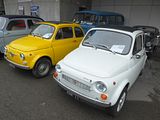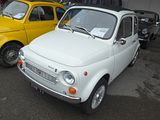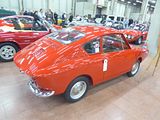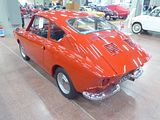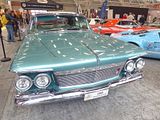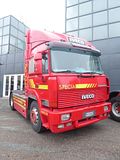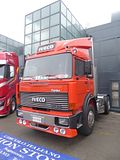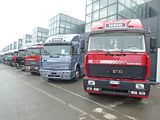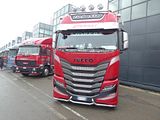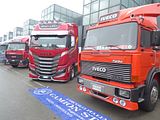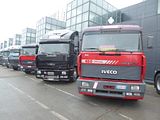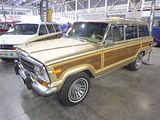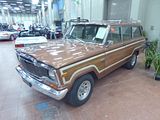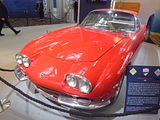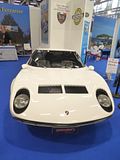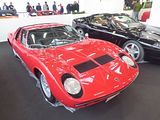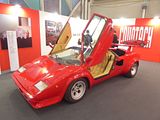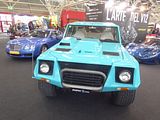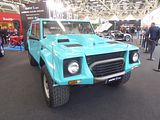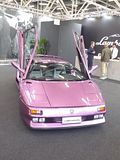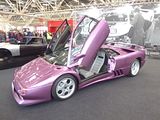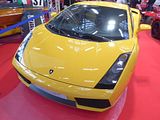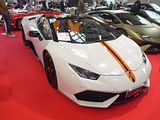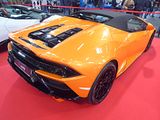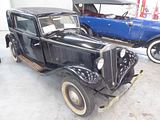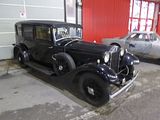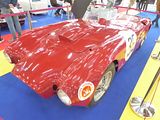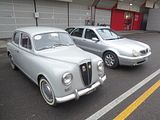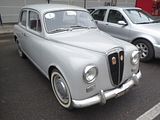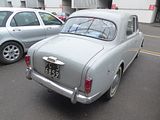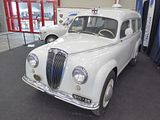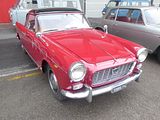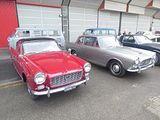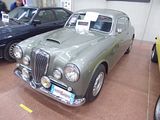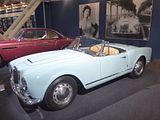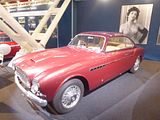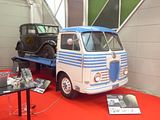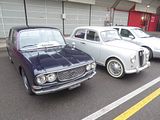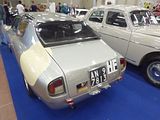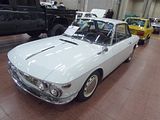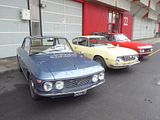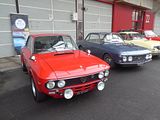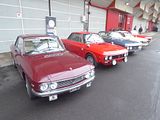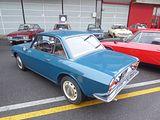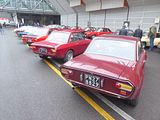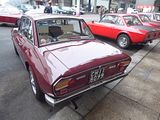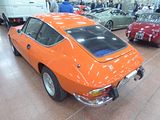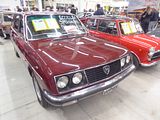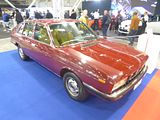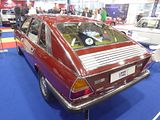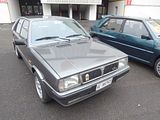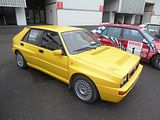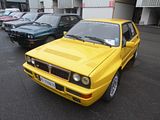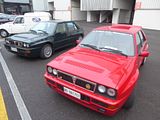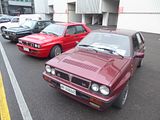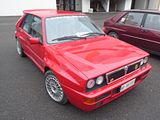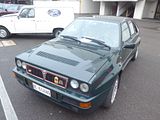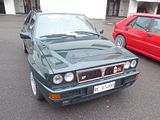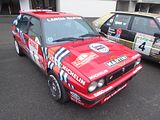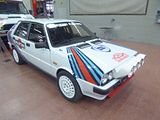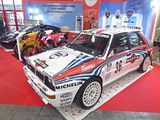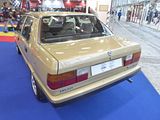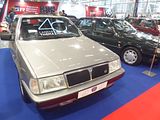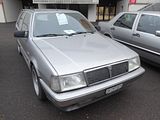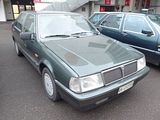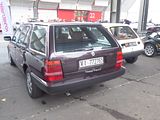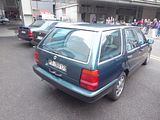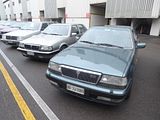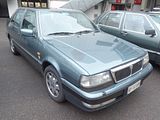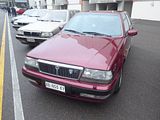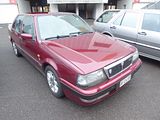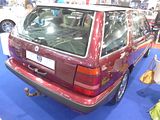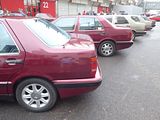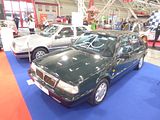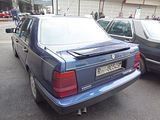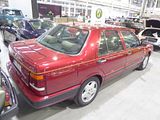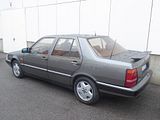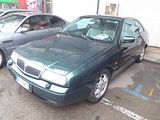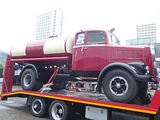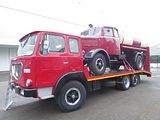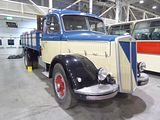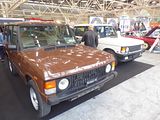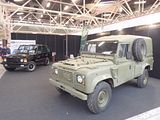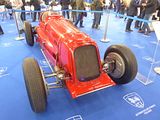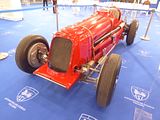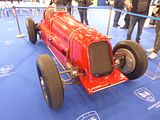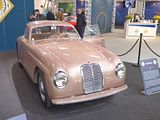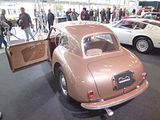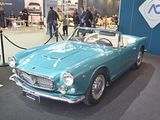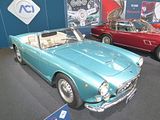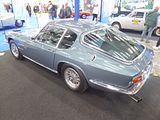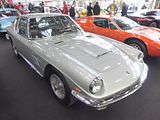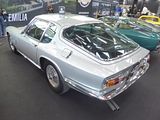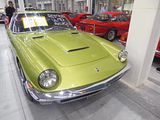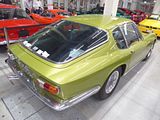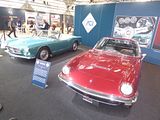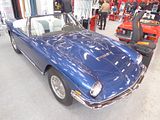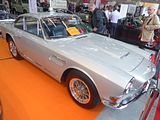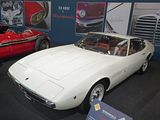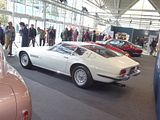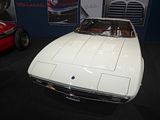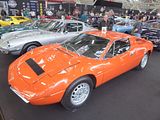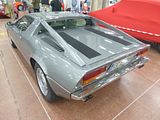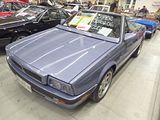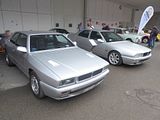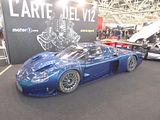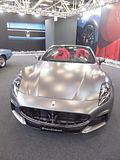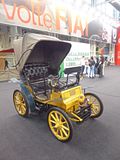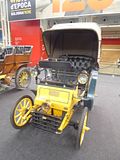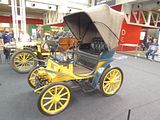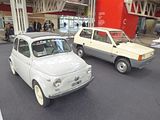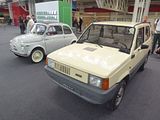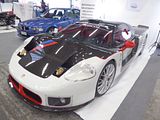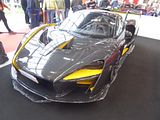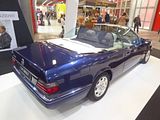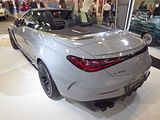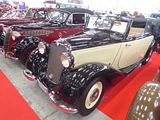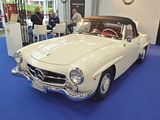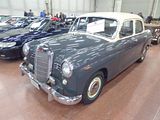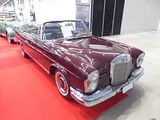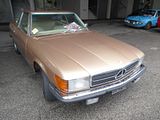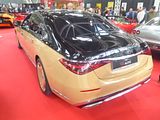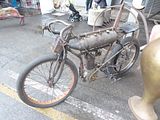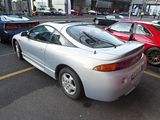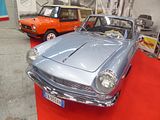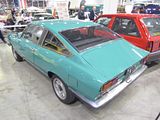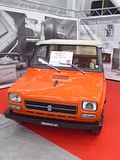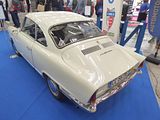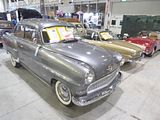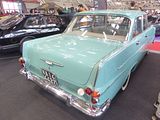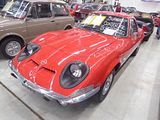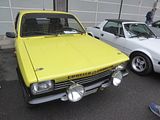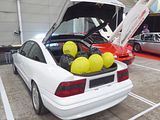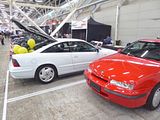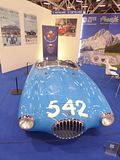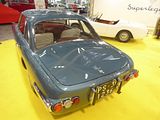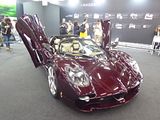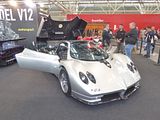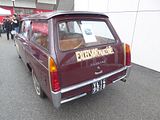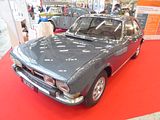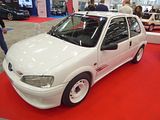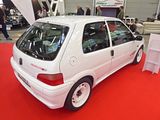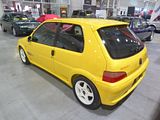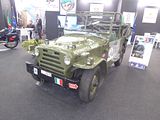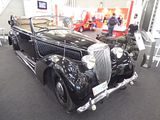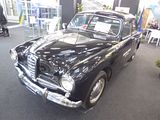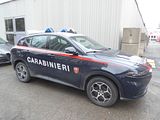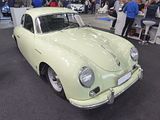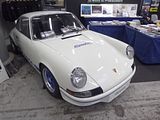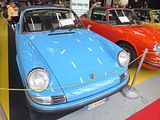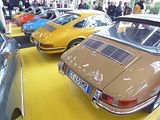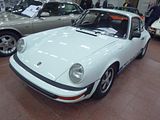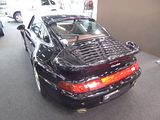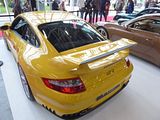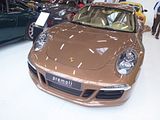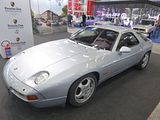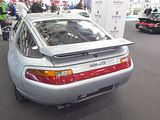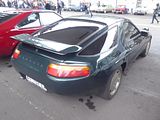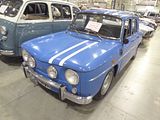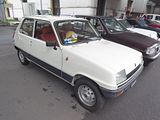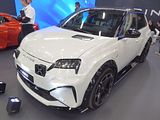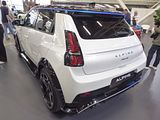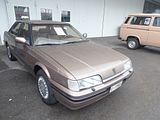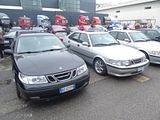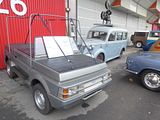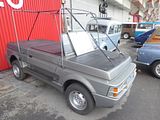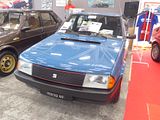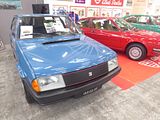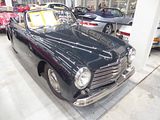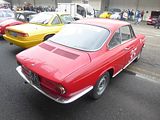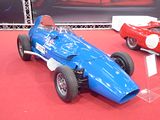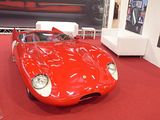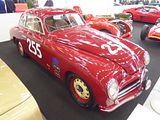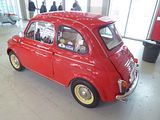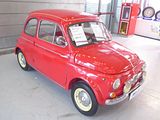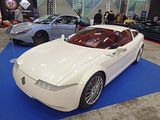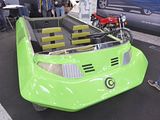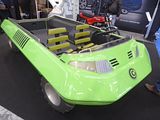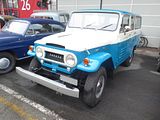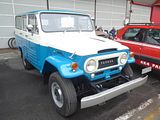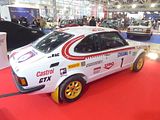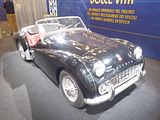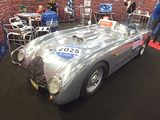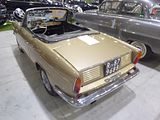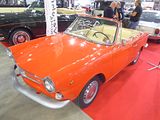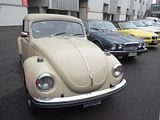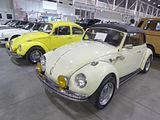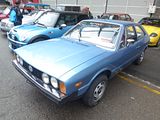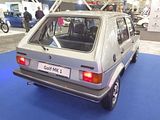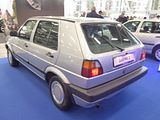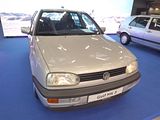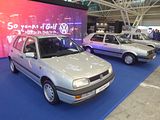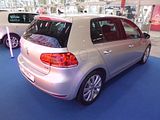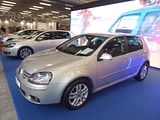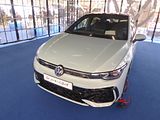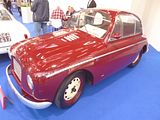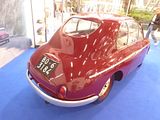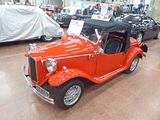This is a continuation from Part 1 of the report from the 2024 edition of the Auto e Moto d’Epoca show in Bologna.
FRANCIS LOMBARDI
The Carrozzeria Francis Lombardi was founded in 1947 in Vercelli, Italy, by noted pilot Carlo “Francis” Lombardi. They originally engaged in some aeronautical design, but this soon ended. and they focussed exclusively on automobiles after 1950. Their first efforts were coupés on Fiat 1100 and 1400 basis; these were soon followed by station wagons with wood-panelled bodywork on 1100-basis. Francis Lombardi also made six-seater limousines from Fiat sedans of the period such as the 1400 and 1800. Intended for ministerial or representational use, they had stretched wheelbases and luxuriously fitted interiors. Famously, they built a Vatican-commissioned Fiat 2300-based limousine with a glass roof for Pope Paul VI in 1963 – this was the first “true” Popemobile. Francis Lombardi also developed four-door versions of the Fiat 600, 850, and 127. This series of small four-door saloons was called “Lucciola” by Lombardi. The first one was the 600 Lucciola which appeared in early 1957; in addition to four doors without a B-pillar (the rear door opening backwards) it also had a floor mounted shifter unlike a regular 600. Francis Lombardi’s greatest commercial success was with the luxuriously appointed Fiat 500 called “My Car”; which supported an annual production of about 6,000 cars in the sixties, up from about 1,500 towards the late fifties. The Fiat 850 Lucciola was also used by Spain’s SEAT for their 850 four-door sedan, although eventually they developed their own, longer version. At the end of the sixties, the Lombardi Grand Prix appeared, the closest thing to an independent design from the firm. This model had a convoluted history and was sold in small numbers under a variety of names until 1972, fitted with Fiat engines in various states of tune. Francis Lombardi continued to focus on modifying cars as well, building coupés on Fiat as well as on NSU basis (1000 TTS). In the 1970s they made special versions of the Fiat 128 and Lancia 2000, but in 1973 their doors were closed for good. Ten years later, Carlo Lombardi died. This is their version of the Nuova 500, which was known as the Francis Lombardi MyCar which came with a fixed roof, a slightly raised roofline and a higher quality interior trim compared to the Fiat version.
The Fiat 500 Coccinella is a rare and intriguing variant of the classic Fiat 500, created by the Italian coachbuilder Francis Lombardi. Based on the modified chassis of the Fiat 500 F, the Coccinella was an attempt to enhance the iconic city car with a more exclusive and stylish design. However, the project faced significant challenges, and only seven specimens were ultimately produced, making it an exceptionally rare collector’s item today. The modifications made to the standard 500 F chassis were extensive and costly, even for Francis Lombardi, who was known for crafting unique, limited-production vehicles. These changes aimed to give the Fiat 500 a more refined and upscale appearance, but the end result was met with mixed reactions. The design was considered somewhat disproportionate, and the aesthetic appeal did not meet the expectations of potential buyers at the time. Coupled with the high production costs, this lukewarm reception resulted in limited demand, leading to the production of just seven cars. One of the unique aspects of the Fiat 500 Coccinella is its customization. In keeping with the tradition of Italian coachbuilders, Francis Lombardi allowed customers to personalize their cars with various details and accessories. This means that each of the seven produced Coccinellas has distinct features, including different taillights often sourced from other Fiat models. As a result, no two Coccinellas are identical, which, although unintentional, adds a layer of uniqueness to each car. Today, at least three examples of the Fiat 500 Coccinella are known to still exist: one red, one yellow, and one white. These surviving cars showcase the variability typical of Lombardi’s craftsmanship, reflecting the personalized touches chosen by their original owners. This characteristic of the Coccinella, once seen as a drawback due to inconsistency, is now appreciated by collectors who value the individuality of each car. Mechanically, the Fiat 500 Coccinella retained the standard engine of the Fiat 500 F, keeping the performance similar to its mass-produced counterpart. However, the main appeal of the Coccinella lies in its coachbuilt charm and the story of its limited production, rather than in its mechanical prowess. Despite its commercial failure and aesthetic controversies at the time, the Fiat 500 Coccinella has become a rare gem in the classic car world. Its scarcity, combined with the unique details of each specimen, makes it a fascinating piece of automotive history, representing the ambitious yet sometimes impractical spirit of Italian coachbuilding in the mid-20th century.
GRASSI
Following a debut at the Monza Motor Show, Italian start-up Grassi Scuderia Milanese was making another showing of its tribute to the Lancia Delta S4. The Grassi 044S is powered by a 3.0-litre twin-turbocharged four-cylinder engine mounted over the rear axle, capable of sending 640bhp through all four wheels. Weighing 1200kg (or 1100kg without fuel and fluids), the 044S is claimed to reach 62mph from a standstill in 2.9sec. This time – on a par with that of the Ferrari 296 GTB – is likely to be for an 044S equipped with the sequential six-speed gearbox, rather than the H-pattern manual also on offer. To maximise traction, the 044S features permanent four-wheel drive, with three differentials splitting both laterally and longitudinally. It wears 285mm-wide 19in tyres at the front, while the rear end receives broader, 305mm-wide tyres to reduce oversteer. Braking is provided by six-pot vented discs at the front and four-pot units at the rear. The Grassi was penned by former Alfa Romeo designer Giuseppe Armano, although it takes clear inspiration from the Delta S4 – itself based on Giorgetto Giugario’s famed Lancia supermini. Armano prioritised the 044S’s aerodynamic set-up, according to Grassi, with the goal of improving its stability and fuel efficiency at high speeds. Grassi has yet to confirm pricing or a delivery schedule for the 044S, but only 44 examples will be built – hence the name. It’s also an apparent reference to the Lancia 037 that preceded the Delta S4 in the Italian firm’s Group B rally campaign. That became the last rear-wheel-drive car to win the World Rally Championship’s constructor’s title in 1983. That model was recently reinvented as the Kimera Evo37, a bespoke supercar loosely based on the Lancia Beta Montecarlo (as was the original 037) and limited to 37 units.
IMPERIAL
For the 1957 model year, the Imperial received its own platform, setting it apart from any other division of Chrysler and shared the all-new “Forward Look” appearance, showing many styling features introduced with the concept car Chrysler Norseman. Imperials during this period were substantially wider, both inside and out, than other Chrysler Corporation products, with front and rear shoulder room equal to 64.0 in (1,626 mm) and 62.0 in (1,575 mm) respectively. The front seat shoulder room measurement remains an unsurpassed record for Imperial and would remain the record for any car until the 1971–1976 GM full-size models. Exterior width reached a maximum of 81.7 in (2,075 mm) for 1961–1963, which remains the record for the widest non-limousine American car. After Lincoln downsized for 1961, this generation of Imperial had no real competitor for the title of largest car for the remainder of its decade-long lifespan. The Imperial Crown convertible was listed at $5,598) and 1,167 were manufactured. Unlike the rest of the Chrysler Corporation makes (Chrysler, De Soto, Dodge, and Plymouth) that began unibody construction for 1960, the Imperial retained separate full perimeter frames for rigidity through the 1966 model year. These substantial frames had a box cross-section with strong crossmembers connecting the frame. The convertible had extra strength built into its crossmembers that formed an “X”. The driveshaft passed through a hole in the “X” frame. The parking brake gripped the driveshaft and was not connected to the rear drum brakes prior to the 1963 model year. The Imperial, and all Chrysler-built cars, incorporated “Torsion-Aire” suspension for 1957. This was an indirect-acting, torsion-bar front suspension system that reduced unsprung weight and shifted the car’s center of gravity downward and rearward. Torsion-bar suspension on the front combined with multi-leaf springs on the rear provided a smoother ride and improved handling. Imperial’s handling was better than its competitors of the time due to its stiffness from the torsion-bars combined with a thick anti roll bar in the front. Pillarless hardtops, in both two and four-door configurations, received the Southampton designation. The cars received annual changes. Seen here was a 1961 model. The 1961 model year brought a new front end design with free-standing headlights on short stalks in cut-away front fenders (a classical throwback favoured by Virgil Exner, used commonly in the 1930s Chryslers. He would continue his look with the modern Stutz), and the largest tailfins ever. Inside, the Imperial gained an improved dash layout with an upright rectangular bank of gauges. The pillared four-door sedan was cancelled and would not return until the 1967 model year. With the downsizing of Lincoln, at 227.1 inches (later increased to 227.8 inches in 1963), the Imperial would once again be the longest non-limousine car made in America through 1966. Sales fell to 12,258, the result of bizarre styling and continued poor quality control while the retail price for the LeBaron was US$6,428.
IVECO
JAGUAR
Jaguar stunned the world with the XK120 that was the star of the Earls Court Motor Show in 1948. Seen in open two seater form, the car was a testbed and show car for the new Jaguar XK engine. The display car was the first prototype, chassis number 670001. It looked almost identical to the production cars except that the straight outer pillars of its windscreen would be curved on the production version. The roadster caused a sensation, which persuaded Jaguar founder and design boss William Lyons to put it into production. Beginning in 1948, the first 242 cars wore wood-framed open 2-seater bodies with aluminium panels. Production switched to the 112 lb heavier all-steel in early 1950. The “120” in the name referred to the aluminium car’s 120 mph top speed, which was faster with the windscreen removed. This made it the world’s fastest production car at the time of its launch. Indeed, on 30 May 1949, on the empty Ostend-Jabbeke motorway in Belgium, a prototype XK120 timed by the officials of the Royal Automobile Club of Belgium achieved an average of runs in opposing directions of 132.6 mph with the windscreen replaced by just one small aeroscreen and a catalogued alternative top gear ratio, and 135 mph with a passenger-side tonneau cover in place. In 1950 and 1951, at a banked oval track in France, XK120 roadsters averaged over 100 mph for 24 hours and over 130 mph for an hour, and in 1952 a fixed-head coupé took numerous world records for speed and distance when it averaged 100 mph for a week. Roadsters were also successful in racing and rallying. The first production roadster, chassis number 670003, was delivered to Clark Gable in 1949. The XK120 was ultimately available in two open versions, first as an open 2-seater described in the US market as the roadster (and designated OTS, for open two-seater, in America), and from 1953 as a drophead coupé (DHC); as well as a closed, or fixed head coupé (FHC) from 1951. A smaller-engined version with 2-litres and 4 cylinders, intended for the UK market, was cancelled prior to production.
Although bearing a family resemblance to the earlier XK120 and XK140, the XK150, launched in the spring of 1957, was radically revised. A one-piece windscreen replaced the split screen, and the wing line no longer dropped so deeply at the doors. The widened bonnet opened down to the wings, and on the Roadster the windscreen frame was moved back 4 inches to make the bonnet longer. The XK140’s walnut dashboard was replaced by one trimmed in leather. On the early Drophead Coupés, the aluminium centre dash panel, which was discontinued after June 1958, had an X pattern engraving similar to the early 3.8 E-Type. Thinner doors gave more interior space. On the front parking lights, which were located atop the wings, a little red light reminded the driver the lights were on. Suspension and chassis were very similar to the XK140, and steering was by rack and pinion; power steering was not offered. The standard engine, the similar to the XK140, but with an new “B” type cylinder head, was the 3.4 litre DOHC Jaguar straight-6 rated at 180 SAE bhp at 5750 rpm but most cars were fitted with the SE engine whose modified cylinder head (B type) and larger exhaust valves boosted the power to 210 SAE bhp at 5500 rpm. Twin 1.75-inch (44 mm) SU HD6 carburettors were fitted. While the first XK150s were slower than their predecessors, the deficit was corrected in the spring of 1958 with a 3.4-litre “S” engine whose three 2-inch SU HD8 carburettors and straight-port cylinder head increased power to a claimed 250 SAE bhp. For 1960, the 3.4 litre engine was bored to 3.8 litres, rating this option at 220 hp in standard tune or 265 hp in “S” form. A 3.8 litre 150S could top 135 mph and go from 0–60 mph in around 7.0 seconds. Fuel economy was 18mpg. Four-wheel Dunlop 12 in disc brakes appeared for the first time although it was theoretically possible to order a car with drums. When leaving the factory the car originally fitted either 6.00 × 16 inch Dunlop Road Speed tyres as standard, or you could specify 185VR16 Pirelli Cinturato CA67 as a radial option on either 16 × 5K½ solid wheels (basic models) or 16 × 5K wire wheels. Production ended in October 1960, and totalled 2265 Roadsters, 4445 Fixed Head Coupés and 2672 Drophead Coupés.
The Series 1 E Type was introduced, initially for export only, in March 1961. The domestic market launch came four months later in July 1961. The cars at this time used the triple SU carburetted 3.8-litre six-cylinder Jaguar XK6 engine from the XK150S. Earlier built cars utilised external bonnet latches which required a tool to open and had a flat floor design. These cars are rare and more valuable. After that, the floors were dished to provide more leg room and the twin bonnet latches moved to inside the car. The 3.8-litre engine was increased to 4,235 cc in October 1964. The 4.2-litre engine produced the same power as the 3.8-litre (265 bhp) and same top speed (150 mph), but increased torque approximately 10% from 240 to 283 lb/ft. Acceleration remained pretty much the same and 0 to 60 mph times were around 6.4 seconds for both engines, but maximum power was now reached at 5,400 rpm instead of 5,500 rpm on the 3.8-litre. That all meant better throttle response for drivers that did not want to shift down gears. The 4.2-litre’s block was completely redesigned, made longer to accommodate 5 mm (0.20 in) larger bores, and the crankshaft modified to use newer bearings. Other engine upgrades included a new alternator/generator and an electric cooling fan for the radiator. Autocar road tested a UK spec E-Type 4.2 fixed head coupé in May 1965. The maximum speed was 153 mph, the 0–60 mph time was 7.6 seconds and the 1⁄4 mile from a standing start took 15.1 seconds. They summarised it as “In its 4.2 guise the E-Type is a fast car (the fastest we have ever tested) and offers just about the easiest way to travel quickly by road.”. Motor magazine road tested a UK spec E-Type 4.2 fixed head coupé in Oct 1964. The maximum speed was 150 mph, the 0–60 mph time was 7 seconds and the 1⁄4 mile time was 14.9 seconds. They summarised it as “The new 4.2 supersedes the early 3.8 as the fastest car Motor has tested. The absurd ease which 100 mph can be exceeded in a 1⁄4 mile never failed to astonish. 3,000 miles (4,828 km) of testing confirms that this is still one of the world’s outstanding cars”. All E-Types featured independent coil spring rear suspension designed and developed by R J Knight with torsion bar front ends, and four wheel disc brakes, in-board at the rear, all were power-assisted. The Coventry engineers spared nothing with regards to high automotive technology in braking. Like several British car builders of the middle and late 1950s, the four-wheel disc brakes were also used in that era by Austin-Healey, MG,putting the British far ahead of Ferrari, Maserati, Alfa Romeo, Porsche, and Mercedes-Benz. Even Lanchester tried an abortive attempt to use copper disc brakes in 1902. Jaguar was one of the first vehicle manufacturers to equip production cars with 4 wheel disc brakes as standard from the XK150 in 1958. The Series 1 (except for late 1967 models) can be recognised by glass-covered headlights (up to 1967), small “mouth” opening at the front, signal lights and tail-lights above bumpers and exhaust tips under the number plate in the rear. 3.8-litre cars have leather-upholstered bucket seats, an aluminium-trimmed centre instrument panel and console (changed to vinyl and leather in 1963), and a Moss four-speed gearbox that lacks synchromesh for first gear (“Moss box”) on all except very last cars. 4.2-litre cars have more comfortable seats, improved brakes and electrical systems, and,obviously, an all-synchromesh Jaguar designed four-speed gearbox. 4.2-litre cars also have a badge on the boot proclaiming “Jaguar 4.2 Litre E-Type” (3.8 cars have a simple “Jaguar” badge). Optional extras included chrome spoked wheels and a detachable hard top for the OTS. When leaving the factory the car was originally fitted with Dunlop 6.40 × 15-inch RS5 tyres on 15 × 5K wire wheels (with the rear fitting 15 × 5K½ wheels supplied with 6.50 X15 Dunlop Racing R5 tyres in mind of competition). Later Series One cars were fitted with Dunlop 185 – 15 SP41 or 185 VR 15 Pirelli Cinturato as radial ply tyres. A 2+2 version of the fastback coupé was added in 1966. The 2+2 offered the option of an automatic transmission. The body is 9 in (229 mm) longer and the roof angles are different. The roadster and the non 2+2 FHC (Fixed Head Coupé) remained as two-seaters. Less widely known, right at the end of Series 1 production, but prior to the transitional “Series 1½” referred to below, a small number of Series 1 cars were produced with open headlights. These Series 1 cars had their headlights modified by removing the covers and altering the scoops they sit in, but these Series 1 headlights differ in several respects from those later used in the Series 1½ (or 1.5), the main being they are shorter at 143 mm from the Series 1½ at 160 mm. Production dates on these machines vary but in right-hand drive form production has been verified as late as July 1968. They are not “rare” in the sense of the build of the twelve lightweights, but they are certainly uncommon; they were not produced until January 1967 and given the foregoing information that they were produced as late as July 1968, it appears that there must have been an overlap with the Series 1.5 production, which began in August 1967 as model year 1968 models. These calendar year/model year Series 1 E-Types are identical to other 4.2-litre Series 1 examples in every respect except for the open headlights; all other component areas, including the exterior, the interior, and the engine compartment are the same, with the same three SU carburettors, polished aluminium cam covers, center dash toggle switches, etc. Following the Series 1 there was a transitional series of cars built in 1967–68 as model year 1968 cars, unofficially called “Series 1½.” Due to American pressure the new features were not just open headlights, but also different switches (black rocker switches as opposed to the Series 1 toggle switches), de-tuning for emissions (using two Zenith-Stromberg carburettors instead of the original three SUs) for US models, ribbed cam covers painted black except for the top brushed aluminium ribbing, bonnet frames on the OTS that have two bows, and other changes. Series 1½ cars also have twin cooling fans and adjustable seat backs. The biggest change between 1961–1967 Series 1 E-Types and the 1968 Series 1.5 was the reduction in the number of carburettors from 3 to just 2 (North America), resulting in a loss in horsepower. Series 2 features were gradually introduced into the Series 1, creating the unofficial Series 1½ cars, but always with the Series 1 body style. A United States federal safety law affecting 1968 model year cars sold in the US was the reason for the lack of headlight covers and change in dash switch design in the “Series 1.5” of 1968. An often overlooked change, one that is often “modified back” to the older style, is the wheel knock-off “nut.” US safety law for 1968 models also forbade the winged-spinner knockoff, and any 1968 model year sold in the US (or earlier German delivery cars) should have a hexagonal knockoff nut, to be hammered on and off with the assistance of a special “socket” included with the car from the factory. This hexagonal nut carried on into the later Series 2 and 3. The engine configuration of the US Series 1.5s was the same as is found in the Series 2. An open 3.8-litre car, actually the first such production car to be completed, was tested by the British magazine Motor in 1961 and had a top speed of 149.1 mph and could accelerate from 0 to 60 mph in 7.1 seconds. A fuel consumption of 21.3 mpg was recorded. The test car cost £2,097 including taxes.The cars submitted for road test by the motoring journals of the time (1961) such as Motor, Autocar and Autosport magazines were prepared by the Jaguar works. This work entailed engine balancing and subtle tuning work such as gas-flowing checking the cylinder heads but otherwise production built engines. Both of the well-known 1961 road test cars: the E-Type coupé Reg. No. 9600 HP and E-Type Convertible Reg. No. 77 RW, were fitted with Dunlop Racing Tyres on test, which had a larger rolling diameter and lower drag coefficient. This goes some way to explaining the 150 mph (240 km/h) maximum speeds that were obtained under ideal test conditions. The maximum safe rev limit for standard 6-cylinder 3.8-litre E-Type engines is 5,500 rpm. The later 4.2-Litre units had a red marking on the rev counter from just 5,000 rpm. Both 3.8 test cars may have approached 6,000 rpm in top gear when on road test, depending on final drive ratio. Production numbers were as follows: 15,490 of the 3.8s, 17,320 of the 4.2s and 10,930 of the 2+2s. And by body style there were 15,442 of the FHC, 17,378 of the OTS and 5,500 of the 2+2, making a total of 38,419 of the Series 1 car.
As is well known, the XJ220 was developed from a V12-engined 4-wheel drive concept car designed by an informal group of Jaguar employees working in their spare time. The group wished to create a modern version of the successful Jaguar 24 Hours of Le Mans racing cars of the 1950s and ’60s that could be entered into FIA Group B competitions. The XJ220 made use of engineering work undertaken for Jaguar’s then current racing car family. The initial XJ220 concept car was unveiled to the public at the 1988 British International Motor Show. Its positive reception prompted Jaguar to put the car into production; some 1500 deposits of £50,000 each were taken, and deliveries were planned for 1992. Engineering requirements resulted in significant changes to the specification of the XJ220, most notably replacement of the Jaguar V12 engine by a turbocharged V6 engine. The changes to the specification and a collapse in the price of collectible cars brought about by the early 1990s recession resulted in many buyers choosing not to exercise their purchase options. A total of just 271 cars were produced by the time production ended, each with a retail price of £470,000 in 1992. The production XJ220 used a 3.5-litre twin turbocharged engine, which was given the designation Jaguar/TWR JV6. This engine, which replaced the Jaguar V12 engine featured in the concept car, was a heavily redesigned and significantly altered version of the Austin Rover V64V V6 engine. The decision to change the engine was based on engine weight and dimensions, as well as to environmental emission considerations. Use of the shorter V6 engine design allowed the wheelbase of the XJ220 to be shortened and its weight to be reduced; the V12 engine was definitively ruled out when it was determined it would have difficulty in meeting emissions legislation whilst producing the required power and torque. TWR purchased the rights to the V64V engine from Austin Rover in 1989 and developed a completely new turbocharged engine, codenamed JV6, under the auspices of Allan Scott, with proportions roughly similar to the V64V, and suitable for Sportcar racing. TWR redesigned all parts of the engine, increasing the displacement to 3.5 litres, and adding two Garrett TO3 turbochargers. The JV6 engine would first be used in the JaguarSport XJR-10 and XJR-11 racing cars; its compact dimensions and low weight made it an ideal candidate for the XJ220. The engine had a 90° bank angle, four valves per cylinder and belt-driven double overhead camshafts. It shares a number of design features with the Cosworth DFV Formula One engine. The V64V engine chosen had a short but successful career as a purpose-designed racing car engine. It was designed by Cosworth engine designer David Wood for Austin Rover Group’s Metro derived Group B rally car, the MG Metro 6R4. The redesign work necessary to create the Jaguar/TWR JV6 engine was undertaken by Andrew Barnes, TWR’s Powertrain Manager, and also involved Swiss engine builder Max Heidegger who had designed and built the race engines used in the XJR-10 and XJR-11 racing cars. The XJ220’s engine had a bore and stroke of 94 mm × 84 mm, dry sump lubrication, Zytek multi point fuel injection with dual injectors and Zytek electronic engine management. The engine was manufactured with an aluminium cylinder block, aluminium cylinder heads with steel connecting rods and crankshaft, and in the standard state of tune, it produced a maximum power of 550 PS at 7200 rpm and torque of 475 lb·ft at 4500 rpm. The XJ220 can accelerate from 0–60 miles per hour in 3.6 seconds and reach a top speed of 213 miles per hour. The exhaust system had two catalytic converters, which reduced the power output of the engine. During testing at the Nardò Ring in Italy the XJ220, driven by 1990 Le Mans Winner Martin Brundle achieved a top speed of 217.1 miles per hour when the catalytic converters were disconnected and the rev limiter was increased to 7,900rpm; owing to the circular nature of the track, a speed of 217 mph is equivalent to 223 mph on a straight, level road. The V64V engine had the additional benefit of being very economical for such a powerful petrol engine, it was capable of achieving 32 mpg, in contrast, the smallest-engined Jaguar saloon of the time, the Jaguar XJ6 4.0 could only achieve around 24 mpg. Four-wheel drive was decided against early in the development process, for a number of reasons. It was thought rear-wheel drive would be adequate in the majority of situations, that the additional complexity of the four-wheel drive system would hinder the development process and potentially be problematic for the customer. FF Developments were contracted to provide the gearbox/transaxle assembly, modifying their four-wheel drive transaxle assembly from the XJ220 concept into a pure rear-wheel drive design for the production car. A five-speed gearbox is fitted; a six-speed gearbox was considered but deemed unnecessary, as the torque characteristics of the engine made a sixth gear redundant. The transaxle featured a viscous coupling limited slip differential to improve traction. The transmission system featured triple-cone synchromeshing on first and second gears to handle rapid starts, whilst remaining relatively easy for the driver to engage and providing positive feel. The exterior retained the aluminium body panels of the XJ220 concept, but for the production vehicles, Abbey Panels of Coventry were contracted to provide the exterior panels. The scissor doors were dropped for the production model, and significant redesign work was carried out on the design when the wheelbase and overall length of the car was altered. Geoff Lawson, Design Director at Jaguar took a greater interest in the car and insisted the design had to be seen to be a Jaguar if it was to be successful in promoting the company. Keith Helfet returned to undertake the necessary redesign work mandated by the change in the wheelbase, which was reduced by 200 mm. The turbocharged engine required larger air intakes to feed the two intercoolers. Situated between the doors and the rear wheels, the air intakes were larger on the production version of the XJ220 than on the concept car. A number of small design changes for the body were tested in the wind tunnel; the final version had a drag coefficient of 0.36 with downforce of 3,000 lb at 200 mph. The XJ220 was one of the first production cars to intentionally use underbody airflow and the venturi effect to generate downforce. The rear lights used on the production XJ220 were taken from the Rover 200. The production model utilised the same Alcan bonded honeycomb aluminium structure vehicle technology (ASVT) as the concept car for the chassis. The chassis design featured two box section rails which acted as the suspension mounting points and would provide an energy absorbing structure in the event of a frontal impact, these were successfully tested at speeds up to 30 mph, an integral roll cage formed part of the chassis and monocoque, providing additional structural rigidity for the car and allowing the XJ220 to easily pass stringent crash testing. The rear-wheel steering was dropped from the production car to save weight and reduce complexity, as was the height adjustable suspension and active aerodynamic technology. The suspension fitted to the production model consisted of front and rear independent suspension, double unequal length wishbones, inboard coil springs and anti-roll bars, with Bilstein gas-filled dampers. The suspension was designed in accordance with the FIA Group C specifications. The braking system was designed by AP Racing and featured ventilated and cross-drilled discs of 13 in diameter at the front and 11.8 in diameter at the rear. The calipers are four pot aluminium units. JaguarSport designed the handbrake, which are separate calipers acting on the rear brake discs. Feedback from enthusiasts and racing drivers resulted in the decision to drop the anti-lock braking system from the production car. The braking system was installed without a servo, but a number of owners found the brakes to be difficult to judge when cold and subsequently requested a servo to be fitted. Rack and pinion steering was fitted, with 2.5 turns lock to lock; no power assistance was fitted. The Bridgestone Expedia S.01 asymmetric uni-directional tyres were specially developed for the XJ220 and had to be rateable to a top speed in excess of 220 mph, carry a doubling of load with the exceptionally high downforce at speed and maintain a compliant and comfortable ride. Rally alloy wheel specialists Speedline Corse designed the alloy wheels, these are both wider and have a larger diameter on the rear wheels; 17 inches wheels are fitted to the front and 18 inches are fitted at the rear, with 255/55 ZR17 tyres at the front and 345/35 ZR18 tyres at the rear. The interior was designed for two passengers and trimmed in leather. Leather trimmed sports seats are fitted together with electric windows and electrically adjustable heated mirrors. The dashboard unusually curves round and carries onto the drivers door, with a secondary instrument binnacle containing four analogue gauges, including a clock and voltmeter fitted on the front of the drivers door. Air conditioning and green tinted glazing was also fitted. The luggage space consists of a small boot directly behind and above the rear portion of the engine, also trimmed in leather. The car was assembled in a purpose-built factory at Wykham Mill, Bloxham near Banbury. HRH The Princess of Wales officially opened the factory and unveiled the first production XJ220 in October 1991. The JV6 engines used in the Jaguar racing cars were produced by Swiss engineer Max Heidegger, but delivering the number of engines required for the XJ220 program was considered beyond his capacity. TWR formed a division, TWR Road Engines, to manage the design, development, construction and testing of the engines for the production cars. The JV6 engine used in the XJ220 featured little commonality with the engines Heidegger built for use in the XJR racing cars, being specifically engineered to meet performance and in particular, the European emissions requirements, which the race engines didn’t have to meet. FF Developments, in addition to their design work on the gearbox and rear axle assembly were given responsibility for their manufacture. The aluminium chassis components and body panels were manufactured and assembled at Abbey Panels factory in Coventry, before the body in white was delivered to the assembly plant at Bloxham. The car, including chassis and body components, consists of approximately 3000 unique parts. The first customer delivery occurred in June 1992, and production rates averaged one car per day. The last XJ220 rolled off the production line in April 1994; the factory was then transferred to Aston Martin and used for the assembly of the Aston Martin DB7 until 2004.
This is a Jaguar XE SV Project Eight. This limited-run super-saloon (of sorts) was unveiled in 2017, with the first cars hitting the roads in the middle of 2019. Just 300 are set to be built. It was developed — and is being built by — Jaguar Land Rover’s Special Vehicle Operations, the division that’s responsible for high-performance SVR-branded Range Rovers and F-Types, as well as low-volume specials such as the 2015 F-Type Project 7. The Project 8 is only available with left-hand drive. It shares its basic body-in-white with the everyday XE, but just about everything else is new. Every body panel but the roof and front doors are bespoke, the suspension has been entirely reworked and Michelin Pilot Sport Cup 2 tyres feature on a Jaguar for the very first time. The familiar 5.0-litre supercharged V8 that serves across JLR has also been shoehorned in. Here, it develops 592bhp and 516lb ft, making the Project 8 Jaguar’s most powerful road car to date. The aero package is bespoke, too, of course, and capable of generating 122kg of downforce at 186mph. The optional Track Pack, which costs £10,000 and saves 12kg, swaps out the rear seats for a half-roll-cage and adds carbon-backed bucket seats up front with four-point harnesses. The price tag of £149,00 means that you have to be absolutely sure you want one, and it would seem that not enough people have been, with sales proving harder to find than Jaguar had anticipated.
JEEP
The Jeep Wagoneer is a luxury 4×4 produced and marketed under the Jeep brand from the 1963 to 1991 model years. Introduced as the replacement for the Jeep Station Wagon, the Wagoneer was the first Jeep model line completely distinct from the Jeep CJ. Designed as a truck-based station wagon, the model line became a progenitor of the modern sport-utility vehicle (SUV). Designed under contract by industrial designer Brooks Stevens, the exterior of the Wagoneer was styled by engineer Dave Nutting. Sharing the Jeep SJ chassis (full-size Jeep) with the Jeep Gladiator/J-Series, the Wagoneer also shared its underpinnings with the introductory Jeep Cherokee. In 1966, Jeep introduced the high-content Super Wagoneer, upgrading the model line with features from higher-priced sedans. Though the trim was short-lived, the Wagoneer became upgraded in content and features throughout the 1970s. For 1984, the Jeep Grand Wagoneer was introduced (to distinguish the SJ from the smaller XJ Wagoneer), becoming its flagship trim. Through its 29-year production under a single generation (the third longest in U.S. automotive history), the Wagoneer underwent only nominal changes to its body structure and appearance. The model line was produced by Jeep through its ownership by Kaiser Jeep, AMC, and Chrysler. With competition from the “big three” automakers advancing on Jeep’s four-wheel-drive market, Willys management decided that a new and more advanced vehicle was needed. Conceived in the early 1960s while Willys-Overland Motors was owned by Kaiser Jeep Corporation, the Wagoneer replaced the original Willys Jeep Station Wagon, originally introduced in July 1946 and produced until the 1964 model year. It was introduced in November 1962 for the 1963 model year as a successor to the Willys Jeep Station Wagon that had been built since 1946. Although sharing a pickup truck chassis (like its predecessor), the Wagoneer had a sophisticated station wagon body design, that was more carlike than any other 4×4 on the market. Compared with offerings from GM, Ford, International Harvester, Toyota, Nissan and Land Rover — which were producing utilitarian work-oriented vehicles with spartan truck-like interiors — the Wagoneer’s luxury set it apart. Together with the Gladiator, the revolutionary Wagoneer SJ platform included an advanced overhead cam straight-six engine, and offered features unheard of at the time in any other mainstream 4WD vehicle, such as independent front suspension, power steering, automatic transmission, a factory radio, and optional air conditioning. Like its long-lived predecessor, the new 1963 Wagoneer took shape under an industrial designer Brooks Stevens, while Willys’ engineering staff handled the technical development. To appeal to mainstream consumers, the Wagoneer received a relatively low stance and car-like manners. The lower entry height was accomplished with a transfer case and a compact running gear design. Suspension tuning gave it a good ride, but because it was developed as a truck, it could haul and tow as needed. Development took three years and cost around US$20 million. At its introduction, the Jeep Wagoneer had no direct competition. For comparison, it took another eight years for Land Rover’s Range Rover to start in only a two-door body style. It took until 1981 for the four-door 4×4 to be developed and Range Rover sales in the United States began in 1987. In early 1970, AMC acquired Kaiser Jeep Corporation and began refining and upgrading the range. American Motors improved manufacturing efficiency and lowered costs by incorporating shared components such as engines. Reducing noise, vibration, and harshness improved the Wagoneer driving experience. Chrysler bought out American Motors Corporation on March 2, 1987. At the time, AMC was already working on designing a replacement for the antiquated SJ platform. Chrysler had other priorities, and although the Jeep J-Series pickups that shared the SJ platform and directly competed with Chrysler’s Dodge Ram pickups were discontinued in 1988, Chrysler left the Grand Wagoneer largely untouched over its first few years overseeing Jeep production, and even continued to build the model with the carbureted AMC V8 instead of its own (arguably, more modern) fuel-injected V8. Year-to-year changes were minimal. At the time of Chrysler’s purchase, customer demand for the Grand Wagoneer continued to be steady, and it was a very profitable model generating approximately five to six thousand dollars on each unit. The 1989–1991 model years are considered the “best of the breed” because of many improvements. These include upgraded wood siding and modernized aluminium alloy wheels that lost their gold-coloured inlays in favour of gunmetal grey metallic. Chrysler also introduced an electrocoat primer for better rust-proofing and all exterior colours were now applied in a two-stage base-clearcoat system. In 1988, Jeep’s first full year under Chrysler, a total of 14,117 Grand Wagoneers were produced. Many improvements were made for the 1989–1991 model year series, including a quality replacement for the earlier, leak-prone air conditioning compressor, the addition of the visually identifiable rear wiper/washer assembly, as well as a general improvement in fit and finish. An interior overhead console, taken from Chrysler’s popular minivans, was also added. This functional console featured much brighter map lights, an outside temperature sensor and compass, a storage compartment for sunglasses as well as an infrared remote-controlled keyless entry system. The last three model years also featured several new exterior paint colours and the tan interior colour was replaced with a lighter colour that Jeep called “sand.” The “new” exterior colours included a hunter green metallic that was only available in the 1991 model year and is the paint colour of the 1991 Grand Wagoneer in the Chrysler Museum, as well as the colour of the very last Grand Wagoneer ever made. The Wagoneer enjoyed one of the longest production runs of any Jeep product. Despite its combined fuel economy of only 11 mpg, its powerful 5.9 litre V8 engine and high towing capacity, and the fact that unlike most competitive full-size SUVs of the era it had four doors, made the Grand Wagoneer popular among its many repeat buyers through the 1960s, 70s, and 80s. By 1991, it was the longest-running domestically produced vehicle (29 years) on the same platform. As a result of the 1990 oil price shock, gasoline prices in the United States rose 11 percent in less than a year. Sales of the gas-guzzling Grand Wagoneer plummeted from over 10,000 units in 1989 to 6,449 in 1990. Slow sales continued during the Gulf War and only 4253 Grand Wagoneers were produced in the 1991 model year. In addition to its poor fuel economy, the antiquated SJ platform would have required extensive re-engineering to comply with new Federal Motor Vehicle Safety Standards that would apply to all light trucks and sport utility vehicles sold in the United States by the mid-1990s. As a result, on February 27, 1991, Chrysler announced that it was ending production of the Grand Wagoneer, leaving the Jeep line without a full-size SUV. Buyers of 1991 Grand Wagoneers sold after that date had the option of having a gold “Final Edition Jeep Grand Wagoneer” badge on the dashboard. The last SJ Grand Wagoneer produced rolled out of Chrysler’s Toledo Assembly Plant on June 21, 1991. Even before Chrysler assembled the final SJ Grand Wagoneer, there were specialized companies that were refurbishing and restoring them. Grand Wagoneers that are in top condition seem not to decrease in value. The 1989–1991 model years are considered “the best of the breed and still have a loyal following among a select group.” Later model, low mileage, rust-free Grand Wagoneers have become highly collectible with some pristine examples selling for more than their original sticker price over three decades after they rolled off the assembly line. In 2013, the 1963–1991 models were in a list of eight SUVs that have become collectibles and, depending on the condition, desirable items at car auctions.
LAMBORGHINI
The first 400 GTs were essentially just the older 350GT featuring an enlarged, 3929 cc V12 engine, with a power output of 320 bhp and recognised by the change to twin circular headlights from rectangular units. Twenty-three of these cars were built, with three featuring aluminium bodywork, and then at the 1966 Geneva Show, Lamborghini presented a revised version, called the 400 GT 2+2, which had a different roofline, and minor sheetmetal changes compared to the earlier cars, still with the Carrozzeria Touring bodywork. The larger body shape enabled the +2 seating to be installed in the rear, where the 350GT only had room for luggage or +1 seating, without changing the wheelbase. The 400 GT 2+2 also had a Lamborghini designed gearbox, with Porsche style synchromesh on all gears, which greatly improved the drivetrain. 224 examples of the 400 GT 2+2 were built from 1966 to 1968, when it was replaced with the Islero.
This is a Miura, a car some will say was the first true supercar. For sure, this car, produced between 1966 and 1973, is widely considered to have instigated the trend of high performance, two-seater, mid-engined sports cars. When released, it was the fastest production road car available. The Miura was originally conceived by Lamborghini’s engineering team, Gian Paolo Dallara, Paolo Stanzani, and Bob Wallace who in 1965 put their own time into developing a prototype car known as the P400. The engineers envisioned a road car with racing pedigree – one which could win on the track and be driven on the road by enthusiasts. The three men worked on its design at night, hoping to convince Lamborghini such a vehicle would neither be too expensive nor distract from the company’s focus. When finally brought aboard, Lamborghini gave his engineers a free hand in the belief the P400 was a potentially valuable marketing tool, if nothing more. The car featured a transversely-mounted mid-engine layout, a departure from previous Lamborghini cars. The V12 was also unusual in that it was effectively merged with the transmission and differential, reflecting a lack of space in the tightly-wrapped design. The rolling chassis was displayed at the Turin Salon in 1965. Impressed showgoers placed orders for the car despite the lack of a body to go over the chassis. Bertone was placed in charge of styling the prototype, which was finished just days before its debut at the 1966 Geneva motor show. Curiously, none of the engineers had found time to check if the engine would fit inside its compartment. Committed to showing the car, they decided to fill the engine bay with ballast and keep the car locked throughout the show, as they had three years earlier for the début of the 350GTV. Sales head Sgarzi was forced to turn away members of the motoring press who wanted to see the P400’s power plant. Despite this setback, the car was the highlight of the show, immediately boosting stylist Marcello Gandini’s reputation. The favourable reaction at Geneva meant the P400 was to go into production by the following year. The name “Miura”, a famous type of fighting bull, was chosen, and featured in the company’s newly created badge. The car gained the worldwide attention of automotive enthusiasts when it was chosen for the opening sequence of the original 1969 version of The Italian Job. In press interviews of the time company founder Ferruccio Lamborghini was reticent about his precise birth date, but stressed that he was born under the star sign Taurus the bull. Early Miuras, known as P400s (for Posteriore 4 litri), were powered by a version of the 3.9 litre Lamborghini V12 engine used in the 400GT at the time, only mounted transversely and producing 350 hp. Exactly 275 P400 were produced between 1966 and 1969 – a success for Lamborghini despite its then-steep price. Taking a cue from the Morris Mini, Lamborghini formed the engine and gearbox in one casting. Its shared lubrication continued until the last 96 SVs, when the case was split to allow the correct oils to be used for each element. An unconfirmed claim holds the first 125 Miuras were built of 0.9 mm steel and are therefore lighter than later cars. All cars had steel frames and doors, with aluminium front and rear skinned body sections. When leaving the factory they were originally fitted with Pirelli Cinturato 205VR15 tyres (CN72). The P400S Miura, also known as the Miura S, made its introduction at the Turin Motorshow in November 1968, where the original chassis had been introduced three years earlier. It was slightly revised from the P400, with the addition of power windows, bright chrome trim around external windows and headlights, new overhead inline console with new rocker switches, engine intake manifolds made 2 mm larger, different camshaft profiles, and notched trunk end panels (allowing for slightly more luggage space). Engine changes were reportedly good for an additional 20 hp. Other revisions were limited to creature comforts, such as a locking glovebox lid, a reversed position of the cigarette lighter and windshield wiper switch, and single release handles for front and rear body sections. Other interior improvements included the addition of power windows and optional air conditioning, available for US$800. About 338 P400S Miura were produced between December 1968 and March 1971. One S #4407 was owned by Frank Sinatra. Miles Davis also owned one, which he crashed in October 1972 under the influence of cocaine, breaking both ankles. The last and most famous Miura, the P400SV or Miura SV featured different cam timing and altered carburettors. These gave the engine an additional 15 hp to a total of 380 hp. The last 96 SV engines had a split sump. The gearbox now had its lubrication system separate from the engine, which allowed the use of the appropriate types of oil for the gearbox and the engine. This also alleviated concerns that metal shavings from the gearbox could travel into the engine with disastrous and expensive results and made the application of an optional LSD far easier. The SV can be distinguished from its predecessors from its lack of “eyelashes” around the headlamps, wider rear wings to accommodate the new 9-inch-wide rear wheels and Pirelli Cinturato tyres, and different taillights. 150 SVs were produced.
Which small boy (and perhaps car loving girl) did not lust after a Countach back in the 1970s and 1980s. A dramatic looking car, this was the stuff of dreams that you would only ever see at the London or NEC Motor Shows. Countach first made an appearance, as a concept in 1971, but it was 1973 before the production car made its debut, and despite unfortunate timing with fuel shortages and a recession, and a number of financial problems for its maker, the car sold well throughout its production life. The Countach entered production as the LP400 with a 3929 cc engine delivering 370 hp. The first production Countach was delivered to an Australian in 1974. Externally, little had altered from the final form of the prototype except at the rear, where conventional lights replaced the futuristic light clusters of the prototype. The styling had become rather more aggressive than Gandini’s original conception, with the required large air scoops and vents to keep the car from overheating, but the overall shape was still very sleek. The original LP400 rode on the quite narrow tyres of the time, but their narrowness and the slick styling meant that this version had the lowest drag coefficient of any Countach model. The emblems at the rear simply read “Lamborghini” and “Countach”, with no engine displacement or valve arrangement markings as is found on later cars. By the end of 1977, the company had produced 158 Countach LP400s. In 1978, a new LP400 S model was introduced. Though the engine was slightly downgraded from the LP400 model (350 bhp), the most radical changes were in the exterior, where the tyres were replaced with 345/35R15 Pirelli P7 tyres; the widest tyres available on a production car at the time, and fibreglass wheel arch extensions were added, giving the car the fundamental look it kept until the end of its production run. An optional V-shaped spoiler was available over the rear deck, which, while improving high-speed stability, reduced the top speed by at least 16 km/h (10 mph). Most owners ordered the wing. The LP400 S handling was improved by the wider tyres, which made the car more stable in cornering. Aesthetically, some prefer the slick lines of the original, while others prefer the more aggressive lines of the later models, beginning with the LP400 S. The standard emblems (“Lamborghini” and “Countach”) were kept at the rear, but an angular “S” emblem was added after the “Countach” on the right side. 1982 saw another improvement, this time giving a bigger, more powerful 4754 cc engine. The bodywork was unaltered, however the interior was given a refresh. This version of the car is sometimes called the 5000 S, which may cause confusion with the later 5000 QV. 321 of these cars were built. Two prototypes of the 1984 Countach Turbo S were built by Lamborghini, of which one is known to exist. The Turbo S weighed 1,515 kg (3,340 lb), while its 4.8 litre twin-turbo V12 had a claimed maximum power output of 758 PS and a torque output of 876 N·m (646 lb·ft), giving the car an acceleration of 0–100 km/h (0–62 mph) in 3.7 seconds and a top speed of 335 km/h (208 mph). A turbo adjuster, located beneath the steering wheel, could be used to adjust the boost pressure from 0.7 bar to 1.5 bar at which the engine performed its maximum power output. The Turbo S has 15″ wheels with 255/45 tyres on the front and 345/35 on the rear. In 1985 the engine design evolved again, as it was bored and stroked to 5167 cc and given four valves per cylinder—quattrovalvole in Italian, hence the model’s name, Countach 5000 Quattrovalvole or 5000 QV in short. The carburettors were moved from the sides to the top of the engine for better breathing—unfortunately this created a hump on the engine deck, reducing the already poor rear visibility to almost nothing. Some body panels were also replaced by Kevlar. In later versions of the engine, the carburettors were replaced with fuel injection. Although this change was the most notable on the exterior, the most prominent change under the engine cover was the introduction of fuel injection, with the Bosch K-Jetronic fuel injection, providing 414 bhp, rather than the six Weber carburettors providing 455 bhp. As for other markets, 1987 and 1988 model Quattrovalvoles received straked sideskirts. 610 cars were built.
Although it was not introduced until 1986, its origins go back nearly a decade before that. Lamborghini built its first military vehicle, a prototype vehicle codenamed the “Cheetah”, in 1977. Lamborghini had designed the vehicle with hopes of selling it to companies in the oil exploration and production industry. The original Cheetah prototype had a rear-mounted Chrysler V8 engine. The only finished prototype was never tested by the US military, only demonstrated to them by its designer, Rodney Pharis. It was later sold to Teledyne Continental Motors by MTI and is apparently still in the US. This led Lamborghini to develop the LM001, which was very similar to the Cheetah, but had an AMC V8 engine. It was finally determined that the engine being mounted in the rear caused too many unfavourable handling characteristics in an offroad vehicle, and the LMA002 was built with an entirely new chassis, moving the engine (now the V12 out of the Lamborghini Countach) to the front. After much testing and altering of the prototype, it was finally given a serial number and became the first LM002. The production model was unveiled at the Brussels Auto Show in 1986. It was dubbed the “Rambo-Lambo”. Civilian models were outfitted with a full luxury package, including full leather trim, tinted power windows, air conditioning, and a premium stereo mounted in a roof console. In order to meet the vehicle’s tire needs, Lamborghini commissioned Pirelli to create the Pirelli Scorpion tires with custom, run-flat tread designs. These were made specifically for the LM and were offered in two different tread designs, one for mixed use and the other for sand use only. These tyres could be run virtually flat without risk and could handle the desert heat, the loading, and the speeds of the LM. The LM002 was fitted with a 290-litre fuel tank. For those requiring even more power, the Lamborghini L804 type 7.2 litre marine V12, more commonly found in Class 1 offshore powerboats, could be specified. In 1988, Lamborghini sent an LM002 to a team of special engineers with the intention of making it capable of participating in the Paris Dakar Rally. They stripped it of anything that added unnecessary weight and gave it an upgraded suspension, engine modifications which brought it to 600 hp, full roll cage, plexiglas windows, and GPS equipment. Funding ran out before it could officially be entered in competition, although it did participate in the Rallye des Pharaohs in Egypt and another in Greece, both times driven by Sandro Munari.
At a time when the company was financed by the Swiss-based Mimran brothers, Lamborghini began development of what was codenamed Project 132 in June 1985 as a replacement for the Countach model. The brief stated that its top speed had to be at least 315 km/h (196 mph). The design of the car was contracted to Marcello Gandini, who had designed its two predecessors. When Chrysler bought the company in 1987, providing money to complete its development, its management was uncomfortable with Gandini’s designs and commissioned its design team in Detroit to execute a third extensive redesign, smoothing out the trademark’s sharp edges and corners of Gandini’s original design, and leaving him famously unimpressed. In fact, Gandini was so disappointed with the “softened” shape that he would later realise his original design in the Cizeta-Moroder V16T. The car became known as the Diablo, carrying on Lamborghini’s tradition of naming its cars after breeds of fighting bulls. The Diablo was named after a ferocious bull raised by the Duke of Veragua in the 19th century, famous for fighting an epic battle with ‘El Chicorro’ in Madrid on July 11, 1869 In the words of Top Gear presenter Jeremy Clarkson, the Diablo was designed “solely to be the biggest head-turner in the world.” The Diablo was presented to the public for sale on January 21, 1990. Its power came from a 5.7 litre 48-valve version of the existing Lamborghini V12 featuring dual overhead cams and computer-controlled multi-point fuel injection, producing a maximum output of 499 PS and 580 N·m (428 lb/ft) of torque. The vehicle could reach 100 km/h in about 4.5 seconds, with a top speed of 202 mph. The Diablo was rear-wheel drive and the engine was mid-mounted to aid its weight balance. The Diablo came better equipped than the Countach; standard features included fully adjustable seats and steering wheel, electric windows, an Alpine stereo system, and power steering from 1993 onwards. Anti-lock brakes were not initially available, although they would eventually be used. A few options were available, including a custom-moulded driver’s seat, remote CD changer and subwoofer, rear spoiler, factory fitted luggage set and an exclusive Breguet clock for the dash. The Diablo VT was introduced in 1993. Although the VT differed from the standard Diablo in a number of ways, by far the most notable change was the addition of all wheel drive, which made use of a viscous centre differential (a modified version of LM002’s 4WD system). This provided the new nomenclature for the car (VT stands for viscous traction). The new drivetrain could direct up to 25% of the torque to the front wheels to aid traction during rear wheel slip, thus significantly improving the handling characteristics of the car. Other improvements debuting on the VT included front air intakes below the driving lamps to improve brake cooling, larger intakes in the rear arches, a more ergonomic interior with a revised dashboard, electronically adjustable dampers, four-piston brake calipers, power steering, and minor engine refinements. Many of these improvements, save the four-wheel drive system, soon transferred to the base Diablo, making the cars visually nearly identical. Further updates would follow before the car gave way to the Murcielago in 2001. The Diablo sold in greater numbers than its predecessor with 2898 examples being made during its 11 year production life.
In its turn, the Diablo gave way to the Murcielago in 2001. Taking its name from the Spanish for “bat”, this was Lamborghini’s first new design in eleven years and more importantly, the brand’s first new model under the ownership of German parent company Audi, which was manifest in a much higher level of quality and reliability. The Murcielago was styled by Peruvian-born Belgian Luc Donckerwolke, Lamborghini’s head of design from 1998 to 2005. Initially it was only available as a Coupe. The Murciélago was an all-wheel drive, mid-engined supersports car. With an angular design and an exceptionally low slung body, the highest point of the roof is just under 4 feet above the ground. One of the vehicle’s most distinguishing features are its scissor doors. which lends to the extreme image. First-generation Murciélagos, produced between 2001 and 2006, were powered by a Lamborghini V12 that traces its roots back to the company’s beginnings in the 1960s. The rear differential is integrated with the engine itself, with a viscous coupling centre differential providing drive to the front wheels. Power is delivered through a 6-speed manual transmission. The Murciélago suspension uses an independent double-wishbone design, and bodywork features carbon fiber, steel and aluminium parts. The rear spoiler and the active air intakes integrated into the car’s shoulders are electromechanically controlled, deploying automatically only at high speeds in an effort to maximise both aerodynamic and cooling efficiency. The first generation cars were produced between 2001 and 2006, and known simply as Murciélago, sometimes Murciélago VT. Their V12 engines produced just under 580 PS (572 hp), and powered the car to 100 km/h (62 mph) in 3.8 seconds. Subsequent versions incorporated an alphanumeric designation to the name Murciélago, which indicated their engine configuration and output. However, the original cars are never referred to as “LP 580s”. The Murciélago Roadster was introduced in 2004. Primarily designed to be an open top car, it employed a manually attached soft roof as cover from adverse weather, but a warning on the windshield header advised the driver not to exceed 100 mph (160 km/h) with the top in place. The designer used the B-2 stealth bomber, the Wally 118 WallyPower yacht, and architect Santiago Calatrava’s Ciutat de les Arts i les Ciències in Valencia, Spain as his inspiration for the roadster’s revised rear pillars and engine cover. In March 2006, Lamborghini unveiled a new version of its halo car at the Geneva Motor Show: the Murciélago LP 640. The new title incorporated the car’s name, along with an alphanumeric designation which indicated the engine’s orientation (Longitudinale Posteriore), along with the newly updated power output. With displacement now increased to 6.5 litres, the new car made 640 PS ( 631 hp) at 8000 rpm. The Murciélago’s exterior received a minor facelift. Front and rear details were revised, and side air intakes were now asymmetrical with the left side feeding an oil cooler. A new single outlet exhaust system incorporated into the rear diffuser, modified suspension tuning, revised programming and upgraded clutch for the 6-speed “e-Gear” automated sequential transmission with launch control rounded out the performance modifications. Interior seating was also re-shaped to provide greater headroom, and a new stereo system formed part of the updated dashboard. Optional equipment included Carbon fibre-reinforced Silicon Carbide (C/SiC) ceramic composite brakes, chrome paddle shifters and a glass engine cover. At the 2006 Los Angeles Auto Show, Lamborghini announced that the roadster version of the Murciélago would also be updated to LP 640 status. At the 2009 Geneva Motor Show, Lamborghini unveiled the ultimate version of the Murciélago, the LP 670–4 SuperVeloce. The SV moniker had previously appeared on the Diablo SV, and Miura. SV variants are more extreme and track-oriented, and are released at the end of each model’s production run. The SuperVeloce’s V12 produced 670 PS (661 hp) at 8000 rpm and 660 N·m (490 lbf·ft) of torque at 6500 rpm, thanks to revised valve timing and upgraded intake system. The car’s weight was also reduced by 100 kg (220 lb) through extensive use of carbon fibre inside and out. A new lighter exhaust system was also used. As a result of the extensive weight loss, the SV had a power-to-weight ratio of 429 bhp/ton. Also standard were the LP 640’s optional 15-inch carbon-ceramic disc brakes with 6 piston calipers. The original production plan for the SV was limited to 350 cars, but in fact only 186 LP 670-4s were produced before the factory had to make room for the new Aventador production line. Numbered cars 1–350 do not represent the order in which cars were manufactured. Only 5-6 were made with manual transmission. Production of the Murciélago ended on November 5, 2010, with a total run of 4,099 cars. Its successor, the Aventador, was released at the 2011 Geneva Motor Show.
The Lamborghini Gallardo is a sports car built by the Italian automotive manufacturer Lamborghini from 2003 to 2013. Named after a famous breed of fighting bull, the V10 powered Gallardo has been Lamborghini’s sales leader and stable-mate to a succession of V12 flagship models—first to the Murciélago (4,099 built between 2001 and 2010), then to the current flagship, the Aventador. The first generation of the Gallardo was powered with an even firing 4,961 cc (5.0 L) 90 degree V10 engine generating a maximum power output of 500 PS at 7500 rpm and 510 Nm (376 lb/ft) of torque at 4500 rpm. The Gallardo was offered with two choices of transmission; a conventional (H-pattern) six-speed manual transmission, and a six-speed electro-hydraulically actuated single-clutch automated manual transmission that Lamborghini called “E-gear”. The “E-gear” transmission provides gear changes more quickly than could be achieved through a manual shift. The driver shifts up and down via paddles behind the steering wheel, but can also change to an automatic mode via the gear selector located in place of the gear shift lever. The vehicle was designed by Luc Donckerwolke and was based on the 1995 Calà prototype designed by Italdesign Giugiaro. For the 2006 model year (launched in late 2005), Lamborghini introduced many changes to the car to counter some criticisms garnered from the press and owners. The exhaust system was changed to a more sporty one (including a flap to make it quieter during city driving), the suspension was revised, a new steering rack was fitted, the engine power was increased by 20 PS to a maximum of 520 PS and the biggest change was overall lower gearing ratios, especially in 1st to 5th gear. These changes gave the car a much better performance than the original and were also included in the limited edition Gallardo SE. The convertible variant of the Gallardo, called the Gallardo Spyder, was unveiled at the Los Angeles Auto Show in January 2006. It was considered by the company to be an entirely new model, with the engine having a power output of 520 PS (382 kW; 513 hp) and a low-ratio six-speed manual transmission. The Spyder has a retractable soft-top. At the 2007 Geneva Auto Show, Lamborghini unveiled the Gallardo Superleggera. The name paid tribute to the construction style of the first Lamborghini production model, the 350 GT, designed and built by Carrozzeria Touring and its emphasis on weight reduction. The Superleggera is lighter than the base model by 100 kg (220 lb) due to the use of carbon fibre panels for the rear diffuser, undertray, the rearview-mirror housings, the interior door panels, the central tunnel, engine cover; titanium wheel nuts and carbon fibre sports seats. The engine power was uprated by 10 PS courtesy of an improved intake, exhaust and ECU for a total power output of 530 PS. The 6-speed E-Gear transmission was standard on US spec models with the 6-speed manual transmission offered as a no cost option. Production of the Superleggera amounted to 618 units worldwide. Presented at the 2008 Geneva Motor Show, the Gallardo LP 560-4 was a significant update of the Gallardo, powered by a new, uneven firing5,200 cc V10 engine that produces 560 PS at 8,000 rpm and 540 Nm (398 lb/ft) of torque at 6,500 rpm. Featuring “Iniezione Diretta Stratificata” direct fuel injection system to improve efficiency; fuel consumption and CO2 emissions have been reduced by 18% despite the increase in performance. The car was redesigned, inspired by the Murciélago LP 640 and Reventón. The new engine, 40 PS more powerful than in the previous car, comes with two transmission choices: a 6-speed manual or 6-speed E-gear, the latter of which was revised to offer a Corsa mode which makes 40% quicker shifts than before and decreases traction control restrictions, a Thrust Mode launch control system was also added. Accompanied with a 20 kg (44 lb) weight reduction. All the improvements add up to a claimed performance of 0-100 km/h (62 mph) in 3.7 seconds, 0-200 km/h (124 mph) of 11.8 and a top speed of 325 km/h (202 mph). The MSRP base price was $198,000 in the US and £147,330 (including NavTrak vehicle tracking system and delivery package) in the UK. The first US car was sold in the 16th Annual Race to Erase MS charity auction for $198,000 to former True Religion Jeans co-founder/co-creator Kymberly Gold and music producer Victor Newman. The Lamborghini Gallardo LP 560-4 Spyder was unveiled at the 2008 LA Auto Show.as the replacement for the previous Gallardo Spyder. It is the convertible model of the Gallardo LP 560-4 and as such possess all of its features like the new uneven firing 5.2 L V10 engine, improved E-gear transmission and 20 kg (44 lb) weight reduction. Performance has been improved to 0-100 km/h (62 mph) in 3.8 seconds, 0-200 km/h (124 mph) of 13.1 and a top speed of 324 km/h (201 mph) In March 2010, Lamborghini announced the release of the Gallardo LP 570-4 Superleggera, a lightweight and more powerful version of the Gallardo LP 560–4 in the same vein as the previous Superleggera. With carbon fibre used extensively inside and out to reduce weight to just 1,340 kg (2,954 lb) making it the lightest road-going Lamborghini in the range. The odd firing 5.2 L V10 on the LP 570-4 gets a power bump over the standard Gallardo to 570 PS at 8,000 rpm and 540 Nm (398 lb/ft) at 6,500 rpm of torque. Performance has been improved to 0-100 km/h (62 mph) in 3.2 seconds, and a 329 km/h (204 mph) top speed. The Gallardo became Lamborghini’s best-selling model with 14,022 built throughout its production run. On 25 November 2013, the last Gallardo was rolled off the production line. The Gallardo was replaced by the Huracán in 2014.
The Lamborghini Huracán (Spanish for “hurricane”; [uɾaˈkan]) is a sports car replacing the previous V10 offering, the Gallardo. The Huracán was revealed online in December 2013, making its worldwide debut at the 2014 Geneva Auto Show, and was released in the market in the second quarter of 2014. The Huracán’s name (huracán being the Spanish word for hurricane) is inspired by a Spanish fighting bull. Historic Spanish fighting bulls have traditionally provided the names of most Lamborghini car models. Huracán was a bull known for its courage that fought in 1879. The Huracán maintains the 5.2-litre naturally aspirated Audi/Lamborghini V10 engine with an additional 0.2 litres, compared to the Gallardo, tuned to generate a maximum power output of 602 bhp/610 PS. To ensure its balance and performance, the car is mid-engined. The engine has both direct fuel injection and multi-point fuel injection. It combines the benefits of both of these systems; it is the first time this combination is used in a V10 engine. To increase its efficiency, the Huracán’s engine also includes a start-stop system. The firing order of the engine is 1, 6, 5, 10, 2, 7, 3, 8, 4, 9. This is printed on a metal plate on the top of the engine, as with all other Lamborghini models. The drag coefficient of Cd=0.39 was undisclosed until 2021. The LP 610-4 designation comes from the car having 610 PS and four-wheel drive, while LP stands for “Longitudinale Posteriore”, which refers to the longitudinal mid-rear engine position. Changes from the Gallardo include full LED illumination, a 12.3 inch full-colour TFT instrument panel, fine napa leather and Alcantara interior upholstery, redesigned dashboard and central tunnel, Iniezione Diretta Stratificata (IDS, essentially an adapted version of parent Audi’s Fuel Stratified Injection) direct and indirect gasoline injections, engine Stop & Start technology, EU6 emissions regulation compliance, Lamborghini Doppia Frizione (LDF) 7-speed dual-clutch transmission with 3 modes (STRADA, SPORT and CORSA), 20-inch wheels, carbon-ceramic braking system, optional Lamborghini Dynamic Steering variable steering system and MagneRide electromagnetic damper control. The main competitors of the Huracán include the McLaren 650S (as well as the 720S), the Audi R8, the Ferrari 458 Speciale and the 488 GTB. Extra options that increase the price of the car include interior enhancements, special paint schemes, improved suspension, and a lifting system, as well as multiple components optionally available in carbon fibre, rather than aluminium. The convertible variant of the Huracán LP 610-4 was revealed at the Frankfurt Motor Show on 14 September 2015. The 5.2-litre naturally-aspirated V10 engine is the same as the coupé and generates a maximum power output of 602 bhp/610 PS. Acceleration from 0 to 100 km/h (62 mph) takes 3.4 seconds and the top speed is 323 km/h (201 mph). It has the same 7-speed Lamborghini Doppia Frizione (LDF) dual-clutch transmission as that of the coupé. The Spyder has a dry weight of 1,542 kg (3,400 lb) which is 120 kg (265 lb) more than the coupé due to chassis reinforcing components. The Spyder has a CO2 emission of about 280 g/km. Unveiled at the 2016 Geneva Motor Show, the Huracán LP 580-2 is a lower cost derivative of the Huracán LP 610-4 that differs mostly in having the 5.2 L V10 engine detuned to 572 bhp/580 PS and 533 Nm (393 lb/ft) of torque along with having a rear wheel drive drivetrain instead of the all-wheel drive drivetrain found in the standard Huracán. Lamborghini claims the car will accelerate from 0–100 km/h (0–62 mph) in 3.4 seconds and 0–200 km/h (0–124 mph) in 10.1 seconds. The top speed is claimed to be as high as 320 km/h (199 mph). It also features slight visual differences to the standard variant of the car – with a different front fascia and larger air vents at the rear of the car for improved brake cooling. The seven-speed dual-clutch transmission is the same as used in the standard LP 610–4. The base level LP 580-2 costs US$201,100, about US$40,000 less than the base level LP 610–4. A convertible variant of the Huracán LP 580-2 was unveiled at the Los Angeles Auto Show on 16 November 2016. The 5.2-litre naturally-aspirated V10 engine is the same as in the coupé, and generates a maximum power output of 572 bhp/580 PS. 0 to 100 km/h (62 mph) takes 3.6 seconds and the top speed is 320 km/h (199 mph). A track oriented variant of the Huracán, called the Performante, was unveiled at the 2017 Geneva Motor Show. The Performante underwent various exterior changes with the most noticeable being the front and rear bumpers. Carbon fibre is used for the bumpers and the side skirts. An adjustable carbon fibre rear wing has been added to increase downforce. The position of the exhaust has also been changed, and is now just a bit above the rear diffuser. The interior also underwent noticeable changes, now sporting new seats and a new digital speedometer (similar to that of the Aventador SV’s speedometer). The Performante’s 5.2-litre V10 has been tuned to have a power output of 631 bhp/640 PS at 8,000 rpm and 601 Nm (443 lb/ft) of torque at 6,500 rpm. The weight has also decreased by 40 kg (88 lb), courtesy of the forged aluminium and forged carbon fibre body components (first used in the construction of the Sesto Elemento). All the new aero components on the car have active aerodynamic capability and help keep the car stable at high speeds. The Performante is capable of accelerating from 0–100 km/h (0–62 mph) in 2.9 seconds, 0–200 km/h (0–124 mph) in 8.9 seconds. It also has a theoretical top speed of 325 km/h (200 mph). The car has been stiffened by 10% with new springs, roll bars, and radial axial arm bushings. The magnetorheological suspension has been reworked to give a driver a serious track experience. The Lamborghini Dynamic Steering has been re-calibrated. The Performante utilises Lamborghini’s new ALA (Aerodinamica Lamborghini Attiva) system, which is said to be 80% lighter than regular sports car hydraulic systems. According to Lamborghini, ALA is also said to provide 750% more downforce than the standard Huracán. The Lamborghini Huracán Performante Spyder was unveiled at the 2018 Geneva Motor Show. It takes much of the styling inspiration from the coupé and the outgoing LP 610-4 Spyder. The Spyder is identical to the coupé from performance and technological standpoint, but the acceleration time from 0–60 mph has risen by one-tenth of a second and stands at 3.1 seconds while the 0–200 km/h (0–124 mph) has risen by four-tenths of a second and stands at 9.3 seconds. Due to the loss of the roof, the Spyder weighs 125 kg (276 lb) more than the coupé due to chassis reinforcing components. Top speed remains the same as well and stands at 325 km/h (202 mph). Deliveries of the Spyder began in the fourth quarter of 2018. The Huracán received a mid-cycle update in 2019, now being called the Huracán Evo. It now shares its engine and some of the technology with the Performante variant. The updated version of the Huracán has a more aggressive design language, the new front bumper has integrated aeroblades for improved downforce along with the rear styling inspired by the Performante variant, having the same rear diffuser, exhaust pipe position and radiators. A new ducktail spoiler improves downforce by 5 times as compared to the outgoing model. The engine is shared with the Performante and generates 631 bhp/640 PS at 8,000 rpm and 601 Nm (443 lb/ft) of torque at 6,500 rpm. The exhaust system is more refined and has titanium intake valves. This allows the car to achieve a 0–60 mph) acceleration time of 2.9 seconds, 0–200 km/h (0–124 mph) acceleration time of 9 seconds and a top speed of 325 km/h (202 mph). The car has a braking distance from 100–0 km/h (62–0 mph) of 104 ft (32 m). The Huracán Evo has a rear-wheel steering system for improved handling and a torque vectoring system. A new central processing unit controls the various functions of the car and monitors various settings. The control system is controlled by the new infotainment system (via an 8.4 inch touchscreen) dubbed the Lamborghini Dinamica Veicolo Integrata which has integrated both Apple CarPlay and Android Auto. The infotainment system predicts the driving modes by a feed forward logic. The feed forward logic works by sensors monitoring the lateral, longitudinal and vertical accelerations, as well as roll, pitch and yaw rate to predict the best possible driving mode for the driver. The magnetorheological suspension is also revised and now uses electromagnetic current to adjust the suspension system in accordance with the driving mode. The transmission system from the outgoing model is retained which transfers power to all four wheels. A new Ego mode allows the driver to change driving settings to their own preference. The Huracán Evo Spyder was introduced online in February 2019. The Spyder has the same enhancements as the coupé but is 100 kg (220 lb) heavier due to the addition of chassis reinforcement components owing to the loss of the roof. The car has the same canvas folding soft top as the outgoing model which takes 17 seconds for operation and is operable at speeds up to 50 km/h (31 mph). The Spyder can accelerate to 100 km/h (62 mph) in 3.1 seconds from a standstill, to 200 km/h (124 mph) in 9.3 seconds and can attain a top speed of 325 km/h (202 mph). A rear-wheel drive variant of the Evo debuted in January 2020, replacing the LP 580–2. The front splitter has been reshaped and generates more airflow, which is directed to the revised diffuser. Unique to the RWD model is P-TCS (Performance Traction Control System) that ensures that torque is not cut off abruptly; Lamborghini claims this increases oversteer by 30 percent compared to the LP 580–2. The engine is detuned and is now rated at 602 bhp/610 PS. Due to the detuned engine, the car is slower than the standard Huracán Evo accelerating to 100 km/h (62 mph) in 3.3 seconds while having the same top speed. The car also receives a unique paint option, Giallo Belenus, along with a matching interior upholstered in leather and microsuede. A convertible version of the rear-wheel drive variant of the Evo was showcased in May 2020, replacing the LP 580-2 Spyder. Like the Coupé variant, the convertible has a power output of 602 bhp/610 PS. The convertible has a 0– 60 mph acceleration time of 3.5 seconds and has a claimed top speed of 323 km/h (201 mph). Unveiled on April 12, 2022, The Huracán Tecnica sits between the EVO RWD and the track-focused STO. It is 6.1 cm (2.4 in) longer than the EVO, but is the same height and width. It uses the naturally-aspirated V10 engine from the STO and has a top speed of 325 km/h (202 mph) and an acceleration time of 0–100 km/h (0–62 mph) in 3.2 seconds. According to Lamborghini, the Tecnica’s aerodynamic changes increase downforce 35 percent and reduce drag by 20 percent compared to the EVO. It is expected that production will end in 2024.
In June 2019, Lamborghini introduced an off-road concept sports car based on the Huracán Evo called the Huracán Sterrato. The ground clearance of the car was increased by 47 mm (2 in) with the car’s front approach improved by 1% and the departure angle enhanced by 6.5%. The wheel track is also increased by 30 mm (1 in) and the Sterrato has new wide body fender flares with integrated air-intakes for improved airflow for the brakes. The car is fitted with 20-inch wheels with special tyres for increased grip during off-roading. The car also comes with a reinforced frame and integrated skidpads for protection against debris. Fog lights fitted at the front and a roof rack complete the aggressive exterior appearance. The engine is shared with the Huracán Evo and has the same output as the Evo. The LDVI (Lamborghini Dinamica Veicolo Integrata) system is modified and now comes with predictive logic, conceived as a sophisticated central processing unit that controls every aspect of the car’s behaviour, perfectly integrating dynamic systems to anticipate driver actions and needs, translating them into a perfect driving dynamic. The production version of the Huracán Sterrato was unveiled at Art Basel in Miami on 30 November 2022. It is an all-terrain variant of the Hurácan. Changes over other variants include a 1.7-inch higher ground clearance, revamped suspension with greater travel, widened front and rear track, LED lights mounted to the front bumper, additional protective underbody sills, and Bridgestone all-terrain tires. In addition, it features a unique Rally mode, which optimizes the suspension and all-wheel drive system for driving on gravel, dirt, and sand. In November 2022, Lamborghini confirmed that the Hurácan Sterrato will be the last non-hybrid model to be launched. Special versions of the Sterrato are the Alpha, limited to 50 units (2023), and the Sterrato All-Terrain Ad Personam (revealed in April 2024 at the Milan Design Week), which was limited to 12 units in four different finishes: NEVE (snow), SABBIA (sand), BOSCO (green track), and TERRA (gravel). All have a matte black look for the roof and rear bonnet, along with the roof rails and cross bars. The total production of Sterratos was 1,499 examples.
The Huracán STO (Super Trofeo Omologato) is a track focused variant of the Huracan. It is completely different from other Huracan variants. The STO has a taller rear wing with a roof snorkel for engine cooling. There is a shark fin aerodynamic device connecting the roof snorkel with the rear wing. The engine cover is reminiscent of the Lamborghini Super Trofeo Evo race cars. The entire hood opens to reveal a small compartment for storing racing equipment, the body is made of 75% carbon fibre, the engine and the power output of the STO is the same as the Huracan Perfomante and the Huracan Evo but it has Rear-wheel drive with Rear Wheel Steering system, it has CCMR Brakes inspired from Formula 1. The STO comes with three new modes: STO for road driving, TROFEO for fast lap times on dry tarmac, and PIOGGIA for wet weather driving. The bucket seats on the interior feature racing harnesses.
LANCIA
The Lancia Augusta is a small passenger car produced by Italian car manufacturer Lancia between 1933 and 1936. It made its première at the 1932 Paris Motor Show. The car was powered by a 1,196 cc Lancia V4 engine. During the 1920s, Lancia had been known as producers of sports cars and middle sized sedans: the smaller Augusta represented a departure from that tradition, and contributed to a significant growth in Lancia’s unit sales during the 1930s. Nevertheless, in terms of volumes sold, the Augusta was overwhelmed by Fiat’s much more aggressively priced 508 Ballila.
Sitting at the top of the Lancia range from 1931 to 1939 was the Astura, Lancia replacing the Lambda model with two models: the four-cylinder Artena and the larger, V8-powered Astura. Both of these models were introduced at the Paris Motor Show in 1931. The Astura chassis was used by various coachbuilders to create coupes, convertibles and sedans. The Astura evolved over four series: First series, built between 1931 and 1932 with 496 units made; Second series, built between 1932 and 1933 with 750 units made. The engine mountings were modified for this generation to reduce noise and vibration; Third series, built between 1933 and 1937 with 1,243 units made. The third-generation Astura was offered in short-wheelbase and long-wheelbase variants, and was powered by a new, larger engine; Fourth series, built between 1937 and 1939 with 423 units made. Only offered in long-wheelbase. They were among the most elegant cars of their time.
Launched in 1937, the Aprilia was one of the first cars to be designed using a wind tunnel. This was in collaboration with Battista Farina and Politecnico di Torino and allowed the car to achieve a record low drag coefficient of 0.47. This was the last of Vincenzo Lancia’s designs, with the car entering production in the very month in which he died. The first series (model. 238) of which 10,354 units were built between 1937–39 featured a 1,352 cc V4 motor providing 47 bhp. The second series (model. 438) of which 9,728 were made, was first seen in 1939 and production of which continued after the war, had its engine capacity increased to 1,486 cc which provided 48 bhp. A Lusso model of this second series was also offered as well as a lungo (lengthened) version. 706 of these were made between 1946 and 1949, making a grand total of 20,082 cars, with 7,554 additional chassis for coach built bodies, produced in Turin along with about 700 in France. With the Aprilia, Lancia followed their tradition of offering cars with the steering wheel on the right even in markets seen by other manufacturers as left hand drive markets. Outside the UK and Sweden customers increasingly picked the optional left hand drive versions, however. Although the regular Berlina is the best known version, the car was available with a number of coachbuilt bodies.
This is a 1937 Aprilia with a Farina convertible body.
The 1948 Lancia Aprilia by Carrozzeria Monviso represents a unique blend of historical significance and rare automotive craftsmanship. Carrozzeria Monviso, established in Turin in 1944, showcased great courage and innovation during a challenging post-war period. They specialized in creating vehicles based on existing chassis, notably from Fiat and Lancia, making them a distinguished name in Italian coachbuilding. This particular model, dressed by Carrozzeria Monviso, is an excellent example of the luxurious and bespoke nature of Italian car design in the mid-20th century. The vehicle retains its original features and has been meticulously preserved, remaining hidden in a collector’s garage for many years, making it a rare find for enthusiasts. Its design reflects the stylistic trends of its era, influenced by the “transatlantic style” from the USA, notable features include a panoramic rear window and a high waistline profile, which were quite avant-garde at the time. The Aprilia model for sale was originally ordered by a Milanese nobleman, which adds to its provenance and allure, making it not just a car, but a piece of history. Its excellent condition and unique background make it a coveted item for collectors and historians alike, blending the pioneering spirit of Lancia with the artistic craftsmanship of Carrozzeria Monviso.
The Lancia D24 was a sports racing car introduced by Lancia in 1953, and raced in the 1953 and 1954 seasons. It kept the overall layout of its predecessor the D23—that is a multi-tubular frame chassis, double wishbones/De Dion suspension, transaxle transmission and a barchetta body—but had a large 3,284 cc V6 engine. The V6 produced 265 hp, giving the car a top speed of 260 km/h (162 mph). Some of the D24’s most significant overall victories are those by Juan Manuel Fangio in the 1953 Carrera Panamericana, by Alberto Ascari in the 1954 Mille Miglia, and by Piero Taruffi in the 1954 Targa Florio and Giro di Sicilia. In 1955, the President of Lancia presented a D24 to President Juan Perón of Argentina who raced it nationally in the blue and yellow national livery. It was returned to Italy in the 1980s and restored by the Count Vittorio Zanon. This is one of just two D24s in existence; the other is this one.
The Appia was a small car that was made between 1953 and 1963, in three distinct Series. First series Appias were only offered in factory body styles, but this changed with the second and third series Appias, which were also built as a platform chassis intended for coachbuilt bodies. Towards the end of 1955 a first batch of 14 chassis based on the brand new second series Appia were built and handed over to some of the most prominent coachbuilders of the time: Allemano, Boano, Ghia Aigle, Motto, Pininfarina, Vignale and Zagato. Initially all fourteen chassis were coded Tipo 812.00, based on standard saloon mechanicals; five of were upgraded to a more powerful 53 PS engine and floor-mounted gearchange, and given the new type designation 812.01. At the April 1956 Turin Motor Show, a month after the successful introduction of the second series Appia in Geneva, five specially bodied Appias were shown: a coupé and a two-door saloon by Vignale, a coupé each from Pininfarina, Boano and Zagato. Between Spring 1956 and Spring 1957 the coachbuilders presented their one-off interpretations of the Appia at various motor shows. Later more 812.01 chassis were built, bringing the total of unique to thirteen. Of the coachbuilders who had worked on the first fourteen chassis, two were selected by Lancia to produce special Appia body styles: Pininfarina for the coupé, and Vignale for the convertible. Their nearly definitive proposals debuted at the March 1957 Geneva Motor Show, and soon went into limited series production. Built by their respective designers on chassis supplied by Lancia, these were included in Lancia’s own catalogue and regularly sold through Lancia dealerships. In the later years other variants were added to the official portfolio: Vignale’s Lusso, Zagato’s GTE and Sport, and Viotti’s Giardinetta. All of these variants were built on the 812.01 type chassis with the more powerful engine and floor change; when the third series saloon debuted its mechanical upgrades were transferred to the chassis, and the engine gained one horsepower 54 PS. In early 1960 a revised, more powerful engine was adopted thanks to a new Weber carburettor and an inlet manifold with a duct per each cylinder. In total 5,161 Appia chassis for coachbuilders were made.
The Lancia Appia Lusso by Vignale debuted at the 1958 Turin Motor Show, showcasing a sleek 2-door sedan built upon the Appia chassis. Drawing inspiration from the favorable response to the 1957 convertible, Vignale crafted a design that exuded elegance and sophistication. Despite its unveiling in 1958, this new model didn’t hit the market until the subsequent year. Embraced by enthusiasts and incorporated into Lancia’s official price list and sales network, the “Appia Lusso” epitomized both speed and comfort. Boasting a top speed of 140 km/h, it provided a smooth ride for its occupants while accommodating four individuals along with their luggage. However, exclusivity came at a cost, with the “Lusso” commanding a premium price starting at approximately 1,800,000 lirealmost double the cost of the standard Appia. Production of the Lancia Appia Lusso spanned from its debut until 1961, yielding a mere 478 units. The Lancia Appia Lusso by Vignale boasted a front-mounted 4-cylinder engine in a V configuration, with a displacement of 1089.51 cm³. Initially delivering 54 HP at 5200 rpm (increased to 60 HP at 5400 rpm from May 1960 onwards), the engine featured overhead valves, ensuring efficient performance. Its body style was that of a 2-door sedan, accommodating four passengers comfortably. Built upon a flat platform chassis, the Lusso featured independent front wheel suspension and a rear rigid axle setup. Transmission-wise, power was delivered to the rear wheels through a 4-speed gearbox with a reverse gear option, facilitating smooth shifts and efficient power transfer. Its dimensions measured a wheelbase of 251 cm, length of 434.0 cm, width of 152.0 cm, and a curb weight of 965 kg. With a maximum speed of 140 km/h initially (increased to 142 km/h from May 1960), the Appia Lusso offered a balanced blend of performance and comfort. The introduction of updates in May/June 1960 across all sporty Appia derivatives, including this sedan, boosted power and speed, enhancing its driving dynamics and appeal. Despite its acclaim, the Appia Lusso was discontinued in July 1961, marking the end of its production run and its removal from the price lists. However, its legacy as one of the rarest and most desired Appia models endures among enthusiasts and collectors alike. Its limited availability rendered it one of the most coveted and rare Appia models ever produced, further elevating its desirability among collectors and enthusiasts alike.
Designed by Vittorio Jano, the Lancia Aurelia was launched in 1950 and production lasted until the summer of 1958.The very first Aurelias were the B10 Berlinas. They used the first production V6 engine, a 60° design developed by Francesco de Virgilio who was, between 1943 and 1948 a Lancia engineer, and who worked under Jano. The first cars had a capacity of 1754 cc, and generated 56 hp. During production, capacity grew from 1.8 litres to 2.5 litres across six distinct Series. Prototype engines used a bore and stroke of 68 mm x 72 mm for 1569 cc; these were tested between 1946 and 1948. It was an all-alloy pushrod design with a single camshaft between the cylinder banks. A hemispherical combustion chamber and in-line valves were used. A single Solex or Weber carburettor completed the engine. Some uprated 1991 cc models were fitted with twin carburettors. At the rear was an innovative combination transaxle with the gearbox, clutch, differential, and inboard-mounted drum brakes. The front suspension was a sliding pillar design, with rear semi-trailing arms replaced by a de Dion tube in the Fourth series. The Aurelia was also first car to be fitted with radial tyres as standard equipment. Aurelia was named after Via Aurelia, a Roman road leading from Rome to France. The B21 version was released in 1951 with a larger 1991 cc 70 hp engine and a 2-door B20 GT coupé appeared that same year. It had a shorter wheelbase and a Ghia-designed, Pininfarina-built body. The same 1991 cc engine produced 75 hp in the B20. In all, 500 first series Aurelias were produced. This is generally believed to the first car to use the name GT, or Gran Turismo. The B20 GT Aurelia had a successful career in motorsport, too. In the 1951 Mille Miglia the 2-litre Aurelia, driven by Giovanni Bracco and Umberto Maglioli, finished 2nd beaten only by the Ferrari America. The same year it took first in class and 12th overall at LeMans. Modified Aurelias took the first three places on 1952’s Targa Florio with Felice Bonetto as the winner and another win on Lièges-Rome-Lièges of 1953.
The Aurelia B50 Pinin Farina Cabriolet debuted alongside the Aurelia B10 Berlina (sedan) at the 1950 Turin auto show. Although both Aurelias shared the B10 powertrain, the Cabriolet was built on a specially lengthened 114.6-inch wheelbase chassis of the type provided by Lancia to coachbuilders. Thus, the roomy four-passenger convertible was a bit larger overall than the regular production Berlina. The Aurelia Pinin Farina Cabriolet was well received at the Turin show, leading Lancia to offer it as a special-order model. Each was hand-built by Pinin Farina, with finish and trim to individual order. Of a total of 265 are believed to have been built this is one of only a handful known to exist in its original Pinin Farina bodywork. No two cars were finished exactly the same and all were built to order.
This is a 1952 Aurelia B52 Coupe with bodywork by Vignale. The production run of the Lancia Aurelia B52 was brief, spanning from 1952 to 1953, with just 98 cars bearing the B52 designation ever gracing the roads. Among these limited numbers, Vignale contributed a mere five examples, each distinguished by subtle variations in coachwork and trim details. Of these, only two were coupes, each embodying a unique narrative of luxury and refinement. Chassis number B52-1015, resplendent in a striking red-orange two-tone color scheme, carries a special connection to Italian actress Gina Lollobrigida, adding a touch of celebrity allure to its already distinguished pedigree, this specimen is part of the Milano Classiche collection. Meanwhile, chassis number B52-1026 embarked on a journey of bespoke luxury, commissioned by Count Christian Orssich de Slavetich, a close confidant of King Peter II of Yugoslavia. Dispatched to Carrozzeria Vignale from the Lancia factory, chassis B52-1026 underwent a transformation under Michelotti’s visionary direction, resulting in an exceptional body design that exuded grace and sophistication. Registered in Zurich on August 17, 1954, by the discerning Count, this automotive masterpiece traversed the roads of Switzerland with an air of regal elegance. Today, the legacy of the Lancia Aurelia B52 Special Vignale endures as a symbol of automotive excellence and exclusivity, cherished by enthusiasts and collectors alike. Its scarcity, coupled with its association with luminaries of the era, ensures its place as a revered artifact of Italian automotive heritage, embodying the timeless allure of luxury and craftsmanship.
Replacing the Aurelia was the Flaminia, which although superficially similar to its illustrious predecessor and materially “better” in just about every respect, never managed to capture buyers’ imaginations in the same way when new, and even now, it has to play second fiddle to the older car. The first model in the range was the Berlina, which was launched at the 1957 Geneva Show. It had a Pininfarina styled body which took much inspiration from the Florida concept car that had been shown in the previous year. Much was new under the skin. Its larger 2.5 litre 100 bhp V6 engine was new in detail, and was designed to allow for further increases in capacity, which would come in time. I was smoother than the Aurelia engines and had more torque, and with better cylinder head design and revised cooling, it was more robust, as well. There was synchromesh on all four gears. Lancia’s famous sliding pillar suspension was banished in favour of unequal length wishbones and coil springs which required less maintenance and were more refined. But the car was heavy, and complex, and exceedingly expensive. Lancia thought that their customers would pay a premium for “the best”, but tastes were changing, and the Berlina was never a strong seller, with fewer than 3000 of them being constructed, most of them being the first series cars. Just 549 of the later second series model with 110 bhp and disc brakes were made between 1961 and 1963, hardly surprising when the car cost more than a Rolls Royce Silver Cloud, as it did in the UK. The later cars had a 2.8 litre engine and 125 bhp, and just 599 of these were made between 1963 and 1968. There was more success with the coachbuilt two door variants which joined the range. The most successful of these, the Pininfarina Coupe, was the first to appear. This was made between 1959 and 1967, during which time 5284 of these mostly steel-bodied cars were constructed. In many ways they were very like the Berlina, just a bit smaller, though there was a floor mounted gear lever, and the cars had more power. The first 3200 of them had a 119 bhp single carb engine with a sport camshaft. Later 3Bs had a triple choke Solex from 1962 and the power went up to 136 bhp. It was only a year after the Pininfarina car’s debut when Touring of Milan announced their Flaminia models. These aluminium bodied cars were sold in three distinct variants between 1960 and 1965. The single carburettor GT was followed by a Convertible in 1960, both of them uprated to 140 bhp triple Weber 3C spec in 1961. The 2.8 litre 3C took over in 1963 and were supplemented by a new 2+2 version called the GTL, with a taller roofline, front-hinged bonnet, longer doors and more substantial seats. It is the rarest of all Flaminia models, with just 300 made. The styling house to offer a car was Zagato, with their Sports and SuperSports. Only 526 were made and there is a complicated production history which probably shows the sort of chaotic thinking that was going on at Lancia and which would lead to is bankruptcy and take over by Fiat in 1969. The first 99 Sports had faired-in headlights and the 119 bhp engine. From 1960 another 100 cars were built with expose lights until the introduction of the Sport 3C with the 140 bhp triple carb. Zagato made 174 of those in 1962 and 1963, still with the exposed lights. The faired-in lights returned in 1964 on the SuperSport, which also had a Kamm tail, and with DCN Webers this one put out 150 bhp. 150 of these were made between 1964 and 1967. Many of the earlier cars were upgraded early in their life, so if you see one now, you cannot be totally sure of is true origin. Production of the car ceased in 1970, with fewer than 13,000 Flaminia of all types having been built. These days, the cost to restore them properly – and it is a huge job – exceeds the value of most of them, by some margin, as Berlina and Coupe models tend not to sell for more than £30k. The Zagato cars are a different matter, and when they come up for sale, routinely go for over £300k. The Touring cars – considered by most to be the prettiest tend to be around £100k for the GT and another 50 – 80k for a convertible – a long way from the value of an Aston Martin DB4 Volante, which cost roughly the same when new.
The Lancia Jolly was a light commercial vehicle produced between 1959 and 1963. In four years, 3011 units were produced. The low-loading Jolly was based on the third series of the Appia passenger car, and was first presented alongside it in early 1959. Its predecessors had used the Appia bodywork, including the front doors, but for the Jolly, Lancia decided to use a cab over design instead. It was available with van or pick-up bodywork. The Jolly was powered by a four-cylinder, 1,090 cc engine producing 36.5 hp. The maximum speed was 97 km/h (60 mph). It was 4,595 mm (180.9 in) long, 1,815 mm (71.5 in) wide, with a height of 1,902 mm (74.9 in). It weighed 1,500 kg (3,300 lb). An entirely different version with a bigger engine using Flavia mechanicals, called the Super Jolly, replaced it in 1964.[3]
Named after the Via Flavia, the Roman road leading from Trieste (Tergeste) to Dalmatia, and launched at the 1960 Turin Motor Show, the Flavia was initially available only as a four-door saloon, featuring a 1.5 litre aluminium boxer engine, Dunlop disc brakes on all four wheels, front-wheel drive and front suspension by unequal-length wishbones. This model was soon joined by a two-door coupé, designed by Pininfarina on a shortened platform. Vignale built 1,601 two-door convertibles, while Zagato designed an outlandish-looking light weight two-door sport version. The sport version has twin carburettors for extra power (just over 100 hp); however, this version of the engine was notoriously difficult to keep in tune. Even the single-carburettor engine suffered from the problem of timing chain stretch. Sprockets with vernier adjusters were fitted to allow for chain wear, and the cam timing was supposed to be checked every 6000 miles. Early cars also suffered from corrosion of the cylinder heads caused by using copper gaskets on aluminium heads; nevertheless, the car was quite lively for its day, considering the cubic capacity. Later development of the engine included an enlargement to 1.8 litres, a mechanical injection version using the Kugelfischer system, and a five-speed manual gearbox. Towards the end of the 1960s, when Fiat took control of the company, the Vignale and Zagato versions were discontinued. The coupé and saloon versions received new bodywork, first presented in March 1969 at the Geneva Motor Show. The engine increased to 2.0 litres, available with carburettor or injection, and four- or five-speed gearbox. The 2.0 litre models were only made with revised Pininfarina Coupe and revised Berlina bodies.
The Lancia Fulvia (Tipo 818) is a car produced by Lancia between 1963 and 1976. Named after Via Fulvia, the Roman road leading from Tortona to Turin, it was introduced at the Geneva Motor Show in 1963 and manufactured in three variants: Berlina 4-door saloon, 2-door Coupé, and Sport, an alternative fastback coupé designed and built by Zagato on the Coupé floorpan. Fulvias are noted for their role in motorsport history, including a 1972 win of the International Rally Championship. Road & Track described the Fulvia as “a precision motorcar, an engineering tour de force”. The Fulvia Berlina was designed by Antonio Fessia, to replace the Lancia Appia with which it shared almost no components. The Appia was a rear wheel drive car, however, while the Fulvia moved to front wheel drive like the Flavia. The general engineering design of the Fulvia was identical to that of the Flavia with the major exception of the engine, the Flavia having a four-cylinder horizontally opposed engine and the Fulvia a ‘Narrow Angle’ vee configuration as featured on most production Lancias from the Lambda. The Fulvia used a longitudinal engine mounted in front of its transaxle. An independent suspension in front used wishbones and a single leaf spring, while a beam axle with a panhard rod and leaf springs was used in back. Four wheel Dunlop disc brakes were fitted to first series Fulvias. With the introduction of the second series in 1970 the brakes were uprated with larger Girling calipers all round and a brake servo. The handbrake design was also changed – using separate drums and brake-shoes operating on the rear wheels. The Fulvia’s narrow-angle DOHC Lancia V4 engine was mounted well forward at a 45° angle. A new design, by Zaccone Mina, its unusually narrow 12° V allowed a single cylinder head to cover all the cylinders, with one cam each for intake and exhaust valves. The Berlina started out in 1963 with a 1091 cc, single twin-choke carburettor engine producing 58 bhp at 5800 rpm. The Berlina 2C (Tipo 818.100/101), running until 1969 was an improved, more powerful Berlina launched late in 1964, with a 71 bhp engine fitted with double twin-choke Solex carburettors. 155R14 Michelin X radial tyres. The body-shell also had revised front subframe mountings. Distinguished by an enamelled “2C” badge on the radiator grille and rear “Fulvia 2C” script. The Berlina GT (Tipo 818.200/201/210/211) of 1967–68 was introduced at the 1967 Geneva Salon with the 1216 cc (later 1231 cc) engine from the Coupé, producing 80 bhp at 6000 rpm. Distinguished by an enamelled “GT” badge on the radiator grille and rear “Fulvia GT” script. Fitted with 155R14 Michelin X. The Berlina “Grecia” (Tipo 818.282/292), from 967–69, was a Greece-only version fitted with a smaller 818.282 1,199 cc engine, putting out 79 PS at 6200 rpm. The Berlina GTE (Tipo 818.310/311) was introduced in 1968 with the 1298 cc (818.302) engine from the Coupé Rallye 1.3, for an output of 87 bhp at 6000 rpm. In addition, the brakes were uprated with a brake servo, and fitted with 155 SR 14 Michelin ZX radial tyres. The Fulvia saloon was updated in August 1969 with a redesigned body on a 20 mm (0.8 in) longer wheelbase, and an updated interior. An altered roofline also provided more space for rear-seat passengers. The Berlina (Tipo 818.610/611) Series 2 was introduced in 1969 with the 1298 cc engine. The Berlina “Grecia” (Tipo 818.682) of 1969–70. Series 2 Greece-only limited displacement version; the 818.282 1.2-litre engine was unchanged. For 1970–72 the Series 2 came with the 1298 cc (818.302) engine and 5-speed gearbox, introduced in 1970. Larger Girling callipers and pads replaced the Dunlop system fitted to first-series cars.
The Fulvia Coupé was a compact two-door, three-box coupé introduced in 1965. Like the saloon it was designed in-house by Piero Castagnero, using a wheelbase 150 mm (5.9 in) shorter than its sedan counterpart. As the last Fulvia model to be discontinued, the coupe was ultimately replaced in 1977 by a 1.3-litre version of the Beta Coupé. The 1965–67 cars were equipped with a 1,216 cc 818.100 engine—from 1967 enlarged to 1,231 cc—producing 79 hp at 6,000 rpm. The same engines were subsequently used on the Berlina GT. The Coupé HF of 1966–67 was the competition version of the coupé, introduced later in 1965. It carried a tuned version of the 1,216 cc engine producing 87 hp at 6,000 rpm. Bodywork was lightened by removing the bumpers, using an aluminium bonnet, doors and boot lid, Plexiglas side and rear windows, and bare steel wheels without hubcaps. The Rallye 1.3 HF of 1967–69 had a new 1,298 cc engine with 100 hp at 6,400 rpm. The Rallye 1.3 of 1967–68 was an updated coupé with the 818.302 1,298 cc engine with 86 hp at 6,000 rpm. The Rallye 1.3 S of 1968–70 was an updated, more powerful Rallye 1.3 with a new 818.303 1,298 cc engine producing 91 hp at 6,000 rpm. There was also the Rallye 1.6 HF of 1969–70. Known as Fanalone (“big lamps”) because of the characteristic upsized inner pair of headlamps. The evolution of Rallye 1.3 HF, equipped with an all-new 818.540 1,584 cc engine producing 113 hp at 6,500 rpm. Other changes included negative camber front suspension geometry, with light alloy 13 inch 6J wheels; and a close ratio 5-speed gearbox and wheel arch extensions. The easiest way to distinguish this version is by the triangular holes between headlamps and grille. The Rallye 1.6 HF of 1969–70 was a works rally-spec Fanalone, produced in very limited numbers. The most powerful Fulvia with a 1,584 cc engine producing up to 130 hp depending on tune. This was the version used by the works rally team until 1974 when it was superseded in competition by the Stratos HF. 45 mm bore Solex carburettors were used that were later replaced by 45 DCOE Webers. The cam cover had a special blue stripe over the yellow paint job (HF cars had just a yellow paint job). The Series II cars first appeared in 1970. For the Coupé 1.3 S of 1970–73, there was a face-lifted body and new 5 speed gearbox with 1298 cc (818.303) engine producing 89 hp at 6000 rpm. Larger Girling callipers and pads replaced the Dunlop system fitted to 1st series cars. The Coupé 1.3 S Montecarlo of 1972–73 was a special edition based on the 1.3 S, commemorating Lancia’s victory at the 1972 Monte Carlo Rally. The livery resembled the works car, with matte black bonnet and boot lid bearing Monte Carlo rally plate-style stickers. This version used his own bodyshell with flared wheel arches, similar to the 1.6 HF bodyshell. Other accoutrements included 1.6 HF Lusso interior fittings such as bucket seats with headrests, rectangular front fog lamps, no bumpers and black single wing mirror; 4.5J steel wheels of the standard Coupé were fitted. The Coupé 1600 HF of 1970 had the face-lifted all steel body with 1,584 cc engine with Solex C42DDHF carb producing 113 hp at 6,000 rpm. The bodywork was changed from the standard 1.3 Coupé to incorporate flared wheel arches (replacing the extensions used on 1st series HFs). There was a further update creating the Coupé Series 3. This was introduced in 1974 and was mechanically the same as the earlier Series 2 1.3 S except for the addition of emission control on the Solex carburettors. Other than for “Fulvia 3” badges, it is easily recognized by its matte black grilled and headlight frame. It featured a new design of seats incorporating headrests and new white-faced instrument dials with an updated range of trim colours, materials and options. There was a Coupé 3 Montecarlo between 1974–76 which was as the earlier Montecarlo, but with Coupé 3 accoutrements. And finally there was the Safari between 1974–76. A limited edition based on the standard Coupé 3 with simplified trim and equipment, celebrating Fulvia’s participation in the Safari Rally. It came without bumpers, with matte black exterior trim, seats upholstered in denim cloth and leatherette, exterior badges on the bonnet and on the boot lid and also a special numbered plaque on the dashboard.
The Fulvia Sport was a fastback two-seater based on Coupé mechanicals, built for Lancia by Zagato — where it had also been designed, by Ercole Spada. The Sport was commissioned by Lancia to Zagato as more aerodynamic and sportier version of the coupé, which could be used in road and track competitions. Three peculiarities of the Sport body were the engine bonnet, which was hinged to the right-hand side, the rear hatch, which could be lifted electrically by a handful of centimetres to aid cabin ventilation, and the spare wheel, which was housed in a separate compartment and accessed from a rotating panel which held the rear number plate. The tail lights were sourced from the NSU Prinz 4. Introduced at the 1965 Turin Motor Show, the first Sport had an all-aluminium alloy bodyshell and used the coupé’s 1.2-litre (1,216 cc) engine. Inside it reprised the wood-trimmed dashboard of the coupé, and featured two small bucket seats of Zagato’s own design. Just 202 were made in total. In 1966 the Sport was upgraded to an 818.302 1,298 cc engine from the Rallye 1.3, producing 87 hp at 6,000 rpm. Early versions still had all aluminium bodyshells (700 were produced with both 1,216 cc & 1,298 cc engines), but later ones were fitted with steel bodyshells with aluminium bonnet, doors, and spare wheel hatch. Whereas the first Sport was homologated as a two-seater, the car was now classified as a three-seater—or 2+1. The 1.3 can be distinguished from the 1.2 for its silver- instead of ivory-painted steel wheels, and the side mirror on the driver’s side front wing. An updated Sport 1.3 with 1,298 cc engine producing 92 hp at 6,000 rpm. These Sports were normally fitted with brake servos. It is recognizable by its larger hubcaps, decorated with Lancia flag logos instead of being plain. The second series Fulvia Sport was launched at the 1970 Turin Motor Show. Changes included a 5-speed gearbox, revised suspension geometry, taller ride height, an alternator in place of the previous dynamo, a taller final drive compared to coupés, and wider tyres. The body was now all-steel, and seated 2+2 passengers. Some of the Zagato’s most unusual features were lost: the bonnet was now hinged at the front, and the spare wheel compartment hatch was deleted. Several other changes set the second series apart from the first: new driving lights, a side mirror moved from the wing to the door, larger bullet-shaped tail lights from the Peugeot 204, and stamped steel wheels without hubcaps. There was also a Lancia Fulvia Sport 1600 Zagato produced in 1971–72. This the top of the range, with 1,584 cc engine from the HF, producing 115 hp. With a top speed of 118 mph (190 km/h), this version was the fastest production Fulvia ever produced. The 1600 was distinguished by a matte black radiator grille with chrome edges, black rubber over-riders on the bumpers, a matte black band on the engine bonnet, and new flush door handles. Some of these new fixtures—like the black grille and door handles—found their way on late 1.3 S examples. Inside the 1600 had an oil temperature gauge, bucket seats with headrests and electric front windows as standard. Cromodora alloy wheels like those found on the 1600 HF were optional.
The Flavia was updated further in 1971, an evolution of the Series II Flavia Coupé and a stable mate to the 2000 Berlina model The car’s bodyshell was designed and made by Pininfarina. The interior was also designed by Pininfarina and bears a striking resemblance to that of the Ferrari 330 GT. The cosmetic changes to the 2000 Coupé were largely confined to a new grille (matte black instead of chrome) with headlamps incorporated into the now wider intake, new bumpers (with rubber strips on the HF), and the tail was shorn of its vestigial tailfins, with a raised and squared decklid. The interior did not undergo significant changes, merely refinement of the previous design. The powerplant was adopted from the 2000 sedan and available in two states of tune: carburettors on the 2000 Coupé, Bosch electronic fuel injection and engine management on the 2000 HF which raised its output to 123 bhp, which was the same as contemporary BMW and Alfa Romeo models. This improvement, however, was never publicised by Lancia because the marketing department believed that their targeted customers would less favourably respond to a campaign that emphasised power and performance rather than quality, technical sophistication and riding comfort. The HF was recognizable by the body-side rub-strip, wooden Nardi steering wheel, and magnesium alloy wheels by Cromodora. Both versions had a 5-speed manual transmission with a dog-leg gearbox arrangement. The Lancia 2000 and 2000 HF coupé were technologically advanced for the day with features such as 5 speed transmission, power assisted steering and electronic fuel injection on the 2000 HF. The cars offer sporty but also very refined and comfortable transport and are very capable in modern traffic and motorway cruising. They are very well appointed with polished stainless steel brightwork, as opposed to chromed mild steel. The 2000 and 2000 HF Coupé are considered to be some of the last true Lancia cars, designed before Fiat took control of the company in 1969. The cars do not suffer the corrosion problems associated with later generation Lancias and are generally regarded as being more resistant than contemporary rivals from other manufacturers. The cars were expensive when new and hence only sold in small numbers, and they are particularly rare now, so seeing one of these elegant machines was a real treat.
A Bertone-designed concept car called the Lancia Stratos Zero was shown to the public in 1970, but shares little but the name and mid-engined layout with the Stratos HF version. A new car called the New Stratos was announced in 2010 which was heavily influenced by the design of the original Stratos, but was based on a Ferrari chassis and engine. Bertone had no previous business with Lancia, who were traditionally linked with Pininfarina, and he wanted to come into conversation with them. Bertone knew that Lancia was looking for a replacement for the ageing Fulvia for use in rally sports and so he designed an eye-catcher to show to Lancia. Bertone used the running gear of the Fulvia Coupé of one of his personal friends and built a running showpiece around it. When Bertone himself appeared at the Lancia factory gates with the Stratos Zero he passed underneath the barrier and got great applause from the Lancia workers. After that a co-operation between Lancia and Bertone was formed to develop a new rally car based on ideas of Bertone’s designer Marcello Gandini who already had designed the Lamborghini Miura and Countach. Lancia presented the Bertone-designed Lancia Stratos HF prototype at the 1971 Turin Motor Show, a year after the announcement of the Stratos Zero concept car. The prototype Stratos HF (Chassis 1240) was fluorescent red in colour and featured a distinctive crescent-shaped-wrap-around windshield providing maximum forward visibility with almost no rear visibility. The prototype had three different engines in its early development life: the Lancia Fulvia engine, the Lancia Beta engine and finally for the 1971 public announcement, the mid-mounted Dino Ferrari V6 producing 190 hp. The use of the Dino V6 was planned right from the beginning of the project, but Enzo Ferrari was reluctant to sign off the use of this engine in a car he saw as a competitor to his own Dino V6. After the production of the Dino car had ended the “Commendatore” (a popular nickname for Enzo Ferrari) agreed on delivering the engines for the Stratos, and Lancia then suddenly received 500 units. The Stratos was a very successful rally car during the 1970s and early 1980s. It started a new era in rallying as it was the first car designed from scratch for this kind of competition. The three leading men behind the entire rallying project were Lancia team manager Cesare Fiorio, British racer/engineer Mike Parkes and factory rally driver Sandro Munari with Bertone’s Designer Marcello Gandini taking a very personal interest in designing and producing the bodywork. Lancia did extensive testing with the Stratos and raced the car in several racing events where Group 5 prototypes were allowed during the 1972 and 1973 seasons. Production of the 500 cars required for homologation in Group 4 commenced in 1973 and the Stratos was homologated for the 1974 World Rally Championship season. The Ferrari Dino V6 engine was phased out in 1974, but 500 engines among the last built were delivered to Lancia. Production ended in 1975 when it was thought that only 492 were made (for the 1976 season, the Group 4 production requirement was reduced to 400 in 24 months. Manufacturer of the car was Bertone in Turin, with final assembly by Lancia at the Chivasso plant. Powered by the Dino 2.4 litreV6 engine that was also fitted to the rallying versions, but in a lower state of tune, it resulted in a power output of 190 hp, giving the road car a 0–100 km/h time of 6.8 seconds, and a top speed of 232 km/h (144 mph). The Stratos weighed between 900 and 950 kilograms, depending on configuration. Power output was around 275 hp for the original 12 valve version and 320 hp for the 24 valve version. Beginning with the 1978 season the 24 valve heads were banned from competition by a change to the FIA rules. Even with this perceived power deficit the Stratos was the car to beat in competition and when it did not suffer an accident or premature transmission failure (of the latter there were many) it had great chances to win. Despite the fact that the Stratos was never intended to be a race car, there were two Group 5 racing cars built with 560 hp, using a single KKK turbocharger. The car won the 1974, 1975 and 1976 championship titles in the hands of Sandro Munari and Björn Waldegård, and might have gone on to win more had not internal politics within the Fiat group placed rallying responsibility on the Fiat 131 Abarths. As well as victories on the 1975, 1976 and 1977 Monte Carlo Rally, all courtesy of Munari, the Stratos won the event with the private Chardonnet Team as late as 1979. Without support from Fiat, and despite new regulations that restricted engine power, the car would remain a serious competitor and proved able to beat works cars in several occasions when entered by an experienced private team with a talented driver. The last victory of the Stratos was in 1981, at the Tour de Corse Automobile, another World Rally Championship event, with a victory by longtime Stratos privateer Bernard Darniche. When the Fiat group favoured the Fiat 131 for rallying Lancia also built two Group 5 turbocharged ‘silhouette’ Stratos for closed-track endurance racing. These cars failed against the Porsche 935s on closed tracks but proved successful in hybrid events. While they failed in the Tour de France Automobile, one of these cars won the 1976 Giro d’Italia Automobilistico, an Italian counterpart of the Tour de France Automobile. One of the cars was destroyed in Zeltweg, when it caught fire due to overheating problems. The last surviving car would win the Giro d’Italia event again before it was shipped to Japan to compete in the Fuji Speedway based Formula Silhouette series, which was never raced. The car would then be sold and reside in the Matsuda Collection before then being sold to the renowned collector of Stratos’, Christian Hrabalek, a car designer and the founder of Fenomenon Ltd, who has the largest Lancia Stratos Collection in the world, 11 unique Lancia Stratos cars, including the fluorescent red 1971 factory prototype and the 1977 Safari Rally car. His interest in the car led to the development of the Fenomenon Stratos in 2005. The Stratos also gained limited success in 24 Hours of Le Mans, with a car, driven by Christine Dacremont and Lella Lombardi, finishing 20th in 1976
The Lancia Beta (Type 828) was an entry-level luxury car produced by Italian car manufacturer Lancia from 1972 to 1984. It was the first new model introduced by Lancia after it had been taken over by Fiat in 1969. The Beta was made in several body styles, namely 4-door fastback saloon (Beta berlina), 4-door three-box, notchback saloon (Beta Trevi), 2-door coupé (Beta Coupé), 2-door targa (Beta Spider), 3-door estate (Beta HPE); a mid-engined sports car was also sold under the Beta name, the Lancia Beta Montecarlo. When Fiat acquired Lancia in 1969, the company had been without a Technical Director for the year following the death of Technical Director Antonio Fessia. Ing. Sergio Camuffo was given the job of developing the new model in early 1970. Although in the difficult years before the Fiat take-over, a number of the engineering staff had left the company, Camuffo was able to pull together a core of Lancia engineers — who were tasked with getting the car into production by the end of 1972. Romanini, chassis design, Zaccone Mina, engine development, with Gilio and Bencini in testing. This was a very short timeframe, and development money was relatively limited. These were key factors that influenced the decision to use an existing power plant: the Fiat twin overhead cam straight four engine with its alloy head and cast iron block. At the Beta’s launch late in 1972 Fiat chief Gianni Agnelli told journalists that Lancia’s output would be about 40,000 units in 1972 at a time when a volume of 100,000 was needed to cover the fixed costs involved in developing and building the cars. Lancia’s lack of profitability was also evidenced by the absence of replacement models under development at the time of the Fiat take-over. The Lancia Fulvia, though much loved, had been developed with little concern for making it cost-effective to manufacture; it had therefore been sold at a high price in correspondingly low volumes. The company’s new owner’s objective with the new Beta was to retain the quality image and price premium of existing Lancias, while minimising development time and production costs — using in-house Fiat group technology and parts where possible. The project adapted a well-regarded existing Fiat engine, fitted transversely and driving the front wheels, in line with Fiat’s investment in this configuration during the previous decade. The gear box was a development of a transmission unit then being developed by Fiat-partner Citroën for a forthcoming model of their own. Above all, and in contrast with the Fulvia, the Beta design was relatively inexpensive to produce in volumes significantly higher than those achieved by predecessor Lancia saloons. The company chose the name Beta for a new vehicle to be launched in 1972. The choice of name symbolised a new beginning as it reflected the fact that the company’s founder, Vincenzo Lancia (1881–1937), had used letters of the Greek alphabet for his early vehicles — such as Alpha, Beta, Gamma, Delta, and so on. “Beta” had been used before, for Lancia’s 1908 car and again for a 1953 bus. Lancia had previously used the first letter of the Greek alphabet, Alpha, but this was not chosen for the new 1972 Lancia due to the obvious confusion it might cause with Alfa Romeo. All versions of the car came with DOHC engines, five-speed gearboxes, rack and pinion steering, fully independent suspension using MacPherson struts, both front and rear, with disc brakes on all four wheels. The front-wheel-drive models were available in a number of engine capacities ranging from 1.3 L to 2.0 L. Breathing was provided by a single Weber carburettor until fuel injection was introduced on late two litre HPE and Coupe models. As with a number of previous front-wheel drive-Lancia models, the engine and gearbox were mounted on a subframe that bolted to the underside of the body. However, in the Beta the engine and manual gearbox were fitted transversely in-line. This Fiat-inspired configuration not only enabled neat engine bay packaging, but also, by tilting the engine 20 degrees rearwards, the Lancia engineers achieved improved weight transfer over the driven wheels and towards the centre of the car, as well as lowering the centre of gravity. The rear-wheel drive Lancia Montecarlo employed a similar layout except the subframe was mounted at the rear. On the front-wheel drive Betas, Lancia designed a particularly original independent rear suspension with MacPherson struts attached to parallel transverse links that pivoted on a centrally mounted cross member bolted to the underside of the floorpan. An anti-roll bar was fitted to the floorpan ahead of the rear struts with both ends of the bar trailing back to bolt to the rear struts on each side. This unique design went on to be used in later Lancia models. The design was never patented by Lancia, and consequently inspired similar rear suspension system layouts in other manufacturers’ vehicles during the 1980s and 1990s. A short wheelbase coupé was introduced in June 1973, then the following year the 2+2 Spider convertible. At the 1975 Geneva Motor Show Lancia launched the HPE (High Performance Estate), styled in a similar vein to the Reliant Scimitar and Volvo 1800ES while utilizing the wheelbase of the Berlina. Later the Beta Montecarlo, a two-seater mid-engined coupé was launched. The different models all underwent various revisions and improvements over the years. Power steering specially produced by the German company ZF became available on certain Left Hand Drive models and was also used on the Gamma. For 1975 the exterior styling was modified by Pininfarina: “the back window has been relocated in a more upright position” to aid visibility, the rear quarter pillars gained sharper trailing edges, the waistline was lowered and windows made larger. Electronic ignition became available in 1978. Automatic transmission became available the same year; the Beta was the first Lancia manufactured with an automatic transmission factory option. In 1981 power steering also became available on certain Right Hand Drive models. Also in that year a fuel-injected version of the 2.0-litre engine became available on certain models. The Coupé and HPE underwent a facelift in June 1983 (at the same time that the supercharged VX versions were introduced) and remained available for a little while longer than the other bodystyles. Introduced in 1972, the first body style to appear, and the most common was the four-door berlina (saloon), with a wheelbase of 2,535 mm (99.8 in) and ‘fastback’ styling giving the appearance of a hatchback, although in fact it had a conventional boot like a saloon. This practice was common in the industry at the time as manufacturers deemed that hatchback designs would not be accepted in this market sector. It featured 1400, 1600 and 1800 transversely mounted twin-cam engines based on earlier Fiat designs along with five speed gearbox. In 1974 the 1.8ES version was launched featuring electric windows, alloy wheels and sunroof. At the Turin Auto Show in November 1974 a 1300 engine joined the range at the bottom, then in the fall of 1975 the existing 1600 and 1800 engines were replaced by new 1600 and 2000 units. The 2.0 litre units had improved torque (up 20% to 128 lb ft at 2800 rpm). In the same year Lancia returned to the US market with the Beta. Automatic versions were introduced in 1978. In 1981 the 2.0 became available with electronic fuel injection. Berlina production ended in 1981
In 1973 the second style to appear was a 2+2 two-door coupé with a 93″ wheelbase, although due to the fuel crisis it did not become available to the public until early 1974. It was launched with 1.6 and 1.8 engines. New 1.6 and 2.0 engines replaced the original units in late 1975 followed by a 1.3 in early 1976, at which point the Fulvia Coupe was deleted. In 1978 automatic transmission and power steering became available. In 1981 the car received a minor facelift and at the same time the 2.0 became available with fuel Bosch electronic fuel injection. In 1983 a 2.0 VX supercharged engine became available with an output of 135 bhp. The bodywork was developed in-house by a Lancia team led by Aldo Castagno, with Pietro Castagnero acting as styling consultant. Castagnero had also styled the Beta’s predecessor, the Lancia Fulvia saloon and coupé. The car was popular in the mid 1970s with 111,801 examples being built, though they are quite rare now.
The Beta Spyder was also here. First seen in 1976, this was effectively an open-topped version of the Coupe, the Spyder was designed by Pininfarina but actually built by Zagato, which is why it was known as the Zagato in America. The Spyder used the Coupé’s shorter wheelbase and featured a targa top roof panel, a roll-over bar and folding rear roof.. Early models did not have a cross-member supporting the roof between the tops of the A to B pillars. Later models had fixed cross-members. It was initially powered by either the 1600 or 1800 twin-cam engine, later being replaced by the new 1.6 and 2.0. It never received the IE or VX engines. There were fuel injected engines for the US market. Lancia spelt the name with a “y” rather than an “i” possibly to differentiate the car from the Alfa Romeo Spider, though most people tend to use the “Spider” spelling these days. 9390 examples were built.
Considered to be part of the Beta family, though there is an awful lot about the car that is very different from the front wheel drive models was the MonteCarlo, no fewer than eight examples of which were displayed. First conceived in 1969, with a a final design completed by 1971 by Paolo Martin at Pininfarina, what was initially known as the Fiat X1/8 Project, was originally designed as Pininfarina’s contender to replace Fiat’s 124 Coupe, but it lost out to Bertone’s cheaper design, which became the Fiat X1/9. Rather than scrap the proposal completely, it was developed further, when Fiat commissioned Pininfarina to build a 3.0 litre V6 mid-engined sports car. An X1/8 chassis was used as the start point, and developed for the first time in-house by Pininfarina and not based on any existing production car. Due to the 1973 Oil Crisis, the project was renamed X1/20 and updated to house a 2.0 litre engine. The first car to be made out of the X1/20 Project was the Abarth SE 030 in 1974. The project was passed to Lancia, and the road car was launched at the 1975 Geneva Motor Show as the Lancia Beta MonteCcarlo. It was the first car to be made completely in-house by Pininfarina. Lancia launched the MonteCarlo as a premium alternative to the X1/9, with the 2 litre twin cam engine rather than the X1/9’s single cam 1300. Both used a similar, based on the Fiat 128, MacPherson strut front suspension and disc brakes at both front and rear. Lancia Beta parts were limited to those from the existing Fiat/Lancia standard parts bin, the transverse mount version of the Fiat 124’s twin cam engine and the five speed gearbox and transaxle. MonteCarlos were available as fixed head “Coupés” and also as “Spiders” with solid A and B pillars, but a large flat folding canvas roof between them. Sales were slow to get started, and it soon became apparent that there were a number of problems with a reputation for premature locking of the front brakes causing particular alarm. Lancia suspended production in 1979 whilst seeking a solution, which meant that the car was not produced for nearly two years. The second generation model, known simply as MonteCarlo now, was first seen in late 1980. The braking issue was addressed by removing the servo, as well as few other careful mechanical tweaks. The revised cars also had glass panels in the rear buttresses, improving rear visibility somewhat, and there was a revised grille. In the cabin there was a new three spoke Momo steering wheel in place of the old two spoke one, as well as revamped trim and fabrics. The engine was revised, with a higher compression ratio, Marelli electronic ignition and new carburettors which produced more torque. It was not enough for sales to take off, and the model ceased production in 1982, although it took quite a while after that to shift all the stock. Just under 2000 of the Phase 2 cars were made, with 7798 MonteCarlos made in total.
The first offspring of the X1/20 project to actually be revealed to the public wasn’t the definitive Beta Montecarlo, but rather the Abarth 030. Powered by a 280 hp, 3.2 litre V6, sporting conspicuous aerodynamic appendages (including a snorkel over the roof to feed the engine) and the Abarth red-yellow livery, the SE 030 was first intended as a replacement to the 124 Abarth in motorsport. Nevertheless, Fiat for the time being preferred racing the high volume selling 131 for marketing reasons, and only two Abarth 030s were ever made. In 1974 one of the two prototypes took part in the then-popular Giro d’Italia automobilistico, a championship consisting of both road and track races. Driven by Giorgio Pianta and Cristine Becker it scored a remarkable second place, just behind the Lancia Stratos Turbo of the duo Andruet-Biche. The Montecarlo Turbo was a Group 5 racer. It was the first racing car to be fielded by Lancia in eight years when it entered the May 1979 Silverstone Six-Hours race. It won the 1979 World Championship for Makes (under 2-litre division) and overall for 1980 World Championship for Makes and 1981 World Endurance Championship for Makes. Hans Heyer also won the Deutsche Rennsport Meisterschaft in 1980 at the wheel of a Montecarlo. In 1980 Turbo also placed first and second at Giro d’Italia automobilistico, an Italian counterpart of the Tour de France Automobile. Being a silhouette car, the Montecarlo Turbo only shared the centre section of the body with its namesake production car. Front and rear tubular subframes supported the suspension and housed the engine, still mid-mounted with Colotti gearbox. Three engines were used: 440 hp 1,425.9 cc, 490 hp 1,429.4 cc and 490 hp 1,773.0 cc. The Montecarlo was the basis for Lancia’s successful Group B rally car, the Lancia 037. Debuting in 1982, the car won the 1983 WRC Manufacturers’ Championship for Lancia. Similarly to the Montecarlo Turbo, the 037 only retained the centre section from the Montecarlo but little else, and its supercharged engine, while still midship, was mounted longitudinally rather than transversely as it is in the Montecarlo.
After finishing the Beta family, Lancia turned their engine to a new flagship, calling their new model the Gamma, which continued the naming convention of using Greek letters that was started by its smaller stablemate. Launched at the 1976 Geneva Show, there were several surprises about the new car. As with several other cars of the period, the fastback style of the Berlina featured a conventional boot at the rear, and was not a hatchback, despite its appearance. At the car’s press launch Pininfarina explained that a hatchback was avoided to save the inconvenience to back seat passengers when luggage is being loaded: “inconvenience” was thought to be a reference to possible draughts.More surprising, perhaps was the mechanical configuration. Lancia developed unique flat-4 engines for the Gamma (an idea initially was to use a Fiat V6). Engine designer De Virgilio also drew up an engine for the Gamma which was a V6 4-cam with either 3- or 4-litre displacement, but this never came to fruition. The Flat four engine finally chosen for the Gamma lacked the cachet afforded to luxury cars in this sector, which generally came with 6 or 8 cylinders. The 4-cylinder engine was unusually large for a modern 4-cylinder petrol engine, though Subaru EJ flat-4 engines matched it in volume and the later Porsche 944 and 968 had 3 litre straight-4 engines. The “4” had certain engineering advantages, but more than anything it allowed Aldo Brovarone (Pininfarina chief stylist) to design a rakish looking coupé with a low bonnet line and a steeply raked windscreen. Pressure cast in alloy with wet cylinder liners, the engine was also extremely light and though it only produced 140 bhp, (120 bhp in 2.0-litre form) in line with traditional Lancia thinking it generated a huge amount of torque, most of which was available at just 2000 rpm. The car was initially available with a displacement of 2.5 litres, as the Gamma 2500, but this was later joined by a 2.0 litre version (Gamma 2000), which resulted from the Italian tax system (cars with engines larger than 2.0 L are subject to heavier tax burden). The displacement was lowered by decreasing the bore rather than the stroke of the engine. Both displacements were using Weber carburettors, though the 2.5 litre later came in a version fitted with fuel injection, the Gamma 2500 I.E. Ironically, it was the engines that caused the Gamma to have a poor name. They overheated far too easily, wore its cams, and leaked oil. The wishbone bushes wore out early, and, because the power steering was driven from the left cam-belt, the car was prone to snapping that belt when steering was on full lock — with disastrous results. By the time the Facelifted car was launched most of these problems had been addressed, but the damage was done, and the car’s poor reputation cemented. Lancia referred to the change merely as a “face-lift”. The main change was that the engines went from carburettors to Bosch L-Jetronic fuel injection. At the same time a lot of cosmetic work was done; the cars got a new corporate grille, 15-inch “sunburst” alloy wheels, and a slightly upgraded interior, with new instrumentation and interior lighting, new badging, a new style handbrake and gear lever gaitor. But sales continued to lessen, and the car was deleted in 1984, Lancia having built 15,272 berlinas and 6,790 coupés.
Lancia launched the Delta in 1979, as what we would now think of as a “premium hatch”. Offered in 1300 and 1500cc engines, this car, which collected the prestigious “Car of the year” award a few months later, brought Italian style and an expensive feeling interior to a new and lower price point in the market than Lancia had occupied since the early days of the Fulvia some 15 years earlier. The range grew first when a model was offered using the 4 speed AP automatic transmission and then in late 1982, more powerful models started to appear, with first a 1600cc engine, and then one with fuel injection, before the introduction of the HF Turbo. All these cars kept the same appearance and were quite hard to tell apart. These were the volume models of the range, but now they are very definitely the rare ones, as it is the performance versions which have survived and are now much loved classics, even though relatively were sold when they were new, thanks to a combination of the fact that they were quite costly and that they only ever came with left hand drive. The Integrale evolved over several years, starting off as the HF Turbo 4WD that was launched in April 1986, to homologate a new rally car for Lancia who needed something to fill the void left by the cancellation of Group B from the end of 1986. The Delta HF 4X4 had a four-wheel drive system with an in-built torque-splitting action. Three differentials were used. Drive to the front wheels was linked through a free-floating differential; drive to the rear wheels was transmitted via a 56/44 front/rear torque-splitting Ferguson viscous-coupling-controlled epicyclic central differential. At the rear wheels was a Torsen (torque sensing) rear differential. It divided the torque between the wheels according to the available grip, with a maximum lockup of 70%. The basic suspension layout of the Delta 4WD remained the same as in the rest of the two-wheel drive Delta range: MacPherson strut–type independent suspension with dual-rate dampers and helicoidal springs, with the struts and springs set slightly off-centre. The suspension mounting provided more isolation by incorporating flexible rubber links. Progressive rebound bumpers were adopted, while the damper rates, front and rear toe-in and the relative angle between springs and dampers were all altered. The steering was power-assisted rack and pinion. The car looked little different from the front wheel drive models. In September 1987, Lancia showed a more sophisticated version of the car, the Lancia Delta HF Integrale 8V. This version incorporated some of the features of the Delta HF 4WD into a road car. The engine was an 8-valve 2 litre fuel injected 4-cylinder, with balancing shafts. The HF version featured new valves, valve seats and water pump, larger water and oil radiators, more powerful cooling fan and bigger air cleaner. A larger capacity Garrett T3 turbocharger with improved air flow and bigger inter-cooler, revised settings for the electronic injection/ignition control unit and a knock sensor, boosting power output to 185 bhp at 5300 rpm and maximum torque of 224 lb/ft at 3500 rpm. The HF Integrale had permanent 4-wheel drive, a front transversely mounted engine and five-speed gearbox. An epicyclic centre differential normally split the torque 56 per cent to the front axle, 44 per cent to the rear. A Ferguson viscous coupling balanced the torque split between front and rear axles depending on road conditions and tyre grip. The Torsen rear differential further divided the torque delivered to each rear wheel according to grip available. A shorter final drive ratio (3.111 instead of 2.944 on the HF 4WD) matched the larger 6.5×15 wheels to give 24 mph/1000 rpm in fifth gear. Braking and suspension were uprated to 284 mm ventilated front discs, a larger brake master cylinder and servo, as well as revised front springs, dampers, and front struts. Next update was to change the engine from 8 valves to 16. The 16v Integrale was introduced at the 1989 Geneva Motorshow, and made a winning debut on the 1989 San Remo Rally. It featured a raised centre of the bonnet to accommodate the new 16 valve engine, as well as wider wheels and tyres and new identity badges front and rear. The torque split was changed to 47% front and 53% rear. The turbocharged 2-litre Lancia 16v engine now produced 200 bhp at 5500 rpm, for a maximum speed of 137 mph and 0–100 km/h in 5.5 seconds. Changes included larger injectors, a more responsive Garrett T3 turbocharger, a more efficient intercooler, and the ability to run on unleaded fuel without modification. The first Evoluzione cars were built at the end of 1991 and through 1992. These were to be the final homologation cars for the Lancia Rally Team; the Catalytic Evoluzione II was never rallied by the factory. The Evoluzione I had a wider track front and rear than earlier Deltas. The bodyside arches were extended and became more rounded. The wings were now made in a single pressing. The front strut top mounts were also raised, which necessitated a front strut brace. The new Integrale retained the four wheel drive layout. The engine was modified to produce 210 bhp at 5750 rpm. External changes included: new grilles in the front bumper to improve the air intake for engine compartment cooling; a redesigned bonnet with new lateral air slats to further assist underbonnet ventilation; an adjustable roof spoiler above the tailgate; new five-bolt wheels with the same design of the rally cars; and a new single exhaust pipe. Interior trim was now grey Alcantara on the Recaro seats, as fitted to the earlier 16V cars; leather and air conditioning were offered as options, as well as a leather-covered Momo steering wheel. Presented in June 1993, the second Evolution version of the Delta HF Integrale featured an updated version of the 2-litre 16-valve turbo engine to produce more power, as well as a three-way catalyst and Lambda probe. A Marelli integrated engine control system with an 8 MHz clock frequency which incorporates: timed sequential multipoint injection; self-adapting injection times; automatic idling control; engine protection strategies depending on the temperature of intaken air; Mapped ignition with two double outlet coils; Three-way catalyst and pre-catalyst with lambda probe (oxygen sensor) on the turbine outlet link; anti-evaporation system with air line for canister flushing optimised for the turbo engine; new Garrett turbocharger: water-cooled with boost-drive management i.e. boost controlled by feedback from the central control unit on the basis of revs/throttle angle; Knock control by engine block sensor and new signal handling software for spark park advance, fuel quantity injected, and turbocharging. The engine now developed 215 PS as against 210 PS on the earlier uncatalysed version and marginally more torque. The 1993 Integrale received a cosmetic and functional facelift that included. new 16″ light alloy rims with 205/45 ZR 16 tyres; body colour roof moulding to underline the connection between the roof and the Solar control windows; aluminium fuel cap and air-intake grilles on the front mudguards; red-painted cylinder head; new leather-covered three-spoke MOMO steering wheel; standard Recaro seats upholstered in beige Alcantara with diagonal stitching. In its latter years the Delta HF gave birth to a number of limited and numbered editions, differing mainly in colour, trim and equipment; some were put on general sale, while others were reserved to specific markets, clubs or selected customers.
The Lancia Prisma (Tipo 831) is a small family car built by Italian car manufacturer Lancia between 1982 and 1989. It was a saloon version of the first generation Lancia Delta hatchback, and like the Delta it was designed by Giorgetto Giugiaro. Like the Delta it was also available as a 4×4 integrale version, although with a non-turbocharged engine and an air-locking rear differential. The Lancia Prisma was a four-door, five-seat saloon with steel unibody construction, front-transverse mounted engines in block with the transaxle and all-independent suspension. Suspension consisted of MacPherson struts with offset telescopic dampers and coil springs, and anti-roll bars on both axles. The front struts were located by a stamped steel control arm and one radius rod; the rear by two parallel transverse links (the rearmost one adjustable for toe regulation) attached to a crossmember and one trailing link. The task of transforming the Delta into a saloon car was given to its original designer Giorgetto Giugiaro, who worked on the car between 1979 and 1980. The two cars share platform (including the 2475 mm wheelbase), drivetrains, doors and windscreen. The Prisma became the most popular Lancia nearly immediately; with a daily production of 250 a cumulative production of 100,000 was reached in 1984. The Prisma was launched in late December 1982 and went on sale in Italy in early January 1983, while its European première was held at that year Geneva Motor Show. The initial range was composed of five models, equivalent to that the freshly revised 1982 Delta. Prisma 1300 was powered by a 1301 cc 78 PS engine mated to a 5-speed gearbox; a 1498 cc 85 PS engine was available with the same gearbox on Prisma 1500, or with Lancia’s own Verrone-built 3-speed automatic transmission on the Prisma 1500 automatica. At the top of the range there was Prisma 1600, mounting the 1585 cc 105 PS twin-cam engine from the Delta 1600 GT, with Marelli Digiplex ignition. Similarly to the Delta GT, the Prisma 1600 was also equipped with four disc brakes, a 5-speed gearbox with dedicated ratios and lower profile tyres on wider wheels; it also boasted the amplest standard equipment, Zegna-designed chequerboard wool cloth upholstery and some exclusive options, such as air conditioning. June 1984 marked the introduction of the Lancia Prisma diesel, the marque’s first modern diesel-engined passenger car. The diesel was imperative, as more than a third of Italian sales in the Prisma’s class were of diesel-powered cars. Its naturally aspirated 1929 cc SOHC four-cylinder had an iron block, aluminium head and indirect injection; it put out 65 PS. The engine had been developed by Fiat, and was also installed in the Fiat Regata DS—although the Fiat lacked some of Lancia’s NVH-improving solutions. The diesel engine was light, only weighing 11 kg (24 lb) more than the 1.6-liter petrol unit. All Diesel Prismas sported a sightly domed hood, needed to clear the taller engine. Some updates were introduced with the diesel, including optional hydraulic power steering, redesigned seats, new striped cloth upholstery and a four-spoke steering wheel. About a year later, in May 1985, the Prisma turbo diesel was added to the range. The 1.9-litre engine from the Prisma diesel received a KKK turbocharger with wastegate valve, an intercooler and an oil cooler; its gearbox was the same ZF 5-speed unit used on the Delta HF turbo. Power was 80 PS and torque 172 Nm. The turbo diesel Prisma adopted disk brakes, wheels and tyres from the top-of-the-range 1600 as well as similarly rich equipment, and added standard power steering. A major mid-cycle refresh débuted at the April 1986 Turin Motor Show. Changes were made to the exterior and interior of the car. Outside there were more modern, enveloping bumpers—the front one with provisions for integrated fog lights; the redesigned grille and bonnet bore a family resemblance to the flagship Thema. Also new were the ventilation grille on the C-pillar and full-wheel hubcaps. Inside new seats, new instrumentation and air conditioning system. The 1986 range included seven models, two of them all-new: 1.3, 1.5, 1.5 Automatica, 1.6, 1.6 i.e., 4WD, diesel and turbo ds. 1.3 and 1.5 models had revised intake and exhaust system, fuel cut-off, a new carburettor and breakerless ignition. The diesel versions had also received some minor engine updates, and the turbo diesel had been renamed turbo ds. The new Prisma 1.6 i.e. used a version of the 1585 cc twin-cam engine equipped with Weber-Marelli IAW integrated electronic ignition and fuel injection system, developing 108 PS. In comparison to the carburetted Prisma 1600—which remained on sale as Prisma 1.6—further changes had been made: the cylinder head had been rotated 180°, bringing the exhaust side to the front for better cooling, and the whole engine was canted forward 18° to lower its centre of gravity. The new Prisma 1.6 i.e. could easily reach over 200 km/h. The other new arrival was the Prisma 4WD, featuring a two-litre fuel injected engine and Lancia’s three differential permanent four wheel drive. Derived from the flagship Thema, the 1995 cc, twin-cam 8-valve engine featured two counter rotating balance shafts and IAW fuel injection; it developed 115 PS and 163 Nm (120 lb/ft). The 4WD package was completed by four disk brakes from the 1.6, power steering and wide, low profile 185/60 tyres on 14-inch 8-spoke alloy wheels. Minor details set the 4WD apart from other Prismas: outside a “4WD” script on the right half of the grille and on the new side skirts, inside it sported the instrument panel from the Delta HF 4WD with six round gauges, yellow scales and hands. In June 1987 the 4WD was updated and rechristened Prisma integrale; it came with standard two-tone paintwork in a choice of three tone on tone combinations, a matching Alcantara interior, and a drop in price from the 4WD — at least in the home market where prices were cut by 10 percent. The last update for the Prisma was the introduction of the eighth model in the range, the upmarket Prisma 1.5 LX, in March 1988. The LX trim added metallic paint, checked cloth interior with beige carpeting and convenience equipment. Lancia’s permanent four-wheel-drive system was based on three differentials. An epicyclic gear train served as centre differential, splitting the torque between the front and rear axle according to a fixed predetermined ratio—56% front/44% rear on the Prisma 4WD. The ring gear of the epicyclic differential meshed with the gearbox output shaft, its sun gear transmitted torque the front open differential, and its planet carrier, through a pair of bevel gears and a three-piece drive shaft, to the rear differential. A Ferguson coupling controlled the centre differential, preventing excessive relative slippage of the two axles. The epicyclic differential, the Ferguson coupling and the front differential were mounted coaxially in a single transverse unit just behind the engine. In place of the complex Torsen rear differential of the Delta HF 4WD, the Prisma 4WD had a simpler “open” type one, with differential lock—useful at low speeds in low grip conditions—controlled by the driver via a switch on the dashboard. This difference reflected the different goals of the two systems and the destination of the two vehicles: the Delta HF was designed for sport driving, the Prisma for all-conditions safe driving. As on the Delta, the SOHC engines were derived from the Fiat Ritmo, revised by Lancia engineers with a Weber twin-choke carburettor, a new inlet manifold, exhaust system and ignition. On Fiat engines Lancia make their own aluminium heads and fuel injection systems, only some parts of Fiat can be used for restoration of Lancia i.e. engines. The successor of the Prisma, the Lancia Dedra, was unveiled in early 1989, with sales commencing in May; production of the Prisma ended in 1989.
Replacing the Gamma was the Thema, Lancia’s luxury car based on the Tipo Quattro platform, one of four cars to do so, the others being the Alfa Romeo 164, Fiat Croma and Saab 9000. The Thema re-established Lancia as a high-quality luxury manufacturer with a galvanised steel chassis and rust protection that equalled or bettered that of its competitors. Build quality was higher than the Fiat Croma’s and on par with the Saab 9000, with which it shared a great deal of body engineering, including its doors. Lancia’s sales organisation, however, was poor in many markets and secondhand values for the car suffered. The first series was built between 1984 and 1988, and was available with 1995 cc 8 valve, twin-cam fuel injected or turbocharged engines or a 2849 cc V6. For most European markets a 2445 cc four-cylinder turbodiesel was also available, though this was not offered to UK buyers. Two of these cars, in 2 litre Turbo ie spec, which was the most popular among UK buyers, were on show here. For a while, the Thema changed little, but in 1986, a station wagon designed by Pininfarina was added to the range, though this was also never sold in the UK. 21,074 Thema station wagons were built. The second series Thema was presented at the Paris Motor Show in September 1988 with 16v 2.0 litre engines replacing the 2.0 litre 8v units increasing the power output of the injection version to 146 PS and the turbo to 205 PS. The diesel engine size increased marginally, to 2499 cc. The series two was then replaced by the facelifted third and last series, introduced at the Paris Motor Show in September 1992 and produced from 1992-1994. Production of the Thema ceased in 1994 when Lancia presented a replacement. the Kappa, a car that would not be sold in the UK.
First shown at the Turin Auto Show in 1986, the Lancia Thema 8·32 (“8” standing for the number of cylinders and “32” for the number of valves) was assembled at Lancia’s S. Paolo plant in Turin. It used a 2,927 cc, Tipo F105L, Ferrari V8. This engine was based on the unit used in the Ferrari 308 and in the Ferrari Mondial Quattrovalvole, and some of the componentry was assembled by Ducati from castings made at Maranello. The engine differed from other Ferrari V8s of the time in that it was equipped with a cross-plane type crankshaft rather than the usual flat-plane crankshaft, smaller valves and different firing order: all this was to make the engine characteristics more suitable for a four-door luxury saloon. In non catalysed form the engine produced 215 PS at 6,750 rpm, and the car was capable of 0–100 km/h in 6.8 seconds and a top speed of 240 km/h (149 mph). Catalysed versions produce 205 PS which gave 0–100 km/h in 7.2 seconds and a top speed of 235 km/h (146 mph). The transmission was a 5-speed manual gearbox; there was no automatic option. The braking system used larger 294 mm vented front discs and the standard 251 mm rear ones from the other Themas. All 8·32s featured Bosch KE3 Jetronic fuel injection, ABS, ZF’s brand new Servotronic electronically controlled rack-and-pinion power steering (which varied steering wheel effort according to vehicle speed), and a retractable rear spoiler. The latter, designed to increase high speed stability, was controlled by the driver via a rotary switch on the right stalk. In closed position, it would fit flush with the boot lid. The tyres were specially developed 205/55 VR15 Goodyears on five-spoke 6J×15 alloy wheels. The car offered a handmade wood-and-Alcantara (or optional Poltrona Frau leather) interior, and was complete with similar luxury equipment as LX versions of the Thema. Stitched leather covered the entire dashboard, the steering wheel (including centre), gear and handbrake levers and booths, centre console, door panels and sun visors, while the headlining was Alcantara. A bespoke dashboard fascia housed two main instruments, six small auxiliary gauges, and triple round air conditioning vents. Like the door cappings and the lids concealing the radio and ashtray, it was veneered in matte varnish burr wood. The instrumentation had black dials with yellow hands and markings; it included water thermometer, oil thermometer and pressure gauge, and check panels for the lights and the drivetrain. The seats (and matching door panel inserts) were trimmed in beige or date brown Alcantara as standard, with black or brown leather was an optional extra. Brown interiors got colour-matching switchgear, carpets and trim. Irrespective of interior selection, Thema 8·32 buyers could choose from five paint colours, all metallics: Blizzard Blue, Winner Red, Quartz Grey, Reflex Green and Black. A double hand-painted pinstripe (the upper matched to body colour, the lower yellow) ran along the sides and the rear of the car. Besides the paint scheme, retractable spoiler and wheels, the only exterior details setting the 8·32 apart from other Themas were yellow “8·32” badges, a silver eggcrate-type grille, and twin exhaust outlets. Some notable options were automatic climate control, electrically actuated sunroof, provision for a car phone in the front armrest, and rear individual power seats. In 1988 the 8·32 received series 2 updates like other Themas, including new lights front and rear, a smaller grille badge, removal of model badging at the rear and on the side skirts, and the new side rubbing strips (previously absent on this model). There were no third series 8·32s. This version of the Thema was produced in limited numbers, with 2370 Series 1 built between 1986 and 1988 and 1601 Series 2 built between 1989 and 1992. All were left-hand drive, although one Thema 8·32 was converted to right hand drive by TAK Motor Co. in South Africa in 1987 for the MD of TAK. The Thema 8·32’s key competitors were some of the fastest saloon models of the late 1980s including the Audi 100 Quattro, BMW M535i, Ford Sierra RS Cosworth, Saab 9000 2.3 Turbo S, and the Vauxhall Lotus Carlton/Opel Lotus Omega. Road & Track described the 8·32 as one of the “one of the weirder sleepers to come out of the 1980s”. Towards the end of his life, Enzo Ferrari owned an 8·32 as his personal transport.
Introduced in 1998, the Lancia Lybra (Type 839) is a compact executive car based on the Alfa Romeo 156 floorpan, and replacing the Dedra in Lancia’s range. Like the Dedra, the Lybra was available as a Berlina (saloon) or a Station Wagon (estate). The model’s name refers to the zodiac sign of Libra, and signalled an end to Lancia’s Greek letter model name convention. The Lybra was manufactured in the Rivalta plant near Turin until 2002 and after that in Mirafiori plant in Turin. The Lybra was styled in Centro Stile Lancia, contrary to earlier Lancia models, which were commissioned from external design studios. Initial models were carried out by Enrico Fumia in 1992 and by the time of His departure from Centro Stile Lancia the project was finished by Michael Robinson. The interior was designed by Flavio Manzoni. At launch, standard trim levels were LS and LX. In 2003, Business and LS Plus were added in some markets, both having basic fabric seats. The highest trim was called Emblema, presented for the first time in November 2002 at Bologna Motor Show. It was inspired by the classic Lancia Flaminia and came with tobacco brown leather interior (optional Alcantara), magnesium dashboard trim, exclusive 16 inch (10 spoke) alloy wheels, privacy glass and a gloss painted black roof. The Lancia Lybra was a front-wheel drive car with transversely-mounted engines. The Lybra is available with a 5-speed manual, and the 2.0 litre had an option of a 4-speed Aisin automatic transmission, called the Comfortronic by Lancia. Lybra utilises MacPherson struts at the front and BLG (“Bracci Longitudinali Guidati”, translating to “Guided Longitudinal Arms”) multilink rear suspension. Estate versions were also available with Boge-Nivomat self-levelling hydropneumatic rear suspension. Lybra uses four-wheel disk brakes, with front ventilated, ABS with EBD and optional ASR. Production ran until 2005 and a total of 164.660 units were made.
The Lancia Kappa or Lancia k (Type 838) is an executive car manufactured from 1994–2000, with saloon, estate, and coupé variants — sharing platforms with the Alfa Romeo 166. The Kappa has a front-engine, front-drive, five passenger, left-hand drive design. After its debut at the 1994 Paris Auto Show, production reached 117,216, over six years. The Kappa was manufactured at the Fiat factory in Tetti Francesi, Rivalta di Torino and was designed by the Lancia Style Center in collaboration with the I.DE.A Institute. Lancia had earlier used the Kappa nameplate for the 1919 Kappa, with evolutions called Dikappa and Trikappa). Kappa is the tenth letter of the Greek alphabet, Lancia having frequently used the Greek letters for its model nameplates. In writing, Lancia often referred to the Kappa simply as the k (lower case “k”), which is fairly similar to the original Greek letter κ. Autocar’s Peter Robinson reviewed the Kappa in November 1994. He commented on the car’s bland styling which was justified by Fiat’s Paolo Cantarella on the basis that the designers did not want to create too much “visual noise.” The body was reported as having twice the torsional rigidity of the outgoing Thema, and was 15 percent stiffer than any of its rivals. The automatic Aisin-Warner gearbox (50-40 LE type) was shared with the Volvo 850. Robinson went on to say “the Kappa´s dimensions ensure a commodious interior, the impression of space only heightened by a low cowl and very Japanese-looking fascia, somewhere between a Honda NSX and Lexus LS400.” Rear cabin room was described as “immense” but the cushion was criticised for being too flat, a fault rectified in later iterations of the car. Robinson criticised the “horrid mock wood with which Lancia frames the prominent central console that runs from the handbrake, up the full length of the dash and over the top.” About the driving characteristics, Robinson wrote: “If Lancia quietened the starter motor, this would be one refined drivetrain…with no hint of any 5-cylinder unevenness.” The 2.4 litre engine tested appeared to have been tuned for low-end torque, a characteristic of this Alpine brand. The engine was praised by Robinson for its “smooth responsiveness” and “torque steer has been eliminated…and the Servotronic steering is terrific, with just the right degree of self-centering.” His summary of ride and handling was that car was better than average but not class-leading: “On the Lancia there is too much body roll and the front grip in the wet didn’t inspire confidence.” The Coupé was designed by Centro Stile Lancia and built by Maggiora and technically quite different from the saloon, having a shorter wheelbase (by 120 mm), wider rear track and a distinctive profile with frameless doors. The front, from bumper to the window screen, was identical to the other Kappas. It was Lancia’s first coupé since 1984, when the Beta and Gamma coupés were discontinued, and remains the last Lancia to feature this body style to this day. The small building capacities at the Maggiora factory for this essentially hand-made car, and the relatively high price, destined it to be a rare vehicle. As a money saver the rear lights came from Delta. Only 3263 coupes were manufactured from 1996 to 2000, making this model a true rarity. Car magazine described the car as looking “top heavy, like a Bentley Continental that’s been heated up and squeezed at both ends.” However, the car’s engine range was praised for matching the vehicle’s dynamics, the 2.4 litre five cylinder and the 3.0 Alfa-derived V6 coming closest to “infusing the k Coupe with the classy character its styling tries to suggest.” “It’s the spiky turbo four that asks the hardest questions of the chassis and the all-strut suspension doesn’t flounder. It shines. A viscous coupling helps the front wheels cope with the onslaught of the engine’s old school, big-bang turbo delivery, and it feels remarkably untroubled.” About the refinement and ride, John Barker (of Car Magazine) reported that the occupants “are completely isolated from any vibration while the ride is smooth at moderate speeds, parrying bumps quietly and unobtrusively.” The interior was described as “appealing” and having “curvy, attractive door casings, plump supportive Recaro seats and choice plastics.”. The 1997 price was estimated at 24,000 pounds sterling.
The second generation Ypsilon (Type 843) was Introduced in 2003 to access the Lancia range. It was designed to meet the needs of a young audience, and over time found sales, especially to females. It became the best-selling car of the Lancia range with an annual production of about 60,000 units. It was initially assembled at the Fiat plant in Melfi. In June 2005 production was moved to Sicily at the plant in Termini Imerese Palermo. The car uses a three-door body about 3.78 meters long, with the design inspired by the historic Lancia Ardea. The front is characterized by a large chrome grille with lobes at the top. The lighting is placed at the ends of the front arch. The bumpers are characterized by the presence of an unpainted longitudinal fascia applied above the air intakes in which the fog lamps (in the top versions) are located at either end. A prominent rib runs along the sides. The tail has vertically oriented headlamps that culminate in the bumper and are integrated into the fenders. The rear tailgate has a small size that limits visibility, embellished by chromed fascia above the license plate. The frame used a shortened wheelbase version of the B platform debuted with the Fiat Punto (188) and adopted also by the Fiat Idea and Lancia Musa. The engine is transverse front-mounted, with front-wheel drive. The front independent suspensions are MacPherson struts with stabilizer bar, with steel arms, while at the rear there is a semi-independent torsion beam suspension. The braking system makes use of ventilated discs at the front while classic drums are available at the rear, only for the Sport Momo Design versions the company has made available the four-disc braking system with stiffened set-up and suspension. All versions included Anti-lock Braking System (ABS) with Electronic Brake Distribution (EBD) and an electric power steering system that stiffens gradually, but among the options are combined electronic stability control and traction. The interior is covered with plastic inserts on door panels and instrument panel is covered with AIRtex fabric, leather or Alcantara depending on the model. Two-tone upholstery and plastic inserts mimic aluminium. The upholstery is available in four different materials: “Glamour”, AIRtex, alcantara, and leather. It offers large storage space in front of the driver and passenger. The air conditioning and radio controls were located in the central area, including the optional navigation system. In Autumn 2006 the Ypsilon received a touch-up that affected the engines and internals. It had a new front grille, more rounded bumpers with enlarged air intakes, and ice-effect rear light clusters. There are five versions: Argento, Passion, Oro Bianco, Oro Giallo e Platino. New fabrics for the seats came with new combinations of colours, and the dashboard trim is either lacquered silver or dark gray. The car has a new 1.3 Multijet 16v engine of 75, 90, or 105 horses. It also offered Blue&Me hands-free kit (Bluetooth with USB port), new colours, and new wheels. The new Ypsilon can be equipped with Electronic Stability Control and hill holder for an extra charge, and has a grip of 0.93 g, although the roll is accentuated due to the soft suspension calibration. The shift lever is in a raised position and the rear seats come with split and sliding available in two versions (3 or 2 seats). The 2008 model introduced a DPF particulate filter as standard on all diesel engines except the 105 horsepower 1.3 Multijet diesel with the automated manual transmission D.F.N. (Dolce Far Niente). In 2010, the exterior mirrors increased in size and darkened headlamps appeared. In 2011 Lancia introduced the final version called Ypsilon Unyca. Production of the second generation Lancia Ypsilon ended on 23 November 2011 because Fiat Group closed the Termini Imerese factory where the Ypsilon was assembled. The third generation of Lancia Ypsilon was produced at Tychy in Poland.
The Lancia Thesis (Type 841) is a full-size car produced by Italian automaker Lancia between 2001 and 2009. It was available with naturally aspirated and turbocharged engines ranging between 2.0 and 3.2 litres in both straight-5 or V6 configurations. The design was based on the Lancia Diàlogos concept car unveiled in 1998. The production car premiered at the 2001 Geneva Motor Show and its interior was displayed for the first time at the Frankfurt Motor Show that same year. Sales started in June 2002 in Italy, with export markets following shortly after. The earliest prototype of the Thesis, called Giubileo, was used in the Great Jubilee, presented to Pope John Paul II, bearing the production version’s design yet modified as a landaulet. Lancia’s chief designer’s remarks on the design were: “People will be looking for excuses not to buy this car. So, we wanted to be damn sure we didn’t give them anything to hook onto.” To that end, the car was intended to compete with the Audi A6 and Mercedes-Benz E-Class. Due to this reason, it had more luxurious features and technological advancements. In order to attract buyers, the Thesis was priced to be 15% cheaper than the competition. In the view of motoring writer Paul Horrell of the United Kingdom’s magazine Car, the shape was “controversial, but certainly regenerates an authentic Italian alternative to the po-faced approach” of the competition. He added: “Look at that extravagant front end, like a row of chrome-decorated sand dunes. The whole form is plump and carries telling details of bi-xenon headlights and multi-LED blades of tail-lamp – a comfortably fed and well-jewelled car like the folk who’ll drive it.” Regarding the interior, Horrell went on to say: “The effect is redoubled within. The cabin is truly rich and walks the right side of that line in Italian style dividing the perfectly proportioned minimalism from their bling-bling rap-star Versace vulgarity.” A notable feature of the interior was the use of high-quality, lightly varnished wood trim and cast magnesium for the centre console. Horrell wrote: “I can’t tell you how much more satisfying it is to use a cupholder or ashtray that glides out of solid metal than some clacky plastic lid.” After describing the engraved glassware of the instruments, which were notable for what he called their needles “floating at depth”, Horrell concluded that “it felt expensive”. Lancia invested heavily in the Thesis. Unlike its predecessor, the Kappa, which shared its platform with the Alfa Romeo 166, the Thesis was designed with its own chassis. In the words of Horrell, the car was fitted with a “complicated multi-arm aluminium-intensive suspension at both ends, augmented by Mannesmann Sachs ‘Skyhook’ adaptive dampers”, which were used on the Maserati Spyder. It is the first Lancia automobile with radar adaptive cruise control, which was made by Bosch. The Thesis was also the first production car to introduce an electric parking brake, although the new BMW 7 Series, introduced the same year with an electric parking brake, technically beat the Thesis to production. Describing the driving quality, Horrell wrote: “You can tell it’s a heavy car, but there’s no distress in letting this [test car with the V6 engine] build up a gentle sweat. Its autobox is attentive and smooth. The engine, though quieter than in any Alfa, is all you hear because road and wind noise have been quashed. Ditto rattles. This is a tight ship.” He added: “The Thesis’ ride is just terrific. It swallows big lumps, whatever your speed. Yet there’s no heaving in distress; the adjustable dampers keep body motion in check. They’re even better when the stress is lateral; considering the pillowy straight-line character, cornering roll is amazingly well-controlled.” The main criticism was the steering, which was considered by Horrell to be too light, and the slight tendency to understeer leading to intrusion of the ESP system. In conclusion, Horrell summed up the Thesis as being “far more accurate and even agile than it has any right to be.” Period reviewers suggested that the car was a good product in the wrong market segment. In this view, it would have been better to offer a vehicle in the Ford Mondeo price range rather than the more conservative sector contested by the BMW 5 Series and Mercedes E-Class. The Thesis is equipped with 6-speed manual or 5-speed automatic Comfortronic, which is available for all but 2.0 models. The interior was trimmed with leather or the suede-like Alcantara material long favoured by Lancia. The verdict of Car stated: “If Lancia can be turned around this is the car for the job.” Despite its very comprehensive equipment level and the improved fit and finish, sales remained well behind its predecessor, quite far behind the competition due to reasons such as its odd looks and front-wheel drive layout. When the model was discontinued at the beginning of 2009, only 16,000 units were built. The Thesis was replaced in 2011 by a new flagship sedan, based on the Chrysler 300, rebranded in continental Europe as the Lancia Thema.
The Lancia 3Ro 4×2 heavy truck evolved from the earlier Lancia Ro by receiving a stronger five cylinder engine to replace two and three cylinder engines, pneumatic tires and an improved transmission; it is best known for its role as one of the main trucks of the Royal Italian Army in World War II. The Lancia 3 Ro’s design was simple, functional and was considered the most reliable heavy truck of the Royal Italian Army in World War II serving in all theatres of the war. Besides the diesel military model, the 3Ro was also built in civilian versions, with petrol and gas engines, as well as in extended wheelbase coach chassis. Production of the 3Ro chassis began in 1939, continued throughout the Second World War and finally ended in 1949, when it was superseded by the Lancia Esatau. The 3Ro used a ladder frame and leaf spring-suspended solid axles front and rear. Powering diesel 3Ro was a Lancia Tipo 102 6,875 cc straight-five diesel engine, with two parallel overhead valves per cylinder, which developed 93 hp at 1,860 rpm. Like on the Ro the transmission used a 4-speed plus reverse gearbox complemented by a low range gearing, for a total of 8 forward and 2 reverse speeds. Brakes were servo-assisted, mechanically operated drums on all four wheels, plus hydraulic emergency hand brake also on all four wheels. The 3Ro NM (564B), for Nafta Militare or “diesel, military”, military truck was produced in 9,490 units from 1938 to 1943. It was built with a 4,300 mm (169.3 in) wheelbase. The civilian 3Ro (564) truck was produced in 1,307 units from 1938 to 1945. Mechanically the chassis was identical to the military version. After the production of a modified civilian 3Ro began, coded 564C. In total between 1936 and 1947 3,336 were made.
The Lancia Esatau was a heavy truck produced during the post-war years by the Lancia V.I. division of the Italian manufacturer Lancia. The origins of this truck go back to 1941. A first prototype was tested in 1942 but the conditions were not met to launch a new “civilian” model in the middle of the World War. Vincenzo Lancia decided to postpone its official launch. It was presented in 1947, at the Turin Motor Show, and was available in many versions. It has often been used as a flatbed version for transport with trailers on long journeys, as a tipper for construction sites and with special equipment for the transport of cars, tanks for liquids or bulk products. The first series of the Lancia Esatau 864M, equipped with a bonnet cab, very similar to that of its ancestor, the 3Ro, was launched under the commercial name 6Ro/M. This truck had, as the Italian Highway Code required, right-hand drive. Lancia offered a chassis version without a cab, leaving these customers the choice of having their custom cab made by approved bodybuilders: Viberti, CAB or Zagato. This truck was chosen by the Regio Esercito, the Italian army, baptized, in accordance with its internal numbering, “CP 48”. Lancia produced a left-hand drive variant of the truck for Ethiopia and Yemen, where the oil company Shell acquired 314 units. They are numbered 834S, 834Et and 834Et/2. It was not until 1950 that Lancia decided, at the express request of many customers, to start manufacturing a low-chassis version specific to accommodate bus and coach bodies. The Esatau V10 (10 metres), V11 (11 metres) and V30 (12 metres with 3 axles) were launched equipped with a flatbed engine placed at the front intended for approved specialist bodybuilders. Some models of trucks intended for exceptional high-rise transport and rigids for car transport have been made with these chassis. In 1955, Lancia presented the Esatau “A” version with cab overhead, built by the “Carrozzeria Casaro”. Initially, this version does not replace the version with hood cab but simply completes the range with this short wheelbase model to be a semi-trailer tractor. At the time, the Italian Highway Code penalised semi-trailers compared to load-plus trailer couplings with a much lower total weight, 32 tonnes instead of 44 tonnes GVWR. Italian hauliers only very rarely used this solution, which was very popular abroad. The hooded Esatau was available in a tractor version but had a long length and visibility marred by the presence of the hood, which prompted the manufacturer to present this variant, especially since its Italian competitors, Fiat V.I. in the lead, had all switched to forward cabs. In 1957, the entire Esatau range with bonnet was replaced by the “A” version with a cab over. The first prototypes with the new Lancia cab were on the road in October 1956. This new cabin is the first booth to be built in-house. It is very recognizable with its complicated, even tortured design. It has no flat surface. The windshield is in two parts but its cutting is complex with a curved side return, very difficult to achieve and expensive. Italians will nickname it the television and some even the cabin in Canada. Fittingly, Lancia produced a special low-profile version of the Esatau “B” chassis for buses and coaches. It was called the Lancia 703 and remained in production long after the Italian manufacturer stopped manufacturing trucks after its integration into Fiat V.I. in 1969. All the ‘Esatau “B” were equipped with the new 8,867 cc 3 6-cylinder engine developing 150 hp at 2,000 rpm. The Lancia Esatau was produced, in its various versions, in 13,362 units.
LAND ROVER
The first-generation Range Rover was produced between 1969 and 1996. It was available only in a 2-door body until 1981. (Before then, 4-door models had been produced by specialist firms). Unlike other 4x4s such as the Jeep Wagoneer, the original Range Rover was not designed as a luxury vehicle. It was up-market compared to preceding Land Rover models, but the early Range Rovers had fairly basic, utilitarian, interiors with vinyl seats and plastic dashboards that were designed to be washed down with a hose. Convenience features such as power steering, carpeted floors, air conditioning, cloth/leather seats, and wooden interior trim were fitted later. The Range Rover was a body-on-frame design with a box section ladder type chassis, like the contemporary Series Land Rovers. The Range Rover used coil springs as opposed to leaf springs, permanent four-wheel drive, and four-wheel disc brakes. The Range Rover was originally powered by various Rover V8 engines and diesel engines. Originally, the Range Rover was fitted with a detuned 130 hp version of the Buick-derived Rover V8 engine. In 1984, the engine was fitted with Lucas fuel injection, boosting power to 155 bhp. The 3.5-litre (3,528 cc) engine was bored out to a displacement of 3.9 litres for the 1990 model year, and 4.2-litre in 1992 for the 108-inch Long Wheelbase Vogue LSE (County LWB [long wheelbase] in North America). One of the first significant changes came in 1981, with the introduction of a four-door body. Shortly after twin thermo fan technology was introduced to reduce significant overheating problems 1970s models experienced in Australia. In 1988, LR introduced a 2.4-litre turbodiesel (badged Vogue Turbo D) with 112 bhp, manufactured by Italian VM Motori. The same engine was available in the Rover SD1 passenger car. The diesel project was codenamed project Beaver. During the project, 12 world records were broken, including the fastest diesel off-roader to reach 100 mph (160 km/h), and the furthest a diesel off-roader has travelled in 24 hours. In 1990 project Otter was unveiled. This was a mildly tuned 2.5-litre, 119 bhp version of the ‘Beaver’ 2.4. In 1992, Land Rover finally introduced their own diesel engines in the Range Rover, beginning with the 111 bhp 200TDi, first released in the Land Rover Discovery and following in 1994, the 300 TDi, again with 111 bhp. The first generation was known as the Range Rover until almost the end of its production when Land Rover introduced the name Range Rover Classic to distinguish it from its successors. The original model served as the basis for the 1989 introduced 1st generation Discovery (directly based on the standard (short) wheelbase Range Rover), and for the 2nd generation Range Rover, based on the LWB chassis of the Classic.
Also here were plenty of examples of the classic Defender, a vehicle which is popular in Italy.
LVCHI
LVCHI Auto is a Chinese startup founded in 2016 and this car, the Venere was developed in cooperation with the Italian design firm I. DE. A Institute. The LVCHI Auto Venere is an all-electric luxury sedan concept that was presented at the 2018 Geneva Motor Show. It was planned to have a high-performance powertrain with four electric motors, a 100 kWh battery, and a sleek, futuristic interior with a fully digital dashboard. It boasted four electric motors (two on each axle) which combined to give an output of 992 hp (185 KW each) and torque of 1,540 Nm per motor. There was a 100 kWh lithium-ion battery pack. This gave a quoted acceleration from 0-100 km/h in about 2.5 seconds and a top speed of 177 mph (285 km/h) whilst there was a range of up to 405 miles (652 km) on a single charge. Inside there was a four-seater layout with a dual-tone colour scheme and carbon fibre accents. The dashboard is fully digital with a dual-tone white on blue theme, and a large central screen. Most functions are controlled via touch-sensitive screens, with minimal physical buttons. Although the company planned to begin production in Turin, Italy, in 2019, the current status of the Venere is unclear and it does not appear to have entered mass production. LVCHI had plans to launch other electric vehicles, including a city car, SUV, MPV, and another high-performance sedan named Urano. Nothing has bene heard of them, either.
MASERATI
Although the Maserati company was founded in 1914, the first cars to bear the famous name did not appear until 1926. Fittingly, that is why it is called the Tipo 26. 43 of these cars were made, with a variety of engines from 1100 to 2500cc. This is a Tipo 26B and dates from 1929.
This is a 4CS, Maserati’s first sports car and intended for the 1100cc class at the Mille Miglia. These little endurance racers were designed from the successful straight-eight grand prix cars which the Maserati brothers used to found their company. They continued the firm’s success by winning class victories at the Mille Miglia in 1932, 1934, 1935 and ’36. What made the 4CS so potent was a near 100 bhp-per-liter engine with twin overhead camshafts, dry sump lubrication and roots supercharger. The combination of this power with a slim, cycle fender body and drilled chassis made the 4CS attractive to private drivers and customers including Taruffi, Bianco and Scuderia Subalpina which were promised almost 95mph.
This is the 4CLT/48. The first variant of the 4CLT earned its “Sanremo” nickname from the first race for which it was entered: the 1948 San Remo Grand Prix. The name stuck, as Alberto Ascari took his 4CLT to victory in its maiden race appearance. A portent of things to come, Villoresi and Reg Parnell won five of the 1948 season’s remaining races. In the first year of the Formula One World Championship, a Sanremo scored what was to be the Maserati’s best Championship finish, when Louis Chiron took third place at his home Grand Prix: the 1950 Monaco Grand Prix. The last 4CLT variant to compete in the World Championship was a 4CLT/48 modified by the Arzani-Volpini team, that failed to even qualify for the 1955 Italian Grand Prix. For 1949, minor modifications to the brake drums, switching from vanes to slits for cooling, along with small changes to the cockpit control layout and a repositioned oil header-tank resulted in a car sometimes referred to as the 4CLT/49. It was never known as such by the factory. The Ascari/Villoresi/Parnell trio, joined by Juan Manuel Fangio and Toulo de Graffenried, took up where they had left off the previous season, winning nine of the first fifteen races of 1949, including de Graffenried’s victory in the British Grand Prix. However, the second half of the season only saw three further wins, as increasingly competitive Ferrari and Talbot cars squeezed out the Maseratis in most major races. 1950 saw the introduction of the FIA World Championship of Drivers. In response to improvements to the Alfa 158 and the already competitive Ferrari and Talbot, Maserati again upgraded the 4CLT’s engine. A multi-part crankshaft, lightened and balanced rods, a more powerful pair of superchargers and changes to the ignition timing took engine output up to a claimed 280 bhp. Coupled to shedding 10 kg (22 lb) from the car’s weight, this brought the Maserati up to near-Alfa levels of performance. Although moderately competitive in short runs, the final upgrades proved to be too much for the decade-old powerplant’s design and the 4CLT’s Grand Prix performance was hindered by engine failures. The season’s only Formula One wins came in non-Championship events. Fangio won the Pau Grand Prix on the same day as Parnell took the Richmond Trophy at Goodwood. David Hampshire won the Nottingham Trophy later in the year. Fangio also won the Formula Two Ramparts Grand Prix, at Angoulême, in a 4CLT chassis fitted with an A6GCM engine. The Milano team modified a 4CLT for use in 1950 and 1951, but without success. Also for 1951 B. Bira modified his ’49-spec 4CLT to accept a more powerful, 4,450 cc, naturally aspirated OSCA V12 engine. This engine developed around 300 bhp. With it Bira won the Goodwood race early in the season, but in its only World Championship appearance, at the 1951 Spanish Grand Prix, it retired on the first lap.
There were a couple more Maserati race cars here. The 250F needs no introduction and was a successful F1 car in the late 1950s and also to be seen was the alter Tipo 61 “Birdcage”.
Oldest of this brand’s road cars was an A6 1500, Maserati’s first production road car. Development was started in 1941 by the Maserati brothers, but it was halted as priority shifted to wartime production, and was completed after the war. The first chassis, bodied by Pininfarina, debuted at the Geneva Salon International de l’Auto in March 1947. This first prototype was a two-door, two-seat, three window berlinetta with triple square portholes on its fully integrated front wings, a tapered cabin and futuristic hidden headlamps. The car was put into low volume production, and most received Pininfarina coachwork. For production Pininfarina toned down the prototype’s design, switching to conventional headlamps; soon after a second side window was added. Later cars received a different 2+2 fastback body style. A Pininfarina Convertibile was shown at the 1948 Salone dell’automobile di Torino, and two were made; one car was also given a distinctive coupé Panoramica body by Zagato in 1949, featuring an extended greenhouse. Sixty-one A6 1500s were built between 1947 and 1950, when it began to be gradually replaced by the A6G 2000. The A6 1500 was powered by a 1,488cc inline six, with a single overhead camshaft and a single Weber carburettor, producing 65 hp. Starting from 1949 some cars were fitted with triple carburettors. Top speed varied from 146 to 154 km/h (91 to 96 mph). The chassis was built out of tubular and sheet steel sections. Suspension was by double wishbones at the front and solid axle at the rear, with Houdaille hydraulic dampers and coil springs on all four corners. Sixty-one A6 1500s were built between 1947 and 1950, when it began to be gradually replaced by the A6G 2000.
Maserati had made their first forays into the grand tourer market, with the 1947 A6 1500, 1951 A6G 2000 and 1954 A6G/54, but whilst these cars had proven that the expanding the business beyond race cars was feasible; these A6 road cars were still built at the rate of just a dozen examples a year, which hardly constituted series production. A different approach was going to be needed, with the objective of building fully accomplished grand tourers. An engine was not really a problem. The 2 litre twin cam unit that had enabled Maserati to achieve racing success and international visibility in the early 1950s, thanks to cars such as the A6GCM;, had already been enlarged to three litre capacity on the Maserati 300S. Chief engineer Giulio Alfieri felt the next step was to design an all-new 3.5-litre engine; the resulting long-stroke six, designed foremost for endurance racing on the Maserati 350S, was ready in 1955. The main development efforts that led to the 3500 GT were carried out in 1956–57, despite the frantic activity required by Maserati’s participation in the Formula 1 world championship. Alfieri modified the 350S’s engine to suit a touring car, such as switching to a wet sump oil system and changing the engine accessories. He also made several business trips to the United Kingdom in order to contact components suppliers. None were found in Italy, as Italian taxation system and the industry structure forced manufacturers to design every part in-house; a daunting task for small companies like Maserati. Thus the 3500 GT alongside Italian Weber carburettors and Marelli ignition, used many British-made components such as a Salisbury rear axle, Girling brakes and Alford & Alder suspension parts. Clearly the bodywork would have to be Italian. According to Carrozzeria Touring’s Carlo Felice Bianchi Anderloni it was Commendatore Franco Cornacchia, a prominent Ferrari dealer, that put in contact Maserati owner Omar Orsi with the Milanese Carrozzeria The first 3500 GT Touring prototype had a 2+2 body, with superleggera construction and was white in colour; it was nicknamed Dama Bianca (White Lady). Two 3500 GT prototypes were shown at the March 1957 Salon International de l’Auto in Geneva. Both had a 2,600 mm (102.4 in) wheelbase and aluminium bodywork; they were Touring’s Dama Bianca, and another one by Carrozzeria Allemano. Touring’s proposal was chosen for series production; few changes were made to it, chiefly a more imposing grille. Production of the 3500 GT started in late 1957; eighteen cars were built that year, the first handful leaving the factory before Christmas. All 3500 GTs had leather interior and Jaeger-LeCoultre instruments. A first Touring convertible prototype was shown at the 1958 Turin Motor Show, but it was a proposal by Carrozzeria Vignale (designed by Michelotti) shown at the 1959 Salon de l’Auto in Paris that went into production as 3500 GT Convertibile. The Convertibile did not feature Touring’s Superleggera construction, but rather a steel body with aluminium bonnet, boot lid and optional hard top; it was also built on an 10 cm (3.9 in) shorter wheelbase, and weighed 1,380 kg (3,042 lb). Front disc brakes and limited slip differential became optional in 1959, and were standardised in 1960; rear discs became standard in 1962. The 3500 GTi was introduced at the 1960 Salon International de l’Auto, and by the following year became the first fuel-injected Italian production car. It had a Lucas mechanical fuel injection, and developed 232 bhp. A 5-speed gearbox was now standard. The body had a lowered roofline and became somewhat longer; minor outward changes appeared as well (new grille, rear lights, vent windows). From 1961 convertible 3500s for export markets were named 3500 GT Spyder and GTi Spyder. In total, 2,226 3500 GT coupés and convertibles were built between 1957 and 1964. In the first year, 1958, just 119 cars were sold, while 1961 was the best-selling year, totalling 500. All together, 245 Vignale convertibles and nearly 2000 coupés were manufactured, of these, 1981 being Touring coupés, the rest were bodied by other coachbuilders: Carrozzeria Allemano (four coupés, including the 1957 prototype), Zagato (one coupe, 1957), Carrozzeria Boneschi (1962 Turin Motor Show and 1963 Geneva Motor Show ), Pietro Frua (two or three coupés, one spider) and Bertone (one coupé, 1959 Turin Motor Show) The last was a coupé by Moretti for the 1966 Geneva Motor Show. The car was replaced by the Sebring in 1964.
Known internally as Tipo AM109, the Mistral was a 2-seat gran turismo produced between 1963 and 1970, as a successor to the 3500 GT. It was styled by Frua and bodied by Maggiora of Turin. Named after a cold northerly wind of southern France, it was the first in a series of classic Maseratis to be given the name of a wind. The Mistral was the last model from the Casa del Tridente (“House of the Trident”) to have the company’s renowned twin-spark, double overhead cam straight six engine. Fitted to the Maserati 250F Grand Prix cars, it won 8 Grand Prix between 1954 and 1960 and one F1 World Championship in 1957 driven by Juan Manuel Fangio. The engine featured hemispherical combustion chambers fed by a Lucas indirect fuel injection system, a new development for Italian car manufacturers. Maserati subsequently moved on to V8 engines for their later production cars to keep up with the demand for ever more powerful machines. Three engine were fitted to the Mistral, displacing 3500, 3700 and 4000 cc and developing 235 bhp at 5500 rpm, 245 bhp at 5500 rpm and 255 bhp at 5200 rpm, respectively. Only the earliest of the Mistrals were equipped with the 3500 cc, the most sought after derivative is the 4000 cc model. Unusually, the body was offered in both aluminium and, from 1967, in steel, but no one is quite sure how many of each were built. The car came as standard with a five speed ZF transmission and four wheel solid disc brakes. Per Maserati practice, the front suspension was independent and the rear solid axle. Acceleration 0-60 for both the 3.7 litre and 4.0 litre engines was around or just under 7 seconds, and top speed approximately 140 mph (225 km/h) to 145 mph (233 km/h). The body was designed by Pietro Frua and first shown in a preview at the Salone Internazionale dell’Automobile di Torino in November 1963. It is generally considered one of the most beautiful Maseratis of all time. It is also often confused with the very similar looking but larger and more powerful Frua designed AC 428. A total of 828 coupés and 125 Spyders were built. Only the Spyder received the 3500 engine; just 12 were made, along with 76 3.7 litre and 37 4.0 litre versions. Twenty Spyders were right hand drive. The Mistral was succeeded by the Ghibli, which overlapped production from 1967 on.
The Sebring was based on the earlier Maserati 3500 GT, and aimed at the American Gran Turismo market, taking its name from Maserati’s 1957 racing victory at the 12 Hours of Sebring. A single two-seat spyder was built by Vignale in 1963 but did not enter production. The Series I (Tipo AM 101/S) was shown at the Salon International de l’Auto 1962 and again at the Salone dell’automobile di Torino in 1963. Employing all but the Maserati 3500’s coachwork, it could reach 137 mph and 0–60 mph in 8.5 seconds on 185×15 Pirelli Cinturato tyres. A Borg-Warner automatic transmission was available, a first for Italian automobiles. When leaving the factory it originally fitted Pirelli Cinturato 205VR15 tyres (CN72). A total of 348 Series I Sebrings were built between 1962 and 1965. The engine was updated in 1963, gaining 15PS for a total of 235 PS. The 3700 engine first appeared in 1964, although only a handful of Series I cars were thus equipped. In 1965, the modified Series II (Tipo AM 101/10) was introduced. It had lightly redesigned headlamps, modernised bumpers, new front indicators, and new side grilles replacing the lower extraction vents used hitherto. It took minor design cues from the contemporary Quattroporte. At the rear, aside from the squared off bumpers, the taillights were now mounted horizontally rather than vertically and the bootlid opening was narrowed somewhat. The Series II rode on larger 205×15 Pirelli Cinturatos. A run of 247 units were made from 1964 until 1968. Along with the 3500 engine, the 3700 and the even larger 4000 were added. The 4000 GTiS has a 4,012 cc engine producing 255 PS at 5,200 rpm. It remained in production until 1968, when financial constraints forced Maserati to drop its older models from production. No major updates took place over the last three years of production, except for a slight power gain for the 4000, now up to 265 PS. 348 units of Sebring 3.5 and 245 of 3.7 and 4.0 (combined) were made, for a total of 593 units from 1962 to 1969.
There were a couple of the very pretty Ghibli model – the first of three very different models to bear the name – on dealer stands. First unveiled in prototype form on the Maserati stand at the November 1966 Turin Motor Show, this grand tourer with an all steel body, characterised by a low, shark-shaped nose, was designed by a young Giorgetto Giugiaro, then working at Carrozzeria Ghia. Deliveries started in March of the following year. While the 1966 Ghia prototype was a two-seater, on the production car two emergency rear seats were added—consisting of nothing more than a cushion without backrest—and the Ghibli was marketed as a 2+2, though everyone tends to think of this car as a 2 seater, and the later Indy as the real 2+2 from the range. The first Ghibli cars were powered by a front placed quad-cam 4.7 litre dry sump V8 engine that prodiuced 306 bhp, mated to a five-speed manual or, on request, to a three-speed automatic transmission. It had a 0-60 mph time of 6.8 seconds, a top speed of 250 km/h (155 mph). The car also featured pop-up headlamps, leather sport seats and alloy wheels. A convertible version, the Ghibli Spyder, went into production in 1969. Its convertible top folded away under a flush fitting body-colour tonneau cover behind the front seats; thus the Spyder eschewed any vestigial rear passenger accommodation, and was a strict two-seater. A removable hard top was available as an option. The 4.9-litre Ghibli SS was released later in 1969. Its V8 engine was stroked 4 mm to displace 4930 cc, and put out 330 bhp; its top speed of 280 km/h (174 mph) made it the fastest Maserati road car ever produced. In all, 1,170 coupés and 125 Spyders (including 25 Spyder SS) were produced.
It was good to see the Bora here. Shortly after Citroën took a controlling interest in Maserati in 1968, the concept of a mid-engined two-seat sports car was proposed. Lamborghini and De Tomaso already had the Miura and Mangusta whilst Ferrari were known to be developing their own mid-engined contender. Initially known as Tipo 117 and later the Bora, the Maserati project got underway in October 1968 and a prototype was on the road by mid-1969. Shown in its final form at the Geneva Salon in March 1971, deliveries began before the end of the year. Maserati had developed a reputation for producing technologically out of date cars, but that changed with the Bora. A number of innovative features were introduced that distinguished the car from their previous offerings. Compared to other supercars it was civilised and practical, featuring a hydraulically powered pedal cluster that could be moved forward and backwards at the touch of a button and a steering wheel that could be tilted and telescoped, addressing the common problem of entering and exiting the vehicle common to all supercars. Most supercars offer little foot room and little to no provision for luggage, but the Bora has a full-size boot in the front of the vehicle, and was otherwise known as being much more civilised in comforts from its competitors, while still being rated at 171 mph by the Maserati factory. Unlike its competitors, the Bora used dual-pane glass separating its cabin from the engine compartment as well as a carpeted aluminium engine cap, greatly decreasing the engine noise in the cabin and increasing the comfort level for the driver. Two engines were offered initially, including a high-revving 4.7-litre V8 and a higher torque 4.9-litre V8; a US smog-qualified 4.9-litre engine was used (a stroked version of the 4.7), starting with 1973 deliveries. Eventually, production switched to using only a more powerful version of the 4.9-litre engine producing 320 hp at 6000 rpm. All these engines traced their lineage back to the famous 450S racecar, were aluminium alloy, had hemispheric combustion chambers with 16 valves total operated by four cams (chain-driven) and fed by eight throats of Weber carburettors, fired by electronic ignition. The extraordinarily competent and strong ZF-1 five-speed transaxle was used, as it was with the GT-40, Pantera, BMW M1, and other supercars of this era. Regardless of engine size or modification level, the Bora was considered an extraordinarily powerful car in its time. A combined steel monocoque chassis and body featured a tubular steel subframe at the back for the engine and transmission. Suspension was independent all round (a first for a Maserati road car) with coil springs, telescopic shocks and anti-roll bars. The development prototype and the broadly similar show car first seen at the 1971 Geneva Motor Show featured MacPherson strut based front suspension, but this was abandoned for production because, installed in combination with very wide front tires and rack-and-pinion steering, the strut-based solution produced severe kickback. For the production cars Maserati reverted to a more conservative wishbone front-suspension arrangement. Citroën’s advanced high-pressure LHM hydraulics were adopted to operate the ventilated disc brakes on the main circuit, and on an auxiliary circuit the pedal box [clutch, brake, foot-throttle], the driver’s seat [vertical adjustments], and the retractable headlights. Wheels were 7.5 x 15 inch Campagnolo light alloy rims with distinctive removable polished stainless steel hubcaps in the earlier automobiles, and tyres were Michelin XWX 205×70 front and rear, however these early cars exhibited problems with “tramlining” at speed. To solve this problem Maserati fitted later cars with 215×70 Michelins’. Maserati decided to install a subtly uprated version of their familiar DOHC 90° V8, displacement having been 4719 cc thanks to a bore and stroke of 93.9 x 85 mm. Mounted longitudinally, compression was set at 8.5:1 and with four Weber 42 DCNF downdraught carbs and electronic Bosch ignition, the Bora could boast 310 bhp at 6000 rpm. Great attention was paid to reducing noise and vibration, the engine and five-speed ZF transaxle being mounted on a subframe attached to the monocoque via four flexible mounts. The body was created by Giorgetto Giugiaro for Ital Design, fabrication of the all-steel panels being contracted to Officine Padane of Modena. Standing 1138 mm high, perhaps the most distinctive details were the brushed stainless steel roof and windscreen pillars. Inside, the bucket seats, dash, door trim, centre console and rear bulkhead were trimmed in leather, electric windows having been standard, most cars also getting air conditioners. The steering column was manually adjustable for rake and reach, whereas the LHM aux. circuit controls adjusted the driver’s seat vertically, the pedal box [consisting of the brake, clutch and throttle pedals] horizontally forwards and backwards by around three inches (76 mm)–a first such application in the world for a production car, and also to raise and lower the concealed headlights in the front fenders. The Bora was the basis for the Merak, which used the same bodyshell front clip but in a 2+2 configuration, made possible by using a smaller, lighter and less powerful Maserati V6 engine, also used in the Citroën SM. Maserati struggled after being bought by De Tomaso in 1975, and the Bora was discontinued after the 1978 model year.
The Merak was introduced at the 1972 Paris Auto Show, over a year after the Bora, a car whose front part of the bodyshell up to the doors, it shares. The front ends are differenced mainly by the use of dual chrome bumpers in place of twin trapezoidal grilles, but the similarities end at the B-pillar. Unlike its bigger sister the Merak doesn’t have a true, fully glassed fastback, but rather a cabin ending abruptly with a vertical rear window and a flat, horizontal engine bonnet pierced by four series of ventilation slats. Giugiaro completed the vehicle’s silhouette by adding open flying buttresses, visually extending the roofline to the tail. The main competitors of the Merak were the similarly Italian, mid-engined, 3-litre and 2+2 Dino 308 GT4 and Lamborghini Urraco P250. However unlike its transverse V8-engined rivals the Merak used a more compact V6, that could therefore be mounted longitudinally. Having been designed during the Citroën ownership of Maserati, certain Citroën hydropneumatic systems were used in the Merak, as for the Bora. These included the braking system and the clutch which were both hydraulically assisted and operated, and the pop-up headlights were hydraulically actuated. After 1976, when the French manufacturer gave up control of Maserati, the Citroën-derived parts were gradually replaced by more conventional systems. In 1977 Alejandro de Tomaso purchased Maserati and the Bora was discontinued after a production run of less than 600 cars, while the Merak remained on sale for six more years. The Merak’s V6 engine descended from the 2.7 litre Tipo C.114 originally designed by Giulio Alfieri in 1967 for use in the Citroën SM, that was bored out to 91.6 mm to displace 2,965 cc. It was a chain-driven double overhead camshaft, 12-valve unit featuring an unusual 90° angle between the cylinder banks. The lubrication system used a wet sump and an oil cooler. This V6 did not end its days on the Merak: it was later modified and made into the first ever production twin-turbocharged engine in the Biturbo, ending its career in the 1990s Ghibli after reaching the highest specific output of any production engine at the time. The powerplant was mounted longitudinally behind the passenger compartment, and joined through a single-plate dry clutch to a 5-speed, all synchromesh Citroën transaxle gearbox and a limited-slip differential. The original Merak’s three-litre engine produced 190 PS at 6000 rpm. Three twin-choke Weber carburettors (one 42 DCNF 31 and two 42 DCNF 32) fed the engine, and the compression ratio was 8.75:1. Maserati declared a top speed of over 240 km/h (149 mph). Early Meraks (1972 to 1975) were fitted with the Citroën SM’s dashboard, characterised by oval instrument gauges inset in a brushed metal fascia and a single-spoke steering wheel. 630 were made up to 1974. The lightened and more powerful Merak SS (Tipo AM122/A) was introduced at the 41st Geneva Motor Show in March 1975, although it did not enter production until the next year. It featured a 50 kg weight reduction and a 30 PS power increase to 220 PS (217 hp), thanks to the adoption of three larger 44 DCNF 44 carburettors and a higher 9:1 compression ratio. The SS was recognisable from a black grille between the pop-up headlights. A Maserati-designed upper fascia with round instruments and a four-spoke steering wheel replaced the previous SM-derived interior furniture. Later cars were bestowed with the full driver-oriented dashboard and three-spoke padded steering wheel of the Maserati Bora. The US-spec version of the Merak SS also saw a return to traditional hydraulics, eliminating the last of the Citroen high pressure system. 1000 units of the SS had been made by 1983, when all Merak production ceased. A third version of the Merak was made, In November 1977 at the Turin Auto Show, De Tomaso launched the Merak 2000 GT (Tipo AM122/D), which was basically a Merak with a smaller two-litre powerplant. It was built almost exclusively for the Italian market, where a newly introduced law strongly penalised cars with engine capacity over 2000 cc by subjecting them to a 38% Value Added Tax against the usual 19% VAT. The Merak’s competitors already offered similar two-litre models, specifically the Urraco P200 and Dino 208 GT4. The Merak 2000 GT featured a 1,999 cc engine generating 170 PS (168 hp) at 7000 rpm. Colour choice was limited to two shades: metallic light blue or gold. The two-litre cars were also distinguished by a black tape stripe running just below the mid-body character line, matte black bumpers in place of the usual chrome and the absence of the front spoiler, available as an optional. The SS’s front bonnet with the grille between the headlights was used on 2000 GTs. When production ended in 1983 just 200 Meraks 2000 GT had been made. Although a total of 1830 Merak models were made, they are rare cars now. Their low values meant that when they went wrong, which they inevitably did, it was not economic to repair or restore them, and a large number have been scrapped, which is a pity, as this is a great looking car.
The third generation car to bear the Quattroporte name (Tipo AM 330) was developed under the Alejandro de Tomaso-GEPI ownership. After the brief parenthesis of the Citroen-era front-wheel drive Quattroporte II, the third generation went back to the classic formula of rear-wheel drive and large Maserati V8 engine. It was designed by Giorgetto Giugiaro. A pre-production Quattroporte was introduced to the press by Maserati president Alejandro de Tomaso on 1 November 1976, in advance of its début at the Turin Motor Show later that month. It was only three years later though, in 1979, that the production version of the car went on sale. Initially “4porte” badging was used, changed in 1981 to Quattroporte. Two versions of the V8 engine were available: a 4,930 cc one producing 280 PS and a smaller 4,136 cc engine producing 255 PS which was phased out in 1981. The interior was upholstered in leather and trimmed in briar wood. The Quattroporte III marked the last of the hand-built Italian cars; all exterior joints and seams were filled to give a seamless appearance. From 1987 the Royale superseded the Quattroporte, as a built-to-order ultra-luxury version of the Quattroporte. It adopted a higher compression 4.9-litre engine, putting out 300 PS. Besides the usual leather upholstery and veneer trim, the passenger compartment featured a revised dashboard with analogue clock, four electrically adjustable seats, retractable veneered tables in the rear doors and a mini-bar. Visually the Royale was distinguished by new disc-shaped alloy wheels and silver-coloured side sills. De Tomaso announced a limited run of 120 Royales, but when production ceased in 1990 only 53 of them had been made. In all, including the Royale, 2,155 Quattroporte IIIs were produced.
Maserati replaced their entire range in 1981 with the BiTurbo. Introduced initially as a single model, a 2 door coupe with a 2 litre twin-turbo V6 engine, over the next 15 years, it would evolve into a complex range of different models, and three basic bodystyles, as well as the special low-volume Karif and V8 engined Shamal cars. The car was designed by Pierangelo Andreani, Chief of Centro Stile Maserati up to 1981, and was somewhat influenced by the design of the recent Quattroporte III. The BiTurbo marked quite a change of direction for the Modense firm, a consequence of its acquisition by Alejandro de Tomaso in 1976. de Tomaso’s ambitious plans for the marque were to combine the prestige of the Maserati brand with a sports car that would be more affordable than the earlier high-priced models that had traditionally made up the Maserati range. The Biturbo was initially a strong seller and brought Italian prestige to a wide audience, with sales of about 40,000 units, but it quickly became apparent that the quality of the car was way off what the market expected, and the car is not regarded as one of the marque’s better models. Indeed, the Biturbo is number 28 in the BBC book of “Crap Cars” and in 2007 was selected as Time Magazine’s worst car of 1984, although they ranked the Chrysler TC by Maserati as a “greater ignominy”. Between 1987–89 a facelift was phased in, which helped to soften the sharp bodylines. The redesign included a taller and more rounded grille with mesh grille and bonnet, aerodynamic wing mirrors and 15″ disc-shaped alloy wheels, now mounted on 5-lug hubs. Some models received the wraparound bumpers with integral foglights and the deep sills introduced with the 2.24v. In 1991 the entire lineup was restyled for a second time, again by the hand of Marcello Gandini; the design features introduced with the Shamal were spread to the other models. Gandini, the Shamal’s designer, developed an aerodynamic kit that included a unique spoiler at the base of the windscreen hiding the windshield wipers, a rear spoiler, and side skirts. The new two-element headlights used poli-ellypsoidal projectors developed by Magneti-Marelli. Inset in body-colour housings, they flanked a redesigned grille, slimmer and integrated in the bonnet; the 1988 bumpers were adopted by all models. The 15″ disc-shaped alloys were replaced by new 16″ seven-spoke wheels, with a hubcap designed to look like a centerlock nut. The second facelift was referred to as “nuovolook”. The engines underwent change, too. As well as being the first ever production car with a twin-turbocharged engine, it was also the first production car engine with three valves per cylinder. The aluminium 90-degree SOHC V6 engine was roughly based on the 2.0 litre Merak engine, itself based on earlier V8 Formula One Maserati engines, designed by Giulio Alfieri. Because in Italy new cars with engine displacement over 2000 cc were subjected to a 38% value added tax, against 19% on smaller displacement cars, throughout the Biturbo’s production life there were both two-litre models aimed mainly at the domestic market and “export” versions, initially with a 2.5 litre V6. The carburettor 2.5 unit produced 185 hp and 208 lb·ft of torque in North American spec and slightly more elsewhere. Fuel injection was fitted in 1987 raising power to 187 hp. In 1989 the enlarged 2.8 litre engine bumped power to 225 hp and 246 lb·ft of torque for North America and 250 PS for Europe. In 1988, with the coupés being restyled, the Biturbo name was dropped in favour of 222—meaning 2-door, 2-litre engine and 2nd generation. The car carried all the visual clues of Gandini’s first facelift, with a more rounded grille and bonnet, different wing mirrors and rear spoiler. The engine size of the 222 E export model grew from the Biturbo’s 2.5- to 2.8-litres. A mixed velour-leather interior was standard on the domestic models, while export markets got leather upholstery as standard. 1990 saw the arrival of the 2.8 litre 222 SE, heir to the Biturbo ES. It inherited the latter’s limited paint finish availability (red, silver or black) and the dark trim and grille, while modern aprons and side skirts (blacked out as well) came from the 2.24v. After just a year the 222 SE was replaced by the 1991-restyled 222 SR; the SR offered adaptive suspension as an option. Simultaneously the very similar 222 4v. joined the lineup; it was a 222 SR with a 2.8 litre four-valve engine, the first DOHC car in the direct Biturbo E lineage. It used wider, 16″ 7-spoke wheels.
Also here was the fourth generation Quattroporte, a model which was built from 1994 to 2001 on an evolved and stretched version of the Biturbo saloons’ architecture, which used twin-turbocharged V6 and V8 engines respectively from the Maserati Shamal and Ghibli coupés. For this reason the car retained very compact exterior dimensions, and is smaller than any of its predecessors and successors. As the designer’s signature angular rear wheel arches gave away, the wedge-shaped aerodynamic (0.31 Cd) body was the work of Marcello Gandini. The world première of the fourth generation Quattroporte took place at the April 1994 Turin Motor Show and the car went on sale towards the end of the year. Initially the Quattroporte was powered by twin-turbocharged, 24-valve V6 engines from the Maserati Ghibli. For export markets there was a 2.8-litre unit, producing 284 PS and reaching a claimed top speed of 255 km/h (158 mph). As local taxation strongly penalised cars over two-litre in displacement, Italian buyers were offered a 2.0 litre version, which developed a little more power (287 PS) but less torque than the 2.8; on the home market the 2.8 was not offered until a year after its introduction The cabin was fully upholstered in Connolly leather and trimmed in elm burr veneer. After having been displayed in December 1995 at the Bologna Motor Show, a 3.2-litre twin-turbocharged V8 Quattroporte was added to the range. Derived from the Maserati Shamal’s engine, on the Quattroporte this unit developed 336 PS for a claimed top speed of 270 km/h (168 mph). At the same time some minor updates were introduced on all models: new eight-spoke alloy wheels and aerodynamic wing mirrors, and seicilindri or ottocilindri (Italian for “six-” and “eight-cylinders” and) badges on the front wings, denoting which engine was under the bonnet. As standard all three engines were mated to a Getrag 6-speed gearbox, while 4-speed automatic transmissions were available on request with the 2.8 and 3.2 engines—respectively a 4HP22 by ZF and a computer-controlled one by Australian firm BTR. In July 1997 Ferrari acquired 50% of Maserati S.p.A. from Fiat S.p.A.. Ferrari immediately undertook a renewal of Maserati’s dated production facilities, as well as made improvements to the manufacturing methods and quality control. This resulted in the improved Quattroporte Evoluzione, introduced at the March 1998 Geneva Motor Show. It featured 400 all-new or modified parts out of a total 800 main components. Powertrains and performance remained unvaried, save for the adoption of the same BTR transmission from the 3.2 V8 by the automatic 2.8 V6 model. The Evoluzione no longer had the oval Maserati clock on the dashboard. Outside it was distinguished from the earlier models by details like “V6 evoluzione” or “V8 evoluzione” badges on the front wings and redesigned wing mirrors. Production of the fourth generation Quattroporte ended in May 2001.
The Ghibli name was resurrected with the unveiling at the 62nd Turin Motor Show in April 1992. of the 1992 Ghibli (Tipo AM336). Like the V8 Maserati Shamal, it was an evolution of the previous Biturbo coupés; the doors, interior, and basic bodyshell were carried over from the Biturbo. It was powered by updated 24-valve Biturbo engines: a 2.0-litre V6 coupled to a six-speed manual transmission for the Italian market, and a 2.8-litre V6 for export, at first with a 5-speed manual, then from 1995 with the 6-speed. A 4-speed automatic was optional. The coupé was built for luxury as well as performance, and its interior featured Connolly leather upholstery and burl elm trim. At the 1994 Geneva Motor Show, Maserati launched an updated Ghibli. A refreshed interior, new wing mirrors, wider and larger 17″ alloy wheels of a new design, fully adjustable electronic suspension and ABS brakes were added. The Ghibli Open Cup single-make racing car was announced in late 1994. Two sport versions were introduced in 1995. The first was the Ghibli Kit Sportivo, whose namesake handling kit included wider tyres on OZ “Futura III” split-rim wheels, specific springs, dampers and anti-roll bars. The second was the limited edition Ghibli Cup, which brought some features of the Open Cup racer into a road-going model; it debuted at the December 1995 Bologna Motor Show. it mounted a 2-litre engine upgraded to 330 PS. At the time the Ghibli Cup had the highest ever per litre power output of any street legal car, surpassing the Bugatti EB110 and Jaguar XJ220. Chassis upgrades included tweaked suspension and Brembo brakes. Visually the Cup was recognizable from its 5-spoke split-rim Speedline wheels and badges on the doors. Only four paint colours were available: red, white, yellow and French blue. The sporty theme continued in the Cup’s cabin with black leather, carbon fibre trim, aluminium pedals and a MOMO steering wheel. A second round of improvements resulted in the Ghibli GT in 1996. It was fitted with 7-spoked 17″ alloy wheels, black headlight housings, and had suspension and transmission modifications. On 4 November 1996 on the Lake Lugano, Guido Cappellini broke the flying kilometre’s World Speed Record on water in the 5-litre class piloting a composite-hulled speedboat powered by the biturbo V6 from the Ghibli Cup and run by Bruno Abbate’s Primatist/Special Team, at an average speed of 216,703 km/h. To celebrate the world record Maserati made 60 special edition Ghiblis called the Ghibli Primatist. The cars featured special Ultramarine blue paintwork and two-tone blue/turquoise leather interior trimmed in polished burr walnut. Production of the second generation Ghibli ended in summer 1998.
After producing BiTurbo based cars for 17 years, Maserati replaced their entire range with a new model in July 1998, the 3200 GT. This very elegant 2+2 grand tourer was styled by Italdesign, whose founder and head Giorgetto Giugiaro had previously designed, among others, the Ghibli, Bora and Merak. The interior design was commissioned to Enrico Fumia. Its name honoured the Maserati 3500 GT, the Trident’s first series production grand tourer. Sold mainly in Europe, the 3200 GT was powered by the twin-turbo, 32-valve, dual overhead cam 3.2-litre V8 engine featured in the Quattroporte Evoluzione, set up to develop 370 PS (365 hp). The car was praised for its styling, with the distinctive array of tail-lights, consisting of LEDs, arranged in the shape of boomerang being particularly worthy of comment. The outer layer of the ‘boomerang’ provided the brake light, with the inner layer providing the directional indicator. The car was also reviewed quite well by the press when they got to drive it in early 1999, though it was clear that they expected more power and excitement. That came after 4,795 cars had been produced, in 2001, with the launch of the 4200 models. Officially called the Coupé and joined by an open-topped Spyder (Tipo M138 in Maserati speak), these models had larger 4.2 litre engines and had been engineered so the cars could be sold in America, marking the return to that market for Maserati after an 11 year gap. There were some detailed styling changes, most notable of which were the replacement of the boomerang rear lights with conventional rectangular units. Few felt that this was an improvement. The cars proved popular, though, selling strongly up until 2007 when they were replaced by the next generation of Maserati. Minor changes were made to the model during its six year production, but more significant was the launch at the 2004 Geneva Show of the GranSport which sported aerodynamic body cladding, a chrome mesh grille, carbon fibre interior trim, and special 19-inch wheels. It used the Skyhook active suspension, with a 0.4 inch lower ride height, and the Cambiocorsa transmission recalibrated for quicker shifts. The exhaust was specially tuned to “growl” on start-up and full throttle. The GranSport was powered by the same 4244 cc, 90° V8 petrol engine used on the Coupé and Spyder, but developing 400 PS (395 hp) at 7000 rpm due primarily to a different exhaust system and improvements on the intake manifolds and valve seats. A six-speed paddle shift transmission came as standard. The GranSport has a claimed top speed of 180 mph (290 km/h) and a 0–62 mph (0–100 km/h) time of 4.8 seconds.
MC12
Maserati recently refreshed the GranTurismo and GranCabrio. Styling wise, the new cars are a careful evolution of their predecessors, but much is changed under the skin, as these have designed to accommodate an electric version as well as conventional ICE, but 6 cylinder not V8 engines. It was the GranCabrio to be seen here.
The Maserati Alfieri is a concept car which was shown at the 2014 Geneva Motor Show. The car is named after Alfieri Maserati (1887–1932), one of the five Maserati Brothers, and marks the 100 year anniversary of the carmaker, which was established in 1914 at Bologna. It was developed at the Centro Stile Maserati in Turin. The chief designer was Marco Tencone, while the exterior chief designer was Giovanni Ribotta. The project was managed by Lorenzo Ramaciotti, who has been the director of Centro Stile since 2007 and in 2014 was the head of Fiat-Chrysler Global Design. The Alfieri uses design elements of the Maserati A6 GCS/54 designed by Pininfarina in 1954. It is based on the chassis of the Maserati GranTurismo MC Stradale with a shorter wheelbase of 24 cm, equipped with a locking transaxle and Ferrari-derived 4.7-litre V8 engine rated at 460 hp and 520 Nm (384 lb/ft) at 4750 rpm. The Alfieri was confirmed for production in 2016 at a Fiat Chrysler event on 6 May 2014 but was delayed to 2020 at the earliest. According to reports, the Alfieri was to be offered with three V6 engine choices, rated at 410 hp, 450 hp and 520 hp. The 450 bhp and 520 bhp versions were said to only have an all-wheel-drive system. The Alfieri was reported to be joined by a convertible variant in 2021 after the coupe’s introduction. An electric version was planned for 2021 at the earliest. In June 2018, Maserati announced that the Alfieri would be offered as a plug-in hybrid from 2021 and as an electric vehicle from 2020 with three electric motors and all-wheel-drive. Further, the Alfieri coupe and convertible would replace the Maserati GranTurismo and GranCabrio. In 2019, it was announced by Maserati’s then-executive chairman Harald Wester that the Alfieri would enter mass production in 2021 or 2022. However, as of the Stellantis merger that incorporated FCA in 2021, production is yet to commence. In mid-2021, it was confirmed that a new GranTurismo prototype using styling cues from the Alfieri was being test-driven, with options for an electric drivetrain as well as V6 and V8 engines.
MATRA-SIMCA
To replace the M530, Matra worked in cooperation with the automaker Simca. Designed by the Greek, Antonis Volanis, the new car was marketed as Matra-Simca Bagheera to highlight the link, except for the final production year 1980, when it was re-badged Talbot-Matra Bagheera after Chrysler Europe’s demise and subsequent takeover by PSA. Named after the panther from The Jungle Book, the Bagheera was created using stock Simca components, including the engines, gearbox and suspension elements, but unlike the front wheel drive Simca 1100 and 1307 cars it shared them with, it was a mid-engined car. The Bagheera’s body was made of polyester, mounted on a steel structure. It was formed in the shape of a sleek hatchback, with a rear hatch that allowed access to the engine mounted behind the passenger compartment. There was only one row of seats, but it featured an unusual combination of three abreast, one of the few three-passenger sports cars ever made. When launched in 1973, the Bagheera was only available with a 4 cylinder 1294cc engine. In 1975, the range grew to include a 1442cc version of the same engine. The Bagheera is also notable as one of the few manufacturers in the world to have developed a “U engine” for this vehicle. As Matra engineers believed the Bagheera could use a more powerful unit, they created a unique construction out of two 1.3 litre Simca engines, joined side-by-side by a common pan unit, the two crankshafts being linked by chain. This resulted in a 2.6 litre 8-cylinder unit, producing 168 bhp. However, Chrysler Europe was unwilling to pursue the project due to the developing fuel crises as well as its own financial problems. Thus, the U8-powered Bagheera remained as a prototype and only three units were ever built. In 1976, the Bagheera underwent a major restyling, with basically only the rear hatch unchanged, producing the Bagheera type II. Another change took place in 1978, when the dashboard was replaced again, and in 1979 the Bagheera was given conventional door handles in lieu of the previous “hidden” ones. Production of the Bagheera ended in 1980, when it was replaced by Matra Murena, with 47,802 Bagheeras built in total. Very few Bagheeras remain in existence today, as they suffered badly from quality issues (the Bagheera won the ADAC Silberne Zitrone = “Silver Lemon” award in 1975 for the poorest quality car of that moment) and extensive body rot. Though the polyester panels couldn’t rust, the underlying steel chassis had almost no protection. Matra learned from this and fully galvanised the Bagheera’s successor.
MAUTO (MUSEO dell’AUTOMOBILE NAZIONALE da TORINO)
With no official presence from any of the Stellantis companies here this year, it fell to the MAUTO Museum from Torino to provide a special display of historic Fiat models which was to be found as you came through the south entrance to the show.
1899 Fiat 3.5HP
This is a 1902 Fiat 12/15 HP. Designed by Giovanni Enrico, who became Fiat’s engineering manager in 1901, this model with its huge displacement, 3768cc four-cylinder engine swept the company into a new horsepower bracket, generating 16 HP at 1200 rpm, giving it a top speed of 75 km/h. It was also Fiat’s first model to be fitted with a honeycomb radiator and the first of its exports. It went out of production in 1903, however, and only a hundred and ten were made.
Mefistofele Race Car
The Fiat Turbina was a gas turbine-powered concept car built in 1954. Fiat was the second car manufacturer, after Rover, to introduce a car propelled by a gas turbine—Fiat touted the Turbina as “the first turbine car built in Continental Europe”. The project took a long period of planning, studies began in 1948 and ended with a first track test on 14 April 1954 on the rooftop track of the Lingotto factory. The car was first publicly shown on 23 April 1954 at the Turin-Caselle Airport, where it made some demonstration runs with Fiat chief test driver Carlo Salamano at the wheel. All major Fiat personalities were present, including Gianni Agnelli, president Vittorio Valletta and engineer Dante Giacosa, director of the technical office and responsible for the car’s development. The Turbina was then displayed at the ongoing 36th Turin Motor Show. The turbine engine was placed amidships, behind the passenger compartment. It consisted of a two-stage centrifugal compressor, three can-type combustors, a two-stage turbine driving the compressor, and a single-stage power turbine with a geared reduction to the rear wheels. There were no gearbox or clutch. According to the manufacturer the engine produced 300 PS at 22,000 rpm, and the estimated top speed was approximately 250 km/h (160 mph). The bodywork had undergone wind tunnel testing at the Politecnico di Torino facilities. The Turbina held the record for lowest drag coefficient on an automobile (0.14) for 30 years. The concept was shelved due to high fuel usage and problems with overheating.
Also here were the legendary “Nuova 500” and the much more recent Panda.
MCA
To celebrate 25 successful years, Monegasque car manufacturer Monte Carlo Automobile created a brand-new GT and is dedicating it to Prince Albert II. Company founder Fulvio Maria Ballabio designed the ALA 50, and is building it in conjunction with father-and-son partnership Guglielmo and Roberto Bellasi. The trio have previously worked together on other projects. The name ALA 50 is a tribute to Prince Albert’s 50th birthday in March 2008, and also symbolizes the model’s aerodynamic system, styled on those found in wing cars. Made entirely of carbon fibre, the car features a 650-horsepower V8 engine put together by Christian Contzen, the former CEO of Renault Sport, and Daniel Trema, who is currently helping engineering firm Mecachrome prepare for the GP2 series. At launch, Ballabio and Alberto Raffaele Colman were currently planning an ambitious project together with Bartoli de Clarion (the sponsor and a supplier of car accessories) and another partner company – to enter the ALA 50 and a team of three Monegasque drivers into the 2010 Le Mans 24 Hours race. After the official launch of the ALA 50 racing car, a road-going version was to be produced, and this will be made to order.
McLAREN
The McLaren Senna is a limited-production mid-engined sports car manufactured by McLaren Automotive. The car is the third addition in the McLaren Ultimate Series, joining the F1 and the P1; however, it is not a direct successor to either of the cars. The Senna was unveiled online by the company on 10 December 2017, with the official unveiling taking place at the 2018 Geneva Motor Show. The car is named after the Brazilian Formula One race driver Ayrton Senna (1960–1994), honouring and giving tribute to his success with the McLaren Formula One Team between 1988 and 1993 Formula 1 seasons. McLaren’s main focus while designing the Senna was to achieve faster lap times. In order to do so, McLaren developed a lightweight design that incorporated aerodynamic elements. The Senna is largely based on the McLaren 720S, using a modified version of its carbon fibre monocoque and engine. The Senna is powered by a modified version of the McLaren 720S’ 3,994 cc twin-turbocharged V8 engine codenamed the M840TR. It utilises a seven-speed dual-clutch transmission that delivers all 789 bhp at 7,250 rpm and 800 Nm (590 lb⋅ft) of torque at 5,500 rpm to the rear wheels. Unlike the previous offering in the Ultimate Series, the McLaren P1, the Senna does not use an electric motor in favour of its low claimed dry weight of 1,198 kg (2,641 lb), which allows for a maximum power-to-weight ratio of 658 bhp per ton. The car has many aerodynamic elements, there being a large adjustable double-element rear wing (that is operated electronically and has various settings in order to provide optimum performance while also acting as an airbrake), double-element diffuser, Formula One-inspired roof scoop, front and side air intakes, rear air louvres, and large front fenders. Inside the panel beside the intakes is a small set of mini-canards. Areas of low pressure are accompanied using high-performance radiators that ensure improved engine cooling. The car uses dihedral doors, like the previous offerings in the Ultimate Series, and also has optional windows applied on the lower area of its doors. The Senna uses a new generation of Brembo’s carbon ceramic brakes, containing a compound that has three and a half times better thermal conductivity than before, making the brakes smaller and lighter. It also features a new set of lightweight center-lock alloy wheels designed for Pirelli P-Zero Trofeo R tyres. Its central design is a new generation of McLaren’s carbon fibre monocoque named MonoCage III, which contributes to the car’s relatively low dry weight. The car utilises a top mounted (hot-vee) inconel-titanium exhaust system with three outlet pipes in order for a more aggressive exhaust note and engine emissions. he interior consists largely of exposed carbon fibre and Alcantara, with seats that can be upholstered in Alcantara or leather, depending on the customer’s preference. Behind the two seats is room large enough for two helmets and race suits, reflecting the car’s minimalist and track focused design. The car utilises McLaren’s hydraulic RaceActive Chassis Control II (RCC II) suspension along with double-wishbone control arms. Every car was hand-built at the McLaren Production Centre in Woking, Surrey, England with a production run of just 500 units, all of which are already sold. The McLaren Senna is listed at a price of £750,000 with the final car auctioned at a price of £1,916,793. Deliveries began in the third quarter of 2018.
MERCEDES-BENZ
As has been the case for all the years I’ve been attending this event, Mercedes-Benz had an official stand here and they had a mixture of classic and brand new models. The theme here was convertibles, and they had the latest CLE Convertible here, alongside the W124 Convertible of the 1990s.
Launched in 1936, the 170V soon became Mercedes’ top-selling model, with over 75,000 made by 1939. Enough of the W136’s tooling survived Allied bombing during World War II (or could be recreated post-war) for it to serve as the foundation upon which the company could rebuild. By 1947 the model 170 V had resumed its place as Mercedes’ top-seller, a position it held until 1953. Most of the cars produced, and an even higher proportion of those that survive, were two or four door “Limousine” (saloon) bodied cars, but the range of different body types offered in the 1930s for the 170 V was unusually broad. A four-door “Cabrio-Limousine” combined the four doors of the four door “Limousine” with a full length foldaway canvas roof. Both the foor door bodies were also available adapted for taxi work, with large luggage racks at the back. There was a two-door two seater “Cabriolet A” and a two-door four seater “Cabriolet B” both with luggage storage behind the seats and beneath the storage location of the hood when folded (but without any external lid for accessing the luggage from outside the car). A common feature of the 170 V bodies was external storage of the spare wheel on the car’s rear panel. The two seater roadster featured a large flap behind the two seats with a thinly upholstered rear partition, and which could be used either as substantial luggage platform or as a very uncomfortable bench – the so-called mother-in-law’s seat. In addition to the wide range of passenger far bodied 170 Vs, a small commercial variant was offered, either as a flatbed truck or with a box-body on the back. Special versions of the 170 V were offered, adapted for use as ambulances or by the police, mountain rescue services and military. Production restarted in May 1946. The vehicles produced were versions of the 170 V, but in 1946 only 214 vehicles were produced and they were all light trucks or ambulances. Passenger car production resumed in July 1947, but volumes were still very low, with just 1,045 170 Vs produced that year. There was no return for the various open topped models from the 1930s. Customers for a Mercedes-Benz 170 V passenger car were restricted to the four door “Limousine” sedan/saloon bodied car. Production did ramp up during the next couple of years, and in 1949 170 V production returned to above 10,000 cars. From May 1949 the car, badged in this permutation as the Mercedes-Benz 170D, was offered with an exceptionally economical 38 PS diesel engine. The 170D was the world’s third diesel fuelled passenger car, and the first to be introduced after the war. A number of updates were made in 1950 and 1952, with more modern and more powerful engines among the changes, but with the appearance of the new Ponton bodied Mercedes-Benz 180 in 1953, the 170 models suddenly appeared very old fashioned. The 170 V was delisted in September 1953: in July 1953 the manufacturer had replaced the existing 170 S with the reduced specification 170 S-V. The car that resulted combined the slightly larger body from the 170 S with the less powerful 45 PS engine that had previously powered the 170 V. The vehicle provided reduced performance but at a reduced price, while salesmen steered more prosperous buyers to the new Ponton bodied 180. The diesel powered 170 S continued to be sold, now branded as the 170 S-D. The internal “W191” designation which had distinguished the previous 170 Ss was removed, and the 170 Ss manufactured from 1953 returned to the “W136” works designation that they had shared with the 170 V till the end of 1951. In September 1955 the last Mercedes-Benz W136, the Mercedes-Benz 170 S was withdrawn from production.
Known under development as the W198, the first iteration of the SL-Class grand tourer was the fastest production car of its day. Introduced in 1954 as a two-seat coupé with distinctive gull-wing doors, it was later offered as an open roadster. Built by Daimler-Benz AG, the direct fuel injected production model was based on the company’s highly successful yet somewhat less powerful carburettor overhead cam straight 6 1952 racer, the W194. The idea of a toned-down Grand Prix car tailored to affluent performance enthusiasts in the booming post-war American market was suggested by Max Hoffman. Mercedes accepted the gamble and the new 300 SL – 300 for its 3.0 litre engine displacement and SL for Sport Leicht (Sport Light) – was introduced at the 1954 New York Auto Show rather than the Frankfurt or Geneva gatherings company models made their usual debuts. Immediately successful and today iconic, the 300 SL stood alone with its distinctive doors, first-ever production fuel injection, and world’s fastest top speed. Even with the upward opening doors, the 300 SL had an unusually high sill, making entry and exit from the car’s cockpit problematic. A steering wheel with a tilt-away column was added to improve driver access. The 300 SL’s main body was steel, with aluminium bonnet, doors and boot lid. It could also be ordered with an 80 kg (180 lb) saving all-aluminium outer skin at tremendous added cost; just 29 were made. Like the W194, the 300 SL borrowed its 3.0 litre overhead cam straight-6 from the regular four-door 300 (W186 “Adenauer”) luxury tourer introduced in 1951. Featuring an innovative diagonal aluminium head that allowed for larger intake and exhaust valves, it was canted to the right at forty-five-degrees to fit under the SL’s considerably lower bonnet line. In place of the W194’s triple two-barrel Solex carburettors, a groundbreaking Bosch mechanical direct fuel injection was installed, boosting power almost 25% over the Grand Prix car’s. Derived from the DB 601 V12 used on the Messerschmitt Bf 109E fighter of World War II, it raised output from 175 hp to 215 hp, almost double that of the original Type 300 sedan’s 115 hp. An optional, even more powerful version, with radical camshaft developed 240 hp @ 6100 rpm and a maximum torque of 217 lb⋅ft @ 4800 rpm, but was rough for city use. The result was a top speed of up to 260 km/h (160 mph) depending on gear ratio and drag, making the 300 SL the fastest production car of its time. However, unlike today’s electrically powered fuel injection systems, the 300 SL’s mechanical fuel pump would continue to inject gasoline into the engine during the interval between shutting off the ignition and the engine’s coming to a stop; this unburned gasoline washed lubricating oil from the cylinder walls, which not only left them unprotected in affected areas during start-up but would dilute the engine’s entire oil supply if the car was not driven hard or long enough to reach a sufficient temperature to evaporate the fuel out of the oil. Exacerbating the problem was the engine’s large racing-oriented oil cooler and enormous 10 litre oil capacity, which virtually guaranteed the oil would not get hot enough. In practice, many owners would block off airflow through the oil cooler and stick rigidly to the appropriately low 1,000 mile recommended oil change interval. An auxiliary fuel pump provided additional fuel for extended high speed operation or cold starts; overuse would also lead to dilution of the oil., Clutch operation was initially very heavy, remedied by an improved clutch arm helper spring which reduced pedal force. From March 1963 to the end of production later that year, a light alloy crankcase was used on a total of 209 vehicles. Aerodynamics played an important role in the car’s speed, with Mercedes-Benz engineers placing horizontal “eyebrows” over the wheel openings to reduce drag. Unlike many cars of the 1950s, steering was relatively precise and the four-wheel independent suspension allowed for a reasonably comfortable ride and markedly better overall handling. However, the rear swing axle, jointed only at the differential, not at the wheels themselves, could be treacherous at high speeds or on imperfect roads due to extreme changes in camber. The enormous fuel tank capacity also caused a considerable difference in handling depending on the quantity of fuel on board. More than 80% of the vehicle’s total production of approximately 1400 units were sold in the US, making the Gullwing the first Mercedes-Benz widely successful outside its home market and thoroughly validating Hoffman’s prediction. The 300 SL is credited with changing the company’s image in America from a manufacturer of solid but staid luxury automobiles to one capable of rendering high-performance sports cars. It should be noted initial sales were sluggish due to many things, of which the price was one. Initial prices were about $6,400, a new Chevrolet Bel-Air could be purchased for $1,700 in the same year. Then there were few mechanics, even at the dealers, who understood the fuel injection system enough to do repairs. Nonetheless, 1400 were built by 1957, at which point Mercedes introduced a roadster version which was broadly similar, but with conventional doors. It was produced until 1963, and achieved sales of 1858 units.
Produced between May 1955 and February 1963, having first been seen in prototype at the 1954 New York Auto Show, the 190SL was designed as a more affordable sports car than the exclusive and rather pricey 300SL, sharing its basic styling, engineering, detailing, and fully independent suspension. While both cars had double wishbones in front and swing axles at the rear, the 190 SL did not use the 300 SL’s purpose-built W198 tubular spaceframe. Instead, it was built on a shortened monocoque R121 platform modified from the W120 saloon. The 190 SL was powered by a new, slightly oversquare 105 PS Type M121 1.9 litre four cylinder engine. Based on the 300 SL’s straight six, it had an unchanged 85 mm bore and 4.3 mm reduced 83.6 mm stroke, was fitted with twin-choke dual Solex carburettors, and produced 120 gross hp. In detuned form, it was later used in the W120 180 and W121 190 models. Both the 190 SL and the 300 SL were replaced by the Mercedes-Benz 230SL in 1963.
The Mercedes-Benz “Ponton” series is a range of sedans / saloon car models from Mercedes-Benz, introduced starting in 1953, and subsequently nicknamed ‘Ponton’ (the German word for “pontoon”), referring to its ponton styling, a prominent styling trend that unified the previously articulated hood, body, fenders and runnings boards into a singular, often slab-sided envelope. At the time, Mercedes itself did not refer to any of its cars using the nickname. Mercedes stretched the ‘Ponton’ saloons into a range that became the automaker’s dominant production models until 1959. Mercedes-Benz emerged from World War II as a carmaker best known in the early 1950s for its expensive Mercedes-Benz 300 Adenauers and exclusive 300 S sports tourers. Both were largely handbuilt body on frame vehicles. Its low end was anchored by the dated pre-war designed 170. Seeking to expand its production, Mercedes turned toward the unibody concept to design a line of mass-produced cars. Work began in earnest on the pontons bodied cars in 1951, with a design focused on passenger comfort and safety. Head of the design team was Dr. Fritz Nallinger. Styling was headed by Karl Wilfert. Also in the design team was Béla Barényi, who conceived the passive safety (crash protection) engineering of the body. The 1953 W120 180 four-cylinder sedans were Mercedes’ second totally new series of passenger cars since World War II, following the 1951 introduction of the top of the range W186 300 “Adenauer”, and replaced the pre-war-designed W136 170 and 170 S. Contrasting very visibly with the traditional distinct fenders on that body-on-frame model and the ones before it, the ‘Pontons’ were Mercedes’ first monocoque, unitary body production models. Mercedes expanded the base Ponton model into a diversified line, developing multiple series based on the 180, by introducing more engines and stretching the body. Six-cylinder models received a longer nose, and ‘S’-models also had a longer passenger compartment, offering more legroom. A six-cylinder coupe and convertible were further derived, and a shortened floorpan of the four-cylinder sedan was also modified to serve as the structure for the W121 190 SL roadster. The ‘Ponton’ saloons were the automaker’s main production models until 1959, adding up to 80% of Mercedes-Benz car production between 1953 and 1959, with some models lasting until 1962. The first of the ‘Ponton’ models to go into production was the 1953 W120 180, 1.8 L four-cylinder, four-door sedan, available as the 180 petrol and the 180D diesel. In 1954 the W180 six-cylinder executive / luxury model 220a was added, developed mostly by stretching the W120’s body by 170 mm (6.7 in), complemented by a new rear suspension, and giving it the longer straight six M180 engine. The added length was divided between 100 mm (3.9 in) added forward of the firewall to accommodate the two cylinder larger engine, and 70 mm (2.8 in) to the rear seating area for additional legroom; the boots stayed the same. In 1956, the six-cylinder model was expanded into an entire range. The 220a gained a second carburettor and was upgraded to become the 220S, shortly joined in the line by new distinctively bodied, shorter wheelbase two-door coupe and convertible models. A third saloon series, the W105 219 was created by grafting the six-cylinder nose onto the shorter body of the four-cylinder from the firewall aft. In 1956, the four-cylinder model also received an all new, short-stroke 1.9 L petrol engine option, the W121 model 190, joined in 1958 by a 1.9 litre diesel. In 1958, the 220S models were upgraded with fuel injection, and became the W128 220 SE series. The models 180 D and 190 D received further updates in 1959 and 1961. The range was succeeded by the range of “Heckflosse” (or “Fintail”) models.
The Mercedes range of the 1960s was quite complex, with body styles and mechanical updates proceeding at a different rate, and even by referring to the cars by their internal development codes (the “W” number), they are still quite hard to define unambiguously. In the W111 family, the Coupe was the first to appear, a replacement for the two-door W120 “Ponton” models, and work on it began in 1957. Since most of the chassis and drivetrain were to be unified with the sedan, the scope was focused on the exterior styling. Some of the mockups and prototypes show that Mercedes-Benz attempted to give the two-door car a front styling almost identical to what would be realised in the Pagoda (W113), but ultimately favoured the work of engineer Paul Bracq. The rear featured small tailfins, subtle compared to the fintails’ and evocative of the later squarish styling of the W108/W109. Production began in late 1960, with the coupe making its debut at the 75th anniversary of the opening of Mercedes-Benz Museum in Stuttgart in February of the next year. The convertible followed at the Frankfurt Auto Show a few months later. Almost identical to the coupe, its soft-top roof folded into a recess behind the rear seat and was covered by a tightly fitting leather “boot” in the same colour as the seats. Unlike the previous generation of two-door ponton series, the 220SE designation was used for both the coupe and convertible; both received the same version of the 2195 cc M127 engine. Options included a sliding sunroof for the coupe, automatic transmission, power steering, and individual rear seats. In March 1962, Mercedes-Benz released the exclusive two-door M189-powered 300SE. Like the 300 sedan, it was based on the W111 chasis but shared both Daimler’s top-range 2996 cc fuel-injected engine and the unique W112 chassis designation, efforts on Mercedes’ part to distance it from the maker’s modest W110 and W111 lineups and link it to the prestigious W188 300S two-door luxury sports tourer. It was distinguished by a chrome strip, and featured air suspension and a higher level of interior trim and finish. In summer of 1965, Mercedes-Benz launched replacements for both W111 and W112 sedans, the W108 and W109 respectively. With the tailfin fashion well eroded by the mid 1960s, the new design was based on the restrained W111 coupe, widened and squared off. Work on a future new chassis that would fully replace the Ponton-derived W111/W112 and W108/W109 was well under way. With a concept car of the first S-Class shown in 1967, Daimler declined to develop a two-door W108/W109 vehicle, instead continuing production of the aging W111/W112 with modest changes. The 220SE was superseded in early autumn 1965 by the 250SE, which featured the new 2496cc M129 engine. Producing 150 hp. it gave the vehicle a significant improvement in top speed, to 120 mph. Visibly the only changes affected the new 14-inch rims, which came with new hub cabs and beauty rings accommodating the larger disk brakes and new rear axle from the W108 family. In November 1967 the 250 SE was superseded by the 280 SE. It was powered by the new 2778 cc M130 engine, which produced 160 hp. The top speed was hardly affected, but acceleration improved to 10.5 seconds. Inside the car received a wood veneer option on the dashboard and other minor changes, including door lock buttons and different heater levers. The hubcaps were changed yet again to a new one piece wheelcover, and the exterior mirror was changed. Despite its smaller engine, the 280 SE could outperform the early 1950s M189 powered 300 SE, resulting in the more expensive model’s retirement. The coupe and cabriolet retained their shared model model designation until replaced by a new-generation chassis in 1968. A final model was added in August 1969, the 280 SE 3.5. The car was fitted with the brand-new M116 3499 cc V8. It produced 200 hp, and had a top speed of 130 mph and a 0-100 km/h at 9.5 seconds. To accommodate the large engine, the car’s front grille was widened; front and rear bumpers were also modified with the addition of rubber strips. The rear lenses changed to a flatter cleaner design. This change was carried across the standard 280 SE. As the top of its range, the 280 SE 3.5 is seen as an ideological successor to the W112 300 SE, though it lacked the W112’s air suspension. The last 280 SE was produced in January 1971, with the 280 SE 3.5 ending in July. The total production over the decade was: 220 SEb – 16,902, 250 SE – 6,213, 280 SE – 5,187, and 280 SE 3.5 – 4,502 units. Not including 3,127 W112 300 SE models, the grand total of 2-door W111 models was 32,804 of which 7,456 were convertibles. These days the cars are much sought after and prices, especially for the convertible, are high and still rising.
With prices of the classic Pagoda model having risen to unaffordable for most people attention has started to switch to it successor, the R107 SL range, which had a long production life, being the second longest single series ever produced by the automaker, after the G-Class. The R107 and C107 took the chassis components of the mid-size Mercedes-Benz W114 model and mated them initially to the M116 and M117 V8 engines used in the W108, W109 and W111 series. The SL variant was a 2-seat convertible/roadster with standard soft top and optional hardtop and optional folding seats for the rear bench. The SLC (C107) derivative was a 2-door hardtop coupe with normal rear seats. The SLC is commonly referred to as an ‘SL coupe’, and this was the first time that Mercedes-Benz had based a coupe on an SL roadster platform rather than on a saloon, replacing the former saloon-based 280/300 SE coupé in Mercedes lineup. The SLC was replaced earlier than the SL, with the model run ending in 1981, with a much larger model, the 380 SEC and 500SEC based on the new S class. Volume production of the first R107 car, the 350 SL, started in April 1971 alongside the last of the W113 cars; the 350 SLC followed in October. The early 1971 350SL are very rare and were available with an optional 4 speed fluid coupling automatic gearbox. In addition, the rare 1971 cars were fitted with Bosch electronic fuel injection. Sales in North America began in 1972, and cars wore the name 350 SL, but had a larger 4.5L V8 with 3 speed auto (and were renamed 450 SL for model year 1973); the big V8 became available on other markets with the official introduction of the 450 SL/SLC on non-North American markets in March 1973. US cars sold from 1972 through 1975 used the Bosch D Jetronic fuel injection system, an early electronic engine management system. From July 1974 both SL and SLC could also be ordered with a fuel-injected 2.8L straight-6 as 280 SL and SLC. US models sold from 1976 through 1979 used the Bosch K Jetronic system, an entirely mechanical fuel injection system. All US models used the 4.5 litre engine, and were called 450 SL/SLC. In September 1977 the 450 SLC 5.0 joined the line. This was a homologation version of the big coupé, featuring a new all-aluminium five-litre V8, aluminium alloy bonnet and boot-lid, and a black rubber rear spoiler, along with a small front-lip spoiler. The 450SLC 5.0 was produced in order to homologate the SLC for the 1978 World Rally Championship. Starting in 1980, the 350, 450 and 450 SLC 5.0 models (like the 350 and 450 SL) were discontinued in 1980 with the introduction of the 380 and 500 SLC in March 1980. At the same time, the cars received a very mild makeover; the 3-speed automatic was replaced by a four-speed unit, returning to where the R107 started in 1971 with the optional 4 speed automatic 350SL. The 280, 380 and 500 SLC were discontinued in 1981 with the introduction of the W126 series 380 and 500 SEC coupes. A total of 62,888 SLCs had been manufactured over a ten-year period of which just 1,636 were the 450 SLC-5.0 and 1,133 were the 500 SLC. Both these models are sought by collectors today. With the exception of the SL65 AMG Black Series, the SLC remains the only fixed roof Mercedes-Benz coupe based on a roadster rather than a sedan. Following the discontinuation of the SLC in September 1981, the 107 series continued initially as the 280, 380 and 500 SL. At this time, the V8 engines were re-tuned for greater efficiency, lost a few hp and consumed less fuel- this largely due to substantially higher (numerically lower) axle ratios that went from 3.27:1 to 2.47:1 for the 380 SL and from 2.72:1 to 2.27:1 for the 500 SL. From September 1985 the 280 SL was replaced by a new 300 SL, and the 380 SL by a 420 SL; the 500 SL continued and a 560 SL was introduced for certain extra-European markets, notably the USA, Australia and Japan. Also in 1985, the Bosch KE Jetronic was fitted. The KE Jetronic system varied from the earlier, all mechanical system by the introduction of a more modern engine management “computer”, which controlled idle speed, fuel rate, and air/fuel mixture. The final car of the 18 years running 107 series was a 500 SL painted Signal red, built on August 4, 1989; it currently resides in the Mercedes-Benz museum in Stuttgart.
In 1991, the W140 series replaced the W126 line with the first production model assembled in April of that year. The W140 grew in proportions and featured two wheelbase lengths and a shorter-wheelbase W140 coupé. Production totalled 432,732 units. The W140 cost 25% more than the W126 that it replaced and featured double-pane window glazing, self-closing boot lid and doors, electric windows with a jam-protection feature (lowering when encountering an obstruction), rear-parking markers in the US (which appeared on the rear wings when in reverse), and a heating system which emitted warm air while residual energy was available after the engine was turned off. In 1993, Mercedes-Benz model nomenclature was rationalized, with the SE/SEL/SEC cars becoming the S-Class and alphanumerical designations inverted (e.g. both the 500SE and 500SEL became S500 regardless of wheelbase length). In 1995, the W140 received a minor face lift featuring clear turn signal indicator lenses on the front and rear as well as headlamps fitted with separate low- and high-beam reflectors for the US market. Following the mid-year face lift, the W140 coupe and sedan (Saloon) featured Electronic Stability Control. The W140 is heavily referred to or nicknamed as the Mercedes “Shabah/شبح” (Meaning “ghost” when translated) in many Middle Eastern countries.
The R170 Mercedes-Benz SLK-Class is the first generation of the Mercedes-Benz SLK-Class range of compact luxury roadsters produced by Mercedes-Benz between 1996 and 2004. SLK stands for the company’s design mission to create a sportlich (sporty), leicht (light) and kurz (compact) roadster, and is based on a shortened platform of the W202 Mercedes C-Class. The R170 Mercedes SLK is based on the SLK I Concept and SLK II Concept, which is a two-seater roadster concept car that features a folding metal electro-hydraulic roof, dubbed ‘vario-roof’ by Mercedes, and takes 25 seconds to operate. A German design patent was filed on 30 September 1993, with the final production version of the SLK introduced at the Turin Motor Show on 22 April 1996. The R170 SLK is based on the W202 C-Class platform, sharing many drivetrain and chassis components, as well as using a shortened version of the floor pan. The wheelbase is also identical to the wheelbase of the 190SL and 300SL, at 2,400 mm (94 in). The platform of the R170 Mercedes SLK is also used by the Chrysler Crossfire, which shares 80% of its components with the car. The SLK 200 was exported and sold exclusively to Italy, Netherlands, Portugal, Turkey, and Greece, and was only available with the Getrag five-speed manual transmission in most countries. After the 2000 facelift, the SLK 200 Kompressor was introduced to the worldwide market, replacing the SLK 200. The SLK 32 AMG was introduced in 2001, designed to rival the BMW M Roadster and Porsche Boxster S. The car featured the same M112 engine as in the SLK 320, but has a helical twin-screw supercharger and water-to-air intercooler. The SLK 32 AMG introduced Mercedes’ new ‘SpeedShift’ 5G-Tronic (automatic) transmission, that allow for manual shifting of the gears, and faster automatic downshifts before overtaking. There was no manual transmission option available for the SLK 32 AMG. The SLK 32 AMG features a more angular steering wheel, AMG instrument dials, an updated front and rear bumper with larger air intakes, and larger brakes; from 300 mm (12 in), upgraded to 334 mm (13 in) in diameter. SLK 32 production started from January 2001, to March 2004. A total of 4,333 were produced; 979 were sold in Germany, 2,056 were imported to the US, and 263 to the UK. It was replaced by the Mercedes R171 SLK in 2004.
At the 1999 North American International Auto Show, Mercedes-Benz presented their Vision SLR concept, inspired both by the Mercedes-Benz 300 SLR Uhlenhaut Coupé of 1955, which was a modified Mercedes-Benz W196S race car, and the design of closed-wheel Formula One cars, a field in which Mercedes had prior experience, as Mercedes-Benz were already designing and developing powertrains and electronics for McLaren’s Formula One Team. The car was presented as “Tomorrow Silver Arrow” in a clear reference to the Silver Arrows of the golden age of Mercedes in competition during the fifties. Later that year, during the Frankfurt Motor Show, a roadster version of the SLR concept was presented. The concept car was fitted with a 5.0-litre supercharged AMG V8 engine able to generate a power output of 565 PS (557 bhp) and 720 Nm (531 lb/ft) of torque at 4,000 rpm, mated to a 5-speed automatic gearbox with Touchshift control. Wanting to bring the concept to production following its positive reception, Mercedes joined forces with their Formula One partner, McLaren, thus creating the Mercedes-Benz SLR McLaren. The production version of the car was unveiled to the general public on 17 November 2003 having some minor design adjustments in respect of the initial design. The adjustments included more complex vents on both sides of the car, a redesigned front with the three pointed star plunged in the nose and red tinted rear lights. A new version of the SLR was introduced in 2006, called the Mercedes-Benz SLR McLaren 722 Edition. The “722” refers to the victory by Stirling Moss and his co-driver Denis Jenkinson in a Mercedes-Benz 300 SLR with the starting number 722 (indicating a start time of 7:22 a.m.) at the Mille Miglia in 1955. The “722 Edition” includes a modified version of the engine used in the SLR generating a power output of 650 PS (641 bhp) at 6,500 rpm and 820 Nm (605 lb/ft) at 4,000 rpm. 19-inch light-alloy wheels were used to reduce unsprung mass, while modifications were also made to the suspension, with a stiffer damper setup and 10 mm (0.39 in) lower ride height introduced for improved handling. Larger 15.4 in diameter front brakes and a revised front air dam and rear diffuser were fitted. Other exterior changes include red “722” badging, harking back to the original 722 racer, black tinted tail lights and headlamps. The interior has carbon fibre trim and black leather upholstery combined with Alcantara. The Mercedes-Benz SLR McLaren saw a production run of over six years. On 4 April 2008, Mercedes announced it would discontinue the SLR. The last of the coupés rolled off the production line at the end of 2009 and the roadster version was dropped in early 2010. A total of 2,157 cars were produced, rather less than the 3500 production ceiling which Mercedes initially announced. The car had a mixed reception even when new, but now it is for sure a classic.
Having revived the Maybach name with a version of the W222 S Class, Mercedes followed suit for the next generation car. The Z223 Mercedes-Maybach S-Class was revealed on 19 November 2020 with model designations S 580 4MATIC and S 680 4MATIC. The Mercedes-Maybach is 18 centimetres longer than the predecessor. Several design cues, separating the Mercedes-Maybach from Mercedes-Benz, are carried over. Another first for Mercedes-Benz is the frontal airbags for the rear passengers. Available engines are a 3-litre six-cylinder inline petrol for S 580 e 4MATIC, 4-litre biturbo V8 for the S 580 4MATIC, and a 6-litre biturbo V12 for the S 680 4MATIC. Both are fitted with standard 4MATIC all-wheel-drive system. Exclusive to the Chinese market, an S 480 4MATIC with 3-litre six-cylinder inline petrol engine is offered due to the high taxation on engine displacement. In Germany Mercedes-Maybach announced the launch date of May 2021 for ordering and the delivery date of July 2021. Mercedes-Benz launched the S 580 4MATIC and the S 680 4MATIC in India on 3 March 2022. The S 580 4MATIC is assembled at Mercedes-Benz manufacturing plant in Chakan, Pune
MERCURY
For 1961, Mercury underwent a major transformation of its model line. In a transition from 1957 to 1960, Mercury again shared a bodyshell with a divisional counterpart, shifting from Edsel to Ford, with the Monterey becoming the equivalent of the Ford Galaxie. The Montclair and Park Lane were discontinued, shifting the Monterey from the base-trim Mercury sedan to its flagship, slotted above the newly introduced Mercury Meteor (as with the Comet, intended as an Edsel before the discontinuation of the division). One of the first examples of downsizing, by adopting a common chassis and body with Ford, the Monterey lost six inches of wheelbase, nearly two inches of width, and over 4 inches of length; dependent on powertrain, the 1961 Monterey shed over 300 pounds of curb weight. At 120 inches, the Monterey was given a 1-inch longer wheelbase than the Galaxie. The Monterey was offered in four bodystyles, including two and four-door hardtops, a four-door sedan, and a two-door convertible. Sharing its roofline with the Galaxie (except for the Starliner fastback), the Monterey differed primarily by its grille; in place of two large taillamps, Mercury used six small taillamps. While slightly more adorned than its Galaxie counterpart, the Monterey continued to adopt more subdued styling, shifting chrome trim nearly entirely to the front and rear fascias and the roofline. Shared with the Ford Galaxie, the Monterey again received the 292 cubic-inch Y-block V8 (175 hp), with the option of 352 and 390 cubic-inch FE V8s (220 hp and 300/330 hp, respectively). As before, 3-speed manual and 3-speed automatics were offered, with a 4-speed manual becoming an option. For 1962, the Monterey served as the entire full-size Mercury line, as Mercury shifted the Meteor nameplate to its all-new intermediate sedan range. The six-cylinder Monterey 6 was introduced, inheriting a 135 hp 223 cubic-inch Mileage Maker inline-6 from the Meteor. To better distinguish the Monterey, stylists added a convex grille (opposed to the flat grille used by Ford); the taillamps were added to the end of the tailfins (further reducing them in size). Intended as the Mercury counterpart of the Ford Galaxie 500XL, the Mercury S-55 was introduced as an option for two-door Monterey hardtops and convertibles, offering front bucket seats, floor-mounted shifters, and special trim. While offered with any Monterey engine, the S-55 option also offered a 405 hp 406 cubic-inch V8. For 1963, the Monterey underwent a substantial revision to its roofline, reintroducing the retractable rear window used by the 1958-1960 Continental model line and the Mercury Turnpike Cruiser. While again using the reverse-slant design, the power-window mechanism was borrowed from the station wagon line. Named “Breezeway”, the retractable rear window was standard on all non-convertible Montereys and S-55s. The front grille adopted a sharply-divided concave design, with the six-lens taillamp rear fascia making a return. As a 19631⁄2 vehicle, Mercury introduced the Mercury Marauder as a trim package for the Monterey; to better compete in racing, Mercury mated the body of the Monterey with the roofline of the Ford Galaxie hardtop. While technically a Monterey trim package, the Marauder option could be combined with the S-55 trim. The powertrain line underwent a similar revision, as the 223 six and 292 and 352 V8s were dropped, with a 250 hp 390 becoming the standard engine; a 300 hp 390 was offered, along with 385 hp and 405 hp versions of the 406 V8. As a running change during 1963, the 406 was replaced by a 427 cubic-inch V8, in 410 hp and 425 hp outputs (the latter offered only through special order). For 1964, Mercury revised its sedan offerings; while the S-55 was discontinued, the Montclair and Park Lane made their return. In another change, the Marauder fastback was introduced as a four-door hardtop (giving Mercury a second roofline distinct from Ford); while performance-oriented, all three Mercury sedans offered the Marauder roofline as an option. In line with the Ford Thunderbird, the entire front fascia became more convex, with a more closely-fitting front bumper. Coinciding with the Montclair and Park Lane, the Monterey was reintroduced as a two-door sedan; the four-door hardtop was only offered as a Marauder fastback.
MG
Whilst the TC, the first postwar MG and launched in 1945, was quite similar to the pre-war TB, sharing the same 1,250 cc pushrod-OHV engine, it had a slightly higher compression ratio of 7.4:1 giving 54.5 bhp at 5200 rpm. The makers also provided several alternative stages of tuning for “specific purposes”. It was exported to the United States, even though only ever built in right-hand drive. The export version had slightly smaller US specification sealed-beam headlights and larger twin rear lights, as well as turn signals and chrome-plated front and rear bumpers. The body of the TC was approximately 4 inches wider than the TB measured at the rear of the doors to give more cockpit space. The overall car width remained the same resulting in narrower running boards with two tread strips as opposed to the previous three. The tachometer was directly in front of the driver, while the speedometer was on the other side of the dash in front of the passenger. 10,001 TCs were produced, from September 1945 to Nov. 1949, more than any previous MG model. It cost £527 on the home market in 1947.
The MGA replaced the long running T Series sports cars and presented a complete styling break from MG’s earlier sports cars. Announced on 26 September 1955, the car was officially launched at the Frankfurt Motor Show. A total of 101,081 units were sold through the end of production in July 1962, the vast majority of the 58.750 cars made were exported. Only 5869 cars were sold on the home market, the lowest percentage of any British car. It was replaced by the MGB. The MGA design dates back to 1951, when MG designer Syd Enever created a streamlined body for George Philips’ TD Le Mans car. The problem with this car was the high seating position of the driver because of the limitations of using the TD chassis. A new chassis was designed with the side members further apart and the floor attached to the bottom rather than the top of the frame sections. A prototype was built and shown to the BMC chairman Leonard Lord. He turned down the idea of producing the new car as he had just signed a deal with Donald Healey to produce Austin-Healey cars two weeks before. Falling sales of the traditional MG models caused a change of heart, and the car, initially to be called the UA-series, was brought back. As it was so different from the older MG models it was called the MGA, the “first of a new line” to quote the contemporary advertising. There was also a new engine available, therefore the car did not have the originally intended XPAG unit but was fitted with the BMC corporate B-Series type allowing a lower bonnet line. The MGA convertible had no exterior door handles, however the coupe did. It was a body-on-frame design and used the straight-4 1489cc “B series” engine from the MG Magnette saloon driving the rear wheels through a 4-speed gearbox. Suspension was independent with coil springs and wishbones at the front and a rigid axle with semi-elliptic springs at the rear. Steering was by rack and pinion. The car was available with either wire-spoked or steel-disc road wheels. The 1489 cc engine fitted with twin H4 type SU Carburettors produced 68 hp at first, but was soon uprated to 72 hp. Lockheed hydraulic drum brakes were used on all wheels. A high-performance Twin-Cam model was added for 1958. It used a high-compression (9.9:1 later 8.3:1) DOHC aluminium cylinder head version of the B-Series engine producing 108 hp. Due to detonation problems, a 100 bhp low-compression version was introduced later. Four-wheel disc brakes by Dunlop were fitted, along with Dunlop peg drive knock-off steel wheels similar to wheels used on racing Jaguars, unique to the Twin-Cam and “DeLuxe” MGA 1600 and 1600 MkII roadsters. These wheels and chassis upgrades were used on a small number of the “DeLuxe” models built after Twin-Cam production came to a halt. Aside from the wheels, the only outside identifier was a “Twin-Cam” logo near the vent aside the bonnet. A careful look at the rear wheel vents would also reveal another feature unique to Twin-Cam and DeLuxe: those 4 wheel Dunlop disc brakes . The temperamental engine was notorious for warranty problems during the course of production, and sales dropped quickly. The engine suffered from detonation and burnt oil. Most of the problems with the Twin-Cam engine were rectified with the low-compression version, but by then the damage had been done. Many restored Twin-Cams are running more reliably today than they ever did during production. The Twin-Cam was dropped in 1960 after 2,111 had been produced. Production ended in April 1960, but had slowed to a trickle long before. In May 1959 the standard cars also received an updated engine, now at 1588 cc producing 79.5 bhp . At the front disc brakes were fitted, but drums remained in the rear. Externally the car was very similar to the 1500 with differences including: amber or white (depending on market) front turn indicators shared with white parking lamps, separate stop/tail and turn lamps in the rear, and 1600 badging on the boot and the cowl. 31,501 of these were produced in less than three years. A number of 1600 De Luxe versions were produced with leftover special wheels and four-wheel disc brakes of the departed Twin-Cam, or using complete modified Twincam chassis left redundant by the discontinuance of that model. Seventy roadsters and 12 coupés were built. The engine size was increased again to 1622 cc by increasing the bore from 75.4 mm to 76.2 mm for the 1961 Mark II MGA. The cylinder head was also revised with larger valves and re-engineered combustion chambers. Horsepower increased to 90 bhp. It also had a higher ratio 4:1 rear axle, which made for more relaxed high-speed driving. An inset grille and Morris Mini tail lamps appearing horizontally below the deck lid were the most obvious visual changes. 8,198 Mark II roadsters and 521 coupés were built. As with the 1600 De Luxe, there were also some Mark II De Luxe versions; 290 roadsters and 23 coupés were produced.
Launched in October 1962, the MGB was produced for the next 18 years and it went on to become Britain’s best selling sports car. When first announced, the MGB was an innovative, modern design, with a monocoque structure instead of the traditional body-on-frame construction used on both the MGA and MG T-types and the MGB’s rival, the Triumph TR series, though components such as the brakes and suspension were developments of the earlier 1955 MGA and the B-Series engine had its origins back in 1947. The lightweight design reduced manufacturing costs while adding to overall vehicle strength, and with a 95hp 3-bearing 1798cc engine under the bonnet, performance was quite respectable with a 0–60 mph time of just over 11 seconds. The car was rather more civilised than its predecessor, with wind-up windows now fitted as standard, and a comfortable driver’s compartment offered plenty of legroom. The roadster was the first of the MGB range to be produced. The body was a pure two-seater but a small rear seat was a rare option at one point. By making better use of space the MGB was able to offer more passenger and luggage accommodation than the earlier MGA while being 3 inches shorter overall. The suspension was also softer, giving a smoother ride, and the larger engine gave a slightly higher top speed. The four-speed gearbox was an uprated version of the one used in the MGA with an optional (electrically activated) overdrive transmission. A five-bearing engine was introduced in 1964 and a number of other modifications crept into the specification. In late 1967, sufficient changes were introduced for the factory to define a Mark II model. Alterations included synchromesh on all 4 gears with revised ratios, an optional Borg-Warner automatic gearbox, a new rear axle, and an alternator in place of the dynamo with a change to a negative earth system. To accommodate the new gearboxes there were significant changes to the sheet metal in the floorpan, and a new flat-topped transmission tunnel. US market cars got a new safety padded dashboard, but the steel item continued for the rest of the world. Rostyle wheels were introduced to replace the previous pressed steel versions in 1969 and reclining seats were standardised. 1970 also saw a new front grille, recessed, in black aluminium. The more traditional-looking polished grille returned in 1973 with a black “honeycomb” insert. Further changes in 1972 were to the interior with a new fascia. To meet impact regulations, in late 1974, the chrome bumpers were replaced with new, steel-reinforced black rubber bumpers, the one at the front incorporating the grille area as well, giving a major restyling to the B’s nose, and a matching rear bumper completed the change. New US headlight height regulations also meant that the headlamps were now too low. Rather than redesign the front of the car, British Leyland raised the car’s suspension by 1-inch. This, in combination with the new, far heavier bumpers resulted in significantly poorer handling. For the 1975 model year only, the front anti-roll bar was deleted as a cost-saving measure (though still available as an option). The damage done by the British Leyland response to US legislation was partially alleviated by revisions to the suspension geometry in 1977, when a rear anti-roll bar was made standard equipment on all models. US emissions regulations also reduced horsepower. In March 1979 British Leyland started the production of black painted limited edition MGB roadsters for the US market, meant for a total of 500 examples. Due to a high demand of the limited edition model, production ended with 6682 examples. The United Kingdom received bronze painted roadsters and a silver GT model limited editions. The production run of home market limited edition MGBs was split between 421 roadsters and 579 GTs. Meanwhile, the fixed-roof MGB GT had been introduced in October 1965, and production continued until 1980, although export to the US ceased in 1974. The MGB GT sported a ground-breaking greenhouse designed by Pininfarina and launched the sporty “hatchback” style. By combining the sloping rear window with the rear deck lid, the B GT offered the utility of a station wagon while retaining the style and shape of a coupe. This new configuration was a 2+2 design with a right-angled rear bench seat and far more luggage space than in the roadster. Relatively few components differed, although the MGB GT did receive different suspension springs and anti-roll bars and a different windscreen which was more easily and inexpensively serviceable. Although acceleration of the GT was slightly slower than that of the roadster, owing to its increased weight, top speed improved by 5 mph to 105 mph because of better aerodynamics. 523,826 examples of the MGB of all model types were built, and although many of these were initially sold new in North America, a lot have been repatriated here.
MINI
Along with the Morris Mini Traveller. the Austin Mini Countryman was a two-door estate car with double “barn”-style rear doors. Both were built on a slightly longer chassis of 84 inches (2.1 m) compared to 80.25 inches (2.038 m) for the saloon. The early Morris Mini Traveller and Austin Mini Countryman cars had an internal fuel tank located on the left hand side of the rear load area. This is identifiable by the fuel filler cap being on the left hand side of the car just below the rear window. In October 1961 the fuel tank was relocated to the underneath of the car and the filler cap was moved to low down on the right hand side of the car – the same configuration that was already in use on the Mini Van. From the start of production both models had a decorative, non-structural, ash wood trim on the rear body, in the style of a pre-war shooting-brake. This gave the car a similar appearance to the larger Morris Minor Traveller and gave rise to these cars simply being called a woodie. It is a popular misconception that the difference between the Traveller and the Countryman is the wood trim. An all steel version of both the Traveller and the Countryman without the wood trim was launched for export markets in April 1961 and for the home market in October 1962, but the woodie version remained more popular. In October 1967 the Mk2 version was launched with the same changes as the saloon. Approximately 108,000 Austin Mini Countrymen and 99,000 Morris Mini Travellers were built. Variations of this model were also built in South Africa, by Innocenti in Italy and by Industria de Montagem de Automoveis in Portugal. The models were replaced by the Clubman Estate in the autumn of 1969.
The Mark II Mini was launched at the 1967 British Motor Show, and featured a redesigned grille, a larger rear window and numerous cosmetic changes. A total of 429,000 Mk II Minis were produced.
This is the British Open Classic which was made in June 1992, and based on the Mayfair. They all came in British Racing Green and had chrome bumpers, grille, and handles, body-colour door mirrors, black wheelarch extensions and sill finishers and coachlines with “British Open Classic” decals and coat of arms. The interior featured Stone Beige Countryman Tweed upholstery with leather inserts and green piping, cream leather steering wheel, matching doorcards and seatbelts, label stitched to seats reading “By Appointment to Her Majesty the Queen”. Equipment included an electrically operated full-length Webasto sunroof, Minilite-style alloy wheels, R552 stereo, opening rear windows. A similar folding sunroof that appeared on the British Open Classic had been an option in 1991 only in Japan, but the model was known as the ‘Canvas Top.’ Only 400 were made. Some unsold models were registered as 1992s, but this model was only officially sold in Japan in 1991. One difference between the British Open Classic and the Japanese Canvas Top model was the fact that the Japanese canvas top could be opened from the rear as well as the front. Opening from the rear was done manually by first releasing two latches on the inside rear of the top akin to those commonly found on convertible tops, and physically pushing the top forward. Opening from the front was accomplished via an electric motor just like in the British Open Classic. The British Open Classic was also made for other markets in larger numbers, these can be identified by either being left hand drive, fuel injected or no tweed inserts in the seats. UK spec Open Classics were all carburettor engines but the shell is single point injection as it has the bracket on the bulk head to the right of the carburettor. Unlike most limited editions the Open Classic has opening rear windows and a two pod dash, i.e. no rev counter. The export version has a three pod dash (this seems to vary, a German version and an Italian version are known, which have two pod dashes, so further research please). Also, there are export versions in existence, which are black, again, known are German and Italian cars. The Italian version also has beige cloth upholstery, without leather trimmings, also prepared for a radio (speakers, cables and antenna, but delivered without actual stereo unit). 1000 were made for the UK.
The Mini was the model that refused to die, with sales continuing after the launch of the Metro in 1980, and gathering momentum again in the 1990s, thanks in no small part to interest from Japan and because Rover Group decided to produce some more Cooper models. The first series of Cooper cars had been discontinued in 1971, replaced by the cheaper to build 1275GT, but when a limited edition model was produced in 1990, complete with full endorsement from John Cooper, the model was a sell out almost overnight, which prompted the decision to make it a permanent addition to the range. A number of refinements were made during the 90s, with fuel injection adding more power, a front mounted radiator and more sound deadening making the car quieter and new seats adding more comfort and a new dash making the car look less spartan inside.
MISC
MITSUBISHI
The Mitsubishi Eclipse is a sport compact car which was manufactured and marketed by Mitsubishi over four generations in the 1990–2012 model years. A convertible body style was added during the 1996 model year. The first two generations were marketed simultaneously as rebadged variants, including the Eagle Talon and Plymouth Laser — and were a byproduct of Mitsubishi Motors and Chrysler Corporation’s close alliance. Their partnership in turn gave rise to Diamond-Star Motors (DSM). In Japan, the first two generations were sold at a specific Japanese retail chain called Mitsubishi Car Plaza. The third, 2000–2005 generation shared an extended wheelbase variant of their platform with the Chrysler Sebring and Dodge Stratus. In May 2005, the fourth, and final generation Eclipse was introduced, replacing the Chrysler platform used for the third generation with the PS platform. According to Mitsubishi, the Eclipse was named after an unbeaten 18th-century English racehorse that won 18 races in a row and then retired. At the end of August 2011, the final Eclipse was manufactured and auctioned for charity. The Eclipse was redesigned in 1994 (for the 1995 model year) and included standard dual airbags, more rounded styling, a larger interior, and a new engine made by Chrysler for the base model. The second-generation car maintained the market focus of the first-generation car but had numerous changes to appeal to a broader market. A convertible model, named the Eclipse Spyder, was introduced in 1996 and offered in two trim levels; the GS and the GS-T. The Spyder GS was powered by a 2.4 L I4 naturally-aspirated 4G64 engine (in some markets). The Spyder GS-T was fitted with Mitsubishi’s 2.0 L turbocharged 4G63 I4 engine. The GSX model was also powered by this engine but with the addition of all-wheel drive system. No convertible model was powered by the Chrysler’s 420a engine, nor was there a convertible with all-wheel-drive. The turbocharged engine option was updated for more power as compared to the previous generation (210 hp) vs. 195 hp). The naturally-aspirated cars had two different I4 engines depending on the market. The US version engines produced 140 hp, found only in the RS and GS trims, and were a modified version of the Chrysler Neon engine, the 420A, manufactured by Chrysler and delivered to and installed at the Diamond Star Motors facility. The European market engines were a naturally aspirated 4G63 with 145 PS (143 hp). International market Eclipses made less horsepower than their Japanese domestic market equivalents when equipped with the 4G63 (210 hp, 154 hp), due to emissions regulations. This model exceeded Japanese government’s compact car regulations regarding exterior dimensions (maximum width of 1,700 mm (66.9 in)), therefore incurred a more expensive annual road tax obligation. A special version of the Eclipse, called the “10th Anniversary OZ Rally”, was sold at the end of the 1999 model run with unique 16-inch Enkei wheels with the OZ Racing logo. It also included the leather interior package, accented exhaust exit, “silver” gauges, mud flaps, and higher-profile spoiler that were available as standard equipment on GS-T coupe and GSX models. The special-edition package was only offered with the 420A engine. A unique version of the 2G Eclipse was sold in some European countries. It used a naturally-aspirated Mitsubishi 4G63 motor, similar to what was available in the 1G, unique side-view mirrors, and amber rear turn signals. A minor style revision was applied for the 1997 model year. The front grille opening was given a more aggressive profile. The headlights were given a sharper slant on the inner edges, and the previous all-chrome fixture interior changed to a black interior with chrome reflector inserts. The driving lights were revised from a reflector type to a smaller projection type. The rear bumper cap was altered and had the reverse lights restyled and moved out into the bumper fascia, away from their original central position by the rear license plate bracket. The GS-T coupe and GSX received a higher-profile rear spoiler. The interior color choices also changed from blue and grey in 1995–1996 model years to black/grey, tan/black, and grey in the 1997–1999 model years. A black leather interior option was only available in 1999; the package included all seats (with the ‘Mitsubishi’ logo embroidered on both of the fronts), door inserts, and a center console armrest.
MORETTI
The Fiat 1500 Coupé by Moretti is a distinguished example of custom automotive design from the early 1960s, reflecting the collaboration between Giovanni Michelotti and the Italian coachbuilder Moretti. Michelotti, known for his elegant and innovative car designs, was responsible for the Fiat 1500 Coupé’s aesthetic direction. The car’s design cleverly adapted the successful styling of the Moretti 1500 Spider, preserving the sporty and sleek lines below the waistline. The coupé’s overall silhouette was refined and stylish, with a focus on clean lines and an understated elegance that appealed to enthusiasts of the period. The Fiat 1500 Coupé featured a classic front-engine, rear-drive layout that offered a balanced driving experience. Its design incorporated chrome accents and a stylish grille, contributing to its attractive appearance. The interior, while more functional than luxurious, offered a driver-focused cockpit and comfortable seating, making it a practical yet stylish choice for those seeking a sophisticated GT car. In addition to the Fiat 1500 Coupé, Moretti introduced the “Weekend” in 1963, adding a unique twist to their lineup. The Weekend was a berlinetta—a term used for a sporty two-door coupe or hatchback. Its design featured a pronounced sloping roofline and a tailgate, which was a notable innovation for its time. This design choice anticipated the modern “sport-wagon” segment, blending the characteristics of a sports car with the practicality of a hatchback. The tailgate allowed for increased cargo space and versatility, reflecting a forward-thinking approach to automotive design. The Weekend’s design was not just about aesthetics; it also addressed practical needs by combining the sporty nature of a coupé with the utility of a hatchback. This foresight into creating a vehicle that could serve both as a stylish GT car and a practical transport option positioned Moretti as an influential player in the custom car market of the era. The Fiat 1500 Coupé and the Weekend exemplify Moretti’s commitment to blending style with practicality, and Michelotti’s role in shaping automotive design trends of the 1960s. These models stand as significant contributions to the evolution of automotive design, reflecting a period marked by innovation and an emerging focus on versatile, stylish vehicles.
The Fiat 128 Coupé Moretti is a rare and elegant vehicle that reflects the craftsmanship and design expertise of the Italian coachbuilder Moretti. Built in the factory located on Via Monginevro, Turin, this coupé was produced in a semi-handmade manner, with each unit assembled individually rather than on a traditional production line. This artisanal approach resulted in a very limited number of these custom-built vehicles being made, making the Fiat 128 Coupé Moretti a true collector’s item. Designed by the talented Dany Brawand, the 128 Coupé Moretti boasted an elegant yet aggressive line that set it apart from the standard Fiat 128 models. Its design gave the impression of a car with a much larger engine than the actual 1,100 cc displacement it housed. The sleek, sporty exterior conveyed a sense of power and performance that belied its relatively modest engine, making it an attractive choice for those seeking style and substance in a compact package. Despite its sporty appearance, the performance of the 128 Coupé was in line with the Fiat model from which it was derived. The 1,100 cc engine delivered decent performance, sufficient for everyday driving, while maintaining the reliability and efficiency for which Fiat was known. The car was capable of delivering a satisfying driving experience, especially considering its lightweight and nimble handling. Inside, the Fiat 128 Coupé Moretti was designed with practicality in mind. It offered good habitability for four passengers and could even accommodate five in a pinch, making it a surprisingly versatile vehicle for its class. The luggage compartment was also notably large, providing ample space for the needs of everyday use or weekend getaways. The Moretti 128 Coupé is a testament to the creativity and craftsmanship of Moretti, combining Italian design flair with practicality and performance. Its limited production and distinctive styling have made it a cherished piece of automotive history, representing a unique chapter in the story of Italian coachbuilding.
The Fiat 127 Midimaxi is a low-production leisure vehicle developed by Carrozzeria Moretti between 1971 and the early 1980s. Based on the Fiat 127 platform, the model was constructed as a spiaggina-type automobile—a category of light, open-bodied vehicles adapted for seasonal use, particularly in coastal or resort areas. The project was part of a broader trend among Italian coachbuilders to produce recreational variants of mass-market vehicles for a niche clientele. The Midimaxi retained the mechanical configuration of the Fiat 127, including a front-mounted, transversely positioned 903 cc inline-four engine, producing approximately 47 horsepower. A four-speed manual transmission transmitted power to the front wheels. The suspension utilized independent arrangements at both front and rear, contributing to stability and ride quality across paved and semi-rural environments. The body was entirely reworked by Moretti, employing flat panel construction and a modular format. Variants included open-body versions without doors, soft-top models with canvas coverings, and enclosed configurations with fiberglass hardtops. The angular and utilitarian form deviated from the rounded contours of the donor vehicle, favoring a geometric and purpose-built aesthetic. Doors, roofs, and seating arrangements could be modified to suit individual applications, whether for recreation, tourism, or light utility work. The interior reflected the model’s functional purpose. Seating was constructed from basic, weather-resistant materials. Instrumentation was limited to essential controls, and finishes were selected for durability rather than ornamentation. The vehicle’s reduced weight and simplified structure made it suitable for short-range operation in environments with limited infrastructure. Production quantities were minimal, with estimates suggesting a total output of several hundred units. Distribution was focused on the Italian domestic market, though small-scale exportation occurred. The Midimaxi was not integrated into Fiat’s official catalogue and remained an independent initiative by Moretti. The Fiat 127 Midimaxi is categorized within the typology of derivative leisure vehicles constructed by Italian carrozzerie in the 1960s and 1970s. It reflects a convergence of industrial platforms and artisanal coachwork, designed for non-urban applications and produced outside the mainstream of serial manufacturing.
The Moretti Minimaxi, a unique and stylish microcar based on the Fiat 500, first appeared in 1970. This compact and distinctive vehicle was later built using theFiat 126 chassis, showcasing Moretti Motor Companys innovative approach to automobile design. The roots of Moretti Motors trace back to 1925, when Giovanni Moretti embarked on his journey of designing and manufacturing motorcycles. Moretti’s early work featured both original designs and collaborations with other companies. By the late 1920s and early 1930s, he expanded into microcars, utilizing motorcycle engines in his attempt to create efficient, small-scale vehicles. During World War II, the company shifted focus to the production of commercial vehicles to support wartime efforts. With the end of the war in 1946, Moretti Motors transitioned into producing conventional automobiles. Initially, these were fully in-house designs, but by the late 1950s, the company underwent a significant transformation. To lower production costs and improve efficiency, Moretti ceased designing and manufacturing entire cars. Instead, it began using Fiat mechanicals and chassis as the foundation for its vehicles. Despite the competition posed by Fiats widely popular 600, Moretti Motors managed to maintain a working relationship with Fiat. This was largely due to the close friendship between Giovanni Moretti and Gianni Agnelli, Fiats influential leader. Their connection allowed Moretti Motors to continue building low-volume and special-edition models based on Fiat platforms. The Moretti Minimax, introduced in 1970, was one such vehicle. Based on the Fiat 500, it retained the fundamental mechanical underpinnings of the Fiat but was reimagined with a rugged, open-body design. Production numbers were limited, with estimates suggesting that only around 90 units were built. The Minimaxi featured a rear-wheel-drive layout and a floor-shift, four-speed manual transmission positioned between two front bucket seats. One of its most distinctive characteristics was its folding windshield, allowing for an open-air driving experience. Additionally, its open-sided construction provided easy access for passengers, reinforcing its reputation as a fun, eye-catching vehicle. Though relatively rare, the Moretti Minimax remains a sought-after collectors item, celebrated for its blend of practicality, unique styling, and historical significance
NSU
The Sport Prinz was a 2-seater sports coupe variant. It was designed by Franco Scaglione at Bertone studios in Turin. 20,831 were manufactured between 1958 and 1968. The first 250 bodies were built by Bertone in Turin. The rest were built in Neckarsulm at a company called Drautz which was later bought by NSU. The Sport Prinz initially was powered by the 583 cc Prinz 50 straight-2 engine but a maximum speed of 160 km/h (99 mph) was nevertheless claimed. From late 1962 a 598 cc engine was fitted. The NSU Spider was a Wankel rotary powered 2-seater roadster based on the Sport Prinz platform.
One of the revelations of the Frankfurt Motor Show in September 1961, the Prinz 4 replaced the original Prinz. Its new body closely resembled the then fashionable Chevrolet Corvair, but was of course much smaller. Like the original Prinz, it was powered by a two-cylinder air-cooled engine in the rear. The Prinz 4 was much improved and continued to be a well-engineered car, like its predecessors. The engine carried on the tradition of eccentric rod driven camshaft inherited from NSU motorcycle engines and interestingly had a dynastart (combined starter/generator) built into the crankcase. Later four-cylinder engines adopted the more conventional (pre-engaged) separate starter motor and alternator. In 1968, Britain’s Autocar road tested a Super Prinz. They had tested a Prinz 4 in 1962, and in commenting on how little the car had changed in the intervening six years quipped some of their road testers appeared to have gained more weight than the commendably light-weight Prinz in that period. The test car achieved a top speed of 113 km/h (70 mph) and accelerated to 60 mph in 35.7 seconds. The home grown Mini 850 reached 97 km/h (60 mph) in 29.5 seconds in an equivalent recent test and also managed to beat the NSU’s top speed, albeit only by about 3%. At this time, the UK car market was heavily protected by tariffs, and the Prinz’s UK manufacturer’s recommended retail price was £597, which was more than the £561 asked for the 850 cc Mini, but certainly not completely out of touch with it. The testers concluded their report that the car was competitively priced in its class and performed adequately. They opined, cautiously, it offered ‘no more than the rest’ but neither did it ‘lack anything important’.
OM
In 1923, Officine Meccaniche started production of the Tipo 665 or Superba with side-valve, 6-cylinder engine. This model became one of Italy’s foremost sports cars and as a result they were sold all over Europe. The car was based off the four-cylinder OM 469 of 1922, but featured a new side-valve, 6-cylinder enigine. The car was offered as a 2800mm wheelbase S version or longer 3100mm N version. Initially the car was offered with a 1991 cc unit which was upgraded to 2200 cc late in production. L.C. Rawlence and Co. Ltd of 39 Sackville Street, London imported about 350 O.M.s of all types. Many of these were used on the Brooklands circuits while other were outfitted with Touring coachwork for everyday use. Italy’s best known sports cars after winning the 1927 Mille Miglia outright. Later cars were named the MM model in tribute to this victory. Other notable victories included the 1925 Tripoli Grand Prix and near-podium finishes at the 24 Hours of Le Mans. By 1928, OM offered a supercharged variant of the 665 known as the SS. This ensured a rather long production stretch up until 1932. The car seen here is a 665S MM Superba 2000.
OPEL
The Opel Olympia Rekord is a two-door family car that replaced the Opel Olympia in March 1953 and was marketed through 1957. Innovations included a modern Ponton-style body incorporating styling features from the United States, and the start of annual model year changes to exterior and interior trim. The car kept the “Olympia” name applied in 1935 to its predecessor model in anticipation of the 1936 Olympic Games. That first Olympia was a defining model for Opel, featuring then-revolutionary unibody construction. With the German economy was on an upswing, General Motors expected to produce the cars in large volumes. The name “Rekord” was added in 1953 based on the theme of sporting success and reflected a spirit of optimism that the model’s marketplace performance would validate. Opel followed the design trends of its parent company, General Motors, by incorporating annual facelifts. The Opel Olympia Rekord featured new front grill design and trim modifications. The policy of annual facelifts ensured publicity, and the car was a commercial success. It achieved second place in the West German sales totals each year. The number one seller was the much smaller and less expensive Volkswagen Type 1. Around 580,000 Olympia Rekords were produced. Opel’s executive, Edward Zdunek, explained the annual facelifts, stating they gave customers the possibility of “sozialen Differenzierung” (social differentiation). Commentators also noted that the yearly facelifts disadvantaged owners by depressing second-hand values for the Olympia Rekord. The Olympia Rekord set a pattern that Opel would follow for decades, providing more car for the money than other competing models. The 1488 cc OHC four-cylinder water-cooled engine was changed little since it was introduced in the 1937 Opel Olympia. The 1953 version was rated at 40 PS at 3800 rpm. This was increased at the end of 1955 for the 1956 model year to 45 PS at 3900 rpm. A slight increase in maximum torque accompanied this, with the compression ratio going from 6.5:1 to 6.9:1. The 1950s was a decade during which minimum fuel octanes were raised progressively across Western Europe. However, “normal” grade fuel for the Olympia Rekord throughout its production. The Opel Olympia Rekord was introduced with a new generously proportioned body and an old 1,488 cc engine in March 1953. The top seller was the two-door saloon. Starting in August 1953, Opel offered a two-door convertible (“Cabrio-Limouisine”) priced an extra DM 300, but found few customers. Also available in August was a 3-door estate, which Opel branded as the Opel Olympia Rekord CarAVan. The “Caravan” name would be used on many subsequent Opel estate models. The car’s styling incorporated an “Americana flavour” that “was in tune with the times, rather than decreed” by the General” from corporate headquarters in Detroit The Opel Olympia Record featured an open-mouthed front grill which reminded commentators of a shark’s mouth (der “Haifischmaul-Kuehlergrill”). All the cars were delivered with their standard steel wheels painted black regardless of the colour of the car body. This cost-cutting approach provided sales opportunities for after-market wheel trims. The advertised price in Germany was DM 6,410 for the two-door “Limousine” (sedan) and DM 6,710 for the “Cabrio-Limousine” and “Caravan” (estate). By July 1954, Opel had produced 113,966 “Limousine” (sedan) or “Cabrio-Limousine” Olympia Rekords along with 15,804 “Caravan” (estate) versions and 6,258 Olympia Rekord panel vans. Production of the first Olympia Rekord ended in July 1954, In late summer 1954, the mildly facelifted 1955 car was presented. The advertised power output of the 1,488 cc engine was unchanged at 40 PS despite a slight increase in the compression ratio from 6.3:1 to 6.5:1. The back window was enlarged and the front grille was modified. A single body-colored horizontal bar was incorporated across the previously open grille. A new base model was offered at DM 5,850, which was DM 1,000 more than the market-leading Volkswagen Type 1. Opel’s new entry-level family car also received a reduced name, being badged simply as the Opel Olympia. At the same time, the other models in the range continued with the Opel Olympia Rekord name. The 1955 model year also saw the introduction of a light panel van version. The 1956 model, introduced towards the end of 1955, featured simplified bumpers without the over-riders. The grille was now filled with tightly packed thin vertical bars. Further price reductions followed the trend of other German auto-makers during the mid-1950s. The advertised German market price for the 1956 model ranged from 5,410 to DM 6,560. The 1,488 cc engine was also upgraded with an increased compression ratio to 6.9:1, and the advertised maximum power was increased to 45 PS. In other respects, the engine was little changed. In July 1956, the two-door cabriolet version was discontinued because of low demand. The 1957 model appeared in July 1956. The grille was again modified, the roof was slightly flattened, and the exterior acquired even more chrome embellishment. A new all-synchromesh gearbox was introduced. German market advertised prices now stood between DM 5,510 and 6,560. By way of comparison, 1957 was the year that Volkswagen reduced the price of their entry-level Volkswagen Type 1 to less than DM 4,000. The Opel Olympia Rekord was superseded in August 1957 by the new, larger, and more highly styled Rekord P1, which was available in a four-door body style for the first time. The 1937 Opel Olympia engine would continue to power entry-level Opel Rekord models through 1965.
The Opel Rekord P2 is a large family car that was introduced in the summer of 1960, by Opel as a replacement for the Opel Rekord P1. It shared its 2,541 mm wheelbase with its predecessor, but was nonetheless a little longer and wider. The wrap-around windscreen which had been a defining element of the Rekord P1, and which had given rise to the P for “Panorama” designation, was now gone, but the P designation remained and the driver’s view out, assisted by relatively thin A-pillars, remained good. A departure with the P2 was a volume produced coupé version. A coupé version of the P1 had been offered but this was a conversion by a specialist body builder which made it hugely expensive and it found few buyers. Opel were able to price the factory produced P2 coupé far more competitively and it sold well. However, the big seller in the Rekord range was, as before, the saloon version, available with two or four doors. The Rekord P2 consistently achieved second place in the West German sales charts, beaten to the top slot only by the smaller and cheaper Volkswagen Beetle. Despite selling at a rate marginally ahead of that achieved by its successful predecessor, the Rekord P2 was replaced in February 1963, after only 30 months, by the Rekord Series A. The style of the Rekord P2 followed the fashion trends of the time, being less ornate than its predecessor, and in consequence being perceived as “less American looking”. The front grille was wider and the tail fins almost completely disappeared, although the embellishment of body creases around the rear lights was curiously elaborate. The panoramic screen was gone which made it possible for the front doors to be wider, facilitating easier entry for the driver and passengers. As on the previous model, customers could specify two-tone colour schemes both for the exterior paint work and for the interior trim. In technical terms the car in most respects followed its predecessor, though some attempt was made to improve secondary safety through attention to the detailing of the interior. The glove box lid still carried the name “Olympia”, a reference to the fact that the predecessor model had been badged as the Opel Olympia Rekord until 1959, and a tribute to the original 1937 Opel Olympia which had been a defining model for the manufacturer, both because of its (then) innovative monocoque construction and because of the quantities in which the company tooled up to produce it. By the standards of European automakers at this time, the range of body types was extensive. Top seller was the saloon, available with either two or four doors. There was also a three-door “Caravan” estate and a three-door delivery van which was essentially identical to the estate except that the rear side windows were replaced with metal panels. Coupé and cabriolet versions were offered. These were initially conversions by the Darmstadt body builders Autenrieth which made them very expensive. However, in August 1961 Opel started to build Opel Rekord P2 coupés in volume along with the saloons and estates on the Rüsselsheim assembly lines, and from this time the price of the coupé was much reduced. There was still a price to be paid by passengers in the back seat in terms of the drastically reduced rear head-room provided by this body type, but the P2 coupé nevertheless sold well. The company never attempted to provide Rekord P2 cabriolets directly from the production line. These continued to be offered by the bodybuilders Autenrieth. However, the convertible conversion was priced at DM 11,635 at a time when entry level Rekord P2s came with a manufacturer’s recommended retail price of DM 6,545. It remained very rare: in 2005 it was thought that eight of the twenty built survived.
The first generation Opel GT debuted as a styling exercise in 1965 at the Paris and Frankfurt motor shows. The production vehicle used mechanical components from the contemporary Opel Kadett B and two-door hard top bodywork by French contractor Brissonneau & Lotz. The styling of the GT was often cited as similar to the 1968 Chevrolet Corvette which went on sale in September 1967. The Opel GT was equipped with a base 1.1 L OHV inline-four engine, which produced 67 hp (SAE) at 6,000 rpm. However, most buyers chose an optional 1.9 L camshaft in head engine, which produced 102 hp (SAE) at 5200 to 5400 rpm. Some of the early 1968 models also came with a slightly higher compression “H” code cylinder head. In 1971, due to emissions regulations, Opel reduced the compression ratio of the 1.9 L engine used in the US and output fell to 83 hp (SAE). There was also a GT/J model, which was a less expensive version of the 1900-engined GT which was sold only in Europe. Standard transmission was a manual four-speed. A three-speed automatic was available with the 1.9 L engine.The Opel GT uses a steel unibody and a conventional front-engined, rear-wheel drive layout. The engine is mounted far back in the chassis to improve weight distribution. Front suspension consists of upper A-arms and a lower transverse leaf spring. A live axle and coil springs are used in the rear. The power-assisted braking system uses discs in the front, drums in the rear. Steering is unassisted. One unusual feature of the Opel GT is the operation of the pop-up headlights. They are manually operated, by way of a large lever along the centre console next to the gearlever. Unlike most pop-up headlights, they both rotate in the same direction (counterclockwise from inside the car) about a longitudinal axis. One standard joke about GT owners was that you can easily spot them due to the heavy muscles on their right arm built up by using the lever to pop up the headlights. Designed by Opel stylist Erhard Schnell, the GT is a fastback, that has neither an externally accessible trunk nor a conventional hatchback. There is a parcel shelf behind the seats that can only be accessed through the main doors. Behind the parcel shelf is a fold-up panel that conceals a spare tyre and jack. The interior of the GT is surprisingly large for a car of its size, owing to its original design process in which the exterior metal was sculpted around an interior model. Headroom and legroom are sufficient for those over 6 feet (1.83 m) tall. During 1968 to 1973, a total of 103,463 cars were sold. The most collectible GTs are probably the first few hundred cars hand-assembled in 1968 and the 1968–1970 models with the 1.1 L engine, which totalled 3,573 cars. Of the later cars, 10,760 were the cheaper model (GT/J), which lacked nearly all chrome parts and offered fewer standard features. In some markets, items like a limited slip differential, front and rear anti-sway bars, heated rear window, and engine bay light were standard, although most cars were shipped without them. In North America, the GT was sold at Buick dealerships. Reasons for ending production were the need to redesign the car to remain competitive with up-and-coming sports models, such as the Datsun 240Z, as well as the termination of Brissonneau and Lotz’ bodybuilding contract. Unusually for the period, here was no Vauxhall equivalent model to the GT sold in the United Kingdom.
The Kadett C Coupé GT/E models appeared in August 1975, a year before the rival Volkswagen Golf GTI. The GT/E was priced, in 1975, at 12,950 Marks which was approximately 30% higher than the manufacturer’s listed retail price (9,970 Marks) for a “1.2S” powered Kadett coupé. The fuel injected performance coupé now provided a basis for competition cars. Advertising of the time featured an aggressive two-tone yellow and white paint scheme, although it was also possible to specify a conventional “everyday” body colour. The Kadett GT/E was available, at extra cost, with a five-speed manual transmission. 1975 was the first year that five-speed transmission became available, if only, at this stage, as an option on the top-of-the-range Kadetts. In 1977 five-speed transmission became a standard feature of the Kadett GT/E. Opel’s response to the success of the Golf GTI was the Kadett GT/E, powered by the 1979 cc “20EH” (CIH) unit which had had the compression ratio raised and a resulting increase in maximum power to 115 PS (113 hp). The rear wheel suspension was enhanced through the integration of vertically mounted telescopic gas filled Bilstein shock-absorbers which enhanced road holding and provided a firm “sporting” quality to the ride. Opel produced 8660 of the cars between 1975 and 1977, mostly in black and yellow, and a further 2254 of the 2 litre models, yellow and white, between 1977 and 1979. There were also 8549 of the Kadett Rallye 1.6S and 2.0E , in yellow/white – produced between 1978 and 1979.
The second generation Opel Ascona B was presented in August 1975 at the Frankfurt Motor Show. It was available as a two or four-door saloon. There were related two and three-door coupé models in the Opel Manta range. There was no estate body available. The Ascona B retained the same engine range as its predecessor, versions with higher compression ratio and needing 98 octane petrol, dubbed S, were available alongside the 90 octane models. The first change took place in January 1976, when laminated window glass became available as a no-cost option. The 1.9 L “S” cam-in-head engine was replaced by the modernised 2.0 L (20S) in September 1977. The 20N became available in January 1978, and all models now also received electric windscreen washers. A 2.0 L diesel motor was added to the Ascona B range in 1978, mostly targeted at the BeNeLux countries and Italy, where local tax structures provided an incentive for diesel-powered automobiles – in 1979, 97% of diesels were exported, while 59% of petrol powered cars went in the export. By the end of 1978 the 1.6 S engine was discontinued in Germany (where it was replaced by the 19N, with the same power but lower fuel consumption), but continued to be available in some markets in a somewhat down-tuned version with 70 PS. In January 1979 the street legal version of the Ascona 400 with 2.4-litre engine (16 valves, 144 PS) appeared, followed a month later by the more prosaic 1.3 liter OHC engine. This largely replaced the old 1.2 litre pushrod unit which dated back to 1962, but production continued in dwindling numbers into 1980 for some export markets. In September 1979 the Ascona received a minor facelift, including plastic bumpers and a grey front grille with a larger mesh. The 2.0 E model with a Bosch L-Jetronic electronic fuel injection arrived in January 1980, after having been first installed in the Manta and Rekord models. In addition to a front spoiler, the 2.0 E equipped Ascona also received an upgraded clutch and transmission, differential, radiator, and other parts shared with the sporting Manta GT/E. In January 1981 the Ascona underwent its last changes, when adjustments made to the 16N and 20N engines. The 1.9 N and 2.0 N engines were discontinued in the German market, while the 1.6 N engine was now only available coupled with an automatic transmission. Over 1.2 million Ascona B units were produced worldwide until August 1981. The two millionth Ascona was an Ascona B, built in April 1980, and the one millionth Ascona sold in Germany was registered in July of that same year.
Getting rare now is the Calibra, a model that GM introduced to counter the Japanese sports coupés of the late 1980s and early 1990s. Launched in 1989, it employed the running gear of the first generation Opel Vectra, which had been launched a year earlier in 1988. Calibra production was based in the Opel factory in Rüsselsheim, Germany, and the Valmet Automotive factory in Uusikaupunki, Finland, where production was consolidated in November 1995. Known in Europe as the Opel Calibra and as a Vauxhall in the UK, it was also marketed as the Chevrolet Calibra in South America and the Holden Calibra in Australia and New Zealand. The Calibra was styled by GM’s designer Wayne Cherry and the German designer, Erhard Schnell. and when launched, it was the most aerodynamic production car in the world, with a drag coefficient (Cd) of 0.26. It remained the most aerodynamic mass production car for the next 10 years, until the Honda Insight, along with the Audi A2, were launched both in 1999, with a Cd of 0.25, though the more powerful 16V, V6, 4×4 and turbo models had a worse Cd of 0.29, due to changes in their cooling system, underbody, use of spoked wheels and glass detail. As a front-wheel drive coupé based on the Vectra A chassis, its ride and handling were not significantly better than that of the large family car from which it grew. The 4WD turbo version of the car, which had independent rear suspension, featured the rear axle of the Opel Omega A with some minor alterations to it. Power was initially from 2.0 litre 8-valve 115 bhp and a Cosworth designed 16-valve fuel-injected 150 bhp four-cylinder redtop petrol engines. In 1992 a turbocharged 2.0 litre 16 valve 204 bhp engine was added to the range. With four-wheel drive, a six-speed Getrag manual transmission and a claimed top speed of 152 mph, this flagship model finally gave the Calibra the dynamics to match its looks. The Turbo model was also notable for the 5-stud wheel hubs and the extreme negative camber of its rear wheels, which is apparent even from a cursory visual inspection. In 1993 a 167 hp 2.5 litre V6 (was introduced. Available with both manual and automatic transmissions, the V6 was not as fast as the Turbo, but was rather more civilised, and proved to be more reliable as car than the complex four-wheel drive model. 1995 saw the introduction of the X20XEV Ecotec engine, a new version of the classic C20XE 16-valve or “red top” engine. This marked a reduction in power from 150 bhp to 136 bhp for the 16-valve version, although the Turbo continued with the older C20LET. Throughout the production run, several special edition models were launched. This began with the 1993 SE1, and ran through to the SE9 in 1997. These limited run editions had often unique aspects. For example, solar yellow paint on the SE2, or “Icelandic” blue on the SE6. Neither colours were found on any other Calibra. In September 1995, the Vectra A was replaced, but Calibra production continued until 1997. During its lifetime, the Calibra was much more popular in Europe, and outsold its nearest rival, the Ford Probe, which was considered to be underpowered, and very American for most European drivers, but in the UK, it failed to outsell the Rover 200 Coupé, which offered comparable performance, but without 4WD in the top–of–the–range models.
OSCA
OSCA’s first automobile was the MT4, for Maserati Tipo 4 cilindri. The initial cars used a Fiat 1100 block and the engine developed 55 hp. OSCA soon developed a new 1,092 cc engine, which produced 72 PS at 6,000 rpm, had an in-house designed aluminium block and alloy head. Some sources state that 9 cars were built with 1.1-litre engines. Originally a single-cam design, in 1950 this was changed to a twin-cam unit, indicated by using the name MT4-2AD, with “2AD” signifying 2 Alberi di Distribuzione (twin camshafts). The 2AD was originally available as an 1100 or a 1350. The bore and stroke changed over the years and to allow competing in various classes, meaning that the displacement of the engines increased from 1092 cc via 1342 cc and then 1453 cc until finally reaching 1492 cc. The four-speed quick-shift gearbox was also an in-house design. The bodywork on early models was a two-seater roadster with or without cycle fenders, lights, and the various other accoutrements required to make it street legal. OSCA only supplied the chassis; the bodies were manufactured by Italian bodywork companies (or in some cases, by the buyers themselves) to the requirements of the individual buyers. Modifications and changes to keep cars competitive or due to changes in taste means that few preserved cars look much like each other. While the original barchetta design was factory built, coachworkers such as Morelli, Moho, Vignale, and Pietro Frua soon supplanted the in-house design. In addition to the barchettas, a few examples were built with berlinetta bodies by Frua and Vignale. A Vignale-bodied MT4 Berlinetta won in the 1,100 cc class at the 1953 24 Hours of Le Mans. In 1949 the engine was enlarged to 1,342 cc, with power increasing to 80–90 hp at 5,500 rpm depending on the tune specified. In 1950, the new DOHC (MT4-2AD) raised power to a maximum of 100 hp at 6,300 rpm for the 1350 engine, and in 1953 the engine was enlarged to 1,453 cc to compete in the 1500 cc class, producing 110 hp at 6,200 rpm. In 1954, this was bored out to a square 78 mm × 78 mm for 1,491 cc and fitted with twin sparkplugs. This “proper” 1500 engine produced 120 hp at 6,300 rpm and was aimed directly at the Porsche 550. The bore and stroke of the 1500 engine are the same as those of the Maserati 4CL, also developed by the Maserati brothers. In a period road test, Road & Track got a MT4-2AD 1500 (chassis number 1148) to reach 120 mph (193 km/h) in spite of having been fitted with the lowest gearing, while doing the 0–60 mph (0–97 km/h) sprint in 7.0 seconds. The listed price was $10,000, enough to buy three V8-engined Ford Thunderbirds with a good margin, but on the other Road & Track stated that the OSCA had outperformed every lower-priced car ever tested by them. The reviewers also remarked on the rarity of an Italian-made car matching the manufacturer’s claimed top speed, acceleration, and weight figures. The trunk on this example did meet the requirements for competition but mainly housed a spare tire and a 20-US-gallon (76 L) fuel tank. By this time, about half of OSCA’s production was earmarked for the United States, with another ten percent being exported elsewhere
Now operating under the OSCA (Officine Specializzate Construzione Automobili) banner the three remaining Maserati brothers faced many of the same problems in the second half of the 1950s as they had done two decades earlier. Once again the limited demand for racing cars threatened their company’s existence. In an attempt to turn their fortunes around before the brothers were forced to close shop or sell their business again, they launched the all-new 1600 GT; OSCA’s first production road car. The ‘basic’ version featured a 95 bhp version of the 1.6 litre twin cam engine, a live rear axle and a Fissore designed and built body. Considering the Maserati brothers’ pre-occupation with racing, it was hardly surprising that a competition version was also offered. This sported a lightweight Zagato body, independent rear suspension and an engine tuned to 140 bhp. In all of its various guises, the OSCA 1600 GT proved to be a great success and it allowed the Maserati brothers to develop a new purpose-built racing car. Dubbed the 1600 SP, for Sperimentale or Experimental, the new OSCA racer was powered by the same 140 bhp engine used by the competition specification 1600 GTS. Together with the four-speed gearbox, this was the only existing component used on the 1600 SP. The drivetrain was mounted in an all-new, multi-tubular space-frame chassis. Suspension was independent through double wishbones on all four corners. Sizeable disc brakes provided the 1600 SP with plenty of stopping power. The sophisticated and light rolling chassis was clothed in-house with a slippery coupe body. This was a break with tradition as previous OSCA racing cars were usually clothed by specialist companies like Morelli. Building the entire car in-house was of course particularly interesting from an economic perspective. The design was dictated mostly by the shape of the chassis as the aluminium panels were tightly wrapped over the mechanical components. The result was nevertheless visually pleasing. The new racer was intended to debut at the 24 Hours of Le Mans, which explains the slippery shape with low-drag, Kamm tail. Unfortunately the economic reality once again caught up with the Maserati brothers. Just as the first 1600 SP was completed they were forced to sell their business to Count Augusta of motorcycle fame. He was not so much interested in the OSCA cars but more in the engineering capabilities of the Maserati brothers. So their attention was quickly diverted to other projects.
The OSCA 1050 Spider, crafted by the esteemed Carrozzeria Touring in 1964, is a fascinating piece of automotive history that never made it into full production. This prototype was showcased at the 1964 Turin Motor Show, where it garnered significant attention for its sleek lines and innovative design. Built on the rear-engine Fiat 850 platform, the OSCA 1050 Spider was envisioned as a lightweight sports car that combined performance with Italian flair. The design reflects Touring’s renowned craftsmanship, particularly their use of the “Superleggera” technique, which emphasizes lightweight construction while maintaining structural integrity. The result was a car that not only looked good but promised an engaging driving experience. Unfortunately, both OSCA and Carrozzeria Touring faced financial challenges, ultimately leading to their demise before the 1050 Spider could enter production. Despite this setback, the prototype remains a testament to the creativity and ambition of the period. It encapsulates the spirit of the 1960s Italian automotive scene, where innovation and style were paramount. Today, the OSCA 1050 Spider is remembered as a rare example of what could have been—a harmonious blend of design and engineering that reflects the legacy of the Maserati brothers and the artistry of Carrozzeria Touring. Its presence at the Turin Motor Show remains a highlight in the history of both brands, symbolizing the passion and drive for excellence that characterized their work. Collectors and enthusiasts still appreciate this prototype for its unique place in automotive lore, making it a cherished part of Italy’s rich automotive heritage.
Final OSCA here was one with an even smaller engine. All told, OSCA built 19 chassis of this variant of the Tipo S, which some call 750S and others (including the OSCA Owner’s Club) call S-187, this number indicating the centimetric displacement per cylinder, à la Ferrari. OSCA built the first batch of Tipo S racers made in early 1956. Two chassis (#751 and #752) received an almost identical Morelli body and were entered at the Mille Miglia in April. Chassis 751 was driven by Louis Chiron and did not finish the race due to clutch trouble, whereas our feature car, piloted by veteran driver Ovidio Capelli, finished the race in 105th place – but won the 750cc class. The Morelli brothers were specialists in lightweight racer bodies. In fact, most of their output was OSCAs, though they did occasionally practice their art on other Italian chassis, such as Ermini, Fiat, Stanguellini and even one Ferrari.
OSELLA
The Osella PA9/90 is a historic open-wheel race car built by Italian manufacturer Osella, primarily for hillclimb and circuit racing. It was developed from the earlier PA9 model and was powered by a BMW engine, most commonly a 2.0-liter BMW M12 or later, a 2.5-liter BMW S14 DTM, producing around 300-380 horsepower. Known for its success, it won the European Hill Climb Championship multiple times and is a popular choice for historic racing.
PAGANI
PEUGEOT
The replacement for the 403 was the 404 Berline, which was built from 1960 to 1975, though the commercial pick-up versions continued until 1988, and under licence, it was manufactured in various African countries until 1991. Styled by Pininfarina, the 404 was offered initially as a saloon, estate, and pickup. A convertible was added in 1962, and a coupé in 1963. The 404 was fitted with a 1.6 litre petrol engine, with either a Solex carburettor or Kugelfischer mechanical fuel injection or a 1.9 litre diesel engine available as options. Introduced at the Paris Motor Show as an option was the inclusion of a 3-speed ZF automatic transmission, similar to the unit already offered on certain BMW models, as an alternative to the standard column-mounted manual unit. Popular as a taxicab, the 404 enjoyed a reputation for durability and value. Peugeot’s French production run of 1,847,568 404s ended in 1975. A total of 2,885,374 units had been produced worldwide at the end of production.
Looking very different to the saloon models, the 504 Injection two-door coupé and two-door cabriolet were introduced at the Salon de Geneva in March 1969. The engine produced the same 96 bhp of output as in the fuel-injected saloon, but the final drive ratio was slightly revised to give a slightly higher road speed of 20.6 mph (33.2 km/h) at 1,000 rpm. Unlike the saloons, the coupé and cabriolet received a floor shifter. At the 1974 October Motor Show Peugeot presented a more powerful engine for the 504 coupé and cabriolet, now fitted with a “PRV” 2664 cc V6 unit developed in collaboration with Renault and Volvo. This was the same engine that would be used for the 604 berline, to be introduced at Geneva five months later, in March 1975. The engine incorporated various innovative features such as an aluminium cylinder block, and a fuel-feed system that employed carburettors of differing type, one (type 34 TBIA) featuring a single chamber controlled directly according to the movement of the accelerator pedal, and the second being a twin chamber carburettor (type 35 CEEI) designed to operate simultaneously with the first, using a pneumatic linkage. Maximum output for the 504 coupé and cabriolet fitted with this new V6 engine was given as 136 PS/134 bhp), supporting a top speed of 186 km/h (116 mph). During 1975, the first full year of production, 2643 of these six-cylinder 504 coupés and cabriolet were produced, which was considered a respectable number although dwarfed by the 236,733 four-cylinder 504 berlines (saloons/sedans) and breaks (estates/station wagons) produced by Peugeot in France in the same year. Following the launch of the six-cylinder cars, the four-cylinder versions of the coupé and cabriolet 504s were delisted: they returned to the showrooms in 1978 in response, it was reported, to customer demand, a response to slow sales of the thirsty V6. The V6 coupé gained a five-speed manual transmission and fuel injection for 144 PS/142 bhp, while the V6 cabriolet was discontinued after only 970 examples had been built in three years.
Mindful of the success of the Golf GTi, in the class above, and how a small car with good handling could take more power, as the Mini Cooper had proved, Peugeot came up with the GTi in early 1984. The first models had a 1.6 litre XU5J engine, producing 105 PS, which was uprated in 1987 with a cylinder head with larger valves thus becoming XU5JA, which took the power output up to 115 bhp. Visually the car retained the good looks of the 3 door version of the regular models, but it featured plastic wheel arch extensions and trim, beefier front and rear bumper valances and judicious use of red badging and trim. The shell also underwent some minor changes, including larger wheel arches (to suit the larger wheels , and the suspension was redesigned and sat lower on the GTI with stiffer springs, different wishbones and a drop-linked anti-roll bar. Red was a dominant colour inside. The car was an instant hit. At the end of 1986, Peugeot followed up with a more potent model, the 1.9 GTi, whose XU9JA engine produced 128 PS. Internally the engine of this car and the 1.6 model are very similar, the main differences on 1.9 litre versions being the longer stroke, oil cooler, and some parts of the fuel injection system. The shorter stroke 1.6 litre engine is famed for being revvy and eager, while the 1.9 litre feels lazier and torquier. Outside the engine bay the main differences between the 1.6 GTi and the 1.9 GTi are half-leather seats on the 1.9 GTi vs. cloth seats and disc brakes all-round (1.9 GTi) vs. discs at the front and drum brakes at the back; as well as the 14-inch Speedline SL201 wheels on the 1.6 GTi vs. 15 inch Speedline SL299 alloys on the 1.9 GTi. The 205 is still often treated as a benchmark in group car tests of the newest GTI models or equivalent. Peugeot itself has never truly recreated this success in future GTI models, although they came very close with the highly regarded GTI-6 variant of the Peugeot 306.
Marketed as having “fewer frills, more thrills”, the 106 Rallye version had trademark steel wheels painted white. Power steering, central locking, and electric windows were omitted to keep the weight down to 825 kg (1,819 lb). There were pre and post facelift versions of the 106 Rallye known to enthusiasts as S1 and S2 models, with the latter having a 103 PS, 1.6-litre (TU5J2) engine in place of the original high revving Rallye specific 1.3-litre, 100 PS TU2J2 engine that was fitted to pre facelift cars. Contrary to some sources, the S1 models did not share the same engine with the 205 Rallye and AX Sport, which used a carburettor TU24 engine. The dimensions of the aluminium S1 block resemble those of the 1.4 iron block with slightly lowered capacity to comply with the rules of the lower French rally classes at the time (under 1,300 cc). The S1 (TU2J2) and S2 (TU5J2) were fuel injected, employing Magneti Marelli multi point fuel injection systems. The S1 Rallye were designed as a homologation special to compete in the 1300 cc rally class. It featured a four-cylinder, 8-valve, high compression engine with an aggressive cam profile designed to come “on song” between 5,400 and the 7,200 rpm redline. This engine coupled to a short ratio five speed gearbox made the 1.3 more of a sprinter than a cruiser. 70 mph on the motorway was a noisy 4,000 rpm in fifth gear, but given enough tarmac, the 1.3 would redline in top gear at 115 mph. The 106 was competitive in racing, but also made a practical small family car. All cars had steel wheels, and Rallye decals and seat coverings featuring a one or three colour flash, which again varied between early and late cars. With facelift came new top model named Peugeot 106 GTI with 1.6 litre 16 valves engine that produce 120 hp. It came with new exterior body kit and new wheels. On some markets in Europe, it was badged S16 or Rallye.
Final Peugeot here was an example of the 405 MI-16, in Peugeot Sport form.
PLYMOUTH
The all-new 1970 Barracuda was styled by John E. Herlitz and built on a shorter, wider version of Chrysler’s existing B platform, called the E-body. The redesign removed all previous commonality with the Valiant. The fastback model was deleted from the line and the Barracuda was only offered in coupe and convertible models. Though sharing its platform with the newly launched Dodge Challenger, no exterior sheet-metal was shared between the two. The Challenger’s 110-inch (2.79 m) wheelbase was 2 inches (5.1 cm) longer than the Barracuda’s, and its body 5 inches (12.7 cm) longer. The E-body Barracuda was thus “able to shake the stigma of ‘economy car’.” Three versions were offered for 1970 and 1971: the base Barracuda (BH), the luxury oriented Gran Coupe (BP), and the sport model ‘Cuda (BS). Beginning mid-year 1970, and ending with the 1971 model, there also was the Barracuda Coupe (A93), a low-end model with the 198 cu in (3.2 L) Slant Six as a base engine, lower-grade interior, and (like other Coupe series Chrysler offered that year) had fixed quarter glass instead of roll-down rear passenger windows. The high-performance models were marketed as ‘Cuda deriving from the 1969 option. The E-body’s engine bay was larger than that of the previous A-body, facilitating the use of Chrysler’s 426 cu in (7.0 L) Hemi. For 1970 and 1971, the Barracuda and Barracuda Gran Coupe had two slant I6 engines available — a new 198 cu in (3.2 L) version and the previous 225 — as well as four V8 options: the 318 CID, the 383 cu in (6.3 L) with a two-barrel carburetor and single exhaust, the 383 with a four-barrel and dual exhausts, and the 383 Magnum with a four-barrel and dual exhausts, producing 330 hp SAE gross. The ‘Cuda model had the 383 335 hp SAE gross (same as Dodge’s 383 Magnum) as the standard engine. Options included the 340 cu in (5.6 L), 290 hp AAR “Six Barrel”, with triple 2-barrel carburetors, a 440 cu in (7.2 L) four-barrel 375 hp Super Commando, the 440 Six Barrel with triple 2-barrel carburetors with a gross rating of 390 hp, and the 425 hp 426 cu in (7.0 L) Hemi. The 440- and Hemi-equipped cars received upgraded suspension components and structural reinforcements to help transfer the power to the road. Other Barracuda options included decal sets, hood modifications, and some unusual “high impact” colors such as “Lime Light”, “Bahama Yellow”, “Tor Red”, “Lemon Twist”, “Curious Yellow”, “Vitamin C”, “In-Violet”, “Sassy Grass” and “Moulin Rouge”. Swede Savage and Dan Gurney raced identical factory-sponsored AAR (All American Racers) ‘Cudas in the 1970 Trans-Am Series. The cars qualified for three pole positions but did not win any Trans-Am races; the highest finish was second at Road America. Four 1970 Hemi ‘Cudas were also successfully raced by Chrysler France, from 1970 until 1973. The works team director Henrí Chemin piloted the first car, and then sold it on to friend and privateer J. F. Mas who went on to race it for another two years. This Hemi ‘Cuda won four French Group 1 class championships, three on track and one in hill climbing. The Barracuda was changed slightly for 1971, with a new grille and taillights, seat, and trim differences. This would be the only year that the Barracuda would have four headlights (which the Challenger had for all five years of their concurrent run), and also the only year of the fender “gills” on the ‘Cuda model. Only 1970 ‘Cuda models received a “hockey stick” stripe with an engine call out within it, where as 1971 ‘Cudas were the only year that had the full side “Billboard” decal with the engine call out inside of the billboard decal. The 1971 Barracuda engine options would remain the same as that of the 1970 model, except that the 340 6-Bbl was gone, and the four-barrel carbureted 440 V8 engine was no longer on the options list, but could be had via special order and perhaps a dozen cars were built with it installed; otherwise, the 440-powered Barracudas had a six-barrel carburetor setup instead. In 1970 and 1971 only, the shaker hood (option code N96), elastomeric (rubber) colored bumpers, and the Spicer-built Dana 60 rear axle were available. The shaker hood was available with 340, 383, 440 four-barrel, 440 six-barrel, and 426 Hemi engines. The elastomeric (rubber) colored bumpers were available either as a front-only option, option code A21, or as a front and rear combination, option code A22. The heavy-duty (and heavy) Dana 60, with a 9.75 in (248 mm) ring gear, was standard equipment with manual transmissions and 440 six-barrel and 426 Hemi engines, and was optional on those with the automatic transmission. 1971 Barracudas with floor shifted transmissions received a new column key release, where as 1970 models had a backdrive linkage for key removal. With a new grille and single headlights (very similar to the 1970 model) and four circular taillights for 1972, the Barracuda would remain basically unchanged through 1974, with new bodyside stripes, and minor changes to the bumpers to conform with federal impact standards being the only significant variations. In 1973 the shape of the pedals was changed from a trapezoid shape with a fine horizontal pattern that was original to the shape of the 1970, where as 1973 and later had larger rectangle shaped clutch and brake pedals with thicker horizontal grooves that would remain similar to most all Chrysler products through the 1980s. There was also a corresponding gas pedal that matched the aforemtioned brake and clutch style variations. With this change of pedal shape the brake and clutch supporting members were forged differently, and the pads were not interchangeable. 1972 was also the last year for the basket-weave pattern in the seats, where as the next two years, seats had a different cost saving coachman grain pattern vinyl with different bucket seat backs. Big block engines (383, 440, & 426 Hemi), heavy-duty suspensions, Dana 60 rear axle, large/wide tires mounted on 15 in × 7 in (380 mm × 180 mm) wheels were no longer offered. Additionally; the convertible model was dropped; though a few late build 1971 convertibles were built with 1972 grills and back end panels and provided to Paramount Studios for TV and movie work; being seen on Mannix, The Brady Bunch and other shows. Convenience and comfort items such as power seats, power windows, and upgraded interior (leather seats and plush carpeting) options were dropped, though heavy-duty air conditioning and a sunroof could still be ordered. For 1972 only, three engine choices were offered: a 225 six, the 318 (base engine for both ‘Cuda and Barracuda), and a revised 340 detuned to meet emission standards. In addition, all three were tuned to run on low/no-lead gas and were power rated on the NET (installed) method. Three transmissions were offered: a 3-speed manual, the Torqueflite automatic, and the Hurst shifter equipped four-speed. For 1973 federally mandated safety bumpers were added front and rear, and the 225 six was dropped, with the 318 and 340 V8s being the only engine choices. For late production 1973 cars, and for 1974 a slightly more powerful 360 V8 (245 E bodyhp) replaced the 340. Since 1970; optional was a four-speed manual transmission (equipped with a Hurst shifter) mated to a performance ratio (3.55 to 1) rear axle for the 340 and 360 engines, though as many as three cars (in both 1973 and 1974) were built with the 318 engine and Hurst 4-speed through special orders or factory errors. As with other American vehicles of the time, there was a progressive decrease in the Barracuda’s performance. To meet increasingly stringent safety and exhaust emission regulations, big-block engine options were discontinued. The remaining engines were detuned year by year to reduce exhaust emissions, which also reduced their power output. There was also an increase in weight as bumpers became larger and, starting in 1970, E-body doors were equipped with heavy steel side-impact protection beams. Higher fuel prices following the 1973 oil crisis and performance-car insurance surcharges deterred many buyers as the interest in high-performance cars waned. Sales of pony cars were on the decline. Sales had dropped dramatically after 1970, and while 1973 showed a sales uptick, Barracuda production ended April 1, 1974, ten years to the day after it had begun.
POLIZIA and CARABINIERI
As ever, there was a stand here with some historic vehicles that have seen service with the various law enforcement agencies including the Polizia and the Carabinieri.
Parked up onsite were also a few examples of cars currently in service with the Polizia and the Carabineiri. Gone are the days when they are all Italian, though it would seem that the Carabinieri have bought some Alfa Romeo Tonale models. The Subaru Crosstrek seems to be popular with the Polizia at least in this part of Italy.
PORSCHE
The 356 was created by Ferdinand “Ferry” Porsche (son of Dr. Ing. Ferdinand Porsche, founder of the German company), who founded the Austrian company with his sister, Louise. Like its cousin, the Volkswagen Beetle (which Ferdinand Porsche Senior had designed), the 356 was a four-cylinder, air-cooled, rear-engine, rear-wheel-drive car utilising unitised pan and body construction. The chassis was a completely new design as was the 356’s body which was designed by Porsche employee Erwin Komenda, while certain mechanical components including the engine case and some suspension components were based on and initially sourced from Volkswagen. Ferry Porsche described the thinking behind the development of the 356 in an interview with the editor of Panorama, the PCA magazine, in September 1972. “….I had always driven very speedy cars. I had an Alfa Romeo, also a BMW and others. ….By the end of the war I had a Volkswagen Cabriolet with a supercharged engine and that was the basic idea. I saw that if you had enough power in a small car it is nicer to drive than if you have a big car which is also overpowered. And it is more fun. On this basic idea we started the first Porsche prototype. To make the car lighter, to have an engine with more horsepower…that was the first two seater that we built in Carinthia (Gmünd)”. The first 356 was road certified in Austria on June 8, 1948, and was entered in a race in Innsbruck where it won its class. Porsche re-engineered and refined the car with a focus on performance. Fewer and fewer parts were shared between Volkswagen and Porsche as the ’50’s progressed. The early 356 automobile bodies produced at Gmünd were handcrafted in aluminium, but when production moved to Zuffenhausen, Germany in 1950, models produced there were steel-bodied. Looking back, the aluminium bodied cars from that very small company are what we now would refer to as prototypes. Porsche contracted with Reutter to build the steel bodies and eventually bought the Reutter company in 1963. The Reutter company retained the seat manufacturing part of the business and changed its name to Recaro. Little noticed at its inception, mostly by a small number of auto racing enthusiasts, the first 356s sold primarily in Austria and Germany. It took Porsche two years, starting with the first prototype in 1948, to manufacture the first 50 automobiles. By the early 1950s the 356 had gained some renown among enthusiasts on both sides of the Atlantic for its aerodynamics, handling, and excellent build quality. The class win at Le Mans in 1951 was clearly a factor. It was always common for owners to race the car as well as drive them on the streets. They introduced the four-cam racing “Carrera” engine, a totally new design and unique to Porsche sports cars, in late 1954. Increasing success with its racing and road cars brought Porsche orders for over 10,000 units in 1964, and by the time 356 production ended in 1965 approximately 76,000 had been produced. The 356 was built in four distinct series, the original (“pre-A”), followed by the 356 A, 356 B, and then finally the 356 C. To distinguish among the major revisions of the model, 356’s are generally classified into a few major groups. 356 coupés and “cabriolets” (soft-top) built through 1955 are readily identifiable by their split (1948 to 1952) or bent (centre-creased, 1953 to 1955) windscreens. In late 1955 the 356 A appeared, with a curved windshield. The A was the first road going Porsche to offer the Carrera 4 cam engine as an option. In late 1959 the T5 356 B appeared; followed by the redesigned T6 series 356 B in 1962. The final version was the 356 C, little changed from the late T6 B cars but with disc brakes to replace the drums.
The 911 traces its roots to sketches drawn by Ferdinand “Butzi” Porsche in 1959. The Porsche 911 was developed as a more powerful, larger and a more comfortable replacement for the 356, the company’s first model. The new car made its public debut at the 1963 Frankfurt Motor Show. The car was developed with the proof-of-concept twin-fan Type 745 flat-six engine, but the car presented at the auto show had a non-operational mockup of the single-fan 901 engine, receiving a working unit in February 1964. It originally was designated as the “Porsche 901” (901 being its internal project number). A total of 82 cars were built as which were badges as 901s. However, French automobile manufacturer Peugeot protested on the grounds that in France it had exclusive rights to car names formed by three numbers with a zero in the middle. Instead of selling the new model with a different name in France, Porsche changed the name to 911. Internally, the cars’ part numbers carried on the prefix 901 for years. Production began in September 1964, with the first 911s exported to the US in February 1965. The first models of the 911 had a rear-mounted 130 hp Type 901/01 flat-6 engine, in the “boxer” configuration like the 356, the engine is air-cooled and displaces 1,991 cc as compared to the 356’s four-cylinder, 1,582 cc unit. The car had four seats although the rear seats were small, thus it is usually called a 2+2 rather than a four-seater (the 356 was also a 2+2). A four or five-speed “Type 901” manual transmission was available. The styling was largely penned by Ferdinand “Butzi” Porsche, son of Ferdinand “Ferry” Porsche. Butzi Porsche initially came up with a notchback design with proper space for seating two rear passengers but Ferry Porsche insisted that the 356’s successor was to use its fastback styling. 7 prototypes were built based on Butzi Porsche’s original design and were internally called the Porsche 754 T7. Erwin Komenda, the leader of the Porsche car body construction department who initially objected, was also involved later in the design. In 1966, Porsche introduced the more powerful 911S with Type 901/02 engine having a power output of 160 PS. Forged aluminum alloy wheels from Fuchsfelge, with a 5-spoke design, were offered for the first time. In motorsport at the same time, the engine was developed into the Type 901/20 and was installed in the mid-engine 904 and 906 with an increased power output of 210 PS, as well as fuel injected Type 901/21 installed in later variants of the 906 and 910 with a power output of 220 PS. In August 1967, the A series went into production with dual brake circuits and widened (5.5J-15) wheels still fitted with Pirelli Cinturato 165HR15 CA67 tyres. and the previously standard gasoline-burning heater became optional. The Targa version was introduced. The Targa had a stainless steel-clad roll bar, as automakers believed that proposed rollover safety requirements by the US National Highway Traffic Safety Administration (NHTSA) would make it difficult for fully open convertibles to meet regulations for sale in the US, an important market for the 911. The name “Targa” came from the Targa Florio sports car road race in Sicily, Italy in which Porsche had several victories until 1973. The last win in the subsequently discontinued event was scored with a 911 Carrera RS against prototypes entered by Ferrari and Alfa Romeo. The road going Targa was equipped with a removable roof panel and a removable plastic rear window (although a fixed glass version was offered from 1968). The 110 PS 911T was also launched in 1967 with Type 901/03 engine. The 130 PS model was renamed the 911L with Type 901/06 engine and ventilated front disc brakes. The brakes had been introduced on the previous 911S. The 911R with 901/22 engine had a limited production (20 in all), as this was a lightweight racing version with thin fibreglass reinforced plastic doors, a magnesium crankcase, twin overhead camshafts, and a power output of 210 PS. A clutchless semi-automatic Sportomatic model, composed of a torque converter, an automatic clutch, and the four-speed transmission was added in Autumn 1967. It was cancelled after the 1980 model year partly because of the elimination of a forward gear to make it a three-speed. The B series went into production in August 1968, replacing the 911L model with 911E with fuel injection. It remained in production until July 1969. The 911E gained 185/70VR15 Pirelli Cinturato CN36. and 6J-15 wheels. The C series was introduced in August 1969 with an enlarged 2.2-litre engine. The wheelbase for all 911 and 912 models was increased from 2,211–2,268 mm (87.0–89.3 in), to help as a remedy to the car’s nervous handling at the limit. The overall length of the car did not change, but the rear wheels were relocated further back. Fuel injection arrived for the 911S (901/10 engine) and for a new middle model, 911E (901/09 engine). The D series was produced from Aug. 1970 to July 1971. The 2.2-litre 911E (C and D series) had lower power output of the 911/01 engine (155 PS) compared to the 911S’s Type 911/02 (180 PS, but 911E was quicker in acceleration up to 160 km/h. The E series for 1972–1973 model years (August 1971 to July 1972 production) consisted of the same models, but with a new, larger 2,341 cc engine. This is known as the “2.4 L” engine, despite its displacement being closer to 2.3 litres. The 911E (Type 911/52 engine) and 911S (Type 911/53) used Bosch mechanical fuel injection (MFI) in all markets. For 1972 the 911T (Type 911/57) was carbureted, except in the US and some Asian markets where the 911T also came with (MFI) mechanical fuel injection (Type 911/51 engine) with power increase over European models (130 hp) to 140 hp commonly known as a 911T/E. With power and torque increase, the 2.4-litre cars also got a newer, stronger transmission, identified by its Porsche type number 915. Derived from the transmission in the 908 race car, the 915 did away with the 901 transmission’s “dog-leg” style first gear arrangement, opting for a traditional H pattern with first gear up to the left, second gear underneath first, etc. The E series had the unusual oil filler behind the right side door, with the dry sump oil tank relocated from behind the right rear wheel to the front of it in an attempt to move the center of gravity slightly forward for better handling. An extra oil filler/inspection flap was located on the rear wing, for this reason it became known as an “Oil Klapper”, “Ölklappe” or “Vierte Tür (4th door)”. The F series (August 1972 to July 1973 production) moved the oil tank back to the original behind-the-wheel location. This change was in response to complaints that gas-station attendants often filled gasoline into the oil tank. In January 1973, US 911Ts were switched to the new K-Jetronic CIS (Continuous Fuel Injection) system from Bosch on Type 911/91 engine. 911S models also gained a small spoiler under the front bumper to improve high-speed stability. The cars weighed 1,050 kg (2,310 lb). The 911 ST was produced in small numbers for racing (the production run for the ST lasted from 1970 to 1971). The cars were available with engines of either 1,987 cc or 2,404 cc, having a power output of 270 PS at 8,000 rpm. Weight was down to 960 kg (2,120 lb). The cars had success at the Daytona 6 Hours, the Sebring 12 Hours, the 1000 km Nürburgring, and the Targa Florio. The G Series cars, with revised bodies and larger impact-absorbing bumpers arrived in the autumn of 1973 and would continue in production with few visual changes but plenty of mechanical ones for a further 16 years.
The car continued to evolve throughout the 1960s and early 1970s, though changes initially were quite small. The SC appeared in the autumn of 1977, proving that any earlier plans there had been to replace the car with the front engined 924 and 928 had been shelved. The SC followed on from the Carrera 3.0 of 1967 and 1977. It had the same 3 litre engine, with a lower compression ratio and detuned to provide 180 PS . The “SC” designation was reintroduced by Porsche for the first time since the 356 SC. No Carrera versions were produced though the 930 Turbo remained at the top of the range. Porsche’s engineers felt that the weight of the extra luxury, safety and emissions equipment on these cars was blunting performance compared to the earlier, lighter cars with the same power output, so in non-US cars, power was increased to 188 PS for 1980, then finally to 204 PS. However, cars sold in the US market retained their lower-compression 180 PS engines throughout. This enabled them to be run on lower-octane fuel. In model year 1980, Porsche offered a Weissach special edition version of the 911 SC, named after the town in Germany where Porsche has their research centre. Designated M439, it was offered in two colours with the turbo whale tail & front chin spoiler, body colour-matched Fuchs alloy wheels and other convenience features as standard. 408 cars were built for North America. In 1982, a Ferry Porsche Edition was made and a total of 200 cars were sold with this cosmetic package. SCs sold in the UK could be specified with the Sport Group Package (UK) which added stiffer suspension, the rear spoiler, front rubber lip and black Fuchs wheels. In 1981 a Cabriolet concept car was shown at the Frankfurt Motor Show. Not only was the car a true convertible, but it also featured four-wheel drive, although this was dropped in the production version. The first 911 Cabriolet debuted in late 1982, as a 1983 model. This was Porsche’s first cabriolet since the 356 of the mid-1960s. It proved very popular with 4,214 sold in its introductory year, despite its premium price relative to the open-top targa. Cabriolet versions of the 911 have been offered ever since. 911 SC sales totalled 58,914 cars before the next iteration, the 3.2 Carrera, which was introduced for the 1984 model year. Coupe models outsold the Targa topped cars by a big margin.
Replacing the 964, the 993 models were first seen in October 1993, with production starting a few weeks later. Its arrival marked the end of air-cooled 911 models. The 993 was much improved over, and quite different from its predecessor. According to Porsche, every part of the car was designed from the ground up, including the engine and only 20% of its parts were carried over from the previous generation. Porsche refers to the 993 as “a significant advance, not just from a technical, but also a visual perspective.” Porsche’s engineers devised a new light-alloy subframe with coil and wishbone suspension (an all new multi-link system), putting behind the previous lift-off oversteer and making significant progress with the engine and handling, creating a more civilised car overall providing an improved driving experience. The 993 was also the first 911 to receive a six speed transmission. The 993 had several variants, as its predecessors, varying in body style, engines, drivetrains and included equipment. Power was increased by the addition of the VarioRam system, which added additional power, particularly in the mid-ranges, and also resulted in more throttle noise at higher revs; as a consequence, resulted in a 15% increase in power over its predecessor. The external design of the Porsche 993, penned by English designer Tony Hatter, retained the basic body shell architecture of the 964 and other earlier 911 models, but with revised exterior panels, with much more flared wheel arches, a smoother front and rear bumper design, an enlarged retractable rear wing and teardrop mirrors. A major change was the implementation of all alloy multi-link rear suspension attached to an alloy sub frame, a completely new design derived from the 989, a four-door sedan which never went into production. The system later continued in the 993’s successor, the 996, and required the widening of the rear wheel arches, which gave better stability. The new suspension improved handling, making it more direct, more stable, and helping to reduce the tendency to oversteer if the throttle was lifted during hard cornering, a trait of earlier 911s. It also reduced interior noise and improved ride quality. The 993 was the first generation of the 911 to have a 6-speed manual transmission included as standard; its predecessors had 4 or 5-speed transmissions. In virtually every situation, it was possible to keep the engine at its best torque range above 4,500 rpm. The Carrera, Carrera S, Cabriolet and Targa models (rear wheel drive) were available with a “Tiptronic” 4-speed automatic transmission, first introduced in the 964. From the 1995 model year, Porsche offered the Tiptronic S with additional steering wheel mounted controls and refined software for smoother, quicker shifts. Since the 993’s introduction, the Tiptronic is capable of recognising climbs and descents. The Tiptronic equipped cars suffer as compared to the manual transmission equipped cars in both acceleration and also top speed, but the differences are not much notable. Tiptronic cars also suffered a 55 lb (25 kg) increase in weight. The 993’s optional all wheel drive system was refined over that of the 964. Porsche departed from the 964’s setup consisting of three differentials and revised the system based on the layout from its 959 flagship, replacing the centre differential with a viscous coupling unit. In conjunction with the 993’s redesigned suspension, this system improved handling characteristics in inclement weather and still retained the stability offered by all wheel drive without having to suffer as many compromises as the previous all-wheel-drive system. Its simpler layout also reduced weight, though the four wheel drive Carrera 4 weighs 111 lb (50 kg) more than its rear wheel drive counterpart (at 3,131 lb (1,420 kg) vs. 3,020 lb (1,370 kg)). Other improvements over the 964 include a new dual-flow exhaust system, larger brakes with drilled discs, and a revised power steering. A full range of models arrived before the arrival of the 996 generation in 1998.
During the 1990s, Porsche was facing financial troubles and rumours of a proposed takeover were being spread. The signature air-cooled flat-6 of the 911 was reaching the limits of its potential as made evident by the 993. Stricter emissions regulations world wide further forced Porsche to think of a replacement of the air-cooled unit. In order to improve manufacturing processes, Porsche took the aid of leading Japanese car manufacturer Toyota whose consultants would assist in the overhaul of the Zuffenhausen manufacturing facility introducing mass production techniques which would allow Porsche to carry out production processes more efficiently. Porsche had realised that in order to keep the 911 in production, it would need radical changes. This led to the development of the 996. The sharing of development between the new 911 and the entry level Boxster model allowed Porsche to save development costs. This move also resulted in interchangeable parts between the two models bringing down maintenance costs. The Porsche 996 was a new design developed by Pinky Lai under Porsche design chief Harm Lagaay from 1992 to 1994; it was the first 911 that was completely redesigned, and carried over little from its predecessor as Porsche wanted the design team to design a 911 for the next millennium. Featuring an all new body work, interior, and the first water-cooled engine, the 996 replaced the 993 from which only the front suspension, rear multi-link suspension, and a 6-speed manual transmission were retained in revised form. The 996 had a drag coefficient of Cd=0.30 resulting from hours spent in the wind tunnel. The 996 is 185 mm (7 in) longer and 40 mm (2 in) wider than its predecessor. It is also 45% stiffer courtesy of a chassis formed from high-strength steel. Additionally, it is 50 kg (110 lb) lighter despite having additional radiators and coolant. All of the M96 engines offered in the 996 (except for the variants fitted to the Turbo and GT2/GT3 models) are susceptible to the Porsche Intermediate Shaft Bearing issue which can potentially cause serious engine failure if not addressed via a retrofit. The 996 was initially available in a coupé or a cabriolet (Convertible) bodystyle with rear-wheel drive, and later with four-wheel drive, utilising a 3.4 litre flat-6 engine generating a maximum power output of 296 bhp. The 996 had the same front end as the entry-level Boxster. After requests from the Carrera owners about their premium cars looking like a “lower priced car that looked just like theirs did”, Porsche redesigned the headlamps of the Carrera in 2002 similar to the high performance Turbo’s headlamps. The design for the initial “fried egg” shaped headlamps could be traced back to the 1997 911 GT1 race car. In 2000, Porsche introduced the 996 Turbo, equipped with a four-wheel-drive system and a 3.6-litre, twin-turbocharged and intercooled flat-six engine generating a maximum power output of 420 bhp, making the car capable of accelerating from 0–60 mph in 4.2 seconds. An X50 option which included larger turbochargers and intercoolers along with revised engine control software became available from the factory in 2002, increasing power output to 451 bhp. In 2005, Porsche introduced the Turbo S, which had the X50 option included as standard equipment, with the formerly optional Carbon fibre-reinforced Silicon Carbide (C/SiC) composite ceramic brakes (PCCB) also included as standard. In 2000, power output on the base Carrera model was increased to 300 bhp. 2001 marked the final year of production for the base Carrera 4 Coupé in narrow body format. In 2002, the standard Carrera models underwent the above-mentioned facelift. In addition, engine capacity was also increased to 3.6-litres across the range, yielding gains of 15 bhp for the naturally aspirated models. 2002 also marked the start of the production of the 996 based Targa model, with a sliding glass “green house” roof system as introduced on its predecessor. It also features a rear glass hatch which gave the driver access to the storage compartment. Also in 2002, the Carrera 4S model was first introduced.
In 1999, the 993 was replaced with the new 996 model. The new GT2 took two years to develop and during that time, Porsche decided to abandon the GT2 for motorsports use, instead concentrating on competing in GT3 class racing with the new naturally aspirated 911 GT3. Developed primarily as a road car in contrast to its predecessor, the new GT2 featured a twin-turbocharged version of the GT3’s 3.6 L flat-six engine. It generated a maximum output of 462 PS/456 bhp, which was later increased to 483 PS/476 bhp. Like the 993 GT2, the body of the 996 GT2 differed significantly from those of other 996 variants; major differences included wider fenders, a more aggressively shaped nose, and a large rear wing. According to road testing performed by Car and Driver magazine, the GT2 suffers from hardly any turbo lag. Despite a 10-millimeter reduction in ride height from the 911 Turbo, the drag coefficient is slightly higher — Cd=0.34 vs. the Turbo’s 0.33 — due to the fixed rear wing.
The 991 introduced in 2012 is an entirely new platform, only the third since the original 911. Porsche revealed basic information on the new Carrera and Carrera S models on 23 August 2011. The Carrera is powered by a 350 hp 3.4-litre engine. The Carrera S features a 3.8-litre engine rated at 400 hp. A Power Kit (option X51) is available for the Carrera S, increasing power output to 430 hp. The new 991’s overall length grows by 56 mm (2.2 in) and wheelbase grows by 99 mm (3.9 in) (now 96.5 in.) Overhangs are trimmed and the rear axle moves rearward at roughly 76 mm (3 in) towards the engine (made possible by new 3-shaft transmissions whose output flanges are moved closer to the engine). There is a wider front track (51 mm (2 in) wider for the Carrera S). The design team for the 991 was headed by Michael Mauer. At the front, the new 991 has wide-set headlights that are more three-dimensional. The front fender peaks are a bit more prominent, and wedgy directionals now appear to float above the intakes for the twin coolant radiators. The stretched rear 3/4 view has changed the most, with a slightly more voluminous form and thin taillights capped with the protruding lip of the bodywork. The biggest and main change in the interior is the center console, inspired by the Carrera GT and adopted by the Panamera. The 991 is the first 911 to use a predominantly aluminium construction. This means that even though the car is larger than the outgoing model, it is still up to 50 kilograms (110 lb) lighter. The reduced weight and increased power means that both the Carrera and Carrera S are appreciably faster than the outgoing models. The 0–60 mph acceleration time for the manual transmission cars are 4.6 seconds for the Carrera and 4.3 seconds for the Carrera S. When equipped with the PDK transmission, the two 991 models can accelerate from 0–97 km/h in 4.4 seconds and 4.1 seconds. With the optional sports chrono package, available for the cars with the PDK transmission, the 991 Carrera can accelerate from 0–97 km/h in as little as 4.2 seconds and the Carrera S can do the same in 3.9 seconds. Apart from the reworked PDK transmission, the new 991 is also equipped with an industry-first 7-speed manual transmission. On vehicles produced in late 2012 (2013 model year) Rev Matching is available on the 7-speed manual transmission when equipped with the Sport Chrono package. Rev-Matching is a new feature with the manual transmission that blips the throttle during downshifts (if in Sport Plus mode). Also, the 7th gear cannot be engaged unless the car is already in 5th or 6th gear. One of Porsche’s primary objectives with the new model was to improve fuel economy as well as increase performance. In order to meet these objectives, Porsche introduced a number of new technologies in the 911. One of the most controversial of these is the introduction of electromechanical power steering instead of the previous hydraulic steering. This steering helps reduce fuel consumption, but some enthusiasts feel that the precise steering feedback for which the 911 is famous is reduced with the new system.[citation needed] The cars also feature an engine stop/start system that turns the engine off at red lights, as well as a coasting system that allows the engine to idle while maintaining speed on downhill gradients on highways. This allows for up to a 16% reduction in fuel consumption and emissions over the outgoing models. The new cars also have a number of technologies aimed at improving handling. The cars include a torque vectoring system (standard on the Carrera S and optional on the Carrera) which brakes the inner wheel of the car when going into turns. This helps the car to turn in quicker and with more precision. The cars also feature hydraulic engine mounts (which help reduce the inertia of the engine when going into turns) as part of the optional sports chrono package. Active suspension management is standard on the Carrera S and optional on the Carrera. This helps improve ride quality on straights while stiffening the suspension during aggressive driving. The new 991 is also equipped with a new feature called Porsche Dynamic Chassis Control (PDCC). Porsche claims that this new feature alone has shaved 4 seconds off the standard car’s lap time around the Nürburgring. PDCC helps the car corner flat and is said to improve high-speed directional stability and outright lateral body control, but according to several reviews, the car is more prone to understeer when equipped with this new technology. In January 2013, Porsche introduced the all-wheel-drive variants of the Carrera models. The ‘4’ and ‘4S’ models are distinguishable by wider tyres, marginally wider rear body-work and a red-reflector strip that sits in between the tail-lights. In terms of technology, the 4 and 4S models are equipped with an all-new variable all-wheel-drive system that sends power to the front wheels only when needed, giving the driver a sense of being in a rear-wheel-drive 911. In May 2013, Porsche announced changes to the model year 2014 911 Turbo and Turbo S models, increasing their power to 513 hp on the ‘Turbo’, and 552 hp on the ‘Turbo S’, giving them a 0–97 km/h acceleration time of 3.2 and 2.9 seconds, respectively. A rear-wheel steering system has also been incorporated on the Turbo models that steers the rear wheels in the opposite direction at low speeds or the same direction at high speeds to improve handling. During low-speed manoeuvres, this has the virtual effect of shortening the wheelbase, while at high speeds, it is virtually extending the wheelbase for higher driving stability and agility. In January 2014, Porsche introduced the new model year 2015 Targa 4 and Targa 4S models. These new models come equipped with an all-new roof technology with the original Targa design, now with an all-electric cabriolet roof along with the B-pillar and the glass ‘dome’ at the rear. In September 2015, Porsche introduced the second generation of 991 Carrera models at the Frankfurt Motor Show. Both Carrera and Carrera S models break with previous tradition by featuring a 3.0-litre turbocharged 6-cylinder boxer engine, marking the first time that a forced induction engine has been fitted to the base models within the 911 range
In August 2022, Porsche unveiled the 992 GT3 RS. A further evolution of other GT3 Porsches, it represents the highest track performance of their road-legal 911 lineup. It features a dramatically improved aerodynamic profile compared to the 992 GT3, resulting in 860 kilograms-force (8.4 kN) of downforce at 285 km/h, a two-fold increase over the 991.2 GT3 RS, and 409 kilograms-force (4.01 kN) of downforce at 200 km/h. The rear wing features a static portion and an active portion, which can open and close automatically based on vehicle data, or manually with a button fitted to the steering wheel, inspired by Formula 1’s Drag Reduction Systems (DRS). Its engine produces 525 PS at 8500 rpm and 465 of Nm torque at 6300 rpm. The car has a redline of 9000 rpm (same as the GT3 done by its naturally aspirated flat-six engine). The curb weight of the car in European specification is 1450 kg, and it’s capable of achieving 100 km/h in 3.2 seconds, and 200 km/h in 10.6 seconds. The top speed stated by Porsche is 296 km/h (184 mph).[36] The GT3 RS set a 20,600m Nürburgring Nordschleife lap time of 6:44:848 minutes and a 20,832m lap time of 6:49:328 minutes. In February 2023, Porsche revealed 911 GT3 RS Carrera RS Tribute Edition. This edition is a tribute to 1973 911 Carrera RS 2.7. The car has white exterior with Python Green rims, decals and badges. Behind the RS badges on the rear wing there is a tiny green American flag. The interior is also stitched in Python Green. These were only made for US market, 150 units were produced.
There were also plenty of examples of the larger and long-running 928 model. The first V8 engined Porsche, it was originally conceived to replace the 911, though as we all know, that did not happen, with the two complementing each other in the range during the 18 year life of the 928. By the late 1960s, Porsche had changed significantly as a company, and executives including owner Ferdinand Porsche were toying with the idea of adding a luxury touring car to the line-up. Managing Director Ernst Fuhrmann was also pressuring Ferdinand to approve development of the new model in light of concerns that the current flagship model at the time, the 911, was quickly reaching the limits of its potential. Slumping sales of the 911 seemed to confirm that the model was approaching the end of its economic life cycle. Fuhrmann envisioned the new range-topping model as being the best possible combination of a sports coupe and a luxury sedan, something well equipped and comfortable enough to be easily driven over long distances that also had the power, poise and handling prowess necessary to be driven like a sports car. This set it apart from the 911, which was intended to be an out-and-out sports car. Ordered by Ferdinand Porsche to come up with a production-feasible concept for his new model, Fuhrmann initiated a design study in 1971, eventually taking from the process the final specification for the 928. Several drivetrain layouts were considered during early development, including rear and mid-engined designs, but most were dismissed because of technical and/or legislative difficulties. Having the engine, transmission, catalytic converter(s) and exhaust all cramped into a small rear engine bay made emission and noise control more difficult, something Porsche was already facing problems with on the 911 and wanted to avoid. After deciding that the mid-engine layout didn’t allow enough room in the passenger compartment, a front engine/rear wheel drive layout was chosen. Porsche also may have feared that the U.S. government would soon ban the sale of rear-engined cars in response to the consumer concern over safety problems with the rear-engined Chevrolet Corvair. Porsche engineers wanted a large-displacement engine to power the 928, and prototype units were built with a 5-litre V8 producing close to 300 hp. Ferdinand Piëch wanted this car to use a 4.6-litre V10 based upon Audi’s five-cylinder engine. Several members of the Porsche board objected, chiefly because they wished for Porsche AG to maintain some separation from Volkswagen. The first two running prototypes of Porsche’s M28 V8 used one four-barrel carburettor, but this was just for initial testing. The cars were sold with the planned Bosch K-Jetronic fuel injection system. When increasing concern within the company over the pricing and availability of fuel during the oil crisis of the 1970s became an issue of contention, smaller engines were considered in the interest of fuel economy. A push began for the development of a 3.3 litre 180 hp powerplant they had drawn up designs for, but company engineers balked at this suggestion. Both sides finally settled on a 4.5 litre SOHC per bank 16-valve V8 producing 240 PS which they considered to have an acceptable compromise of performance and fuel economy. The finished car debuted at the 1977 Geneva Motor Show, going on sale later that year. Although it won early acclaim for its comfort and power, sales were slow. Base prices were much higher than that of the 911 model and the 928’s front-engined, water-cooled design put off many Porsche purists, not least because the design marked a major change in direction for Porsche started with the introduction of the Porsche 924 in 1976 which purists found hard to accept. Porsche utilised a transaxle in the 928 to help achieve 50/50 front/rear weight distribution, aiding the car’s balance. Although it weighed more than the difficult-to-handle 911, its more neutral weight balance and higher power output gave it similar performance on the track. The 928 was regarded as the more relaxing car to drive at the time. It came with either a five-speed dog leg manual transmission, or a Mercedes-Benz-derived automatic transmission, originally with three speeds, with four-speed from 1983 in North America and 1984 in other markets. More than 80% had the automatic transmission. Exact percentage of manual gearbox cars for entire production run is not known but it is believed to be between 15 and 20%. The body, styled by Wolfgang Möbius under guidance of Anatole Lapine, was mainly galvanised steel, but the doors, front fenders, and hood were aluminium in order to make the car more lightweight. It had a substantial luggage area accessed via a large hatchback. The new polyurethane elastic bumpers were integrated into the nose and tail and covered in body-coloured plastic; an unusual feature for the time that aided the car visually and reduced its drag. Porsche opted not to offer a convertible variant but several aftermarket modifiers offered convertible conversions, most notably Carelli, based in Orange County, CA. The Carelli conversions were sold as complete cars, with the conversion doubling the price of the car. A reported 12 units were made. The 928 qualified as a 2+2, having two small seats in the rear. Both rear seats could be folded down to enlarge the luggage area, and both the front and rear seats had sun visors for occupants. The rear seats are small (due to the prominent transmission hump) and have very little leg room; they are only suitable for adults on very short trips or children. The 928 was also the first vehicle in which the instrument cluster moved along with the adjustable steering wheel in order to maintain maximum instrument visibility. The 928 included several other innovations such as the “Weissach Axle”, a simple rear-wheel steering system that provides passive rear-wheel steering to increase stability while braking during a turn, and an unsleeved, silicon alloy engine block made of aluminium, which reduced weight and provided a highly durable cylinder bore. Porsche’s design and development efforts paid off during the 1978 European Car of the Year, where the 928 won ahead of the BMW 7 Series, and the Ford Granada. The 928 is the only sports car ever to have won this competition, which is regarded as proof of how advanced the 928 was, compared to its contemporaries. Porsche introduced a refreshed 928 S into the European market in 1980 model year. Externally, the S wore new front and rear spoilers and sported wider wheels and tyres than the older variant, but the main change for the 928 S was under the bonnet where a revised 4.7 litre engine was used. European versions debuted with 300 PS, and were upgraded to 310 PS for 1984, though it is rumoured that they typically made around 330 hp. From 1984 to 1986, the S model was called S2 in UK. These cars used Bosch LH-Jetronic fuel injection and purely electronic Bosch ignition, the same systems used on the later 32-valve cars, though without the pollution controls. North American-spec 1983 and 1984 S models used, among other differences, smaller valves, milder camshafts, smaller diameter intake manifolds, and additional pollution equipment in order to meet emissions regulations, and were limited to 234 hp as a result. Due to low grade fuel 16V low compression S engine was made for Australian market in 1985 model year. It had 9.3:1 compression ratio pistons instead of normal 10.4:1 but used same large intake, high lift cams, large valves etc. of other S engines. In 1982, two special models were available for different markets. 202 “Weissach Edition” cars were sold in North America. Unusual features were champagne gold metallic paint, matching brushed gold flat disc wheels, two-tone leather interior, a plaque containing the production number on the dash and the extremely collectible three-piece Porsche luggage set. It’s believed these cars were not made with S spoilers even though these were available in U.S. during this time period as part of the “Competition Group” option. The “Weissach Edition” option was also available for the US market 911 in 1980 model year and 924 in 1981 model year. 141 special “50th Jubilee” 928 S models were available outside the U.S. and Canada to celebrate the company’s 50-year existence as a car manufacturer. This model is also sometimes referred to as the “Ferry Porsche Edition” because his signature was embroidered into the front seats. It was painted meteor metallic and fitted with flat disc wheels, wine red leather and special striped fabric seat centres. Similar 911 and 924 specials were also made for world markets. Porsche updated the North American 928 S for 1985, replacing the 4.7 litre SOHC engine with a new 5.0 litre DOHC unit sporting four valves per cylinder and producing 288 hp. Seats were also updated to a new style, these cars are sometimes unofficially called S3 to distinguish them from 16-valve “S” models. European models kept a 4.7 litre engine, which was somewhat more powerful as standard, though lower 9.3:1 compression 32-valve engine together with catalytic converters became an option in some European countries and Australia for 1986. In 1986, revised suspension settings, larger brakes with 4-piston calipers and modified exhaust was installed on the 928S, marking the final changes to old body style cars. These were straight from the 928S4, which was slated to debut a few months later. These changes came starting from VIN 1001, which means that the first thousand ’86’s had the old brakes, but later cars had the later systems. This later 1986 model is sometimes referred to as a 19861⁄2 or 1986.5 because of these changes. The name is a little misleading as more than 3/4 of the 1986 production had these updates. The 928 S4 variant debuted in the second half of 1986 with an updated version of the 5.0 litre V8 producing 320 PS, sporting a new single-disc clutch in manual gearbox cars, larger torque converter in automatics and fairly significant styling updates which gave the car a cleaner, sleeker look. S4 was much closer to being a truly world car than previous models as only major differences for North American models were instrumentation in either kilometers or miles, lighting, front and rear bumper shocks and the availability of catalytic converters in many other markets. The Australian market version was only one with different horsepower rating at 300 PS due to preparation for possible low grade fuel. Even this was achieved without engine changes. A Club Sport variant which was up to 100 kg (220 lb) lighter became available to continental Europe and U.S. in 1988. This model was watered down version of the 1987 factory prototype which had a lightened body. Also in 1987 the factory made four white lightened manual gearbox S4 models for racecar drivers who were on their payroll at the time. These were close to same as later actual Club Sport models and can also be considered prototypes for it. An SE (sometimes called the S4 Sport due to model designation on rear bumper), a sort of halfway point between a normally equipped S4 and the more race-oriented Club Sport, became available to the UK. It’s generally believed these Porsche Motorsport-engined cars have more hp than the S4. They utilise parts which later became known as GT pistons, cams and engine ECU programs. Some of them had stronger, short geared manual gearbox. The automatic gearbox was not available. For the 1989 model year, a visible change inside was digital trip computer in dashboard. At the same time Australian models received the same 320 PS engine management setup as other markets. Porsche debuted the 928 GT in the late winter 1988/89 after dropping the slowly selling CS and SE. In terms of equipment, the GT was like the 928 SE, having more equipment than a Club Sport model but less than a 928 S4 to keep the weight down somewhat. It had the ZF 40% limited-slip differential as standard like the Club Sport and SE before it. Also like the CS and SE, the GT was only available with a manual gearbox. European 1989 CS and GT wheels had an RDK tyre pressure monitoring system as standard, which was also optional for the same year S4. For 1990 model year Porsche made RDK and a 0-100% variable ratio limited-slip called PSD (Porsche SperrDifferential) standard in both GT and S4 models for all markets. This system is much like the one from the 959 and gives the vehicle even more grip. In 1990 the S4 was no longer available with a manual gearbox. The S4 and GT variants were both cut at the end of 1991 model year, making way for the final version of the 928. The 928 GTS came for sale in late 1991. Changed bodywork, larger front brakes and a new, more powerful 5.4 litre 350 PS engine were the big advertised changes; what Porsche wasn’t advertising was the price. Loaded GTS models could eclipse US$100,000 in 1995, making them among the most expensive cars on the road at the time. This severely hampered sales despite the model’s high competency and long standard equipment list. Porsche discontinued the GTS model that year after shipping only 77 of them to the United States. Total worldwide production of 928s over an 18 year period was a little over 61,000 cars. Second-hand models’ value decreased as a result of generally high maintenance costs due largely to spare parts that are expensive to manufacture, with the result that there are fewer survivors than you might expect, though with values hardening, people are now spending the money required to restore these cars.
Cayenne 1st gen
In 2021, Porsche unveiled the 718 Cayman GT4 RS, the first Cayman to receive the RS treatment which is usually reserved for the 911 models. With a 4.0 naturally aspirated flat-six derived from the 911 GT3, it puts out 500 PS (490 bhp) and 450 Nm (330 lb/ft) with an rpm limit of 9,000rpm, which allows it to sprint from 0–100 km/h (0–62 mph) in just 3.4 seconds. It generates 25% more downforce than the GT4 variant, through a swan-neck attachment fixed rear wing. The GT4 RS lapped the Nürburgring Nordschleife 23 seconds faster than the GT4. There is a hefty price premium over the GT4 model. The mechanically identical Boxster RS Spyder followed a few months later.
RENAULT
The Renault 4, also known as the 4L (pronounced “Quatrelle” in French), is a small economy car produced by the French automaker Renault between 1961 and 1994. It was the first front-wheel drive family car produced by Renault. The car was launched at a time when several decades of economic stagnation were giving way to growing prosperity and surging car ownership in France. The first million cars were produced by 1 February 1966, less than four and a half years after launch; eventually over eight million were built, making the Renault 4 a commercial success because of the timing of its introduction and the merits of its design. The Renault 4 was Renault’s response to the 1948 Citroën 2CV. Renault was able to review the advantages and disadvantages of the 2CV design. The Citroën had made motoring available to low-income people in France, and especially to farmers and other people in rural areas, for whom the car was as much a working tool as personal transport. The 2CV had been designed in the 1930s for use in the French countryside where the road network was poor – speed was not a requirement but a good ride, useful rough-terrain ability, a versatile body for load carrying, and economy and simplicity of operation were its key considerations. However, by the late 1950s, the 2CV was becoming outdated. Rural roads in France were improved and the national system of autoroutes was being developed. Agriculture was becoming more mechanized with fewer smallholdings and family farms for which the 2CV was designed. The Citroën had also proved popular with people living in towns and cities as affordable, economical transport but the 2CV’s rural design brief made it less than ideal as a city car and, despite improvements, the late-1950s 2CV had a top speed of just 70 km/h (43 mph). Its air-cooled two-cylinder engine was reliable and economical but noisy and offered poor performance. The 2CV’s suspension gave it an excellent ride and good grip and handling but was mechanically complex with many moving parts that required regular maintenance and lubrication at intervals as low as every 1000 miles (1600km). With its roots in the 1930s, the 2CV’s styling was also outdated and, with its separate wing/fenders, had a relatively narrow and cramped body for its overall footprint. While the Citroën had been designed during the Great Depression when money was tight and living standards were relatively low, by the 1960s the French economy was growing and people would be able to afford a more modern, refined, and less utilitarian small car. In early 1956, Renault Chairman Pierre Dreyfus launched this new project: designing a new model to replace the rear engined 4CV and compete against the Citroën 2CV that would become an everyman’s car, capable of satisfying the needs of most consumers. It would be a family car, a woman’s car, a farmer’s car, or a city car. The Renault 4 shared many design traits with the older Citroën 2CV to allow it to fulfill the same role as a versatile utility car, especially for people in rural France and other parts of the world with poor roads. It had a large structural platform with a separate body. It had front-wheel drive, long-travel fully independent suspension, and Rack and pinion steering. It had a simple body with minimal equipment, a large space for cargo or luggage, and ‘deckchair’ seats which could be easily removed. However, the Renault 4 updated this basic concept with a larger four-cylinder water-cooled engine with a sealed cooling system offering much better refinement and performance than the contemporary 2CV, with a top speed of over 104 km/h (65 mph). The suspension consisted of torsion bars which required no regular maintenance. The boxy full-width body offered more space for both passengers and luggage than the similar-sized 2CV and the car boasted an early hatchback body for greater practicality. Renault launched the Renault 3 and the Renault 4 simultaneously in July 1961. The cars shared the same body and most mechanical components, but the R3 was powered by a 603 cc version of the engine while the R4 featured a 747 cc engine. This placed the R3 in the 3CV taxation class while the R4 was in the 4CV class. Maximum power output was rated by Renault as 22.5 hp for the R3, and 26.5 or 32 hp for the R4, depending on price level and the type of carburettor fitted. Initially the base versions of the R3 and R4 came with a thick C-pillar behind each of the rear doors. Quarter glass was a 400 francs option for the basic R4. The extra visibility increased the weight of the vehicle, but these windows soon became standard for all R4s. The R3 and R4 were targeted at the Citroën 2CV that employed soft springs and long wheel travel to absorb bumps on rough roads. The Renault 3/4 applied the same approach and two models appeared at the Paris Motor Show in 1961 on a specialized demonstration display that incorporated an irregular rolling road. Visitors could sit inside a car, which remained undisturbed while the suspension absorbed the erratic bumps of the rolling road. In 1962 Renault employed the same display at the Turin Motor Show. The basic version of the R3 was priced 40 francs below the lowest-priced version of the Citroën 2CV in 1961 and featured painted bumpers and grill, a simplified instrument panel, a single sun visor, no windshield washer, and no interior door trim panels. This trim was also offered in the more powerful R4. The R4L with six side windows, chrome-colored bumper and grill, as well as a less spartan interior cost 400 francs (roughly 8%) more than the R4 with its four side windows. However, as with the Renault 4CV “Service” in 1953, customers shunned the basic model and in October 1962, the Renault R3 was discontinued, along with the most basic version of the Renault 4. A “super” version (branded “de luxe” in some export markets) with opening rear quarter-light windows and extra trim was also offered. The de luxe and super versions of the R4L received a version of the engine from the Renault Dauphine giving them an engine capacity of 845 cc. After the withdrawal of the 603 cc engined R3, the 747 cc R4 model continued to be listed with an entry-level recommended retail price, but the slightly larger-engined L versions were more popular. By 1965, Renault had removed the extra “R” from their model names: the Renault R4L had become the Renault 4L. Early versions of the Renault R4 used engines and transmissions from the Renault 4CV. The original design brief called for an engine size between 600 cc and 700 cc, but there was no consensus as to whether to use a four-cylinder unit or to follow Citroën with a two-cylinder unit. With Volkswagen rapidly growing market share across Europe and North America, Renault also gave serious consideration to an air-cooled boxer motor option for the forthcoming R3/R4. However, using the existing water-cooled unit from the 4CV was a solution, especially in view of the extended period of teething troubles encountered by the Renault Fregate, which was then Renault’s most recent attempt to develop an innovative powerplant. The existing engines were larger than that specified by management for the new 4CV, but the automaker addressed this by reducing the bore so that the overall capacity of the base engine for the new R3 worked out to be 603 cc, comfortably at the lower end of the required 600–700 cc range. However, since Renault already produced the 747 cc version of the engine that was well proven in the 4CV, it made sense to use this as well in what would in many respects be the older car’s successor. Therefore, in 1961, the R3 had a 49 mm bore and 80 mm stroke, while the R4 received the 54.5 mm × 80 mm existing engine. Moving the engine from the rear of the 4CV to the front of the new model involved significant planning: design changes to the unit were introduced as part of the process. The inlet manifold was now a steel casting whereas on the 4CV it had been constructed of a light-weight alloy: this was driven by cost considerations now that aluminum was not so inexpensive as it had been fifteen years earlier. Renault also took the opportunity to introduce a feature which subsequently became mainstream. Renault also designed a “sealed-for-life” cooling system, supported by a small expansion tank on the right side of the engine bay. The cooling system contained antifreeze intended to enable operation without topping up or other intervention throughout a car’s life provided ambient temperatures below -40 C were avoided. The engines were larger than the small 425 cc (later 602 cc and 29 hp), engines in the 2CV. The R4 always had a four-cylinder watercooled engine. The original Renault R4’s engine capacity of 747 cc served to differentiate the model from the more powerful Renault Dauphine, but the Dauphine’s 845 cc engine was used in the 4 itself from 1963 onwards: for most markets at this stage the Dauphine engine now came as standard in the top of the range Renault R4 Super, and was available in some other versions only as an optional extra. Given that Renault’s 603, 747, and 845 cc engines all shared the same cylinder stroke and were all of the same basic design, it is likely that there was very little difference between the manufacturing costs of the basic engine block between the three. From the perspective of the sales and marketing department, they did fall within different taxation classes (respectively 3CV, 4CV, and 5CV) but at this end of the market tax level differences were by now less of an issue even in those European countries that still taxed cars according to engine size. With time, the increasing trend to the production of Renault 4s in a wide range of countries reduces the validity of generalized statements as to which engines were fitted when: in French-built cars the old 845 cc engine continued in the low versions until the mid-1980s, but in 1978 the top-end Renault 4 GTLs received the new 1108 cc engine: this engine was not new to Renault, however, being the five-bearing “Sierra” engine, first installed in the Estafette van and R8 in the summer of 1962. A smaller version (956 cc) of this new engine finally replaced the by now venerable 845 cc engine in the 4 in 1986. Unlike the original “Billancourt” engine from the 4CV, Renault’s “Sierra” engine rotated in a clockwise direction, so fitting it required reversing the direction of the differential in the gear box in order to avoid producing a car with one forward speed and four reverse speeds. The initial transmission was a three-speed manual, described by one critic as an obsolete feature when compared to the four-speed manual of the then thirteen-year-old Citroën 2CV. Ironically the new Renault 4 did not inherit its transmission from the Renault 4CV nor from anyone else: the transmission was newly developed for the car. The dash-mounted gear lever was linked via a straight horizontal rod that passed over the longitudinally mounted engine and clutch directly to the gearbox right at the front. The resulting absence of any linkage at floor level permitted a flat floor across the full width of the car’s cabin. Synchromesh featured only on the top two ratios, even though the low power of the engine required frequent gear changes by drivers using normal roads and wishing to make reasonable progress. On this point Renault quickly acknowledged their error and cars produced from 1962 featured synchromesh on all three ratios. In 1968 the Renault 4 finally received a four-speed transmission. The three principal new models introduced by Renault since the war featured monocoque “chassisless” construction that was less expensive to manufacture process and reduced operating costs because of lower vehicle weight. The Renault R3/R4 design defied this by now widely accepted mantra, employing a separate platform to which the body shell was then attached. The body’s structural role in maintaining the overall rigidity of the car body was thereby reduced, placing less stress on the roof and allowing for thinner window pillars. Although the use made of a separate platform resembled, in some respects, the use that pre-war designs would have made of a chassis, the outcome was a structure described as semi-monocoque, and it would later allow Renault to use the R4 platform, with very little modification, to build new models such as the Renault 6 and Rodeo. (Later, the successful Renault 5 used the R4 running gear, but in a monocoque shell). Because the rear torsion bars are located one behind the other, the wheelbase is longer on the right side than on the left. The R3 and R4 had four-wheel torsion-bar independent suspension. This was an innovation that would be copied on a succession of subsequent front-engined Renaults introduced during the 1960s and 70s. The car features a shorter wheelbase on the left than on the right because the rear wheels are not mounted directly opposite one another. This concept allowed a very simple design of the rear suspension using transverse torsion bars located one behind the other without affecting handling. The front torsion bars were longitudinal. The fixed end of the torsion bars is mounted on quadrants that can be adjusted via a holes/fixing bolt arrangement. This enables the suspension to be “beefed up” and the ground clearance increased. With specialist tools provided by Renault, adjustments can be made to provide the light 4L some off-road capabilities. This feature, along with the installation of a thick protecting aluminum plate under the engine, has been used by and off-road drivers and student 4L Trophy entrants. Damping was provided by hydraulic telescopic shock absorbers on all four wheels. Those at the rear were mounted virtually horizontally which avoided the intrusion of rear suspension componentry into the flat-floored passenger cabin. The longitudinal layout of the front-wheel drive engine and transmission with the engine behind the front axle and gearbox/differential in front is identical to the Citroën Traction Avant. The suspension is similar with the difference being the deletion of the Citroën’s flexible beam between the rear wheels to give the Renault 4 fully independent rear suspension. The Renault 4 was not significantly changed during its production. Exterior chrome trim was eventually phased out on all models, and aluminium grilles were replaced with plastic. There were three different dashboard designs. On the right side of the car at the back the position of the fuel filler was raised by approximately 15 cm (6 inches) less than a year after the car’s launch, but changes to the body panels were limited to a slightly altered hood and hinges. There were many different ‘special edition’ Renault 4s. Some (including the Safari, Sixties, and Jogging) were sold in special colour schemes, upholstery and other details, while others (Clan, Savane) were standard models with special decals. There were also special models that were not solely a marketing exercise, such as the Renault 4 Sinpar 4×4, the Plein Air, a pickup truck, LPG versions, and electric versions. The Plein Air was a doorless and roofless version originally developed to meet a 1964 request by the French Army. Sinpar’s version, called the Sinpar 4×4 Torpedo, was first shown as a prototype at the 1968 Geneva Salon, equipped with Sinpar’s four-wheel-drive system. Sinpar was quickly given a contract to build a front-wheel-drive version at their works in Colombes near Paris; it appeared in May 1968. Called the Plein Air (meaning “Open Air”), it had no doors, with only a chain protecting the passengers. A military contract did not materialize but Renault and Sinpar attempted to ride the late sixties/early seventies buggy wave in marketing it as a fun beach car. Being more expensive and less capable than the Citroën Méhari it did not catch on and was discontinued in March 1970, after only 563 had been built. In 1989, Colombian SOFASA produced the variants Brisa (Breeze) which was based on the French Plein Air and Jogging, which was marketed as a sportier version of the car and featured red accessories. In 1978, the R4 GTL arrived. It had the 1108 cc engine from the Renault 6 TL, albeit with the performance reduced for better economy, and bigger drum brakes. The GTL was identifiable by its grey front grille, grey bumpers, and grey plastic strips along the bottoms of the doors. It also had an extra air intake below the front grille (as a result, the registration plate was moved down to the bumper), and 12 inch (304.8 mm) wiper blades instead of the original 10 inch (254 mm) ones. For the 1983 model year, the GTL got front disc brakes, the handbrake now working on the rear wheels, and there were a modified dashboard and cloth seats. The Renault 4 was the last French automobile to be sold with drum brakes on all four wheels, after the Citroën 2CV received disc brakes in 1981. The very first 1983 models had the handbrake lever moved from left to right under the steering wheel before it was moved to the floor like in almost any other car by then. There was also a panel van (Fourgonette) version of the R4, which with its “high cube” bodyshell and the unique ‘giraffon’ (giraffe hatch) at the rear became the idiosyncratic French “Boulangerie” van. For many years, this was a successful vehicle of its type and for many customers, as it represents their idea of a Renault 4 more than a passenger version. It remained on sale in Europe until 1993 and was replaced by the Renault Express (called Extra in UK and Ireland, Rapid in Germany), which was based on the second generation Renault 5 ‘Supercinq’. Though reasons such as emissions and safety legislation are often given for the Renault 4’s demise in Europe during the 1980s, it would appear that its popularity would not have lasted. Outmoded production methods, more advanced competition and the reasons outlined above meant that the Renault 4’s days were numbered, at least as a mainstream product. And Renault was already enjoying huge sales success with the far more modern R5, which was only slightly more expensive. Comparable products had already been discontinued in Europe or had their production scaled back, as more modern designs enjoyed the strongest sales. British Leyland’s Mini had been produced in smaller figures since the launch of the Austin Metro in 1980 with production continuing until 2000. Volkswagen had switched Beetle production from West Germany to Mexico in 1978 (where it was made until 2003), with the new Polo and Golf proving hugely popular in Europe. Citroën kept its 2CV in production until 1990, but did not directly replace it, with the AX (launched in 1986) taking its place as the entry-level model in the Citroën range. It had also produced the earlier Dyane and Visa as more modern and only marginally more expensive alternatives to 2CV. There were several projects to replace the Renault 4, starting from the early 1970s. However, the continuing success of the Renault 4, the need to replace the more popular Renault 5 during the early 1980s, the difficulties coming up with a suitable replacement (and the idea that the Renault 4’s market would die with it) all meant that a new entry-level Renault (the Twingo) did not appear until 1992.
There was a panel van (Fourgonnette) version of the R4, which with its “high cube” bodyshell and the unique ‘giraffon’ (giraffe hatch) at the rear became the idiosyncratic French “Boulangerie” van. For many years, this was a successful vehicle of its type and for many customers, as it represents their idea of a Renault 4 more than a passenger version. It remained on sale in Europe until 1993 and was replaced by the Renault Express (called Extra in UK and Ireland, Rapid in Germany), which was based on the second generation Renault 5 ‘Supercinq’.
The R8 was first launched in the autumn of 1962, as a replacement for the Dauphine, still rear engined, but featuring a boxier and roomier body and an all new 956cc engine that developed 43 bhp. A more powerful model, the 8 Major, was released in 1964, featuring an 1108 cc engine developing 49 hp. A still more powerful version, the R8 Gordini, was also released that year, with a tuned engine of the same capacity but developing 89 hp. The extra power was obtained by a cross-flow head and twin dual-choke 40mm side-draft Solex carburettors. A four-speed close ratio manual transmission, dual rear shock absorbers and uprated springs were fitted. The Gordini was originally available only in blue, with two stick-on white stripes. It was also distinguishable from the 8 Major by the bigger 200mm headlamp units. In 1965, the Renault 10 Major, a more luxurious version of the 8 with different front and rear styling, was released, replacing the 8 Major. In 1967, the R8 Gordini received a facelift including two additional headlights (in effect Cibie Oscar driving lights), and its engine was upgraded to a 1255cc unit rated at 99 hp. The original Gordini cross-flow head design was retained, and twin dual-choke 40mm Weber side-draft carburettors. Both the R8 and the R10 were heavily revised for 1969, with some of the R10’s features being incorporated in the R8, resulting in a new R8 Major which replaced the basic model. The changes also saw the addition of the R8S, a sportier model with a 1108cc engine rated at 59 hp. The R8 Gordini continued largely unchanged until production ceased in 1972, by which time over 11,000 units had been built. The vast majority of surviving R8s are now presented as Gordinis, though many of them are recreations that started out as a more humble model, much as has happened with Mark 1 Escorts and Lotus Cortinas.
The Renault Estafette was a light commercial front-wheel drive van, first introduced in 1959 and made until 1980. In the summer of 1944 the French Ministry of Industrial Production set out a prescriptive plan to make the most of scarce resources for the post war motor industry. It was headed by Paul-Marie Pons and so it was known as the Plan Pons. Under the Plan Pons, Peugeot, Renault and Chenard & Walcker were restricted to making vans for 1000–1400 kg while Citroën was to make small trucks for 2 and 3.5 tonnes. However, Pierre-Jules Boulanger at Citroen ignored the Plan Pons and went ahead with the design of the Citroën H Van, which launched in 1947. This unitary body with no separate frame design, with four-wheel independent suspension, and front-wheel drive, offered a powerful motor, capacity, and an exceptionally low loading floor. It was an immediate success, and continued in production to 1981. Renault obeyed the Plan Pons instructions and designed the 206 E1 following general pre-war design ideas. It had a fixed chassis onto which the van body was bolted and the body was made by fitting metal panels to a wooden frame. This old-fashioned method paid off in terms of the time it took to build and overall production costs, because at the time stamped body panels were relatively expensive and it also saved weight. In this period of material shortages Renault did the best they could and the 1000 kg as it became known was a success, but not on the scale of Citroen’s H Series that was selling to small businesses such as shop keepers and tradesmen. It was for this reason that Renault decided to fill the gap between the 300 kg Renault Juvaquatre and the 1000 kg 206 E1. It was clear that they needed a front-wheel-drive van, but the company had just signed up to a policy of rear-engined, rear-drive models with the 4cv and the Dauphine, then under development for 1957. The only example of a rear-engined van was the Volkswagen Type 2, and it did not offer load-space or a low floor to rival the Citroen. Reluctantly Fernand Picard, the designer of the 4cv, agreed to give the go-ahead to the team headed by Guy Grosset-Grange to try something new. As a question of production logic, they had to use existing Renault parts, and that meant the new engine being developed for the Dauphine, but adapting it for a front drive van was not simply a matter of moving it and turning it around, and therefore they had to match it to a new gearbox, which gave them the opportunity to choose gear ratios to suit the van’s needs. They also worried if the 845 cc engine would cope with a 600 kg payload, and they doubted it would have enough power or durability, until they heard of the German Gutbrod Atlas that was carrying 1000 kg using a tiny 622 cc engine. They brought one to France, and used it as a test bed for the 845 cc engine and were soon satisfied that it would work well. And so began over 2 million kilometres of testing. Launched in June 1959, the new van was to be called the Estafette from the Italian Staffetta, meaning Courier. At launch, the engine, although mounted near the front of the Estafette, was of the same size and output as that fitted to the recently introduced Renault Dauphine. The Estafette’s emphasis was always on economy and practicality rather than on power or heavy-duty performance. It was introduced in four body types; the normal van with the rear door in three sections, in a variation on the stable door style. The upper part with the window hinged upwards, while the lower part was divided into two halves, opening to the left and to the right. A sliding door on the pavement side of the load space was also normally fitted, as was a sliding driver’s door. There was a high roof version with translucent plastic roof that on its lower part was left unpainted and the top was normally white (though later models could be fully painted). The pickup version had a tubular frame to support the canopy which could easily be pushed forward and stored behind the cab which was closed off. The tailgate of this model could be used as a convenient loading ramp or be removed altogether. A minibus was also introduced seating eight passengers and the driver. Originally the Estafette was available only in four colours from the factory; grey, blue, yellow or orange. The Estafette gave all it had promised, with its low floor and wide rear opening; the high roofed version were especially popular with companies having to load bulky items because although the 0.8cu metre increase in capacity didn’t sound a lot, it did allow a man to stand inside to help load. And it was very popular as a mobile shop, which at markets became as typically French as the ice cream van is English. In 1961 came the Alouette version which was a simpler version of the minibus with removable seats that could convert it into a camper van and was indeed popular with French conversion companies. Finally a chassis-cab version was introduced onto which innumerable bodies could be fitted. In May 1962 the 800 kg (1,764 lb) rated Estafette was the first vehicle to receive Renault’s newly developed “Sierra” series water-cooled four-cylinder 1,108 cc five-bearing engine, which was destined to appear in a passenger car a month later with the launch, in June 1962, of the Renault 8. In 1968 a series of 70 vans were issued to the police at the winter Olympics held in Grenoble, and this led to a long term contract, but Renault’s biggest customer for the Estafette was PTT, the French telephone company. In 1968 it gained the 1,289 cc engine later seen in the Renault 12 to give a full 1000 kg capacity. In 1973 the grille was updated, with a plainer modern look. The Estafette continued in production until 1980 when it was replaced by the Trafic, having sold over 500,000 units.
The Renault R5 was styled by Michel Boué, who designed the car in his spare time, outside of his normal duties. When Renault executives learned of Boué’s work, they were so impressed by his concept they immediately authorized a formal development programme. The R5 was launched in January 1972, going on sale in Europe that year, but not reaching the UK until 1973. It was well received and narrowly missed out on the 1973 European Car of the Year award, which was instead given to the Audi 80. The R5 borrowed mechanicals from the similarly popular Renault 4, using a longitudinally-mounted engine driving the front wheels with torsion bar suspension. OHV engines were borrowed from the Renault 4 and larger Renault 8: there was a choice, at launch, between 782 cc and 956 cc according to price level. A “5TS/5LS” with the 1,289 cc engine from the Renault 12 was added from April 1974. As on the Renault 4, entry level Renault 5s had their engine sizes increased to 845 cc in 1976 and at the top of the range later models had the engine sizes expanded to 1,397 cc. It was one of the first modern superminis, which capitalised on the new hatchback design, developed by Renault in the mid 1960s on its larger R16. It was launched a year after the booted version of the Fiat 127, and during the same year that the 127 became available with a hatchback. Within five years, a number of rival manufacturers – namely Ford, General Motors and Volkswagen – had launched a similar car. The Renault 5 was targeted at cost conscious customers, and the entry level “L” version came with the same 782 cc power plant as the cheaper Renault 4 and drum brakes on all four wheels. In 1972 it was priced in France at below 10,000 francs. However, for many export markets the entry level version was excluded from the range and front wheel disc brakes were offered on the more powerful 956 cc “Renault 5TL” along with such attractions under the bonnet and an alternator, and in the cabin reclining back rests for the front seats. From outside the “TL” was differentiated from the “L” by a thin chrome strip below the doors. The early production R5 used a dashboard-mounted gearshift, linked by a rod which ran over the top of the engine to a single bend where the rod turned downwards and linked into the gearbox, which was positioned directly in front of the engine. A floor-mounted lever employing a cable linkage replaced this arrangement in 1973. An automatic version, with the larger 1,289 cc engine, was added in early 1978. At the time, the automatic usually represented just under five percent of overall Renault 5 production. Door handles were formed by a cut-out in the door panel and B-pillar. The R5 was one of the first cars produced with plastic (polyester and glass fibre) bumpers, which came from a specialist Renault factory at Dreux. These covered a larger area of potential contact than conventional car bumpers of the time and survived low speed parking shunts without permanently distorting. This helped the car gain a reputation as an “outstanding city car”, and bumpers of this type subsequently became an industry standard. The R5’s engine was set well back in the engine bay, behind the gearbox, allowing the stowage of the spare wheel under the bonnet/hood, an arrangement that freed more space for passengers and luggage within the cabin. The GTL version, added in 1976, featured a 1,289cc engine tuned for economy rather than performance and was distinguished from earlier versions by thick polyester protection panels along the sides. A five-door R5 was added to the range in 1979, making it one of the first cars of its size to feature four passenger doors. The three-speed Automatic, which received equipment similar to the R5 GTL but with a 1,289 cc 55 bhp engine, a vinyl roof, and the TS’ front seats, also became available with five-door bodywork. In March 1981 the automatic received a somewhat more powerful 1.4 litre engine, which paradoxically increased both performance and fuel economy at all speeds.
In response to Lancia’s rallying success with the mid-engined Stratos, Renault’s Jean Terramorsi, vice-president of production, asked Bertone’s Marc Deschamps to design a new sports version of the Renault 5 Alpine supermini. The distinctive new rear bodywork was styled by Marcello Gandini at Bertone. Although the standard Renault 5 has a front-mounted engine, the 5 Turbo featured a mid-mounted 1,397 cc Cléon-Fonte with fuel fed by Bosch K-Jetronic fuel injection and a Garrett AiResearch T3 turbocharger OHV 2 valves per cylinder Inline-four engine placed behind the driver in mid-body in a modified Renault 5 chassis. In standard form, the engine developed 160 PS at 6000 rpm and maximum torque of 221 Nm (163 lb/ft) at 3250 rpm. Though it used a modified body from a standard Renault 5, and was badged a Renault 5, the mechanicals were radically different, the most obvious difference being rear-wheel drive and rear-mid-engined instead of the normal version’s front-wheel drive and front-mounted engine. At the time of its launch it was the most powerful production French car. The first 400 production 5 Turbos were made to comply with Group 4 homologation to allow the car to compete in international rallies, and were manufactured at the Alpine factory in Dieppe. Many parts later transferred to the Alpine A310, such as the suspension or alloy wheel set. The R5 Turbo was conceived with dual intent, promoting the sales of the common R5 and being homologated in the FIA group 3 and 4 categories of the rally championship (today WRC). All the motorsport derivatives were based on the Turbo 1. The factory pushed the engine output up to 180 PS for the Critérium des Cévennes, 210 PS for the Tour de Corse, and by 1984 as much as 350 PS in the R5 Maxi Turbo. Driven by Jean Ragnotti in 1981, the 5 Turbo won the Monte Carlo Rally on its first outing in the World Rally Championship. The 2WD R5 Turbo soon faced the competition of new Group B four-wheel drive cars that proved faster on dirt. There are several victories throughout the early 80’s in the national championships in France, Portugal, Switzerland, Hungary, and Spain, many victories in international rallies throughout Europe, with wins in iconic rallies such as Monte-Carlo. After the factory ceased support, it lived a second life being developed by many teams and enthusiasts to compete in regional championships and local races in which it was ubiquitous and reached many success for almost 20 years. At the time of retirement, the newly created historical categories allowed these cars to return to international events and competitions, living a third life. For these reasons it has accessed to a legendary status and has a huge fan base.
The “Supercinq” appeared in the autumn of 1984, with RHD models going on sale in February 1985. Its launch came within 18 months of Ford, General Motors, Peugeot, Fiat and Nissan all launching new competitors in the supermini sector. Although the bodyshell and chassis were completely new (the platform was based on that of the larger Renault 9 and 11), familiar 5 styling trademarks were retained; with the new styling being the work of Marcello Gandini. The new body was wider and longer featuring 20 percent more glass area and more interior space, with a lower drag coefficient (0.35), as well as 68.9 mpg at 56 mph in the economy models. The biggest change was the adoption of a transversely-mounted powertrain taken directly from the 9 and 11, plus a less sophisticated suspension design, which used MacPherson struts. When launched, it had the following ranges: TC, TL, GTL, Automatic forms. The entry-level TC had the 956 cc engine rated at 42 bhp, while the TL had the 1108 cc engine rated at 47 bhp, and the GTL, Automatic, TS and TSE had the 1397 cc engine rated at 59 hp for the GTL, 67 hp for the Automatic, and 71 hp for the TS and TSE). The TC and TL had a four-speed manual gearbox, while the GTL, TS and TSE had a five-speed manual gearbox (which was optional on the TL), and the Automatic had a three-speed automatic gearbox. 1987 saw the introduction of the 1721 cc F2N engine in the GTX, GTE (F3N) and Baccara (Monaco in some markets, notably the United Kingdom). Renault decided to use the naturally aspirated 1.7 litre from the Renault 9/11, which utilised multipoint fuel injection, in addition to the sports orientated 1.4 litre turbo. Under the name GTE, it produced 94 hp. Although not as fast as the turbo model, it featured the same interior and exterior appearance, as well as identical suspension and brakes. The Baccara and GTX versions also used the 1.7 engine – the former sporting a full leather interior, power steering, electric windows, sunroof, high specification audio equipment and as extras air-conditioning and On-Board Computer. The latter was effectively the same but the leather interior was an option and there were other detail changes. As with the previous generation, the 5 Turbo was again assembled at the Alpine plant in Dieppe, where forty cars per day were constructed in 1985. The model was starting to show its age by 1990, when it was effectively replaced by the Clio, which was a sales success across Europe. Production of the R5 was transferred to the Revoz factory in Slovenia when the Clio was launched. It remained on sale with only 1.1 and 1.4 litre petrol and 1.6 litre naturally aspirated diesel engines, as a minimally equipped budget choice called the Campus. until the car’s production run finally came to an end in 1996. A number of limited edition models were offered throughout the model’s life. These tended to be market specific. The “Famous Five” was produced for the UK in March 1990, just before the unveiling of the follow-on Clio. Based on the TR, it had the 55bhp 1.1 litre petrol engine, and was available with three or five doors. As well as the special stickers on the side of the car, still evident on this one, the model had reclining seats, a special two-tone upholstery, heating, quartz clock, sunroof, variable speed wipers, a Boombox Philips radio, side vents on the dashboard and tinted windows.
RENAULT-ALPINE
The A110 was introduced as an evolution of the A108. Like other road-going Alpines, the 1961 A110 used many Renault parts – including engines. But while the preceding A108 was designed around Dauphine components, the A110 was updated to use R8 parts. Unlike the A108, which was available first as a cabriolet and only later as a coupé, the A110 was delivered first with “Berlinetta” bodywork and then as a cabriolet. The main visible difference with the A108 coupé was a restyling of the rear body to fit the larger engine, which gave the car a more aggressive look. Like the A108, the A110 featured a steel backbone chassis with fibreglass body. The A110 was originally available with 1.1 litre R8 Major or R8 Gordini engines. The Gordini engine delivered 95 hp at 6,500 rpm. The A110 achieved most of its fame in the early 1970s as a victorious rally car. After winning several rallies in France in the late 1960s with iron-cast R8 Gordini engines the car was fitted with the aluminium-block Renault 16 TS engine. With two dual-chamber Weber 45 carburettors, the TS engine delivered 125 hp at 6,000 rpm. This allowed the production 1600S to reach a top speed of 210 km/h (130 mph). The longer wheelbase 2+2 Alpine GT4, originally considered a version of the A108, was updated with A110 engines and mechanicals, now being marketed as the “A110 GT4”. The car reached international fame during the 1970–1972 seasons when it participated in the newly created International Championship for Manufacturers, winning several events around Europe and being considered one of the strongest rally cars of its time. Notable performances from the car included victory in the 1971 Monte Carlo Rally with Swedish driver Ove Andersson. With the buy-out of Alpine by Renault complete, the International Championship was replaced by the World Rally Championship for 1973, at which time Renault elected to compete with the A110. With a team featuring Bernard Darniche, Jean-Pierre Nicolas and Jean-Luc Thérier as permanent drivers and “guest stars” like Jean-Claude Andruet (who won the 1973 Monte Carlo Rally) the A110 won most races where the works team was entered, making Alpine the first World Rally Champion. Later competition-spec A110s received engines of up to 1.8 litres. As well as being built at Alpine’s Dieppe factory, A110 models were constructed by various other vehicle manufacturers around the world. The Alpine A110 was produced in Mexico under the name “Dinalpin”, from 1965 to 1974, by Diesel Nacional (DINA), which also produced Renault vehicles. The Alpine A110 was also produced in Bulgaria under the name “Bulgaralpine”, from 1967 to 1969, by a cooperative formed between SPC Metalhim and ETO Bulet, whose collaboration also resulted in the production of the Bulgarrenault. In 1974 the mid-engined Lancia Stratos, the first car designed from scratch for rally racing, was operational and homologated. At the same time, it was obvious that the tail-engined A110 had begun reaching the end of its development. The adoption of fuel injection brought no performance increase. On some cars, a DOHC 16-valve head was fitted to the engine, but it proved unreliable. Chassis modification, like the use of an A310 double wishbone rear suspension, homologated with the A110 1600SC, also failed to increase performance. On the international stage, the Stratos proved to be the “ultimate weapon”, making the A110, as well as many other rally cars, soon obsolete. The A110 is still seen in events such as the Rallye Monte-Carlo Historique and there was a nice example here.
The successor to the Alpine GTA, the Alpine A610 was produced by the Renault-owned French manufacturer Alpine from 1991 to 1995. Due to a limited budget at the beginning of the project, its appearance does not differ much from the GTA, and it looks quite similar to the USA GTA with its pop-up headlights. Nonetheless, it is a completely different car, sharing only the windows with the GTA. The basic concepts of all Alpine cars are there (e.g. the rear engine, and the steel backbone chassis that all Alpines since the A110 have had). The car was solely branded as an Alpine, as linking Alpine and Renault together (first as Alpine-Renault then Renault-Alpine) seemed to detract from the Alpine brand’s sporty image. The PRV engine remained, but it was enlarged to 3.0 litres (2,975 cc), which enabled it to produce 247 bhp (250 PS) at 5,750 rpm and 350 Nm (258 lb/ft) of torque at 2,900 rpm. As with all PRV engines, the 610’s engine was downsized to 2,963 cc in March 1993 to better fit the Swiss taxation system. The A610 Albertville 92 was presented in 1991 for the Olympic Games. Two examples, and other Renault cars, were used to drive VIPs, before being sold. They had a specific color (Gardenia White) and interior, but used the standard engine and technical specifications. The A610 Magny-Cours was created for the Williams-Renault Formula One victory in the French Grand Prix at Magny-Cours in July 1991. 31 cars were built, with specific colour and interior. They carry a “Magny-Cours” legend on the doors and have body-coloured rims. The A610 did not result in an improvement in sales over the commercially disappointing GTA and the car was discontinued in 1995, despite acclaim from the motoring press, and approval from the British car show Top Gear. The A610 was to be the last car to carry the Alpine name until the 2017 release of the new Alpine A110. After production of the A610 ended, the Alpine factory in Dieppe produced the Renault Spider. 818 were built, 67 of which were right-hand-drive. Sales the first two years were acceptable, but from 1993 until production ended in 1995 a mere 80 cars were built.
Also here was the latest addition to the range, the all-electric A290.
ROLLS ROYCE
This is a Silver Cloud S1. First introduced in 1955, it was, with its later iterations the Cloud II and III, to prove the core of Rolls-Royce production until the arrival of the monocoque Silver Shadow in 1966. Construction of all Cloud models was body-on-frame, which allowed a number of creative coach-builders to work their magic, but over the course of its eleven years of production the vast majority were built with the standard Pressed Steel shell. The Silver Cloud II was notable for introducing a new engine, the essence of which is still used by Bentley today. The Silver Cloud III was the final version and deliveries to customers commenced in mid 1963. External dimensions were slightly altered with a one and a half inch reduction in grille height and by necessity, a slightly more sloping bonnet, but the most distinctive difference was the grouping of the headlights in a four headlamp unit which was sufficiently attractive to be carried over to the new Shadow. The car’s weight was reduced by over 100kg, and performance was improved by fitting 2″ SU carburettors and increasing the compression ratio to 9:1. One of the respected coach-builders who created something different on the Cloud III chassis was H.J.Mulliner (later Mulliner Park Ward), who offered a supremely elegant two door Drophead Coupe. These cars are now very sought after and are few and far between.
ROVER
Replacing the much loved, but now 10 year old Rover SD1 design, this was a joint development effort with Honda. Not that you would know it by looking at the cars, as the Honda Legend looked completely different from the Rover. The 2.5 litre engines were shared, but Rover also installed their new M Series 2 litre unit under the bonnet, which in multi-point fuel injected guise in the Si and SLi models had a good 20 bhp more power than all its rivals, making this a rapid and refined executive car. Shame is that the early production concentrated on the V6 models, which were seen as a retrograde step compared to the sonorous V8 of their predecessor, and also somewhat lacking in torque (an upgrade to 2.7 litres in February 1988 addressed the latter issue to some extent). A conventional four door saloon on launch, a five door hatchback was added to the range a couple of years later, as well as a cheaper version with the O Series engine under the bonnet aimed at the fleet market. Towards the end of production of the XX car, before it was replaced by the R17 facelift in late 1991, here was also a brief run of just over 500 820 Turbo 16v cars which used a turbocharged version of the M-Series developed with help from Tickford, leading to this model often being referred to as the “Tickford Turbo”. Utilising such enhancements as sodium-filled exhaust valves and Mahle forged pistons the car produced 180 bhp, although there is much speculation about this figure being severely held back by the electronics as not to step on the toes of the more costly 177 bhp V6-engined 827 and Sterling models as well as to preserve the reliability of the gearbox. In reality the engine was capable of 250+hp while still preserving the reliability and driveability.
SAAB
The first generation 9-3, an updated Saab 900 (NG), was launched in 1998 for the 1999 model year. It is sometimes referred to as the ‘OG’ (old generation) 9-3 and internally as body style 9400. Production ended on 8 May 2002 at the Trollhättan plant and on 25 April 2003 at the Valmet plant in Finland. Saab claimed that 1,100 changes were made between the outgoing NG 900 and the 9-3 such as revised suspension with more wheel travel and quicker steering. The 9-3 received revised styling with some models included a rear spoiler, while the underbody mounted ‘snow & gravel flaps’ were removed. It was available as a three or five-door hatchback, and as a two-door convertible. It was the last Saab to use the company’s H engine. Further improvements over the Saab 900 (NG) included better crashworthiness courtesy of more extensive A-pillar reinforcements, stronger door sills and frames, standard torso/head side airbags, and Saab Active Head Restraints. Other changes included a bigger AC compressor, higher flow cabin ventilation system, a CAN bus based electrical architecture similar to the one in the 9-5, and a switch to a hydraulically operated convertible roof rather than an electric powered. The 9-3 was available with a new variant of the B204 engine (B204E, 154 bhp), a low-pressure turbo (LPT) engine based on the B204L used in the last generation Saab 900. For the U.S. market, all 9-3s received turbocharged petrol engines with the “full pressure turbo” (B204L, 185 bhp) as the standard offering, and a “HOT” (B204R, 200 hp) variant in the SE models for the 1999 model year. The 2000 model year saw a revision from SAAB’s Trionic T5.5 to Trionic 7 engine management system. The T7 based engines were the B205E, the B205L with 185 bhp and the B205R HOT engine with 205 bhp. The first generation 9-3 was also the first Saab available with a diesel engine, a unit also found in the Opel Vectra, Astra G, Signum, and Zafira A. A Saab innovation is the ‘Night Panel’, carried over from the Saab 900, which permits dousing of the instrument panel lighting, except for essential information, for less distraction when night driving. A total of 326,370 first-generation 9-3s were built. As with the preceding generation, convertibles were built by Valmet in Uusikaupunki, Finland. Valmet was also the only plant assembling the 9-3 Viggen, in all three body styles. After production at Saab’s main plant ended, Valmet kept producing non-Viggen hatchbacks until 2003. Altogether, Valmet built 7789 Hatchbacks of all models.
A next generation 9-5 built on the Global Epsilon platform was presented at the Frankfurt International Auto Show in September 2009. The vehicle had its North American debut in October 2009 at the South Florida Auto Show in Miami. On November 24, 2009, the first pre-series Saab 9-5 of the new generation rolled off the Trollhättan production line. With the announcement of the sale of Saab to Spyker on January 26, 2010, the new generation Saab 9-5 was taken into production at the Saab plant in Trollhättan. Full production began in April 2010, with the cars appearing in dealerships on June 19. Saab introduced a wagon variant of the new 9-5, dubbed “SportCombi,” at the 2011 Geneva Motor Show. The Saab 9-5 Sedan 2.8 V6 Turbo was named Car of the Year in Singapore by “Wheels Asia”. Production of the 9-5 ended in March 2011 with Trollhättan production stopping due to the company’s failing liquidity. Total production numbers of the Gen II Saab 9-5 ended at 11,280 units. While several prototype vehicles and a number of production SportCombis were manufactured, the official variant did not enter serial production prior to Saab’s bankruptcy in December 2011, and the vehicles never reached dealerships. A 9-5 liftback and a new 9-5X were also planned, as well as an overall facelift around mid-2014.
The 9-3X concept, a preview of the next-generation 9-3, premiered in January 2002 at the North American International Auto Show. Originally, the 9-3 was due to début with the Opel Vectra in October 2001, at the Frankfurt Motor Show, but in July 2001, it was announced that delays had forced General Motors to postpone the introduction. The new 9-3 was eventually launched in July 2002 for the 2003 model year. The convertible version of the second-generation 9-3 began with the MY04, and SportCombi with MY06. The new 9-3 remained an exclusively front-wheel drive powertrain at launch. The most significant aesthetic change from the previous generation cars was the elimination of the hatchback design. The second-generation 9-3 was available as a four-door saloon, an estate (introduced in late 2005 as a 2006 model, known as the SportWagon, SportCombi, or Sport-Hatch depending on the market), and a two-door convertible (introduced in 2004). It included Saab Active Head Restraints (SAHR II) to reduce whiplash and ReAxs, a feature of the rear suspension bushings which changes the toe angle to help reduce understeer under heavy braking. The new 9-3 departed from the Saab H / EcoPower engine used previously for a new 2.0 L straight-four Ecotec engine from General Motors’ for the petrol-powered models. There are three different versions of the turbocharged inline-four, with the amount of turbo boost determining the power output: 1.8t (112 kW), 2.0t (131 kW) and 2.0T (157 kW). The engines were mated with a 5-speed manual transmission or a 5-speed ‘Sentronic’ which is a traditional automatic, not to be confused with SAAB’s earlier ‘Sensonic’ which was a clutchless manual transmission that retained a conventional H-pattern shifter, but the clutch system was hydraulically actuated. In 2003 models, the standard manual transmission was a 5-speed gearbox with the 6-speed optional. The 6-speed manual was standard on US 2.0T (Vector) models. There were four trim levels: the entry-level Linear, mid-range Vector and Arc (with emphasis on sporty appeal and luxury), and a top-of-the-range Aero model. In non-US markets, any trim level except the Aero (which was exclusively available with the 210 hp 2.0T) was available with any engine the buyer opted for. However, in the US, the Linear was exclusively available with the 2.0t engine, the Arc and Vector trims were exclusively available with the 2.0T, and the Aero model offered more options, such as a sunroof, larger wheels, and a 6-speed manual while retaining the same engine as the 2.0T, the B207R. It would be given a 2.8 L turbocharged V6 in 2006. No diesel models were sold in the US, neither were the 1.8T nor any BioPower engines. The 9-3 and the Opel Vectra were the first of the global GM Epsilon platform, which was then lengthened to accommodate four new cousins, the Chevrolet Malibu/Malibu Maxx, the Pontiac G6, and the Saturn Aura. A proprietary fiber-optic electric/electronic system, the possibility of AWD (exploited from 2008 on, dubbed Saab XWD), and ReAxs were features exclusive to the 9-3. On 22 February 2012, the last of final 47 Saabs were built. All those cars were 9-3 Cabriolets and 37 where ‘Independence Edition’ convertible models all of them were assembled by one of Sweden’s largest car dealers, ANA, in Trollhättan. Of the 47 cars assembled, 21 were LHD, and 26 RHD. The final Saab was a Saab 9-3 Aero Independence Edition TTiD convertible.
SAVIO
This is the Fiat Freely designed by Paolo Martin. In this project carried out by Carrozzeria Savio, the underlying theme was the following: the study of a multipurpose vehicle for all vehicles with low production costs. For the Fiat Freely, the Fiat Panda was chosen by Carrozzeria Savio as basis, being a light and versatile vehicle. In the first place, modularity was developed, already proposed graphically twenty years earlier in 1967 with the famous Ferrari Modulo, but now re-proposed in concrete form. Various body parts, such as the front, rear, doors, sills, wheel arches, sides and wheel arches, excluding the headlights, are perfectly equivalent to limiting costs. The windshield and the steering wheel of the Fiat Freely were foldable in order to obtain a single plane that could be walked on and used for various services, such as the transport of long objects such as poles or ladders, the passage under the wings of the planes in the smaller airports, the temporary life in isolated places or even for an occasional camping trip. For this reason, a symmetrical curtain was installed. A rigid hardtop was also available. Unfortunately, the vehicle was not understood by the press, undoubtedly impressed by the cover which they considered imaginative. Furthermore, Carrozzeria Savio was considered “minor” and therefore not worthy of interest by the so-called “expert” journalists. Now, modularity is being considered again and perhaps some solutions could be rethought. Ideas have no age.
SCAP
A French marque, this 1912 Type A is among the first cars that this short-lived company built.
SEAT
The SEAT Ronda (codenamed 022A) is a small family car produced by the Spanish automaker SEAT from 1982 to 1986, and styled by Rayton Fissore in collaboration with the Technical Centre in Martorell. The Ronda was also briefly sold in the United Kingdom as the SEAT Málaga hatchback. 177,869 Rondas were built in total. The Ronda was the first SEAT model named after a Spanish city. The SEAT Ronda was a restyled SEAT Ritmo which in its turn derived from the Fiat Ritmo. However, in 1983 the Arbitration Chamber of Paris (subsequent to the acrimonious split between FIAT and SEAT) judged that the differences between those cars were important enough so as not to consider the Ronda to be a rebadged Ritmo. The most visible external design differences between a Ritmo and a Ronda are rectangular headlights on the Ronda in place of the round ones featured on the Ritmo, different tail lights and panels, and changed door handles. Mechanically, there were also some minor differences, mostly due to the use of Spanish-built engines and other parts. The interior was more commodious than that of the original Ritmo, with a different dashboard with a more complete instrumentation. The seats were deeper and more comfortable, while the door panels were improved and the sound dampening was increased. The Spanish-made transmission was only available in a five-speed manual. The Ronda featured a boot capacity of 370 litres which could be increased to 1250 litres by folding rear seats. It was introduced with locally built engines from the 124 series or a larger twin cam 1.6, as well as a 1.7-litre diesel unit. Later, a version of Fiat’s two-litre engine with a Porsche-developed head (System Porsche) was also installed in the rare Ronda Crono 2000 2.0 model. Only 800 of these were built. After an Autumn-1984 facelift, the Ronda received the “System Porsche” petrol engines which were developed for the Ibiza. The car was now called the Ronda P and carried a stylized “P” on the rear side.
SIATA
The Italian Company, Siata (Societa Italian Auto Trasformazioni Accessori) was founded in 1926 by Giorgio Ambrosini that worked with modifying and tuning cars from Fiat. In 1949 Siata launched their first own car, the Siata Amica. Coachwork on this automobile was by Bertone of Turin, Italy. The Siata is powered by a tuned 500cc Fiat engine and fitted with a special Siata cylinder head and dual Weber carburetors. The chassis is a welded box section platform.
SIMCA
The Simca 8 Sport Cabriolet, introduced in 1949, emerged as a captivating blend of style and performance. Its allure was immediately evident, draped in the exquisite coupé or cabriolet coachwork designed by Stabilimenti Farina. Crafted with finesse, its aluminum bodywork by Facel Metallon spoke of meticulous attention to detail. At its heart resided an engine initially tuned to deliver 50bhp, a figure that in itself promised spirited drives and thrilling adventures on the road. As automotive evolution progressed, so did the Simca 8 Sport, gaining an additional 2bhp when its engine capacity was gracefully expanded from 1,100cc to 1,200cc in 1950. This augmentation in power not only enhanced its performance but also solidified its status as a formidable contender in the automotive realm. Unsurprisingly, the Simca 8 Sport Cabriolet found itself in the spotlight of competition. Amédée Gordini’s team, in particular, wielded it with mastery, dominating the 1,100cc class in revered long-distance events of the era. Their achievements not only adorned the annals of racing history but also left an indelible mark on aspiring talents like the young Jean-Pierre Beltoise. For Beltoise, the Simca Sport 8 Cabriolet held a place of reverence among his aspirations, forming one-third of his trinity of ‘dream cars.’ Alongside icons like the MG TF and Triumph TR2, the Simca stood as a symbol of automotive excellence, embodying the perfect fusion of elegance and performance. The allure of the 8 Sport Cabriolet extended beyond its own brand, with its design by Mario Revelli di Beaumont finding a home on the Fiat 1100 chassis under the keen eye of Stabilimenti Farina. This collaboration not only underscored the timeless appeal of its design but also cemented its legacy as an automotive masterpiece that transcended boundaries. In the annals of automotive history, the Simca 8 Sport Cabriolet stands as a testament to innovation, craftsmanship, and the pursuit of automotive perfection. Its legacy endures, a timeless symbol of a bygone era where every drive was an adventure and every curve of the road a canvas for exhilarating performance.
The Simca Coupé 1000 and its successor, the Simca 1200S are small, rear-engined two-door coupés (described by one well informed commentator as “Pseudo-sportives”) which were produced by Simca between 1962 and 1971. Simca also provided the engine and the mechanical underpinnings while the small elegant bodies were built in Turin by Bertone before being transferred for final assembly to Simca’s Poissy plant and an assembly plant in Rotterdam (1200S only)on specially configured trains. The change of name in 1967 marked a major upgrade that included the installation of a more powerful engine and styling adjustments enforced by moving the radiator from the rear to the front of the car. This improved weight distribution, but the engine itself remained at the back. The Simca 1000 saloon was launched in France in October 1961 and was an instant success with French buyers, but the response in export markets was much more muted. The new management at Simca were keen to raise the profile of their new car internationally. Mindful of the precedent set by Renault with their (initially Frua bodied) Renault Floride, Simca turned initially to Facel to discuss a joint project with Facel producing the bodies, but in the judgement of Henri Pigozzi, Simca’s aging but still unusually “hands on” boss, Facel’s proposal lacked the necessary style and was considered unrealistic: there were also concerns that Facel’s perilous financial position might impact the project adversely. Simca then turned to Bertone and commissioned a coupe version of their new car. Bertone gave the job to a recently recruited young designer called Giorgetto Giugiaro and the car, having already been heavily trailed, was formally launched at the Geneva Motor Show early in 1962, though official French homologation for production only took place in November 1962: customer deliveries began in 1963. The style of the car was widely admired, but the cost of the Bertone-built body made it difficult for the car to compete on price alone, while use of the standard 944 cc engine block from the Simca 1000 meant that performance was unlikely to live up to its racy styling. From the start Simca presented the Coupé 1000 as a separate model. Despite sharing its chassis and mechanical elements with the boxy Simca 1000 saloon, the Coupé was able to offer superior road holding and performance because its centre of gravity was lower and its shape more aerodynamic. Between the car’s appearance at the Swiss motor show in March 1962 and customer deliveries, the front side lights moved from a position beside the headlights, integrated into the front wings, to a location directly above the front bumper. It is not clear whether this was a response to regulatory requirements or simply a change driven by production-cost considerations. On the inside the interior fittings contrasted with the stark interior of the Simca 1000 saloon, and the generous display of gauges and switches on the dashboard was also a world away from the aggressively plain view from the driver’s seat through the steering wheel on the four-door car. In its original form the Simca was thought in the 1960s to resemble the cheaper Fiat 850 Coupé, although that car was launched only in 1965. In the French market, where the great majority of the cars would be sold, the Simca Coupé 1000 was pitched squarely against the Renault Floride. The water-cooled 4-cylinder 944 cc engine shared its dimensions and basic lay-out with the engine fitted in the saloon, but from the start the Coupé engine featured a higher compression ratio and provided a maximum 52 hp of claimed output (as against 45 hp in the saloon). A maximum speed of 140 km/h (87 mph) was listed (as against 125 km/h (78 mph) for the saloon). Stopping power was also better on the Coupé which, unusually at this time, featured disc brakes on all four wheels. During the early years the car experienced modest success on the French market, especially among young affluent buyers. Between the 1962 launch and the 1967 upgrade approximately 10,600 were produced. By 1962 Simca’s midrange cars had been replaced and in 1967 the focus of the manufacturer’s volume cars switched to the new Simca 1100. The Simca brand image was becoming increasingly starchy and the “sheep in wolf’s clothing” image of the Simca Coupe 1000 did little to improve it. Bertone was commissioned to upgrade the body. This was achieved by adding a pair of grills to the top of the bonnet/hood, shamelessly emulating a design theme of the Lamborghini Miura. It was also necessary to add an opening at the front for a grill, now that the radiator was moved to the front of the car. Otherwise the profile of the car was little changed. At the back, the engine was now replaced by a four-cylinder in-line water-cooled 1204 cc unit which would later find its way into versions of the Simca 1100. The car was renamed as the Simca 1200S, and in this form, supported by two carburetors, the engine produced a maximum 80 hp of power, allowing Simca to claim a top speed of 175 km/h (109 mph). In 1968 a further upgrade saw the claimed power increased to 85 hp and the claimed top speed to 179 km/h (111 mph). The 1960s was a decade of growing prosperity in France. By the time production of the 1200S ended in 1971, approximately 25,000 of its bodies had made the train journey, mounted on their sides in two rows, on the specially configured railway wagons from Bertone’s workshops in Turin to Simca’s plant at Poissy and for transformation into completed cars. Because of capacity problems in Poissy, a total of 3114 1200S were assembled at Chrysler Benelux’s assembly plant in Rotterdam. The Simca 1200S was not immediately replaced, although the Matra Bagheera launched in 1973 can be seen as a belated replacement.
STANGUELLINI
An engineering firm founded in Modena in 1879, Stanguellini, headed by the founder’s grandson Vittorio, began tuning and racing FIATs in the 1930s. After WW2 the company branched out into the manufacture of its own sports and racing cars, embracing the new Formula Junior when the latter commenced in Italy in 1957. Brainchild of Count Giovanni ‘Johnny’ Lurani, Formula Junior was intended to provide an entry-level gateway to single-seater racing for younger drivers. To keep costs down, the rules stipulated that production-car components must be used. Juan Manuel Fangio tested Stanguellini’s prototype in Modena, after which the Italian company became the first manufacturer to commence volume production. Styled like a Maserati 250F, the Stanguellini employed a tubular ladder-frame chassis that offset the driver to the left to clear the propshaft, and was powered by a tuned FIAT 1100 engine. The elevation of Formula Junior to international status for 1958 helped swell Stanguellini’s order books, and the cars dominated European racing throughout 1958 and 1959. In 1959 the first international Formula Junior Championship was won by the Swiss driver/engineer Michael May driving a Stanguellini. There has never been a Formula Junior world championship, but if there had then Stanguellini would surely have won it. Up-and-coming drivers that cut their racing teeth on Stanguellinis included Lorenzo Bandini, Ritchie Ginther and Wolfgang von Trips.
Stanguellini’s cars competed in countless sports car racing events, minor and major (such as the 1957 24 Hours of Le Mans) alike. Vittorio Stanguellini used his experience tuning Fiats in the pre-war days, and having raced them under the Squadra Stanguellini flag, he based his small racers on Fiat components. Focusing on the 750 & 1100 cc classes (winning numerous National victories), Stanguellini sports cars were beautifully engineered cars with light-alloy cylinder blocks, twin overhead camshafts (bialbero) and dual side-draught Weber carburettors. This would add up to a claimed 60 bhp at 7500 rpm from the 741 cc sports engine and 90 bhp at 7000 rpm from the larger engine, providing top speeds of around 180 km/h (110 mph) and 190 km/h (120 mph) respectively. Unlike many other of the so-called “Etceterinis”, Stanguellini were loath to use foreign parts, instead relying on Fiat as much as possible. Bodywork was usually by local Carrozzeria Reggiano. Perhaps only in Modena, the home of Italian motorsport, could one run a business concerned with drilling holes in cars to shed weight. At Stanguellini, every component of the automobile was dieted, and removing all but the most vital parts to reduce mass would cost its owner 20,000 lire for each kilogram shed. Vittorio Stanguellini tried very hard to gain a win at the 24 Hours of Le Mans. However, with his limited resources, he never was able to achieve this. His best finish was a fourth in class. This one is a 1100 Corsa.
STEYR PUCH
The Puch 500 was a city car produced by the Austrian manufacturer Puch, a subsidiary of Steyr-Daimler-Puch in Graz. It was built under licence from Fiat and was based on the Fiat 500. In 1954 it was decided at Steyr-Puch to resume car production after the war. Because of the high costs associated with the development of a completely new design, an agreement was made with Fiat to acquire and adapt the body in white of their Nuova 500 (Italian: Cinquecento) model designed by Dante Giacosa. Of the body, only the engine cover and later the roof was produced in-house. On the other hand, engine, transmission and carriage were all manufactured by Steyr-Puch. The engine was a two-cylinder (16 hp) flat engine which proved to be far more smooth-running than the straight-twin engine used by Fiat. It brought good driving behaviour for its time, especially in mountain rides. The Italians too had experimented mounting this engine to their car originally, but it was dropped in favor of the simpler in-line twin. The first Steyr-Puch 500 Modell Fiat was launched in 1957 and sold well. At first it was offered with a folding roof only, and it was expected to draw in motorcyclists as a buying audience. The Puchwagen or Pucherl, as it was called, was the official car for the Austrian AA-service. In 1959 came the first revision. The model Steyr-Puch 500 D was provided with the metal roof produced by Fiat (D for Dach, i.e. “roof” in German), and in addition to that the luxury model 500 DL was equipped with a stronger engine (20 hp). 1961 saw the launch of two estate models, 700 C (C for Combi) and 700 E (E for Economy), both featuring a larger 643 cc engine but with different power ratings. In 1962 the sedan, too, was equipped with the larger engine, leading to the 650 T (T for Thondorf, the location of the manufacturing plant in Graz). A few years later the engine was boosted even more, resulting in the models 650 TR and 650 TR II (R for Rallye) – models at first intended for police use, but later also offered as standard. Going through homologation in the Group 2 racing class, they successfully participated in motorsport events, competing with its Abarth sister models. In 1966 the Polish driver Sobiesław Zasada won the European Rally Championship with a Steyr-Puch 650 TR II, the smallest vehicle ever to achieve such victory. Gerard van Lennep won the Production Cars Championship (up to 700 cc.) of the Netherlands in 1966 and 1967 with a yellow 650 TR. He also competed in European Cup races, winning in Belgrade. The body and outfit had remained more or less the same, until in 1967 the modified Fiat 500 design introduced in 1965 was adopted in Graz. The most essential new feature were the front hinged doors as opposed to the former suicide doors. At the same time, the roof was adopted from Fiat. The new models were given the additional label “Europa”. In 1969, due to decreasing demand, it was decided to adopt not only the body but the complete drivetrain minus engine from Fiat. The engine was the only unit remaining under local manufacture and the model was now called 500 S (Sport). In 1960, 20-year-old recent design school graduate Werner Hölbl designed a handsome italianate coupé bodywork for the Puch 500. It is referred to as the Steyr Puch Adria TS, the Puch Adria TS, or also Steyr-Puch 700 Sport-Coupé. One example was presented to Gianni Agnelli who was visiting Austria, as series production was hoped for, but it never materialized and only 18 examples were built. The cars built were finished mostly by hand in Hölbl’s father’s bodyshop – the first few cars in Klagenfurt but most of them after a move to Vienna. To improve the proportions of the car, the longer chassis of the 700 C estate. It was also equipped with the larger engine (called a “700”), but tuned to 28 PS, and there was also a Super Sport model with 32 PS listed in a period advertisement. In 1973, Fiat’s successor model, the 126, was adopted in Graz. Here, too, Puch restricted themselves essentially to fitting a Puch flat engine in the otherwise nearly finished car. As early as 1975, production was stopped due to diminishing demand. The small car sold well, with around 60,000 units produced between 1957 and 1975. Despite restrictive licensing terms from Fiat, quite a few cars were distributed outside Austria, most of them in Germany and Hungary, as well as in Finland, imported by Sisu Auto.
The Pinzgauer is a family of high-mobility all-terrain 4WD (4×4) and 6WD (6×6) military utility vehicles. The vehicle was originally developed in the late 1960s and manufactured by Steyr-Daimler-Puch of Graz, Austria, and was named after the Pinzgauer, an Austrian breed of cattle. They were most recently manufactured at Guildford, Surrey, England, by BAE Systems Land & Armaments. It was popular amongst military buyers, and continued in production there throughout the rest of the century. In 2000 the rights were sold to Automotive Technik Ltd (ATL) in the UK. ATL was acquired by Stewart & Stevenson Services, Inc. in 2005. In May 2006, Stewart & Stevenson became a subsidiary of the aerospace and defence group Armor Holdings, Inc. In 2007 Armor Holdings was acquired by BAE Systems plc, who discontinued UK production of the Pinzgauer, which was proving to be vulnerable to mines and improvised explosive devices in Afghanistan. Production ceased around 2009. Development work (done in the UK) on a planned Pinzgauer II was evaluated by a BAE subsidiary in Benoni, Gauteng, South Africa, but no vehicle was ever made. Being both unarmed and unarmoured, the Pinzgauer was designed for mobility and general utility functions rather than combat or reconnaissance roles. The original prototype was developed around 1969 and production began in 1971, as successor of the Steyr-Daimler-Puch Haflinger 700 AP 4×4 light military multi purpose offroad vehicle. The Pinzgauer first generation model (710, 712) was produced until 2000 by Steyr-Daimler-Puch in the city of Graz, Austria. It was, and is, in use in many armies around the world, like Austria, Switzerland, the United Kingdom, Saudi Arabia, Thailand, Albania, and Bolivia. When Austro-Canadian millionaire Frank Stronach took over the shareholder majority of Steyr-Daimler-Puch offroad vehicles, the rights to build Steyr’s Pinzgauers were moved to Automotive Technik Ltd; and subsequently to a branch of BAE Systems. As of 2009, production of Pinzgauers seems to have stalled. The Graz plant has been building the Mercedes-Benz G Wagon / Puch G SUVs / offroad cars. The Pinzgauer is one of the most capable all-terrain vehicles ever made. While not as fast on-road (110 km/h (68 mph)) as an American Humvee, it can carry more troops, and move faster over rough trails. Even the smaller 710M can carry 10 people or two NATO pallets. Both the 4×4 and 6×6 models can tow 5,000 kilograms (11,023 lb) on road; and 1,500 kilograms (3,307 lb) or 1,800 kilograms (3,968 lb), respectively, off-road. It has a range of over 400 kilometres (249 mi) on one tank of fuel, or nearly 700 kilometres (435 mi) with the optional 125 litre tank. The first generation Pinzgauer is available in both four-wheel drive (4×4) (model 710) and six-wheel drive (6×6) (model 712) versions. The Pinzgauer was designed to be reliable and easy to fix; it is shipped with an air-cooled petrol engine with dual-Zenith 36 mm NDIX carburetors. The engine in the Pinzgauer was specifically designed for the vehicle; it has more than one oil pump so that the engine will not get starved of oil no matter how the vehicle is oriented. The Pinzgauer has a chassis design which contributes to its high mobility. It has a central tube chassis with a transaxle which distributes the weight more evenly, and keeps the centre of gravity as low as possible. The differentials are all sealed units and require minimal additional lubrication. The Pinzgauer also has portal axles like the Unimog to provide extra clearance over obstacles. The 710 4×4 was the more popular variant, but the Pinzgauer was designed to have a very capable 6×6 configuration from the start. The rear suspension on the back of the 6×6 712 is designed to provide maximum traction in the most demanding circumstances along with increasing its towing, load carrying, and off-road abilities. During production from 1971 until 1985, 18,349 first-generation 710s and 712s were produced and sold to both civilian and military customers.
STOLA
The Stola S86 Diamante, unveiled at the 75th Geneva Motor Show, represents a remarkable feat of rapid, tailor-made engineering by Stola, a company renowned for its comprehensive vehicle manufacturing services since 1919. Designed by the esteemed stylist Marcello Gandini, this show model exemplifies Stola’s ability to swiftly execute a plan from stylistic concept to small-series production. In a testament to Stola’s efficiency and expertise, the S86 Diamante was developed within an incredibly short timeframe, completed in just five weeks leading up to its debut at Geneva. Marcello Gandini, known for his iconic designs for Lamborghini, such as the Espada, Jarama, Urraco, Miura, and Countach, embraced the challenge of this venture despite the tight schedule. While Gandini’s work for Lamborghini has left an indelible mark on the automotive world, some observers note that the S86 Diamante may lack the same level of refinement, perhaps due to the expedited development process. However, the manufacturing quality, particularly evident in the interior, speaks to Stola’s commitment to excellence, even within such a condensed timeline. Despite any perceived shortcomings, the Stola S86 Diamante stands as a testament to Stola’s agility and dedication to meeting the needs of its customers with precision and craftsmanship, solidifying its position as a leader in the automotive industry.
SUZUKI
At the Brussels Motor Show in January 1972, Bertone presented the design known as GO. This was a prototype for a hybrid between a pick-up and leisure vehicle. The design was reworked in a more sporty key on the BMW Pickster in 1998. The plastic bodywork was barchetta-style, while the light side lines give the vehicle a linear look. The engine, a three-cylinder Suzuki motorcycle engine, was mounted along the left side, leaving room on the right for the radiator. Finished in crisp green with highly polished wheel trims. This low-level fun car was supposed to take your skis, boots, mountain bikes and even a snowmobile to the edge of the action, and then back to the chalet for a much-needed gluwein as the sun went down. Over the driver’s shoulder was a three-cylinder Suzuki 750 motorbike engine with Bertone’s own chain-driven gearbox boasting five forward and five reverse ratios. Over the passenger’s shoulder, the radiator and a luggage box. There were no doors or windscreen, but you could lower a ramp at the back to unload your snowmobile, using pulleys driven by the steering wheel. Prefer the water? No problem: just attach an outboard to the back to turn the Go into a boat. Bertone show the latest idea in Beach Buggies — the Go, which is a small truck on tracked tyres, specially equipped for transporting a trials motorcycle. There are two slat-type seats at the front, and a wind-up windscreen. Want to tow your motorcycle to the back country? This Italian Bertone vehicle does it. The tailgate becomes a ramp. Want to take a spin on the lake? Clamp an outboard to the rear door and take off. A three-cylinder Suzuki engine is built into the left side. Radiator is on the right.
This is a rarely seen Swift Convertible. There is a complex background to this model which was sold under various names by a lot of different brands. In the US, the cars were primarily badged as the Geo Metro, and the convertibles were popular as low-cost rental cars in sunshine states. They were on sale from 1991 to 1993.
TOYOTA
The Toyota Land Cruiser (J40) is a series of Land Cruisers made by Toyota from 1960 until 2001. The 40 series Land Cruisers featured a traditional body on frame construction, and most were built as 2-door models with slightly larger dimensions than the similar Jeep CJ. The model was available in short (J40/41/42), medium (J43/44/46) and long (J45/47) wheelbase versions, with petrol and diesel engines.
Toyota had a stand here to show the contrast in 50 years of racing activity, with the current Yaris GR one of the models on display.
In May 1970, the Corolla E20 was restyled with a more rounded body. The now mutually exclusive Corolla and Sprinter names were used to differentiate between two slightly different treatments of sheet metal and trim. The Corolla Levin and Sprinter Trueno names were introduced as the enhanced performance version of the Corolla and Sprinter respectively when a double overhead camshaft version of the 2T engine was introduced in March 1972 (TE27). In September 1970, the 1400 cc T and 1600 cc 2T OHV engines were added to the range. In Australia, only the 1.2 L engine (3K) powered 2-door KE20 was available as a sedan and wagon / panelvan. The brakes were single system with no booster, solid discs on the front and rear drums. Front sway bar but no rear sway bar. Parts are not compatible with later models. In New Zealand, the 4-door KE20 was available alongside the 2-door KE25 and KE26 2-door wagon respectively. Most models stopped production in July 1974 but the KE26 wagon and van were still marketed in Japan alongside the new 30-series, until production finally ended in May 1978.
TRACTORS
TRIUMPH
Launched in 1955, the TR3 was an evolution of the TR2 and not a brand new model. It was powered by a 1991 cc straight-4 OHV engine initially producing 95 bhp, an increase of 5 hp over the TR2 thanks to the larger SU-H6 carburettors fitted. This was later increased to 100 bhp at 5000 rpm by the addition of a “high port” cylinder head and enlarged manifold. The four-speed manual gearbox could be supplemented by an overdrive unit on the top three ratios, electrically operated and controlled by a switch on the dashboard. In 1956 the front brakes were changed from drums to discs, the TR3 thus becoming the first British series production car to be so fitted. The TR3 was updated in 1957, with various changes of which the full width radiator grille is the easiest recognition point and the facelifted model is commonly referred to as the Triumph “TR3A”, though unlike the later TR4 series, where the “A” suffix was adopted, the cars were not badged as such and the “TR3A” name was not used officially, Other updates included exterior door handles, a lockable boot handle and the car came with a full tool kit as standard (this was an option on the TR3). The total production run of the “TR3A” was 58,236. This makes it the third best-selling TR after the TR6 and TR7. The TR3A was so successful that the original panel moulds eventually wore out and had to be replaced. In 1959 a slightly modified version came out that had raised stampings under the bonnet and boot hinges and under the door handles, as well as a redesigned rear floor section. In addition, the windscreen was attached with bolts rather than the Dzus connectors used on the early “A” models. Partly because it was produced for less time, the original TR3 sold 13,377 examples, of which 1286 were sold within the UK; the rest being exported mainly to the USA.
VERITAS
VIGNALE
The Fiat 600 Coupé (1960) was coachbuilt by Vignale and designed by Giovanni Michelotti. Developed during a period when compact cars were gaining popularity in post-war Europe, the Fiat 600 Coupé emerged as a stylish variant of the standard Fiat 600, showcasing a streamlined silhouette that reflected contemporary design trends. The coachbuilding process involved meticulous attention to proportions and body construction methods, utilizing lightweight materials to enhance performance while maintaining aesthetic appeal. Mechanically, the Fiat 600 Coupé featured a rear-engine layout, which was characteristic of the Fiat 600 series. Powered by an inline-four engine, the model was designed to cater to urban mobility needs, providing an efficient balance of power and fuel economy. The chassis was derived from the standard Fiat 600 but was modified to accommodate the coupé’s unique design elements and structural requirements. Production data indicates that the Fiat 600 Coupé was part of a limited run, with surviving examples documented in various private collections and museums. This rarity has made it a subject of interest among automotive historians and collectors. The model was exhibited at several automotive shows during its production years, where it garnered attention for its innovative design and compact dimensions. Later versions had larger 750cc and 800cc engines.
The Fiat 124 Vignale Coupé Eveline is a limited edition car produced by Vignale from 1967 to 1969 based on the Fiat 124 chassis. Vignale’s goal was to build a sporty looking car, but with four comfortable seats and a midrange engine and performance, anticipating the Ford Capri and Opel Manta models of the next few years. Alfredo Vignale, used the Fiat 124 sedan chassis for the “Eveline” maintaining the floor and the mechanics in addition to the front of the interior, with regard to the dashboard and instrumentation. Particular care was taken to create a sense of comfort in the car that was equipped with four separate armrests with central armrests and central ashtrays, front electric windows, compass windows, rear-view mirror with dimmable position, three courtesy lights, reverse light and double headlights. The list of modifications was completed by the two-spoke wood drivetrain and a wide choice of sixteen colour trims for the bodywork and five for the interior. The performance of the “Eveline” is similar to those of the sedan model from which it comes and, moreover, the 1,197cc engine with 60bhp was no slouch for the era. In 1969, the “Special Export” version was joined to the “Eveline” base, which mounted the “124 Special” engine of 1,438cc with 75bhp. Presented at the Turin car salon in 1967, around 200 were made.
VOLKSWAGEN
As well as the regular saloon there were a number of examples of the Beetle Cabrio. These were produced by Karmann at their Osnabruck facility. Production of an open-topped Type 1 Beetle Cabriolet began in 1949. The convertible was more than a Beetle with a folding top. To compensate for the strength lost in removing the roof, the sills were reinforced with welded U-channel rails, a transverse beam was fitted below the front edge of the rear seat cushion, and the side cowl-panels below the instrument panel were double-wall. In addition, the lower corners of the door apertures had welded-in curved gussets, and the doors had secondary alignment wedges at the B-pillar. The top was cabriolet-style with a full inner headliner hiding the folding mechanism and crossbars. In between the two top layers was 1 in (25 mm) of insulation. The rear window was tempered safety glass, and after 1968, heated. Due to the thickness of the top, it remained quite tall when folded. To enable the driver to see over the lowered top, the inside rearview was mounted on an offset pivot. By twisting the mirror 180 degrees on a longitudinal axis, the mirror glass would raise approximately 2 in (5.1 cm). The convertible was generally more lavishly equipped than the sedan with dual rear ashtrays, twin map pockets, a visor vanity mirror on the passenger side, rear stone shields, and through 1969, wheel trim rings. Many of these items did not become available on other Beetles until the advent of the optional “L” (Luxus) Package of 1970. After a number of stylistic and technical alterations made to the Karmann cabriolet, corresponding to the many changes VW made to the Beetle throughout its history, the last of 331,847 cabriolets came off the production line on 10 January 1980.
Volkswagen began work on the Scirocco during the early 1970s as the replacement for the aging Karmann Ghia coupe, and designated it the Typ 53 internally. Although the platform of the Golf was used to underpin the new Scirocco, almost every part of the car was re-engineered in favour of a new styling (penned by Giorgetto Giugiaro) which was sleeker and sportier than that of the Golf. The Scirocco debuted at the 1973 Geneva Motor Show. Launched six months before the Golf, in order to resolve any teething troubles before production of the high volume hatchback started, the Scirocco went on sale in Europe in 1974 and in North America in 1975. Type 1 models featured a range of four-cylinder engines with displacements from 1.1 to 1.6 litres, with a 1.7 also offered in North America, all featuring a single-overhead camshaft and two valves per cylinder. The design of the vehicle combined with the lack of D.O.T.-approved rectangular headlights, made it necessary to have four round headlights, two for low beam use, and all four for high beam use for all the cars imported to the US. Many European owners of Scirocco with smaller engines replaced the two rectangular headlights with four round headlights to eliminate the differentiation between smaller and less powerful engines and larger and more powerful ones. However, the European “TS” version, for which maximum power was listed as 85 PS, was easily distinguishable from the less powerful “L” and “S” (50 and 70 PS) versions which came with just two rectangular headlights. An automatic transmission option was added in January 1975. Automatic transmission-equipped Sciroccos were generally rare outside North America. The Scirocco GTi entered production in the summer of 1976, while the later cult Golf GTI wasn’t unveiled until the autumn of the same year. Its high-revving, 109 hp 1.6-litre engine featured mechanical fuel injection, 175/70HR13 tyres on 5.5Jx13 wheels, a larger duckbill style front spoiler, a red frame for the grille, and the standard car’s solid front brake discs were replaced with 239 mm (9.4 in) ventilated discs. Anti-roll bars were also fitted front and rear. During the production of the “Type 53”, there were subtle changes to the body and trim. On cars produced after the summer break in August 1975 (for the 1976 model year), the conventional two wiper system changed to a single wiper which parks on the passenger side of the windscreen, while the driver also benefited from improved, lighter, steering linkage. However, air conditioning became available as an option on the domestic market in August 1975. The possibility to retrofit the installation, together with a larger battery, was offered to existing owners. In August 1977 (for model year 1978) the separate front side marker and turn signal, changed to a combination wrap-around orange lens. At the same time, behind the doors the B-pillar colour changed from body colour to black, which was thought to give the car a more pleasing profile. Other mid-life changes include the move from chrome bumpers with rubberised end caps to a plastic-coated one-piece wrap around bumper. In 1979, the one-piece “flag” style outside mirrors transitioned to a two-piece shrouded mirror. The car changed little before being replaced by the second generation in March 1981 (Europe). There were also special variants throughout the Type 1 production. Most distinguishable by paint schemes and trim, there were special versions called “Sidewinder”, “Sidewinder II”, “Champagne Edition”, “Champagne Edition II” and the “S”. The Champagne Edition II only came in white with black accents and a Zender front spoiler. On the NA models the 1980 “S” versions came in only three colours, Alpine White, Black and Mars Red with unique colour accents. This “S” model differed from the base model by having blacked out chrome trim, day glow additions to the exterior trim, Recaro designed sports seats, white letter tires, sport strips and a standard five-speed transmission. This was followed by the 1981 “S” versions which only came in Cosmos Silver Metallic, Cirrus Gray Metallic and Mars Red without the colour accents. Steel sunroofs were an available option on both the “S” non-“S” vehicles. Unlike the sunroofs on the second-generation Sciroccos introduced in 1982, these earlier versions only tilted open. They did not slide back but could be removed and stored in a special fabric folder and placed in the trunk hatch. Not forgetting the addition of the “Storm” models, available in two colours with a run of 250 cars in each colour.
There was a special display here marking 50 years of the VW Golf and to celebrate, there was an example from each of the eight generations that have been produced.
The Volkswagen Golf Mk1 is the first generation of a small family car manufactured and marketed by Volkswagen. It was noteworthy for signalling Volkswagen’s shift of its major car lines from rear-wheel drive and rear-mounted air-cooled engines to front-wheel drive with front-mounted, water-cooled engines that were often transversely-mounted. The Golf Mk1 received VW model designation Type 17. Production started in March 1974, and sales officially began in May 1974. By this time Giugiaro’s rectangular headlamps and wide tail-lamps had given way to round headlamps and much narrower rear lamps. On these earliest cars the lower horizontal bodyline running under the tail-lamps on the rear hatch dropped down in the location of the rear license plate. This feature has been dubbed “Swallowtail” by some Golf enthusiasts. The surface between the raised sides on the bonnet on early cars also blended smoothly into the leading edge. The Golf was not the first example of Giugiaro’s work for Volkswagen to reach production. His design for the first generation Passat was released in 1973, and the first generation Scirocco, a Giugiaro design prepared concurrently with the Golf, was released months ahead of the Golf. From October 2, 1974 to January 14, 1975 two Golf Mk1s were driven over 30,500 km (19,000 mi) from Fairbanks, Alaska to Tierra del Fuego as a test of their durability. The right-hand drive Golf went on sale in Britain in October 1974. For the 1975 sales year it was the 14th best selling car in Britain with more than 19,000 units sold. In 1981 the facelifted Golf GTI was voted Car of the Year by What Car? magazine, ahead of all-new models like the Austin Metro and MK3 Ford Escort. In its final sales year of 1983 it sold more than 25,000 units and was Britain’s 14th best selling car despite being almost 10 years old. Air conditioning became available as an option on the domestic market in August 1975. The ability to retrofit the system, together with installing a larger battery, was offered to owners of existing cars. In December 1975 a minor styling revision deleted the Swallowtail line on the rear hatch, replacing it with a simple straight horizontal body-line. The bonnet also received a transverse line connecting the two raised sides across the front edge of the panel. The Golf was introduced to Japan in 1975, where it was imported by the Yanase dealership chain. Its exterior dimensions and engine displacement were in compliance with Japanese Government dimension regulations. The Golf Mk1 was runner-up for European Car of the Year in 1975, losing to the Citroën CX. A minor exterior revision in December 1978 replaced the narrow front and rear bumpers with moulded units that wrapped around the sides of the car. Another minor facelift in 1980 saw the adoption of wider rear lamp clusters and a new dashboard with a more modern-looking instrument display featuring LED warning lights. US versions also received rectangular headlights. This was the last major update before the MK1 was replaced by the MK2 Golf in most markets in September 1983 and in the British market in March 1984. The Golf was West Germany’s best selling new car for much of its production life, and was among the most successful cars in the whole of Europe during its nine-year production run.
The Volkswagen Golf Mk2 is a hatchback, the second generation of the Volkswagen Golf and the successor to the Volkswagen Golf Mk1. It was Volkswagen’s highest volume seller from 1983 and ended in (German) production in late 1992, to be replaced by the Volkswagen Golf Mk3. The Mk2 was larger than the Mk1; its wheelbase grew slightly (+ 75 mm (3.0 in)), as did exterior dimensions (length + 180 mm (7.1 in), width + 55 mm (2.2 in), height + 5 mm (0.2 in)). Weight was up accordingly by about 120 kg (260 lb). Exterior design, developed in-house by VW design director Schäfer, kept the general lines of its Giugiaro-designed predecessor, but was slightly more rounded. All told, about 6.3 million second-generation Golfs were built. The second-generation Volkswagen Golf (also known as the Typ 19E until the 1991 model year, and Typ 1G thereafter) was launched in Europe at the Frankfurt Motor Show in September 1983, with sales beginning in its homeland and most other left-hand drive markets soon after. It debuted in March 1984 on the right-hand drive British market, and it was introduced as a 1985 model in the United States. It featured a larger bodyshell, and a wider range of engine options, including a GTD turbodiesel (in Euro markets, later using the 1.6 “umwelt” (ECO) diesel engine), a DOHC 1781 cc 16-valve version of the straight-four GTI (as well as the tried and tested 1781cc 8v GTI), the supercharged 8v “G60” with front- and four-wheel drive options, and a racing homologated variant of this, the “Rallye Golf”. This model was intended to be sold in the United States as well (badged as “Rallye GTI”), and prototypes were made, but it did not come to be. The original Golf had been one of the few front-wheel drive hatchbacks on sale when launched in 1974, but within a decade almost all mainstream manufacturers had launched a Golf-like family hatchback. Ford had switched to front-wheel drive hatchback format for its MK3 Escort in 1980, soon after General Motors had adapted that concept for its latest Opel Kadett (Vauxhall Astra in Britain). Austin Rover (formerly British Leyland) did not enter the small family hatchback market until the launch of its Maestro at the beginning of 1983, although it had launched its larger Maxi hatchback as long ago as 1969 and in 1976 had taken the then unusual step of launching a hatchback bodystyle on a luxury car (the Rover SD1). Peugeot would not launch its first Golf-sized hatchback (the 309) until late 1985, but it had taken ownership of Chrysler’s European division (which it renamed Talbot) in 1978, just after the launch of the Chrysler/Simca Horizon hatchback. However, the likes of Fiat, Renault and Volvo had all entered the small family hatchback market by the end of the 1970s. The hatchback bodystyle had also become popular on cars produced outside Europe, particularly on Japanese models. In 1985, British motoring magazine What Car? awarded the Golf Mk2 1985 “Car of the Year”, even though it had actually been launched on the UK market early in the previous year. It sold well in Britain, peaking at more than 50,000 sales a year by the end of the decade. However, the Golf was overshadowed in the 1984 European Car of the Year contest, finishing third but being heavily outscored by the victorious Fiat Uno and runner-up Peugeot 205, which were similar in size to Volkswagen’s smaller Polo. During the life of the Golf MK2, there were a number of external style revisions. Notable changes to the looks of the Golf MK2 included the removal of quarterlight windows in the front doors, and the introduction of larger grille slats with the August 1987 facelift. The most notable was the introduction of so-called “Big Bumpers”, which were introduced in the European market with an August 1989 facelift. They were available in the United States from August 1989 as well, as part of the “Wolfsburg Edition” package. They were not standardized until January 1990. This Golf was marketed for the first time with that name in the United States and Canada. The Rabbit name used on the Mk1 was meant to give a car a cuddly image, but with the 1980s redesign of the car, Carl Hahn, the former Volkswagen of America president who was now chairman of the whole company, dictated that Volkswagen model names be standardized globally. James Fuller, head of the Volkswagen brand in North America, concurred in using the Golf name to stress the car’s Teutonic character. The GTI body kit became available on a non-injection Golf and was sold as the “Driver” trim level in Europe. While the GTI remained a trim level in the Golf lineup in Europe, in some markets, it was (and continues to be) marketed as a separate model line. Volkswagen also produced their model in Yugoslavia, in a factory at Vogošća near Sarajevo, called Tvornica Automobila Sarajevo – TAS. The MK2 was produced from June 5, 1985, with a yearly production of 25,000 units until the outbreak of war in 1992. This model was produced only for the six Yugoslav republics, with a rear badge J, JX (which stands for less equipment than C and CL), C and CL and TAS badge on the front grille and Sarajevo city logo instead side blinkers. Such models were usually very poorly equipped, with the passenger side rear-view mirrors being optional equipment which had to be paid for. Engines were 1.3 (carburettor), 1.6 petrol and 1.6 diesel. Continental sales began that autumn, but the MK3 did not take over from the MK2 on the right-hand drive British market until February 1992. The Golf Mk2 was available as a 3- and 5-door hatchback. The 2-door and 4-door sedan variants of the Golf Mk2 were marketed under the Volkswagen Jetta name. No cabriolet version was developed from the Mk2; instead, the Mk1-based convertible continued to be produced, with minor changes. Trim levels included base, C, CL and GL and initially a range-topping Carat model (until 1986), later a GT (in 1987) version was also on offer. In North America, there was only a base model until 1986, in 1987 a GL and GT model, in 1988–1989, there were all three, and in 1990 until the end of its run there was again only a GL. The GTI model existed from 1985 to 1987, and again from 1990 to 1992, and the GTI 16v existed from 1987 to 1992. In Japan the range consisted of catalysed Ci/CLi/GLi models all sharing the same 1.6 or later 1.8 liter fuel-injected inline-four engines. In the course of the years, a host of “limited edition” models appeared on various markets, distinguished by cosmetic changes and/or an enriched features list. Generally, these were option packages on top of a base “model” (CL, GL, etc.). Also in some countries it could be found trim level TX (Austria) and JX (Yugoslavia). The base engine was initially the 1.3 option as used in the first generation Golf, accompanied by 1.6- and 1.8-litre petrol fours and 1.6-litre naturally aspirated or turbocharged diesel engines. In January 1984 a new base engine was introduced, a 1.05 litre inline-four mainly available in Italy and Greece. In North America, all Golf Mk2s had 1.8-litre petrol or 1.6 diesel engines (the GTI, while not a Golf model in North America, also had a 2.0-litre model). The MK2 was the last version of the Golf to feature carburettor petrol engines, as all versions of the MK3 came with fuel injection from its launch, to meet requirements that all new cars sold in the EEC after 1992 must be fitted with a catalytic converter or fuel injection. The MK2 Golf remained in production until the launch of the MK3 model in August 1991
There was also a version called Golf Country (7,735 cars built), co-manufactured by Steyr-Daimler-Puch in Austria, designed for medium off-road driving. It had more suspension travel, Syncro four-wheel drive, improved ground clearance of 21 centimetres (8.3 in), bullbars at front and rear (generally over a single headlight grille), a skid plate for protecting the engine area, sub-frame to protect the rear Syncro differential and propshaft and a spare wheel mounted externally on a swing-away triangular frame on the back. In Europe, it was offered with the 98 bhp 1.8 litre 8v 1P petrol engine. There were also: 1500 “Country Allround” designed to appeal to a wider public, made without the electric luxuries like electric and heated mirrors, leather steering wheel and bullbar without headlight grills, in relation to a more affordable price range; 558 ” Country – Chrompaket” with Chrome bullbars, Sliding sun roof, Engine and interior pre-heater and beige leather interior; and 50 “Country GTI” 114 bhp 1.8 GTI petrol engine, made only for Golf Country project VW-staff. The Golf Country was particularly popular in Alpine regions in central Europe.
The Golf Mk3 was launched in mainland Europe in August 1991, in the United Kingdom in February 1992, and in North America in the spring of 1994. The delay in North America was due to Volkswagen’s decision to supply U.S. and Canadian dealerships with Mk3 Golfs (and A3 Jettas) from the VW plant in Puebla, Mexico. Quality control problems led Volkswagen of America to reject Golfs and Jettas from Mexico. Thereafter, labor unrest at the plant delayed production. The third-generation Golf and Jetta first launched in North America as 1993 models in the San Diego, California area and in Canada, then in the autumn in the rest of North America as 1994 models. Like the previous two generations, the Mk3 was supposed to be built at the TAS factory in Sarajevo, Bosnia and Herzegovina. However, when the car was first released, the Yugoslav War broke out, leading to the destruction of the factory. Due to this, TAS went bankrupt in 1995, and the Mk3 was not able to be built in Bosnia and Herzegovina, although a single Mk3 managed to roll off the assembly line in Sarajevo, its fate unknown. The Mk3 Golf was sold in Japan alongside the Polo, where both vehicles complied with the small size class regulations that encouraged sales. The Volkswagen Golf Mk3 got replaced with the October 1997 (1998 model year) by the introduction of the Volkswagen Golf Mk4. In some markets, the Mk3 Golf continued to be available for the 1998 model year (Americas, South Africa), and even as early 1999 model year vehicles (Canada, Mexico, US). As for previous generations, the Golf was available as a three- or five-door hatchback. For the first time an estate was produced, being launched in early 1993, and bringing it into line with key competitors such as the Ford Escort and Vauxhall/Opel Astra, which had all long been available as estates. The name of three-box sedan (now only with four doors) changed to Vento, in an attempt to improve the Jetta’s stodgy image in Europe. In North America, where the Jetta had no such problems, the old nameplate remained
Also here were examples from the fourth to the current eight generation.
VOLVO
The Volvo 200 series replaced the 140 and 160 series and was produced by Volvo Cars from 1974 to 1993, with more than 2.8 million units sold worldwide. Like the Volvo 140, it was designed by Jan Wilsgaard. It overlapped production of the Volvo 700 series introduced in 1982. As the 240 remained popular, only the 260 was displaced by the 700 series — which Volvo marketed alongside the 240 for another decade. The 700 series was replaced a year before the 240 was discontinued. Production of the 240 ended on 14 May 1993 after nearly 20 years. The Volvo 240 and 260 series were introduced in the autumn of 1974, and was initially available as six variations of the 240 Series (242L, 242DL, 242GT, 244DL, 244GL, 245L and 245DL) and two variations of the 260 Series (264DL and 264GL). The 240 Series was available in sedan (with two or four doors) or station wagon, however the 260 Series was available as a coupé (262C Bertone), four-door sedan, or station wagon. The 200 looked much like the earlier 140 and 164 Series, for they shared the same body shell and were largely the same from the cowl rearward. However, the 200 incorporated many of the features and design elements tried in the Volvo VESC ESV in 1972, which was a prototype experiment in car safety. The overall safety of the driver and passengers in the event of a crash was greatly improved with very large front and rear end crumple zones. Another main change was to the engines, which were now of an overhead-cam design. The 260 series also received a V6 engine in lieu of the 164’s inline-six. The 200 Series had MacPherson strut type front suspension, which increased room around the engine bay, while the rear suspension was a modified version of that fitted to the 140 Series. The steering was greatly improved with the installation of rack-and-pinion steering, with power steering fitted as standard to the 244GL, 264DL and 264GL, and there were some modifications made to the braking system. The front end of the car was also completely restyled – that being the most obvious change which made the 200 Series distinguishable from the earlier 140 and 160 Series. Other than all the changes mentioned above, the 200 Series was almost identical to the 140 and 160 Series from the bulkhead to the very rear end. In 1978, a facelift meant a redesigned rear end for sedans, with wraparound taillights and a trunk opening with a lower lip. The dashboard was derived from the safety fascia introduced for the 1973 140-series – but was changed again for the 1981 model year with the instrument pod made considerably larger and the radio repositioned near the top of the dashboard. All models were available with a choice of four-speed manual or a three-speed automatic transmission. Overdrive was also optional on the manual 244GL, while a five-speed manual gearbox was optional on the 264GL and 265GL. In the autumn of 1975 (for the 1976 model year in America), the 265 DL estate became available alongside the existing range, and this was the first production Volvo estate to be powered by a six-cylinder engine. The choice of gearbox was also greatly improved, with overdrive now available as an option in all manual models except the base-model 242L and 245L. As before, the 3-speed automatic was optional in every model. The B21A engine gained three horsepower; a new steering wheel and gearknob were also introduced. At the 1976 Paris Motor Show Bertone first showed the stretched 264 TE, a seven-seater limousine on a 3,430 mm (135 in) wheelbase, although it had entered production earlier. The raw bodies were sent from Sweden to Grugliasco for lengthening, reinforcing, and finishing. Carl XVI Gustav of Sweden used one, as did much of East Germany’s political leadership. For 1977 the B19A engine with 90 PS replaced the old B20A in most markets, although it soldiered on for another two years in some places. This is also when the sportier 242 GT arrived. In 1978 the grille was altered, now with a chrome surround. Rear view mirrors were now black, while the front seats were changed as were the emblems, while interval wipers were introduced. 1978s were also the first 240s to receive new paint, unlike the earlier model years which rusted very badly. 1979 brought a full facelift front and rear. The GLE was added while the L was cancelled, and the six-cylinder diesel arrived late in the year. For 1980, the sporty GLT arrived, replacing the GT. For 1981 there was yet another new grille, while the station wagons received new, wraparound taillights. The B21A gained some four horsepower, now 106 PS, while the carburetted B23A with 112 PS was introduced in some markets. The Turbo arrived, while six-cylinder models now had a more powerful 2.8-litre engine. Incremental improvements were made almost every year of the production run. One of the major improvements was the introduction of the oxygen sensor in North America in late 1976, which Volvo called Lambda Sond and developed in conjunction with Bosch. It added a feedback loop to the K-Jetronic fuel injection system already in use, which allowed fine-tuning of the air and fuel mixture and therefore produced superior emissions, driveability and fuel economy. For the 1983 model year, Volvo dropped the DL and GLE labels, selling the cars simply as 240s. Buyers protested and the grades returned for 1984. A new manual gearbox also arrived for 1984, while a four-speed automatic option was available in the GL. GLT and Turbo versions received a taller grille. About one-third of all 240s sold were estate models, which featured very large cargo space of 41 cubic feet. They could be outfitted with a rear-facing foldable jumpseat in the passenger area, making them a seven-passenger vehicle. The last 200 produced was a blue station wagon built to the Italian specification and named the “Polar Italia”, currently displayed at the Volvo World Museum.
Introduced in early 1984 (in the U.S. and Australia for the 1985 model year), the 740 arrived nearly two years after the luxurious 760. It was the lower-end version of the original 760, intended to be a mid-size car that offered more style, performance, and luxury than the 200 series. The ‘4’ in the middle of the Volvo model name had once signified a four-cylinder engine, but by the time of the introduction of the 740 it simply meant less luxurious equipment as four- and six-cylinder engines were fitted across both ranges. The 740 was available as a four-door sedan (sometimes referred to as the 744) and a five-door station wagon (also known as the 745). The station wagon premiered simultaneously at the 1985 Toronto and Chicago auto shows in early February 1985. The wagon was aimed squarely at the North American markets and only went on sale in Europe several months later, in the fall of 1985. The Volvo 740 was a popular choice as a police car in several parts of Europe, especially so with the police in Scandinavian countries. For 1985, an intercooled version of the 2-litre turbo engine (B200ET) was introduced for markets such as Italy, where larger engines were heavily taxed. This unit produces 160 PS at 5500 rpm, ten horsepower more than the preceding non-intercooled B19ET variant, enough for a claimed 200 km/h (124 mph) top speed. Model year 1986 marked the worldwide introduction of the station wagon; other differences were limited to a new font for the “740” badging and new hubcap designs. First shown at the 1988 Geneva Motor Show with tentative specifications but only going on sale with the introduction of the 1989 model year cars, a 16-valve version of the larger B230 engine was introduced (B234). This model has nearly as much peak power as the turbo version and was Volvo’s first multi-valve engine. In 1990, the 740 received a minor facelift with new, smaller, composite headlamps and 780-style tail lights. In 1991, both the 740 and the newly introduced 940 received an updated dashboard, similar in appearance to the ones found in the 760. The 740 remained mostly unchanged for the 1992 model year, and sales ended in 1994. Production of the 740 ceased on 2 October 1992, though the engine, transmission, chassis, and other details continued in the Volvo 940 (introduced in September 1990), which was essentially identical to the 740 with the exception of the rear of the sedans. Aside from styling, 1990 also marked a number of mechanical improvements to the 740 series. The B200 and B230 motors received larger 13 mm (0.5 in) connecting rods. The 740 Turbo switched from the Garrett T3-series turbocharger to the Mitsubishi TD04 series, which offers quicker spool-up and better boost at low engine speeds, albeit at the expense of top-end performance. The electronic fuel injection system was upgraded from Bosch LH-Jetronic 2.2 to 2.4 (in 1988 for naturally aspirated cars, in 1990 for turbocharged cars). The newer fuel system offers onboard diagnostics, which are accessible from the engine compartment and require no special equipment. For 1992, the final model year for the 740, the mechanical engine cooling fan was replaced with an electric fan. Trim levels were 740, 740 GL, 740 GLE, 740 SE, 740 GLT and 740 Turbo, worldwide. Continental markets had some exceptions to this rule. The 740 Turbo 16V (most markets received the 2.3 litre eight-valve turbo engine) was sold mainly in Italy, but also in Portugal and Belgium, and used the 2-litre B204FT engine found also in the 780 for these same markets. The 740 Turbo 16V was equipped with the ECC from the 780 as standard. Late in 1991, Volvo offered a sedan and wagon badged the 740 SE, standing for “special equipment”. The 740 SE came in three colours; red, black, and white. Mechanically, the 740 SE was the same as a normal 740 Turbo, but with many features, such as a power sunroof and leather seats, as standard equipment. The SE also had a special factory colour-keyed body kit, including front and rear bumpers, side skirts, and a spoiler for the sedan. The 740 SE, along with the 740 Turbo sedan, was discontinued for 1992.
Development of what would become the 800 series first began in 1978. The so-called Project Galaxy ultimately resulted in the Volvo 850, the smaller 400 series, new manufacturing technologies as well as the Volvo Modular engine and M Gearbox lines. When development had finished, Volvo had spent the highest sum in the history of the country on an industrial project in Sweden. The Volvo 850 was introduced in Europe in June 1991, as a 1992 model year car. It was launched with the slogan “A dynamic car with four unique innovations” which referred to the newly developed five cylinder transverse engine, the Delta-link rear axle, the Side Impact Protection System (SIPS), and the self-adjusting seatbelt reel for the front seats. Initially, only the saloon was available, badged as 850 GLT, and came with a choice of 2.5L or 2.0L 20V engines. In 1992, the 850 was brought to the United States as a 1993 model, becoming Volvo’s first front-wheel drive (FWD) car on the U.S. market. A wide variety of Volvo 850 models were sold, with the first-generation models produced between 1993 and 1994. These included a CNG-powered Bi-Fuel model and a diesel engined 850 badged as 850 TDI. The 850 was available in both saloon and estate versions, with manual 5-speed or automatic 4-speed transmissions. For the 850, Volvo created what it called “Delta-link semi-independent rear suspension”. Volvo held a U.S. patent for rear axle bushings that compress under load, giving the Volvo 850 passive rear steering. It also has a tight turning circle, 10.2 m (33.5 ft), and is considered very maneuverable. By comparison, later large Volvos had a 11.9 m (39.0 ft) turning circle. The estate version of the 850 went on sale in February 1993 for all markets. The 850 saloon features an interior space of 2.80 cubic metres (99 cu ft). This is slightly more than the 2.78 cubic metres (98 cu ft) of the 2004 Mercedes-Benz E-Class, even though the car is reasonably compact on the outside. This space is achieved by mounting the in-line 5-cylinder engine transversely (from the left to the right of the car) under the hood. Full power equipment was standard on all 1993 850 models, with a sunroof and built-in child booster seat in the back folding arm rest. Beginning in 1994, a facelift for all subsequent 850 models was introduced; this facelift subtly altered the visual appearance of the car, featuring new front and rear bumpers, new headlights and indicators on the outside, and a new switchgear on the inside. The same year, the 850 estate was awarded the Japanese “Good Design Grand Prize” award from the Ministry of International Trade and Industry. In August 1994, the 850 Turbo was introduced for the 1994 model year as was the new 2.4L 10V engine (or 2.3L turbo), and the T5 making 222 hp. The 1994 850 Turbo is able to accelerate from 0–60 mph (0–97 km/h) in 7.1 seconds. In terms of technical features, Volvo switched from 4-bolt to 5-bolt hubs, made ABS standard on all markets and introduced a new A/C system. Other options during the model run included features such as traction control, leather interior, power glass sunroof, power seats, heated seats, remote keyless entry, automatic climate control, and automatic transmission. Beginning with their 1995 model year, Volvo introduced the SIPS-Bag on the 850; these airbags were included as standard equipment on the 1995 Turbo models, and were optional for an additional $500 on other 850 models. This made the Volvo 850 the first mass-produced car in the world to feature the side-impact airbags. The SIPS became standard equipment for all new Volvo cars beginning with the 1996 model year. In 1995, the Volvo 850 was ranked the fourth-safest vehicle on the market by the Insurance Institute for Highway Safety. The Volvo 850 was succeeded by the Volvo S70 and Volvo V70.
ZAGATO
At the outbreak of the Second World War, Ugo Zagato abandoned his Milanese home and sought refuge on the shores of Lake Maggiore. Here his desire to experiment with new forms led Zagato to create an original automotive concept, the so-called ‘Panoramica’, destined to mark the rebirth of his coachworks in the post-war period. Zagato’s experiments were oriented towards a search for more spacious and more comfortable interiors for sport cars. The use of a new material, Plexiglas, in place of traditional glass permitted both the novel curvatures and weight savings. This 1947 car is his interpretation based on a Fiat 500 chassis.
ZANELLA
Initially I thought that this was a SIATA Spring, but it is far rarer than that. This is a Zanella Erina, a rather odd looking thing that was based on the Fiat 500F, built in the early 1970s. not many were made.
Although perhaps I should not be encouraging even more people to attend an event which can get really quite busy, I really do commend the Auto e Moto d’Epoca to anyone who loves cars. And especially to anyone who loves Italian cars, the more obscure the better. Every year, there are not just cars that you rarely see anywhere else, but also cars that you’ve probably never seen before, or even heard of, as this report has no doubt evidenced. The event is easy to get to, as it is around 10km east of Bologna Airport, and a stone’s throw off the Tangenziale which branches off the main A1 autostrada as it curves away to the west and south of Bologna. That Bologna itself is a delightful city in its own right and that you are also less than an hour away from all the various other automotive attractions of Motor Valley, such as the Ferrari and Lamborghini museums should all the encouragement that you need. I will certainly be coming out for the 2025 event, dates for which have aready been announced as the last weekend in October.


